Organic Compound And Organic Electroluminescent Device Using The Same
Kind Code
U.S. patent application number 16/626134 was filed with the patent office on 2020-08-06 for organic compound and organic electroluminescent device using the same. This patent application is currently assigned to DOOSAN CORPORATION. The applicant listed for this patent is DOOSAN CORPORATION. Invention is credited to Min Sik EUM, Song le HAN, Yong Hwan LEE, Woo Jae PARK, Jae Yi SIM.
| Application Number | 20200251659 16/626134 |
| Document ID | 20200251659 / US20200251659 |
| Family ID | 1000004736467 |
| Filed Date | 2020-08-06 |
| Patent Application | download [pdf] |









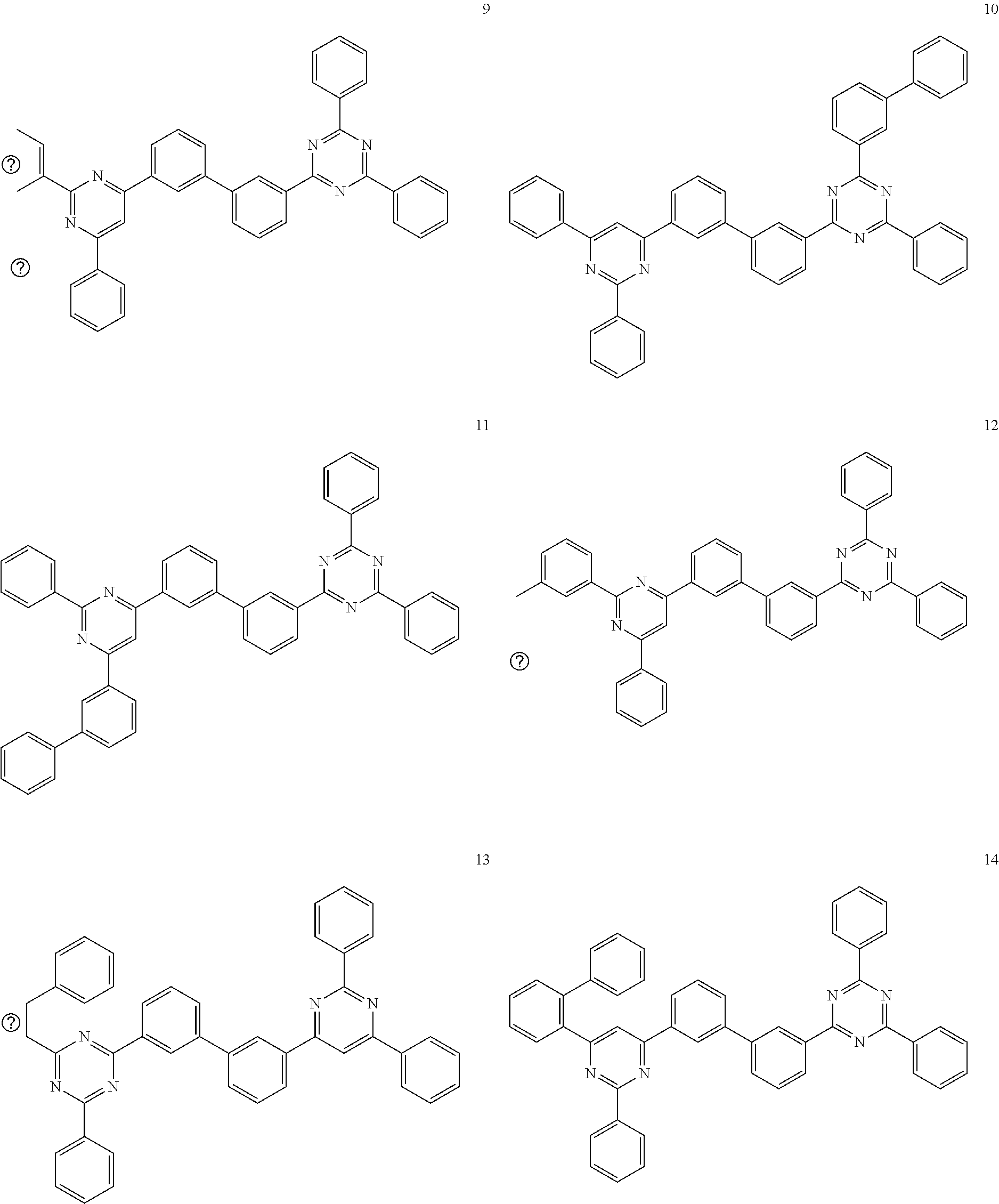


View All Diagrams
| United States Patent Application | 20200251659 |
| Kind Code | A1 |
| LEE; Yong Hwan ; et al. | August 6, 2020 |
ORGANIC COMPOUND AND ORGANIC ELECTROLUMINESCENT DEVICE USING THE SAME
Abstract
The present invention relates to a novel organic compound and an organic electroluminescent device using the same, and more particularly, to a novel compound having excellent electron transport capability and light emitting capability, and an organic electroluminescent device improved in terms of luminous efficiency, driving voltage, lifespan, etc. by including the novel compound in one or more organic layers.
| Inventors: | LEE; Yong Hwan; (Yongin-si, KR) ; EUM; Min Sik; (Yongin-si, KR) ; SIM; Jae Yi; (Yongin-si, KR) ; PARK; Woo Jae; (Yongin-si, KR) ; HAN; Song le; (Yongin-si, KR) | ||||||||||
| Applicant: |
|
||||||||||
|---|---|---|---|---|---|---|---|---|---|---|---|
| Assignee: | DOOSAN CORPORATION Seoul KR |
||||||||||
| Family ID: | 1000004736467 | ||||||||||
| Appl. No.: | 16/626134 | ||||||||||
| Filed: | May 18, 2018 | ||||||||||
| PCT Filed: | May 18, 2018 | ||||||||||
| PCT NO: | PCT/KR2018/005746 | ||||||||||
| 371 Date: | December 23, 2019 |
| Current U.S. Class: | 1/1 |
| Current CPC Class: | H01L 51/0067 20130101; C07D 401/14 20130101; H01L 51/5056 20130101; H01L 51/0052 20130101; H01L 51/5092 20130101; C07D 409/14 20130101; C07D 413/14 20130101; C07F 9/65583 20130101; C07D 403/14 20130101; C09K 11/06 20130101; H01L 51/5088 20130101; C07D 471/04 20130101; H01L 51/0071 20130101; H01L 51/0074 20130101; H01L 51/508 20130101; C09K 2211/1018 20130101; H01L 51/0058 20130101; H01L 51/0072 20130101; H01L 51/5016 20130101; H01L 51/0061 20130101; H01L 51/0054 20130101; C07D 487/04 20130101; H01L 51/0056 20130101; H01L 51/5012 20130101; C07D 403/10 20130101; C07D 405/14 20130101; H01L 51/0073 20130101 |
| International Class: | H01L 51/00 20060101 H01L051/00; C07D 403/10 20060101 C07D403/10; C09K 11/06 20060101 C09K011/06; C07D 405/14 20060101 C07D405/14; C07D 409/14 20060101 C07D409/14; C07D 401/14 20060101 C07D401/14; C07D 403/14 20060101 C07D403/14; C07D 413/14 20060101 C07D413/14; C07D 471/04 20060101 C07D471/04; C07F 9/6558 20060101 C07F009/6558; C07D 487/04 20060101 C07D487/04 |
Foreign Application Data
| Date | Code | Application Number |
|---|---|---|
| Jun 30, 2017 | KR | 10-2017-0083739 |
Claims
1. A compound represented by the following Chemical Formula 1: ##STR00217## where X.sub.1 and X.sub.2 are the same as or different from each other and are each independently CR.sub.1 or N, wherein when X.sub.1 and X.sub.2 are both CR.sub.1, the plurality of R.sub.1 are the same as or different from each other; R.sub.1 is selected from the group consisting of hydrogen, deuterium, halogen, a cyano group, a C.sub.1 to C.sub.40 alkyl group, a C.sub.6 to C.sub.60 aryl group and a heteroaryl group having 5 to 60 nuclear atoms; Ar.sub.1 to Ar.sub.4 are the same as or different from each other and are each independently a C.sub.2 to C.sub.40 alkenyl group, a C.sub.2 to C.sub.40 alkynyl group, a C.sub.3 to C.sub.40 cycloalkyl group, a heterocycloalkyl group having 3 to 40 nuclear atoms, a C.sub.1 to C.sub.40 alkyl group, a C.sub.6 to C.sub.60 aryl group, a heteroaryl group having 5 to 60 nuclear atoms, a C.sub.1 to C.sub.40 alkyloxy group, a C.sub.6 to C.sub.60 aryloxy group, a C.sub.1 to C.sub.40 alkylsilyl group, a C.sub.6 to C.sub.60 arylsilyl group, a C.sub.1 to C.sub.40 alkylboron group, a C.sub.6 to C.sub.60 arylboron group, a C.sub.6 to C.sub.60 arylphosphine group, a C.sub.6 to C.sub.60 arylphosphine oxide group and a C.sub.6 to C.sub.60 arylamine group, wherein a case where all of Ar.sub.1 to Ar.sub.4 are the same as each other is excluded; and the alkenyl group, the alkynyl group, the cycloalkyl group, the heterocycloalkyl group, the alkyl group, the aryl group, the heteroaryl group, the alkyloxy group, the aryloxy group, the alkylsilyl group, the arylsilyl group, the alkylboron group, the arylboron group, the arylphosphine group, the arylphosphine oxide group and the arylamine group of R.sub.1 and Ar.sub.1 to Ar.sub.4 are each independently substituted or unsubstituted with one or more kinds of substituents selected from the group consisting of deuterium, halogen, a cyano group, a nitro group, a C.sub.2 to C.sub.40 alkenyl group, a C.sub.2 to C.sub.40 alkynyl group, a C.sub.3 to C.sub.40 cycloalkyl group, a heterocycloalkyl group having 3 to 40 nuclear atoms, a C.sub.1 to C.sub.40 alkyl group, a C.sub.6 to C.sub.60 aryl group, a heteroaryl group having 5 to 60 nuclear atoms, a C.sub.1 to C.sub.40 alkyloxy group, a C.sub.6 to C.sub.60 aryloxy group, a C.sub.1 to C.sub.40 alkylsilyl group, a C.sub.6 to C.sub.60 arylsilyl group, a C.sub.1 to C.sub.40 alkylboron group, a C.sub.6 to C.sub.60 arylboron group, a C.sub.6 to C.sub.60 arylphosphine group, a C.sub.6 to C.sub.60 arylphosphine oxide group and a C.sub.6 to C.sub.60 arylamine group, wherein when the substituents are plural in number, the substituents are the same as or different from each other.
2. The compound of claim 1, wherein the compound represented by Chemical Formula 1 is represented by the following Chemical Formula 2 or 3: ##STR00218## where X.sub.1 and X.sub.2 and Ar.sub.1 to Ar.sub.4 are the same as those defined in claim 1, respectively.
3. The compound of claim 1, wherein Ar.sub.1 to Ar.sub.4 are the same as or different from each other and are each independently selected from the group consisting of a C.sub.1 to C.sub.40 alkyl group, a C.sub.6 to C.sub.60 aryl group, a heteroaryl group having 5 to 60 nuclear atoms, a C.sub.6 to C.sub.60 aryloxy group, a C.sub.6 to C.sub.60 arylphosphine oxide group and a C.sub.6 to C.sub.60 arylamine group; wherein the alkyl group, the aryl group, the heteroaryl group, the aryloxy group, the arylphosphine oxide group and the arylamine group of Ar.sub.1 to Ar.sub.4 are each independently substituted or unsubstituted with one or more kinds of substituents selected from the group consisting of deuterium, halogen, a cyano group, a nitro group, a C.sub.1 to C.sub.40 alkyl group, a C.sub.6 to C.sub.60 aryl group, a heteroaryl group having 5 to 60 nuclear atoms, a C.sub.6 to C.sub.60 aryloxy group, a C.sub.6 to C.sub.60 arylphosphine oxide group and a C.sub.6 to C.sub.60 arylamine group; and wherein when the substituents are plural in number, the substituents are the same as or different from each other.
4. The compound of claim 1, wherein Ar.sub.1 to Ar.sub.4 are the same as or different from each other and are each independently selected from the group consisting of a C.sub.6 to C.sub.60 aryl group and a heteroaryl group having 5 to 60 nuclear atoms; wherein the aryl group and the heteroaryl group of Ar.sub.1 to Ar.sub.4 are each independently substituted or unsubstituted with one or more kinds of substituents selected from the group consisting of deuterium, halogen, a cyano group, a nitro group, a C.sub.1 to C.sub.40 alkyl group, a C.sub.6 to C.sub.60 aryl group, a heteroaryl group having 5 to 60 nuclear atoms, a C.sub.6 to C.sub.60 aryloxy group, a C.sub.6 to C.sub.60 arylphosphine oxide group and a C.sub.6 to C.sub.60 arylamine group; and wherein when the substituents are plural in number, the substituents are the same as or different from each other.
5. The compound of claim 1, wherein Ar.sub.1 to Ar.sub.4 are the same as or different from each other and are each independently a substituent selected from the following Constitutional Formulas: ##STR00219## ##STR00220## ##STR00221## ##STR00222## ##STR00223## ##STR00224##
6. The compound of claim 1, wherein the compound represented by Chemical Formula 1 is represented by any one of the following compounds 1 to 696: ##STR00225## ##STR00226## ##STR00227## ##STR00228## ##STR00229## ##STR00230## ##STR00231## ##STR00232## ##STR00233## ##STR00234## ##STR00235## ##STR00236## ##STR00237## ##STR00238## ##STR00239## ##STR00240## ##STR00241## ##STR00242## ##STR00243## ##STR00244## ##STR00245## ##STR00246## ##STR00247## ##STR00248## ##STR00249## ##STR00250## ##STR00251## ##STR00252## ##STR00253## ##STR00254## ##STR00255## ##STR00256## ##STR00257## ##STR00258## ##STR00259## ##STR00260## ##STR00261## ##STR00262## ##STR00263## ##STR00264## ##STR00265## ##STR00266## ##STR00267## ##STR00268## ##STR00269## ##STR00270## ##STR00271## ##STR00272## ##STR00273## ##STR00274## ##STR00275## ##STR00276## ##STR00277## ##STR00278## ##STR00279## ##STR00280## ##STR00281## ##STR00282## ##STR00283## ##STR00284## ##STR00285## ##STR00286## ##STR00287## ##STR00288## ##STR00289## ##STR00290## ##STR00291## ##STR00292## ##STR00293## ##STR00294## ##STR00295## ##STR00296## ##STR00297## ##STR00298## ##STR00299## ##STR00300## ##STR00301## ##STR00302## ##STR00303## ##STR00304## ##STR00305## ##STR00306## ##STR00307## ##STR00308## ##STR00309## ##STR00310## ##STR00311## ##STR00312## ##STR00313## ##STR00314## ##STR00315## ##STR00316## ##STR00317## ##STR00318## ##STR00319## ##STR00320## ##STR00321## ##STR00322## ##STR00323## ##STR00324## ##STR00325## ##STR00326## ##STR00327## ##STR00328## ##STR00329## ##STR00330## ##STR00331## ##STR00332## ##STR00333## ##STR00334## ##STR00335## ##STR00336## ##STR00337## ##STR00338## ##STR00339## ##STR00340## ##STR00341## ##STR00342## ##STR00343## ##STR00344## ##STR00345## ##STR00346## ##STR00347## ##STR00348## ##STR00349## ##STR00350## ##STR00351## ##STR00352## ##STR00353## ##STR00354## ##STR00355## ##STR00356## ##STR00357## ##STR00358## ##STR00359## ##STR00360## ##STR00361## ##STR00362## ##STR00363## ##STR00364## ##STR00365## ##STR00366## ##STR00367## ##STR00368## ##STR00369## ##STR00370## ##STR00371## ##STR00372## ##STR00373## ##STR00374## ##STR00375## ##STR00376## ##STR00377## ##STR00378## ##STR00379## ##STR00380## ##STR00381## ##STR00382## ##STR00383## ##STR00384## ##STR00385## ##STR00386## ##STR00387## ##STR00388## ##STR00389## ##STR00390## ##STR00391## ##STR00392## ##STR00393## ##STR00394## ##STR00395## ##STR00396## ##STR00397## ##STR00398## ##STR00399## ##STR00400## ##STR00401## ##STR00402## ##STR00403## ##STR00404## ##STR00405## ##STR00406## ##STR00407## ##STR00408## ##STR00409##
7. An organic electroluminescent device, comprising an anode, a cathode and one or more organic layers interposed between the anode and the cathode, wherein at least one of the one or more organic layers comprises compound represented by the following Chemical Formula 1: ##STR00410## where X.sub.1 and X.sub.2 are the same as or different from each other and are each independently CR.sub.1 or N, wherein when X.sub.1 and X.sub.2 are both CR.sub.1, the plurality of R.sub.1 are the same as or different from each other; R.sub.1 is selected from the group consisting of hydrogen, deuterium, halogen, a cyano group, a C.sub.1 to C.sub.40 alkyl group, a C.sub.6 to C.sub.60 aryl group and a heteroaryl group having 5 to 60 nuclear atoms; Ar.sub.1 to Ar.sub.4 are the same as or different from each other and are each independently a C.sub.2 to C.sub.40 alkenyl group, a C.sub.2 to C.sub.40 alkynyl group, a C.sub.3 to C.sub.40 cycloalkyl group, a heterocycloalkyl group having 3 to 40 nuclear atoms, a C.sub.1 to C.sub.40 alkyl group, a C.sub.6 to C.sub.60 aryl group, a heteroaryl group having 5 to 60 nuclear atoms, a C.sub.1 to C.sub.40 alkyloxy group, a C.sub.6 to C.sub.60 aryloxy group, a C.sub.1 to C.sub.40 alkylsilyl group, a C.sub.6 to C.sub.60 arylsilyl group, a C.sub.1 to C.sub.40 alkylboron group, a C.sub.6 to C.sub.60 arylboron group, a C.sub.6 to C.sub.60 arylphosphine group, a C.sub.6 to C.sub.60 arylphosphine oxide group and a C.sub.6 to C.sub.60 arylamine group, wherein a case where all of Ar.sub.1 to Ar.sub.4 are the same as each other is excluded; and the alkenyl group, the alkynyl group, the cycloalkyl group, the heterocycloalkyl group, the alkyl group, the aryl group, the heteroaryl group, the alkyloxy group, the aryloxy group, the alkylsilyl group, the arylsilyl group, the alkylboron group, the arylboron group, the arylphosphine group, the arylphosphine oxide group and the arylamine group of R.sub.1 and Ar.sub.1 to Ar.sub.4 are each independently substituted or unsubstituted with one or more kinds of substituents selected from the group consisting of deuterium, halogen, a cyano group, a nitro group, a C.sub.2 to C.sub.40 alkenyl group, a C.sub.2 to C.sub.40 alkynyl group, a C.sub.3 to C.sub.40 cycloalkyl group, a heterocycloalkyl group having 3 to 40 nuclear atoms, a C.sub.1 to C.sub.40 alkyl group, a C.sub.6 to C.sub.60 aryl group, a heteroaryl group having 5 to 60 nuclear atoms, a C.sub.1 to C.sub.40 alkyloxy group, a C.sub.6 to C.sub.60 aryloxy group, a C.sub.1 to C.sub.40 alkylsilyl group, a C.sub.6 to C.sub.60 arylsilyl group, a C.sub.1 to C.sub.40 alkylboron group, a C.sub.6 to C.sub.60 arylboron group, a C.sub.6 to C.sub.60 arylphosphine group, a C.sub.6 to C.sub.60 arylphosphine oxide group and a C.sub.6 to C.sub.60 arylamine group, wherein when the substituents are plural in number, the substituents are the same as or different from each other.
8. The organic electroluminescent device of claim 7, wherein the organic layer comprising the compound is selected from the group consisting of: a hole injection layer, a hole transporting layer, an auxiliary luminescent layer, a luminescent layer, an electron transporting layer, an auxiliary electron transporting layer and an electron injection layer.
9. The organic electroluminescent device of claim 7, wherein the organic layer comprising the compound is selected from the group consisting of: a phosphorescent luminescent layer, an electron transporting layer and an auxiliary electron transporting layer.
10. The organic electroluminescent device of claim 7, wherein the compound represented by Chemical Formula 1 is represented by the following Chemical Formula 2 or 3: ##STR00411## where X.sub.1 and X.sub.2 and Ar.sub.1 to Ar.sub.4 are the same as those defined in claim 7, respectively.
11. The organic electroluminescent device of claim 7, wherein Ar.sub.1 to Ar.sub.4 are the same as or different from each other and are each independently a substituent selected from the following Constitutional Formulas: ##STR00412## ##STR00413## ##STR00414## ##STR00415##
12. The organic electroluminescent device of claim 7, wherein the compound represented by Chemical Formula 1 is represented by any one of the following compounds 1 to 696: ##STR00416## ##STR00417## ##STR00418## ##STR00419## ##STR00420## ##STR00421## ##STR00422## ##STR00423## ##STR00424## ##STR00425## ##STR00426## ##STR00427## ##STR00428## ##STR00429## ##STR00430## ##STR00431## ##STR00432## ##STR00433## ##STR00434## ##STR00435## ##STR00436## ##STR00437## ##STR00438## ##STR00439## ##STR00440## ##STR00441## ##STR00442## ##STR00443## ##STR00444## ##STR00445## ##STR00446## ##STR00447## ##STR00448## ##STR00449## ##STR00450## ##STR00451## ##STR00452## ##STR00453## ##STR00454## ##STR00455## ##STR00456## ##STR00457## ##STR00458## ##STR00459## ##STR00460## ##STR00461## ##STR00462## ##STR00463## ##STR00464## ##STR00465## ##STR00466## ##STR00467## ##STR00468## ##STR00469## ##STR00470## ##STR00471## ##STR00472## ##STR00473## ##STR00474## ##STR00475## ##STR00476## ##STR00477## ##STR00478## ##STR00479## ##STR00480## ##STR00481## ##STR00482## ##STR00483## ##STR00484## ##STR00485## ##STR00486## ##STR00487## ##STR00488## ##STR00489## ##STR00490## ##STR00491## ##STR00492## ##STR00493## ##STR00494## ##STR00495## ##STR00496## ##STR00497## ##STR00498## ##STR00499## ##STR00500## ##STR00501## ##STR00502## ##STR00503## ##STR00504## ##STR00505## ##STR00506## ##STR00507## ##STR00508## ##STR00509## ##STR00510## ##STR00511## ##STR00512## ##STR00513## ##STR00514## ##STR00515## ##STR00516## ##STR00517## ##STR00518## ##STR00519## ##STR00520## ##STR00521## ##STR00522## ##STR00523## ##STR00524## ##STR00525## ##STR00526## ##STR00527## ##STR00528## ##STR00529## ##STR00530##
Description
TECHNICAL FIELD
[0001] The present invention relates to a novel organic compound and an organic electroluminescent device using the same, and more particularly, to a compound having excellent electron transport capability and light emitting capability, and an organic electroluminescent device improved in terms of luminous efficiency, driving voltage, lifespan, etc. by including the compound in one or more organic layers.
BACKGROUND ART
[0002] Starting from Bernanose's observation of light emission from organic thin films in the 1950s, the study of organic electroluminescent devices led to blue electroluminescence using anthracene monocrystals in 1965, and Tang suggested in 1987 an organic electroluminescent device in a stack structure which may be divided into functional layers of hole and light-emitting layers. Then, in order to develop high efficiency, long life span organic electroluminescent devices, organic layers each having distinctive characteristics have been introduced in the electroluminescent devices, leading to the development of specialized materials used therein.
[0003] In the organic electroluminescent device, upon application of voltage between two electrodes, holes are injected from an anode and electrons are injected from a cathode into the organic layer. Injected holes and electrons meet each other to form excitons, and light emission occurs when the excitons fall to a ground state. In such a case, materials used for the organic layer may be classified into, for example, luminescent materials, hole injection materials, hole transporting materials, electron transporting materials and electron injection materials according to their function.
[0004] Materials forming a light-emitting layer of an organic electroluminescent device may be classified into blue, green and red luminescent materials according to their emission colors. Besides, yellow and orange luminescent materials may be used as a luminescent material for implementing better natural colors. In addition, a host/dopant system may be employed in the luminescent material to increase color purity and luminous efficiency through energy transfer.
[0005] Dopant materials may be classified into fluorescent dopants using organic materials and phosphorescent dopants using metal complex compounds that include heavy atoms such as Ir and Pt. The developed phosphorescent materials may improve the luminous efficiency theoretically up to four times as compared to fluorescent materials, so attention is given to phosphorescent dopants as well as phosphorescent host materials.
[0006] To date, NPB, BCP and Alq.sub.3, for example, are widely known as materials used in the hole injection layer, the hole transporting layer, the hole blocking layer and the electron transporting layer, and anthracene derivatives have been reported as fluorescent dopant/host materials for luminescent materials. Particularly, metal complex compounds, such as FIrpic, Ir(ppy).sub.3, and Ir(btp).sub.2(acac), which include Ir are used as blue, green and red dopant materials for the phosphorescent materials having great advantages in terms of efficiency improvement among luminescent materials. Up to this day, CBP has shown excellent properties as a phosphorescent host material.
[0007] However, conventional luminescent materials have low glass transition temperatures and poor thermal stability, despite of their advantageous luminous characteristics, and thus are not satisfactory in terms of lifespan for organic electroluminescent devices. Accordingly, there is a demand for development of luminescent materials having excellent performance. [0008] Prior art document: Japanese Patent Laid-Open No. 2001-160489.
DETAILED DESCRIPTION OF THE INVENTION
Technical Problem
[0009] In order to solve the above-described problems, the present invention is directed to providing a novel organic compound, applicable to organic electroluminescent devices, that is excellent in electron transport capability and light emitting capability by satisfying, for example, the required, proper range of energy level, electrochemical stability and thermal stability.
[0010] The present invention is also directed to providing an organic electroluminescent device that shows a low driving voltage and high luminous efficiency and has an improved life span, by including the novel organic compound.
TECHNICAL SOLUTION
[0011] In order to achieve the above object, the present invention provides a compound represented by the following Chemical Formula 1:
##STR00001##
[0012] where X.sub.1 and X.sub.2 are the same as or different from each other and are each independently CR.sub.1 or N, wherein when X.sub.1 and X.sub.2 are both CR.sub.1, the plurality of R.sub.1 are the same as or different from each other;
[0013] R.sub.1 is selected from the group consisting of hydrogen, deuterium, halogen, a cyano group, a C.sub.1 to C.sub.40 alkyl group, a C.sub.6 to C.sub.60 aryl group and a heteroaryl group having 5 to 60 nuclear atoms;
[0014] Ar.sub.1 to Ar.sub.4 are the same as or different from each other and are each independently a C.sub.2 to C.sub.40 alkenyl group, a C.sub.2 to C.sub.40 alkynyl group, a C.sub.3 to C.sub.40, cycloalkyl group, a heterocycloalkyl group having 3 to 40 nuclear atoms, a C.sub.1 to C.sub.40 alkyl group, a C.sub.6 to C.sub.60 aryl group, a heteroaryl group having 5 to 60 nuclear atoms, a C.sub.1 to C.sub.40 alkyloxy group, a C.sub.6 to C.sub.60 aryloxy group, a C.sub.1 to C.sub.40 alkylsilyl group, a C.sub.6 to C.sub.60 arylsilyl group, a C.sub.1 to C.sub.40 alkylboron group, a C.sub.6 to C.sub.60 arylboron group, a C.sub.6 to C.sub.60 arylphosphine group, a C.sub.6 to C.sub.60 arylphosphine oxide group and a C to Coo arylamine group, wherein a case where all of Ar.sub.1 to Ar.sub.4 are the same as each other is excluded; and
[0015] the alkenyl group, the alkynyl group, the cycloalkyl group, the heterocycloalkyl group, the alkyl group, the aryl group, the heteroaryl group, the alkyloxy group, the aryloxy group, the alkylsilyl group, the arylsilyl group, the alkylboron group, the arylboron group, the arylphosphine group, the arylphosphine oxide group and the arylamine group of R.sub.1 and Ar.sub.1 to Ar.sub.4 are each independently substituted or unsubstituted with one or more kinds of substituents selected from the group consisting of deuterium, halogen, a cyano group, a nitro group, a C.sub.2 to C.sub.40 alkenyl group, a C.sub.2 to C.sub.40 alkynyl group, a C.sub.3 to C.sub.40 cycloalkyl group, a heterocycloalkyl group having 3 to 40 nuclear atoms, a C.sub.1 to C.sub.40 alkyl group, a C.sub.6 to C.sub.60 aryl group, a heteroaryl group having 5 to 60 nuclear atoms, a C.sub.1 to C.sub.40 alkyloxy group, a C.sub.6 to C.sub.60 aryloxy group, a C.sub.1 to C.sub.40 alkylsilyl group, a C.sub.6 to C.sub.60 arylsilyl group, a C.sub.1 to C.sub.40 alkylboron group, a C.sub.6 to C.sub.60 arylboron group, a C.sub.6 to C.sub.60 arylphosphine group, a C.sub.6 to C.sub.60 arylphosphine oxide group and a C.sub.6 to C.sub.60 arylamine group, wherein when the substituents are plural in number, the substituents are the same as or different from each other.
[0016] In addition, the present invention also provides an organic electroluminescent device including an anode, a cathode and one or more organic layers interposed between the anode and the cathode. At least one of the one or more organic layers includes the compound represented by Chemical Formula 1.
[0017] The organic layer including the compound represented by Chemical Formula 1 may be selected from the group consisting of: a hole injection layer, a hole transporting layer, an auxiliary light-emitting layer, a light-emitting layer, an electron transporting layer, an auxiliary electron transporting layer and an electron injection layer.
[0018] In such a case, the compound represented by Chemical Formula 1 may be used as a phosphorescent host material of a light-emitting layer, and a material of an electron transporting layer and an auxiliary electron transporting layer.
Effects of the Invention
[0019] The compound represented by Chemical Formula 1 may be used as a material of an organic layer of an organic electroluminescent device by virtue of its thermal stability and excellent light emitting properties.
[0020] In particular, when the compound represented by Chemical Formula 1 of the present invention is used as a phosphorescent host material or an electron transporting material, an organic electroluminescent device that has a lower driving voltage and higher current efficiency may be manufactured, as compared to the case of using conventional host materials or electron transporting materials. In addition, it is possible to manufacture a full color display panel with improved performance and lifespan.
MODE FOR CARRYING OUT THE INVENTION
[0021] Hereinafter, the present invention will be described in detail.
[0022] 1. Organic Compound
[0023] A novel organic compound according to the present invention has a structure, as a base skeleton, in which two electron-withdrawing groups (EWGs) are connected to each other through a linker (or linking group). In such an embodiment, the two EWGs are pyrimidine and triazine, and the linker is m,m-biphenylene. A compound in which various substituents are introduced into such a base skeleton is represented by Chemical Formula 1.
[0024] Since the compound represented by Chemical Formula 1 has a structure in which two 6-membered heterocycles (pyrimidine and triazine) having excellent electron withdrawing properties are linked to each other through a linker, it is electrochemically stable and has excellent electron transport properties as well as high triplet energy, high glass transition temperature and excellent thermal stability. Accordingly, the compound represented by Chemical Formula 1 has excellent electron transport capability and light emitting characteristics and thus may be used as a material of one of a light-emitting layer, an electron transporting layer and an electron injection layer, which are organic layers of the organic electroluminescent device. Preferably, the compound may be used as a material of one of a light-emitting layer, an electron transporting layer and an auxiliary electron transporting layer that is laminated additionally to the electron transporting layer, and more particularly, as a material of the electron transporting layer or the auxiliary electron transporting layer.
[0025] The compound represented by Chemical Formula 1 may have an improved glass transition temperature by having a significantly increased molecular weight of the compound, and accordingly, may have a higher thermal stability than the conventional single 6-membered heterocyclic compound.
[0026] In addition, the compound represented by Chemical Formula 1 may also exhibit effects of inhibiting crystallization of the organic layer by using the m,m-biphenylene linker. For this reason, an organic electroluminescent device to which the compound represented by Chemical Formula 1 is applied may have significantly improved durability and lifespan characteristics. In such a case, the organic electroluminescent device to which the compound represented by Chemical Formula 1 that has m,m-biphenylene as the linker is applied may exhibit excellent driving voltage, light emission peak and current efficiency, as compared to organic electroluminescent devices to which a compound that has p,p-biphenylene or m,p-biphenylene as the linker is applied.
[0027] In addition, the compound represented by Chemical Formula 1 may have an improved glass transition temperature by having a significantly increased molecular weight of the compound due to a variety of substituents (e.g., an aromatic cycle and a heterocycle) introduced into the base skeleton, such that durability and lifespan characteristics of the organic electroluminescent device may be significantly improved. The compound represented by Chemical Formula 1 may be used as a material of an organic layer of the organic electroluminescent device, and in particular, as a material of an electron transporting layer and a light-emitting layer.
[0028] Accordingly, when the compound represented by Chemical Formula 1 is used in an organic electroluminescent device, not only excellent thermal stability and carrier transporting capability (particularly, electron transport capability and light emitting capability) may be expected, but also the driving voltage, efficiency and lifespan, for example, of the device may be improved.
[0029] In addition, the compound represented by Chemical Formula 1 shows long lifespan characteristics while being very advantageous for electron transporting. The excellent electron transport capability of such a compound may achieve high efficiency and speedy mobility in the organic electroluminescent device and may easily control the HOMO and LUMO energy level according to the direction or location of the substituent. Accordingly, excellent electron transporting property may be exhibited in the organic electroluminescent device using such a compound.
[0030] Specifically, the compound represented by Chemical Formula 1 according to the present invention may be represented by the following Chemical Formula 2 or 3.
##STR00002##
[0031] In Chemical Formulas 2 and 3, X.sub.1 and X.sub.2 and Ar.sub.1 to Ar.sub.4 are the same as those defined in Chemical Formula 1, respectively.
[0032] In an embodiment according to the present invention, at least one of X.sub.1 and X.sub.2 may be preferably N.
[0033] More preferably, one of X.sub.1 and X.sub.2 may be CR.sub.1 and the other thereof may be N.
[0034] In addition, preferably, in an embodiment according to the present invention, Ar.sub.1 to Ar.sub.4 may be the same as or different from each other and may each be independently selected from a C.sub.1 to C.sub.40 alkyl group, a C.sub.6 to C.sub.60 aryl group, a heteroaryl group having 5 to 60 nuclear atoms, C.sub.6 to C.sub.60 aryloxy group, a C.sub.6 to C.sub.60 arylphosphine oxide group and a C.sub.6 to C.sub.60 arylamine group.
[0035] More preferably, Ar.sub.1 to Ar.sub.4 may be the same as or different from each other and may each independently be a C.sub.6 to C.sub.60 aryl group and/or a heteroaryl group having 5 to 60 nuclear atoms. As a specific example, when one of Ar.sub.1 to Ar.sub.4 is a C.sub.6 to C.sub.60 aryl group, the other three may each be a C.sub.6 to C.sub.60 aryl group and/or a heteroaryl group having 5 to 60 nuclear atoms. As another example, when two of Ar.sub.1 to Ar.sub.4 are C.sub.6 to C.sub.60 aryl groups, the other two may each be a C.sub.6 to C.sub.60 aryl group and/or a heteroaryl group having 5 to 60 nuclear atoms. As another example, when three of Ar.sub.1 to Ar.sub.4 are C.sub.6 to C.sub.60 aryl groups, the other one may be a C.sub.6 to C.sub.60 aryl group and/or a heteroaryl group having 5 to 60 nuclear atoms. As another example, all of Ar.sub.1 to Ar.sub.4 may each be a C.sub.6 to C.sub.60 aryl group.
[0036] Preferably, in an embodiment according to the present invention, the alkyl group, the aryl group, the heteroaryl group, the aryloxy group, the arylphosphine oxide group and the arylamine group of Ar.sub.1 to Ar.sub.4 may each independently be substituted or unsubstituted with one or more kinds of substituents selected from the group consisting of: deuterium, halogen, a cyano group, a nitro group, a C.sub.1 to C.sub.40 alkyl group, a C.sub.6 to C.sub.60 aryl group, a heteroaryl group having 5 to 60 nuclear atoms, a C.sub.6 to C.sub.60 aryloxy group, a C.sub.6 to C.sub.60 arylphosphine oxide group and a C.sub.6 to C.sub.60 arylamine group, and when the substituents are plural in number, they may be the same as or different from each other.
[0037] Except the case where all of Ar.sub.1 to Ar.sub.4 are the same as each other, Ar.sub.1 to Ar.sub.4 may each independently be embodied into a substituent selected from the following Constitutional Formulas.
##STR00003## ##STR00004## ##STR00005## ##STR00006## ##STR00007## ##STR00008##
[0038] The aforementioned compound represented by Chemical Formula 1 according to the present invention may be more specifically embodied into any one of compounds represented by Compounds 1 to 696 exemplified below. However, the compound represented by Chemical Formula 1 of the present invention is not limited to those illustrated below.
##STR00009## ##STR00010## ##STR00011## ##STR00012## ##STR00013## ##STR00014## ##STR00015## ##STR00016## ##STR00017## ##STR00018## ##STR00019## ##STR00020## ##STR00021## ##STR00022## ##STR00023## ##STR00024## ##STR00025## ##STR00026## ##STR00027## ##STR00028## ##STR00029## ##STR00030## ##STR00031## ##STR00032## ##STR00033## ##STR00034## ##STR00035## ##STR00036## ##STR00037## ##STR00038## ##STR00039## ##STR00040## ##STR00041## ##STR00042## ##STR00043## ##STR00044## ##STR00045## ##STR00046## ##STR00047## ##STR00048## ##STR00049## ##STR00050## ##STR00051## ##STR00052## ##STR00053## ##STR00054## ##STR00055## ##STR00056## ##STR00057## ##STR00058## ##STR00059## ##STR00060## ##STR00061## ##STR00062## ##STR00063##
##STR00064## ##STR00065## ##STR00066## ##STR00067## ##STR00068## ##STR00069## ##STR00070## ##STR00071## ##STR00072## ##STR00073## ##STR00074## ##STR00075## ##STR00076## ##STR00077## ##STR00078## ##STR00079## ##STR00080## ##STR00081## ##STR00082## ##STR00083## ##STR00084## ##STR00085## ##STR00086## ##STR00087## ##STR00088## ##STR00089## ##STR00090## ##STR00091## ##STR00092## ##STR00093## ##STR00094## ##STR00095## ##STR00096## ##STR00097## ##STR00098## ##STR00099## ##STR00100## ##STR00101## ##STR00102## ##STR00103## ##STR00104## ##STR00105## ##STR00106## ##STR00107## ##STR00108## ##STR00109## ##STR00110## ##STR00111## ##STR00112## ##STR00113## ##STR00114## ##STR00115## ##STR00116## ##STR00117## ##STR00118## ##STR00119## ##STR00120## ##STR00121## ##STR00122## ##STR00123## ##STR00124## ##STR00125## ##STR00126## ##STR00127## ##STR00128## ##STR00129## ##STR00130## ##STR00131## ##STR00132## ##STR00133## ##STR00134## ##STR00135##
##STR00136## ##STR00137## ##STR00138## ##STR00139## ##STR00140## ##STR00141## ##STR00142## ##STR00143## ##STR00144## ##STR00145## ##STR00146## ##STR00147## ##STR00148## ##STR00149## ##STR00150## ##STR00151## ##STR00152## ##STR00153## ##STR00154## ##STR00155## ##STR00156## ##STR00157## ##STR00158## ##STR00159## ##STR00160## ##STR00161## ##STR00162## ##STR00163## ##STR00164## ##STR00165## ##STR00166## ##STR00167## ##STR00168## ##STR00169## ##STR00170## ##STR00171## ##STR00172## ##STR00173## ##STR00174##
[0039] As used herein, "alkyl" refers to a monovalent substituent derived from a saturated, linear or branched hydrocarbon having 1 to 40 carbon atoms. Examples of such alkyl may include, but are not limited to, methyl, ethyl, propyl, isobutyl, sec-butyl, pentyl, iso-amyl, hexyl or the like.
[0040] As used herein, "alkenyl" refers to a monovalent substituent derived from an unsaturated, linear or branched hydrocarbon having 2 to 40 carbon atoms, having at least one carbon-carbon double bond. Examples of such alkenyl may include, but are not limited to, vinyl, allyl, isopropenyl, 2-butenyl or the like.
[0041] As used herein, "alkynyl" refers to a monovalent substituent derived from an unsaturated, linear or branched hydrocarbon having 2 to 40 carbon atoms, having at least one carbon-carbon triple bond. Examples of such alkynyl may include, but are not limited to, ethynyl, 2-propynyl or the like.
[0042] As used herein, "aryl" refers to a monovalent substituent derived from a C.sub.6 to C.sub.60 aromatic hydrocarbon which is in a structure with a single ring or two or more rings combined with each other. In addition, a form in which two or more rings are pendant (e.g., simply attached) to or condensed with each other may also be included. Examples of such aryl may include, but are not limited to, phenyl, naphthyl, phenanthryl, anthryl or the like.
[0043] As used herein, "heteroaryl" refers to a monovalent substituent derived from a monoheterocyclic or polyheterocyclic aromatic hydrocarbon having 5 to 60 nuclear atoms. In such a case, one or more carbons in the ring, preferably one to three carbons, are substituted with a heteroatom such as N, O, S or Se. In addition, a form in which two or more rings are pendant to or condensed with each other may be included, and a form condensed with an aryl group may be included. Examples of such heteroaryl may include, but are not limited to, a 6-membered monocyclic ring such as pyridyl, pyrazinyl, pyrimidinyl, pyridazinyl and triazinyl; a polycyclic ring such as phenoxathienyl, indolizinyl, indolyl, purinyl, quinolyl, benzothiazole and carbazolyl; 2-furanyl; N-imidazolyl; 2-isoxazolyl; 2-pyridinyl; 2-pyrimidinyl or the like.
[0044] As used herein, "aryloxy" refers to a monovalent substituent represented by RO--, where R is aryl having 6 to 60 carbon atoms. Examples of such aryloxy may include, but are not limited to, phenyloxy, naphthyloxy, diphenyloxy or the like.
[0045] As used herein, "alkyloxy" refers to a monovalent substituent represented by R'O--, where R' is alkyl having 1 to 40 carbon atoms. Such alkyloxy may include a linear, branched or cyclic structure. Examples of such alkyloxy may include, but are not limited to, methoxy, ethoxy, n-propoxy, 1-propoxy, t-butoxy, n-butoxy, pentoxy or the like.
[0046] As used herein, "arylamine" refers to amine substituted with aryl having 6 to 60 carbon atoms.
[0047] As used herein, "cycloalkyl" refers to a monovalent substituent derived from a monocyclic or polycyclic non-aromatic hydrocarbon having 3 to 40 carbon atoms. Examples of such cycloalkyl may include, but are not limited to, cyclopropyl, cyclopentyl, cyclohexyl, norbornyl, adamantine or the like.
[0048] As used herein, "heterocycloalkyl" refers to a monovalent substituent derived from a non-aromatic hydrocarbon having 3 to 40 nuclear atoms, where one or more carbons in the ring, preferably one to three carbons, are substituted with a heteroatom such as N, O, S or Se. Examples of such heterocycloalkyl may include, but are not limited to, morpholine, piperazine or the like.
[0049] As used herein, "alkylsilyl" refers to silyl substituted with alkyl having 1 to 40 carbon atoms, and "arylsilyl" refers to silyl substituted with aryl, having 6 to 60 carbon atoms.
[0050] As used herein, "alkylboron" refers to boron substituted with alkyl having 1 to 40 carbon atoms, and "arylboron" refers to boron substituted with aryl, having 6 to 60 carbon atoms.
[0051] As used herein, "arylphosphine" refers to phosphine substituted with aryl having 6 to 60 carbon atoms, and "arylphosphine oxide" refers to phosphine, substituted with aryl having 6 to 60 carbon atoms, that has O.
[0052] As used herein, the term "condensed ring" refers to a condensed aliphatic ring, a condensed aromatic ring, a condensed heteroaliphatic ring, a condensed heteroaromatic ring, or a combination thereof.
[0053] Such a compound represented by Chemical Formula 1 of the present invention may be synthesized in various ways with reference to the synthesis process of the following embodiments.
[0054] 2. Organic Electroluminescent Device
[0055] The present invention provides an organic electroluminescent device including the compound represented by Chemical Formula 1.
[0056] More specifically, the organic electroluminescent device according to the present invention includes an anode, a cathode, and one or more organic layers interposed between the anode and the cathode, and at least one of the one or more organic layers include the compound represented by Chemical Formula 1. In such a case, the compound may be used solely or as a combination of two or more kinds thereof.
[0057] The one or more organic layers may be any one or more of a hole injection layer, a hole transporting layer, an auxiliary light-emitting layer, a light-emitting layer, an electron transporting layer and an electron injection layer, and at least one of the organic layers may include the compound represented by Chemical Formula 1. Specifically, the organic layer including the compound represented by Chemical Formula 1 is preferably a light-emitting layer and an electron transporting layer.
[0058] The light-emitting layer of the organic electroluminescent device of the present invention may include a host material (preferably, a phosphorescent host material). In addition, the light-emitting layer of the organic electroluminescent device of the present invention may include, as a host, a compound other than the compound represented by Chemical Formula 1.
[0059] A structure of the organic electroluminescent device of the present invention is not particularly limited, but a non-limiting example thereof may be a structure in which a substrate, an anode, a hole injection layer, a hole transporting layer, an auxiliary light-emitting layer, a light-emitting layer, an electron transporting layer and a cathode are sequentially stacked. In such a case, at least one of the hole injection layer, the hole transporting layer, the auxiliary light-emitting layer, the light-emitting layer, the electron transporting layer and the electron injection layer may include the compound represented by Chemical Formula 1, and preferably, the light-emitting layer may include the compound represented by Chemical Formula 1. In such a case, an electron injection layer may be further stacked on the electron transporting layer. In addition, the structure of the organic electroluminescent device of the present invention may be a structure in which an insulating layer or an adhesive layer is inserted at interfaces between the electrodes and the organic layers.
[0060] Meanwhile, the organic electroluminescent device of the present invention may be manufactured by forming organic layers and electrodes with conventional materials and through conventional methods known in the art, except that one or more of the aforementioned organic layers include the compound represented by Chemical Formula 1.
[0061] The organic layer may be formed by a vacuum deposition method or a solution coating method. Examples of the solution coating method may include, but are not limited to, spin coating, dip coating, doctor blading, inkjet printing, thermal transfer or the like.
[0062] The substrate used for manufacturing the organic electroluminescent device of the present invention is not particularly limited, but silicon wafers, quartz, glass plates, metal plates, plastic films, sheets or the like may be used.
[0063] In addition, a material of the anode may include, but is not limited to, a metal such as vanadium, chromium, copper, zinc and gold or an alloy thereof; a metal oxide such as zinc oxide, indium oxide, indium tin oxide (ITO) and indium zinc oxide (IZO); a combination of oxide with metal such as ZnO:Al or SnO.sub.2:Sb; a conductive polymer such as polythiophene, poly(3-methylthiophene), poly [3,4-(ethylene-1,2-dioxy) thiophene] (PEDT), polypyrrole and polyaniline; carbon black or the like.
[0064] In addition, a material of the cathode may include, but is not limited to, a metal such as magnesium, calcium, sodium, potassium, titanium, indium, yttrium, lithium, gadolinium, aluminum, silver, tin and lead or an alloy thereof; a multi-layered material such as LiF/Al and LiO.sub.2/Al or the like.
[0065] In addition, materials of the hole injection layer, the hole transporting layer and the auxiliary light-emitting layer are not particularly limited and conventional materials known in the art may be used.
[0066] Hereinafter, the present invention will be described in detail with reference to the following embodiments. However, the following embodiments are merely to illustrate the invention, and the present invention is not limited by the following embodiments.
[Preparation Example 1] Synthesis of Compound Z-1
<Step 1> Synthesis of 2,4-dichloro-6-(9,9-dimethyl-9H-fluoren-2-yl)pyrimidine
##STR00175##
[0068] Under nitrogen environment, 2,4,6-trichloropyrimidine (1.83 g, 10 mmol), (9,9-dimethyl-9H-fluoren-2-yl)boronic acid (2.38 g, 10.0 mmol), Pd(OAc).sub.2 (0.11 g, 5 mol %), PPh.sub.3 (0.26 g, 1 mmol), Na.sub.2CO.sub.3 (2.10 g, 20 mmol) and Toluene/DME/H.sub.2O (10 ml/30 ml/20 ml) were mixed and then heated to reflux for 8 hours. After the reaction was completed, the mixture was cooled to room temperature, extraction was performed with methylene chloride, MgSO.sub.4 was added to the extracted material, and the resultant material was filtered. After removing the solvent from the obtained organic layer, a compound 2,4-dichloro-6-(9,9-dimethyl-9H-fluoren-2-yl)pyrimidine (2.72 g, yield 80%) was obtained through column chromatography.
[0069] 1H-NMR: .delta. 1.69 (s, 6H), 7.13 (s, 1H), 7.28 (t, 1H), 7.38 (t, 1H), 7.55 (d, 1H), 7.78 (d, 1H), 7.90 (m, 2H), 8.09 (d, 1H)
<Step 2> Synthesis of 2-chloro-4-(3-chlorophenyl)-6-(9,9-dimethyl-9H-fluoren-2-yl)pyrimidine
##STR00176##
[0071] Under nitrogen environment, 2,4-dichloro-6-(9,9-dimethyl-9H-fluoren-2-yl)pyrimidine (3.41 g, 10 mmol), which had been synthesized in <Step 1>, and (3-chlorophenyl)boronic acid (1.56 g, 10.0 mmol), Pd(PPh.sub.3). (0.57 g, 5 mol %), Na.sub.2CO.sub.3 (2.10 g, 20 mmol) and DME/H.sub.2O (40 ml/20 ml) were mixed and then heated to reflux for 8 hours. After the reaction was completed, the mixture was cooled to room temperature, extraction was performed with methylene chloride, MgSO.sub.4 was added to the extracted material, and the resultant material was filtered. After removing the solvent from the obtained organic layer, a compound 2-chloro-4-(3-chlorophenyl)-6-(9,9-dimethyl-9H-fluoren-2-yl)pyrimidine (3.29 g, yield 79%) was obtained through column chromatography.
[0072] 1H-NMR: .delta. 1.69 (s, 6H), 7.28 (t, 1H), 7.38 (t, 1H), 7.50 (m, 3H), 7.76 (m, 2H), 7.90 (m, 2H), 7.97 (s, 1H), 8.09 (d, 1H), 8.33 (s, 1H)
<Step 3> Synthesis of 3-(4-(3-chlorophenyl)-6-(9,9-dimethyl-9H-fluoren-2-yl)pyrimidin-2-yl)-9-p- henyl-9H-carbazole
##STR00177##
[0074] Under nitrogen environment, 2-chloro-4-(3-chlorophenyl)-6-(9,9-dimethyl-9H-fluoren-2-yl)pyrimidine (4.17 g, 10 mmol), which had been synthesized in <Step 2>, and (9-phenyl-9H-carbazol-3-yl)boronic acid (2.87 g, 10.0 mmol), Pd(PPh.sub.3).sub.4 (0.57 g, 5 mol %), K.sub.2CO.sub.3 (2.76 g, 20 mmol) and 1,4-Dioxane/H.sub.2O (80 ml/20 ml) were mixed and then heated to reflux for 8 hours. After the reaction was completed, the mixture was cooled to room temperature, extraction was performed with methylene chloride, MgSO.sub.4 was added to the extracted material, and the resultant material was filtered. After removing the solvent from the obtained organic layer, a compound 3-(4-(3-chlorophenyl)-6-(9,9-dimethyl-9H-fluoren-2-yl)pyrimidin-2-yl)-9-p- henyl-9H-carbazole (4.86 g, yield 78%) was obtained through column chromatography.
[0075] 1H-NMR: .delta. 1.69 (s, 6H), 7.16 (t, 1H), 7.30 (m, 3H), 7.50 (m, 8H), 7.70 (m, 3H), 7.90 (m, 6H), 8.09 (d, 1H), 8.23 (s, 1H), 8.55 (d, 1H)
<Step 4> Synthesis of Compound Z-1
##STR00178##
[0077] Under nitrogen environment, 3-(4-(3-chlorophenyl)-6-(9,9-dimethyl-9H-fluoren-2-yl)pyrimidin-2-yl)-9-p- henyl-9H-carbazole (6.24 g, 10 mmol), which had been synthesized in <Step 3>, and 4,4,4',4',5,5,5',5'-octamethyl-2,2'-bi(1,3,2-dioxaborolane) (5.07 g, 20.0 mmol), Pd(dppf)Cl.sub.2 (0.36 g, 5 mol %), XPhos (0.47 g, 1 mmol), KOAc (1.96 g, 20 mmol) and 1,4-Dioxane (100 ml) were mixed and then heated to reflux for 8 hours. After the reaction was completed, the mixture was cooled to room temperature, extraction was performed with methylene chloride, MgSO.sub.4 was added to the extracted material, and the resultant material was filtered. After removing the solvent from the obtained organic layer, the target compound, Compound Z-1 (3.57 g, yield 50%), was obtained through column chromatography.
[0078] 1H-NMR: .delta. 1.20 (s, 12H), 1.69 (s, 6H), 7.16 (t, 1H), 7.35 (m, 3H), 7.55 (m, 8H), 7.85 (m, 9H), 8.09 (d, 1H), 8.23 (s, 1H), 8.55 (d, 1H)
[Preparation Example 2] Synthesis of Compound Z-2
<Step 1> Synthesis of 2,4-dichloro-6-(triphenylen-2-yl)-1,3,5-triazine
##STR00179##
[0080] A solution was prepared by dissolving Mg (0.24 g, 10 mmol) and 12 (0.1 g) in dry THF (30 mL), adding 2-bromotriphenylene (3.07 g, 10 mmol) thereto, and then refluxing the mixture for 2 hours. 2,4,6-trichloro-1,3,5-triazine (1.84 g, 10 mmol) was dissolved in dry THF (30 mL) and cooled to 0.degree. C., the previously prepared solution was then slowly added thereto for 1 hour, and the mixture was stirred for 2 hours. After the reaction was completed, the organic layer was dried over MgSO.sub.4, concentrated under reduced pressure, and purified with hexane, thereby obtaining a compound 2,4-dichloro-6-(triphenylen-2-yl)-1,3,5-triazine (2.06 g, yield 55%).
[0081] 1H-NMR: .delta. 7.60 (m, 6H), 8.15 (d, 1H), 8.30 (m, 2H), 9.27 (s, 1H), 9.60 (d, 1H)
<Step 2> Synthesis of 2-([1,1':2',1''-terphenyl]-3-yl)-4-chloro-6-(triphenylen-2-yl)-1,3,5-tria- zine
##STR00180##
[0083] A solution was prepared by dissolving Mg (0.24 g, 10 mmol) and 12 (0.1 g) in dry THF (30 mL), adding 3-bromo-1,1':2',1''-terphenyl (3.09 g, 10 mmol) thereto, and then refluxing the mixture for 2 hours. 2,4-dichloro-6-(triphenylen-2-yl)-1,3,5-triazine (3.76 g, 10 mmol), which had been synthesized in <Step 1> was dissolved in dry THE (30 mL) and cooled to 0.degree. C., the previously prepared solution was then slowly added thereto for 1 hour, and the mixture was stirred for 2 hours. After the reaction was completed, the organic layer was dried over MgSO.sub.4, concentrated under reduced pressure, and recrystallized with methanol, thereby obtaining a compound 2-([1,1':2',1''-terphenyl]-3-yl)-4-chloro-6-(triphenylen-2-yl)-1,3,5-tria- zine (2.85 g, yield 50%).
[0084] 1H-NMR: .delta. 7.50 (m, 15H), 7.95 (m, 3H), 8.15 (d, 1H), 8.31 (m, 3H), 9.27 (s, 1H), 9.60 (d, 1H)
<Step 3> Synthesis of Compound Z-2
##STR00181##
[0086] The same process as in <Step 3> of [Preparation Example 1] was carried out, except that 2-([1,1':2',1''-terphenyl]-3-yl)-4-chloro-6-(triphenylen-2-yl)-1,3,5-tria- zine (5.70 g, 10.0 mmol) was used instead of 2-chloro-4-(3-chlorophenyl)-6-(9,9-dimethyl-9H-fluoren-2-yl)pyrimidine, and that (3-chlorophenyl)boronic acid (1.56 g, 10.0 mmol) was used instead of (9-phenyl-9H-carbazol-3-yl)boronic acid, such that the target compound, Compound Z-2 (3.87 g, yield 60%), was obtained.
[0087] 1H-NMR: .delta. 7.50 (m, 17H), 7.95 (m, 4H), 8.15 (m, 2H), 8.31 (m, 3H), 9.27 (s, 1H), 9.60 (d, 1H)
[Preparation Example 3] Synthesis of Compound Z-3
##STR00182##
[0089] The same process as in [Preparation Example 1] was carried out, except that 2-(4,4,5,5-tetramethyl-1,3,2-dioxaborolan-2-yl)quinoline (2.55 g, 10.0 mmol) was used instead of (9,9-dimethyl-9H-fluoren-2-yl)boronic acid, and that phenanthren-2-ylboronic acid (2.22 g, 10.0 mmol) was used instead of (9-phenyl-9H-carbazol-3-yl)boronic acid, such that the target compound, Compound Z-3 (3.45 g, yield 59%), was obtained.
[0090] 1H-NMR: .delta. 1.20 (s, 12H), 7.54 (m, 2H), 7.66 (m, 5H), 7.85 (m, 7H), 8.21 (d, 1H), 8.46 (s, 1H), 8.70 (m, 2H), 9.11 (d, 1H), 9.19 (s, 1H)
[Preparation Example 4] Synthesis of Compound Z-4
##STR00183##
[0092] The same process as in [Preparation Example 2] was carried out, except that 6-bromo-2-phenylbenzo[d]oxazole (2.74 g, 10.0 mmol) was used instead of 2-bromotriphenylene, and that 2-(4-bromophenyl)-1-phenyl-1H-benzo[d]imidazole (3.49 g, 10.0 mmol) was used instead of 3-bromo-1,1':2',1''-terphenyl, such that the target compound, Compound Z-4 (3.78 g, yield 58%), was obtained.
[0093] 1H-NMR: .delta. 7.30 (m, 3H), 7.50 (m, 10H), 7.80 (m, 3H), 7.96 (m, 5H), 8.16 (m, 3H), 8.56 (d, 1H)
[Preparation Example 5] Synthesis of Compound Z-5
##STR00184##
[0095] The same process as in [Preparation Example 1] was carried out, except that 9,9'-spirobi[fluoren]-2-ylboronic acid (3.60 g, 10.0 mmol) was used instead of (9,9-dimethyl-9H-fluoren-2-yl)boronic acid, and that (9,9-diphenyl-9H-fluoren-4-yl)boronic acid (3.62 g, 10.0 mmol) was used instead of (9-phenyl-9H-carbazol-3-yl)boronic acid, such that the target compound, Compound Z-5 (5.20 g, yield 57%), was obtained.
[0096] 1H-NMR: .delta. 1.20 (s, 12H), 7.20 (m, 16H), 7.40 (m, 8H), 7.67 (m, 2H), 7.89 (m, 9H), 8.09 (d, 1H), 8.23 (s, 1H)
[Preparation Example 6] Synthesis of Compound Z-6
##STR00185##
[0098] The same process as in [Preparation Example 2] was carried out, except that 2-bromo-1,10-phenanthroline (2.59 g, 10.0 mmol) was used instead of 2-bromotriphenylene, and that 2-(4-bromophenyl)-4-phenylquinazoline (3.61 g, 10.0 mmol) was used instead of 3-bromo-1,1':2',1''-terphenyl, such that the target compound, Compound Z-6 (3.64 g, yield 56%), was obtained.
[0099] 1H-NMR: .delta. 7.50 (m, 8H), 7.90 (m, 10H), 8.10 (m, 3H), 8.45 (d, 1H), 8.65 (d, 1H), 8.80 (d, 1H)
[Preparation Example 7] Synthesis of Compound Z-7
##STR00186##
[0101] The same process as in [Preparation Example 1] was carried out, except that (11,11-dimethyl-11H-benzo[a]fluoren-8-yl)boronic acid (2.88 g, 10.0 mmol) was used instead of (9,9-dimethyl-9H-fluoren-2-yl)boronic acid, and that (4-(7H-benzo[c]carbazol-7-yl)phenyl)boronic acid (3.37 g, 10.0 mmol) was used instead of (9-phenyl-9H-carbazol-3-yl)boronic acid, such that the target compound, Compound Z-7 (4.48 g, yield 55%), was obtained.
[0102] 1H-NMR: .delta. 1.20 (s, 12H), 1.82 (s, 6H), 7.30 (m, 2H), 7.50 (m, 8H), 7.90 (m, 11H), 8.05 (m, 2H), 8.19 (m, 3H), 8.50 (m, 2H)
[Preparation Example 8] Synthesis of Compound Z-8
##STR00187##
[0104] The same process as in [Preparation Example 2] was carried out, except that bromobenzene (1.57 g, 10.0 mmol) was used instead of 2-bromotriphenylene, and that 5-bromobenzo[b]naphtho[2,1-d]thiophene (3.13 g, 10.0 mmol) was used instead of 3-bromo-1,1':2',1''-terphenyl, such that the target compound, Compound Z-8 (2.70 g, yield 54%), was obtained.
[0105] 1H-NMR: .delta. 7.50 (m, 9H), 7.95 (m, 2H), 8.10 (m, 3H), 8.40 (m, 3H), 8.97 (d, 1H)
[Preparation Example 9] Synthesis of Compound Z-9
##STR00188##
[0107] The same process as in [Preparation Example 1] was carried out, except that pyridin-3-ylboronic acid (1.22 g, 10.0 mmol) was used instead of (9,9-dimethyl-9H-fluoren-2-yl)boronic acid, and that naphtho[2,1-b]benzofuran-10-ylboronic acid (2.62 g, 10.0 mmol) was used instead of (9-phenyl-9H-carbazol-3-yl)boronic acid, such that the target compound, Compound Z-9 (3.05 g, yield 53%), was obtained.
[0108] 1H-NMR: .delta. 1.20 (s, 12H), 7.50 (m, 7H), 7.80 (m, 5H), 7.99 (d, 1H), 8.50 (m, 4H), 9.24 (s, 1H)
[Preparation Example 10] Synthesis of Compound Z-10
##STR00189##
[0110] The same process as in [Preparation Example 2] was carried out, except that 1-bromo-4-fluorobenzene (1.75 g, 10.0 mmol) was used instead of 2-bromotriphenylene, and that 1-bromo-4-(trifluoromethyl)benzene (2.25 g, 10.0 mmol) was used instead of 3-bromo-1,1':2',1''-terphenyl, such that the target compound, Compound Z-10 (2.23 g, yield 52%), was obtained.
[0111] 1H-NMR: .delta. 7.31 (m, 2H), 7.48 (m, 211), 7.70 (m, 4H), 7.97 (s, 1H), 8.17 (d, 1H), 8.50 (m, 2H)
[Preparation Example 1] Synthesis of Compound Z-11
##STR00190##
[0113] The same process as in [Preparation Example 1] was carried out, except that p-tolylboronic acid (1.35 g, 10.0 mmol) was used instead of (9,9-dimethyl-9H-fluoren-2-yl)boronic acid, and that diphenyl(4-(4,4,5,5-tetramethyl-1,3,2-dioxaborolan-2-yl)phenyl)phosphine oxide (4.04 g, 10.0 mmol) was used instead of (9-phenyl-9H-carbazol-3-yl)boronic acid, such that the target compound, Compound Z-11 (3.30 g, yield 51%), was obtained.
[0114] 1H-NMR: .delta. 1.20 (s, 12H), 2.34 (s, 3H), 7.15 (m, 2H), 7.50 (m, 9H), 7.67 (s, 1H), 7.80 (m, 6H), 7.96 (m, 4H), 8.23 (s, 1H)
[Preparation Example 12] Synthesis of Compound Z-12
##STR00191##
[0116] The same process as in <Steps 2 and 3> of [Preparation Example 2] was carried out, except that 2,4-dichloro-6-phenoxy-1,3,5-triazine (2.42 g, 10.0 mmol) was used instead of 2,4-dichloro-6-(triphenylen-2-yl)-1,3,5-triazine, and that 4-bromobenzonitrile (1.82 g, 10.0 mmol) was used instead of 3-bromo-1,1':2',1''-terphenyl, such that the target compound, Compound Z-12 (1.92 g, yield 50%), was obtained.
[0117] 1H-NMR: .delta. 7.00 (m, 3H), 7.29 (m, 2H), 7.48 (m, 2H), 7.82 (m, 2H), 7.95 (m, 3H), 8.16 (m, 1H)
[Preparation Example 13] Synthesis of Compound Z-13
##STR00192##
[0119] The same process as in [Preparation Example 1] was carried out, except that (9,9-dimethyl-10-phenyl-9,10-dihydroacridin-3-yl)boronic acid (3.29 g, 10.0 mmol) was used instead of (9,9-dimethyl-9H-fluoren-2-yl)boronic acid, and that phenylboronic acid (1.21 g, 10.0 mmol) was used instead of (9-phenyl-9H-carbazol-3-yl)boronic acid, such that the target compound, Compound Z-13 (3.27 g, yield 51%), was obtained.
[0120] 1H-NMR: .delta. 1.20 (s, 12H), 1.69 (s, 6H), 7.00 (m, 2H), 7.20 (m, 10H), 7.50 (m, 4H), 7.67 (s, 1H), 7.80 (m, 2H), 8.23 (s, 1H), 8.35 (m, 2H)
[Preparation Example 14] Synthesis or Compound Z-14
<Step 1> Synthesis of 4-chloro-6-(10H-phenoxazin-10-yl)-N,N-diphenyl-1,3,5-triazin-2-amine
##STR00193##
[0122] Under argon environment, after 10H-phenoxazine (1.83 g, 10.0 mmol) was dissolved in dry THF (60 ml), n-Butyllithium (1.6 M in hexane solution) (6.25 ml, 10.0 mmol) was slowly added thereto, and the mixture was stirred for 10 minutes. 4,6-dichloro-N,N-diphenyl-1,3,5-triazin-2-amine (3.17 g, 10.0 mmol) was dissolved in dry THF (50 mL), the previously prepared solution was then slowly added thereto for 10 minutes, and the mixture was heated to reflux for 6 hours and then cooled to room temperature. Water in an amount of 100 ml was added to the mixture, and the resultant mixture was filtered, washed with water and hexane, and purified with ethanol, such that a compound 4-chloro-6-(10H-phenoxazin-10-yl)-N,N-diphenyl-1,3,5-triazin-2-a- mine (2.41 g, yield 52%), was obtained.
[0123] 1H-NMR: .delta. 7.00 (m, 4H), 7.20 (m, 14H)
<Step 2> Synthesis of Compound Z-14
##STR00194##
[0125] The same process as in <Step 3> of [Preparation Example 1] was carried out, except that 4-chloro-6-(1 OH-phenoxazin-10-yl)-N,N-diphenyl-1,3,5-triazin-2-amine (4.63 g, 10.0 mmol), which had been synthesized in <Step 1>, was used instead of 2-chloro-4-(3-chlorophenyl)-6-(9,9-dimethyl-9H-fluoren-2-yl)pyrimidine, and that (3-chlorophenyl)boronic acid (1.56 g, 10.0 mmol) was used instead of (9-phenyl-9H-carbazol-3-yl)boronic acid, such that the target compound, Compound Z-14 (2.86 g, yield 53%), was obtained.
[0126] 1H-NMR: .delta. 7.00 (m, 4H), 7.20 (m, 14H), 7.48 (m, 2H), 7.97 (s, 1H), 8.16 (m, 1H)
[Preparation Example 15] Synthesis of Compound Z-15
##STR00195##
[0128] The same process as in [Preparation Example 1] was carried out, except that naphtho[1,2-b]benzofuran-10-ylboronic acid (2.62 g, 10.0 mmol) was used instead of (9,9-dimethyl-9H-fluoren-2-yl)boronic acid, and that phenylboronic acid (1.21 g, 10.0 mmol) was used instead of (9-phenyl-9H-carbazol-3-yl)boronic acid, such that the target compound, Compound Z-15 (3.10 g, yield 54%), was obtained.
[0129] 1H-NMR: .delta. 1.20 (s, 12H), 7.50 (m, 6H), 7.70 (m, 3H), 7.85 (m, 3H), 8.10 (m, 3H), 8.23 (s, 1H), 8.35 (m, 2H)
[Preparation Example 16] Synthesis of Compound Z-16
##STR00196##
[0131] The same process as in [Preparation Example 14] was carried out, except that 9-(4,6-dichloro-1,3,5-triazin-2-yl)-9H-carbazole (3.15 g, 10.0 mmol) was used instead of 4,6-dichloro-N,N-diphenyl-1,3,5-triazin-2-amine, and that 11-phenyl-11,12-dihydroindolo[2,3-a]carbazole (3.32 g, 10.0 mmol) was used instead of 10H-phenoxazine, such that the target compound, Compound Z-16 (3.77 g, yield 55%), was obtained.
[0132] 1H-NMR: .delta. 7.20 (m, 4H), 7.35 (m, 3H), 7.50 (m, 10H), 7.95 (m, 4H), 8.15 (m, 3H), 8.55 (m, 3H)
[Synthesis Example 1] Synthesis of Compound 1
##STR00197##
[0134] Under nitrogen environment, 2,4-diphenyl-6-(3-(4,4,5,5-tetramethyl-1,3,2-dioxaborolan-2-yl)phenyl)pyr- imidine (4.34 g, 10 mmol), 2-(3-chlorophenyl)-4-(naphthalen-2-yl)-6-phenyl-1,3,5-triazine (3.93 g, 10.0 mmol), Pd(OAc).sub.2 (0.11 g, 5 mol %), Xphos (0.47 g, 2 mmol), Cs.sub.2CO.sub.3 (6.51 g, 20 mmol) and Toluene/EtOH/H.sub.2O (80 ml/40 ml/20 ml) were mixed and stirred at 100.degree. C. for 6 hours. After the reaction was completed, extraction was performed with methylene chloride, MgSO.sub.4 was added to the extracted material, and the resultant material was filtered. After removing the solvent from the obtained organic layer, the target compound, Compound 1 (3.72 g, yield 56%), was obtained through column chromatography.
[0135] [LCMS]: 665
[Synthesis Example 2] Synthesis of Compound 8
##STR00198##
[0137] The same process as in [Synthesis Example 1] was carried out, except that 4-([1,1'-biphenyl]-4-yl)-2-phenyl-6-(3-(4,4,5,5-tetramethyl-1,3,2-dioxabo- rolan-2-yl)phenyl)pyrimidine (5.10 g, 10.0 mmol) was used instead of 2,4-diphenyl-6-(3-(4,4,5,5-tetramethyl-1,3,2-dioxaborolan-2-yl)phenyl)pyr- imidine, and that 2-(3-chlorophenyl)-4,6-diphenyl-1,3,5-triazine (3.43 g, 10.0 mmol) was used instead of 2-(3-chlorophenyl)-4-(naphthalen-2-yl)-6-phenyl-1,3,5-triazine, such that the target compound, Compound 8 (3.94 g, yield 57%), was obtained.
[0138] [LCMS]: 691
[Synthesis Example 3] Synthesis of Compound 186
##STR00199##
[0140] The same process as in [Synthesis Example 1] was carried out, except that 4-(9,9-dimethyl-9H-fluoren-2-yl)-2-phenyl-6-(3-(4,4,5,5-tetramethyl-1,3,2- -dioxaborolan-2-yl)phenyl)pyrimidine (5.50 g, 10.0 mmol) was used instead of 2,4-diphenyl-6-(3-(4,4,5,5-tetramethyl-1,3,2-dioxaborolan-2-yl)phenyl)- pyrimidine, and that 2-(3-chlorophenyl)-4,6-diphenyl-1,3,5-triazine (3.43 g, 10.0 mmol) was used instead of 2-(3-chlorophenyl)-4-(naphthalen-2-yl)-6-phenyl-1,3,5-triazine, such that the target compound, Compound 186 (4.24 g, yield 58%), was obtained.
[0141] [LCMS]: 731
[Synthesis Example 4] Synthesis of Compound 206
##STR00200##
[0143] The same process as in [Synthesis Example 1] was carried out, except that 2-(3-chlorophenyl)-4-(dibenzo[b,d]furan-4-yl)-6-phenyl-1,3,5-triazine (4.33 g, 10.0 mmol) was used instead of 2-(3-chlorophenyl)-4-(naphthalen-2-yl)-6-phenyl-1,3,5-triazine, such that the target compound, Compound 206 (4.82 g, yield 59%), was obtained.
[0144] [LCMS]: 705
[Synthesis Example 5] Synthesis of Compound 219
##STR00201##
[0146] The same process as in [Synthesis Example 1] was carried out, except that 4-(dibenzo[b,d]thiophen-4-yl)-2-phenyl-6-(3-(4,4,5,5-tetramethyl-1,3,2-di- oxaborolan-2-yl)phenyl)pyrimidine (5.40 g, 10.0 mmol) was used instead of 2,4-diphenyl-6-(3-(4,4,5,5-tetramethyl-1,3,2-dioxaborolan-2-yl)phenyl)pyr- imidine, and that 2-(3-chlorophenyl)-4,6-diphenyl-1,3,5-triazine (3.43 g, 10.0 mmol) was used instead of 2-(3-chlorophenyl)-4-(naphthalen-2-yl)-6-phenyl-1,3,5-triazine, such that the target compound, Compound 219 (4.33 g, yield 60%), was obtained.
[0147] [LCMS]: 721
[Synthesis Example 6] Synthesis of Compound 311
##STR00202##
[0149] The same process as in [Synthesis Example 1] was carried out, except that 4-([1,1'-bipbenyl]-4-yl)-2-phenyl-6-(3-(4,4,5,5-tetramethyl-1,3,2-dioxabo- rolan-2-yl)phenyl)pyrimidine (5.10 g, 10.0 mmol) was used instead of 2,4-diphenyl-6-(3-(4,4,5,5-tetramethyl-1,3,2-dioxaborolan-2-yl)phenyl)pyr- imidine, and that 2-([1,1'-biphenyl]-3-yl)-4-(3-chlorophenyl)-6-phenyl-1,3,5-triazine (4.19 g, 10.0 mmol) was used instead of 2-(3-chlorophenyl)-4-(naphthalen-2-yl)-6-phenyl-1,3,5-triazine, such that the target compound, Compound 311 (4.53 g, yield 59%), was obtained.
[0150] [LCMS]: 767
[Synthesis Example 7] Synthesis of Compound 314
##STR00203##
[0152] The same process as in [Synthesis Example 1] was carried out, except that 4-([1,1'-biphenyl]-4-yl)-2-phenyl-6-(3-(4,4,5,5-tetramethyl-1,3,2-dioxabo- rolan-2-yl)phenyl)pyrimidine (5.10 g, 10.0 mmol) was used instead of 2,4-diphenyl-6-(3-(4,4,5,5-tetramethyl-1,3,2-dioxaborolan-2-yl)phenyl)pyr- imidine, and that 2-(3-chlorophenyl)-4-(dibenzo[b,d]furan-3-yl)-6-phenyl-1,3,5-triazine (4.33 g, 10.0 mmol) was used instead of 2-(3-chlorophenyl)-4-(naphthalen-2-yl)-6-phenyl-1,3,5-triazine, such that the target compound, Compound 314 (4.53 g, yield 58%), was obtained.
[0153] [LCMS]: 781
[Synthesis Example 8] Synthesis of Compound 687
##STR00204##
[0155] The same process as in [Synthesis Example 1] was carried out, except that 4-(naphthalen-1-yl)-2-(naphthalen-2-yl)-6-(3-(4,4,5,5-tetramethyl-1,3,2-d- ioxaborolan-2-yl)phenyl)pyrimidine (5.34 g, 10.0 mmol) was used instead of 2,4-diphenyl-6-(3-(4,4,5,5-tetramethyl-1,3,2-dioxaborolan-2-yl)phenyl)pyr- imidine, and that 2-(3-chlorophenyl)-4,6-diphenyl-1,3,5-triazine (3.43 g, 10.0 mmol) was used instead of 2-(3-chlorophenyl)-4-(naphthalen-2-yl)-6-phenyl-1,3,5-triazine, such that the target compound, Compound 687 (4.08 g, yield 57%), was obtained.
[0156] [LCMS]: 715
[Synthesis Example 9] Synthesis of Compound 688
##STR00205##
[0158] The same process as in [Synthesis Example 1] was carried out, except that 2-([1,1'-biphenyl]-4-yl)-4-phenyl-6-(3-(4,4,5,5-tetramethyl-1,3,2-dioxabo- rolan-2-yl)phenyl)pyrimidine (5.10 g, 10.0 mmol) was used instead of 2,4-diphenyl-6-(3-(4,4,5,5-tetramethyl-1,3,2-dioxaborolan-2-yl)phenyl)pyr- imidine, and that 2-(3-chlorophenyl)-4,6-di(pyridin-2-yl)-1,3,5-triazine (3.45 g, 10.0 mmol) was used instead of 2-(3-chlorophenyl)-4-(naphthalen-2-yl)-6-phenyl-1,3,5-triazine, such that the target compound, Compound 688 (3.88 g, yield 56%), was obtained.
[0159] [LCMS]: 693
[Synthesis Example 10] Synthesis of Compound 689
##STR00206##
[0161] The same process as in [Synthesis Example 1] was carried out, except that Compound Z-1 (7.15 g, 10.0 mmol) was used instead of 2,4-diphenyl-6-(3-(4,4,5,5-tetramethyl-1,3,2-dioxaborolan-2-yl)phenyl)pyr- imidine, and that Compound Z-2 (6.46 g, 10.0 mmol) was used instead of 2-(3-chlorophenyl)-4-(naphthalen-2-yl)-6-phenyl-1,3,5-triazine, such that the target compound, Compound 689 (6.59 g, yield 55%), was obtained.
[0162] [LCMS]: 1199
[Synthesis Example 11] Synthesis of Compound 690
##STR00207##
[0164] The same process as in [Synthesis Example 1] was carried out, except that Compound Z-3 (5.85 g, 10.0 mmol) was used instead of 2,4-diphenyl-6-(3-(4,4,5,5-tetramethyl-1,3,2-dioxaborolan-2-yl)phenyl)pyr- imidine, and that Compound Z-4 (6.53 g, 10.0 mmol) was used instead of 2-(3-chlorophenyl)-4-(naphthalen-2-yl)-6-phenyl-1,3,5-triazine, such that the target compound, Compound 690 (5.81 g, yield 54%), was obtained.
[0165] [LCMS]: 1076
[Synthesis Example 12] Synthesis of Compound 691
##STR00208##
[0167] The same process as in [Synthesis Example 1] was carried out, except that Compound Z-5 (9.12 g, 10.0 mmol) was used instead of 2,4-diphenyl-6-(3-(4,4,5,5-tetramethyl-1,3,2-dioxaborolan-2-yl)phenyl)pyr- imidine, and that Compound Z-6 (6.50 g, 10.0 mmol) was used instead of 2-(3-chlorophenyl)-4-(naphthalen-2-yl)-6-phenyl-1,3,5-triazine, such that the target compound, Compound 691 (7.42 g, yield 53%), was obtained.
[0168] [LCMS]: 1400
[Synthesis Example 13] Synthesis of Compound 692
##STR00209##
[0170] The same process as in [Synthesis Example 1] was carried out, except that Compound Z-7 (8.15 g, 10.0 mmol) was used instead of 2,4-diphenyl-6-(3-(4,4,5,5-tetramethyl-1,3,2-dioxaborolan-2-yl)phenyl)pyr- imidine, and that Compound Z-8 (5.00 g, 10.0 mmol) was used instead of 2-(3-chlorophenyl)-4-(naphthalen-2-yl)-6-phenyl-1,3,5-triazine, such that the target compound, Compound 692 (5.99 g, yield 52%), was obtained.
[0171] [LCMS]: 1153
[Synthesis Example 14] Synthesis of Compound 693
##STR00210##
[0173] The same process as in [Synthesis Example 1] was carried out, except that Compound Z-9 (5.75 g, 10.0 mmol) was used instead of 2,4-diphenyl-6-(3-(4,4,5,5-tetramethyl-1,3,2-dioxaborolan-2-yl)phenyl)pyr- imidine, and that Compound Z-10 (4.29 g, 10.0 mmol) was used instead of 2-(3-chlorophenyl)-4-(naphthalen-2-yl)-6-phenyl-1,3,5-triazine, such that the target compound, Compound 693 (4.29 g, yield 51%), was obtained.
[0174] [LCMS]: 842
[Synthesis Example 15] Synthesis of Compound 694
##STR00211##
[0176] The same process as in [Synthesis Example 1] was carried out, except that Compound Z-11 (5.75 g, 10.0 mmol) was used instead of 2,4-diphenyl-6-(3-(4,4,5,5-tetramethyl-1,3,2-dioxaborolan-2-yl)phenyl)pyr- imidine, and that Compound Z-12 (4.29 g, 10.0 mmol) was used instead of 2-(3-chlorophenyl)-4-(naphthalen-2-yl)-6-phenyl-1,3,5-triazine, such that the target compound, Compound 694 (4.35 g, yield 50%), was obtained.
[0177] [LCMS]: 870
[Synthesis Example 16] Synthesis of Compound 695
##STR00212##
[0179] The same process as in [Synthesis Example 1] was carried out, except that Compound Z-13 (6.41 g, 10.0 mmol) was used instead of 2,4-diphenyl-6-(3-(4,4,5,5-tetramethyl-1,3,2-dioxaborolan-2-yl)phenyl)pyr- imidine, and that Compound Z-14 (5.40 g, 10.0 mmol) was used instead of 2-(3-chlorophenyl)-4-(naphthalen-2-yl)-6-phenyl-1,3,5-triazine, such that the target compound, Compound 695 (5.19 g, yield 51%), was obtained.
[0180] [LCMS]: 1019
[Synthesis Example 17] Synthesis of Compound 696
##STR00213##
[0182] The same process as in [Synthesis Example 1] was carried out, except that Compound Z-15 (5.74 g, 10.0 mmol) was used instead of 2,4-diphenyl-6-(3-(4,4,5,5-tetramethyl-1,3,2-dioxaborolan-2-yl)phenyl)pyr- imidine, and that Compound Z-16 (6.87 g, 10.0 mmol) was used instead of 2-chloro-4-(naphthalen-2-yl)-6-phenyl-1,3,5-triazine, such that the target compound, Compound 696 (5.71 g, yield 52%), was obtained.
[0183] [LCMS]: 1099
[Embodiments 1 to 17] Fabrication of Blue Organic Electroluminescent Device
[0184] Compounds 1, 8, 186, 206, 219, 311, 314 and 687 to 696 synthesized in the above Synthesis Examples were subjected to high purity sublimation purification by a commonly known method and then blue organic electroluminescent devices were fabricated as follows.
[0185] First, a glass substrate thin-film-coated with indium tin oxide (ITO) to a thickness of 1500 .ANG. was washed with distilled water ultrasonically. After washing with distilled water was completed, the glass substrate was ultrasonically cleaned with a solvent, such as isopropyl alcohol, acetone and methanol, dried, transferred to a UV OZONE cleaner (Power sonic 405, Hwasin Tech) cleaned for 5 minutes using UV, and then transferred to a vacuum evaporator.
[0186] On the ITO transparent electrode prepared as above, DS-205 (Doosan Electronics CO., LTD., 80 nm)/NPB (15 nm)/ADN+5% DS-405 (Doosan Electronics CO., LTD., 30 nm)/material of electron transporting layer in Table 1 (30 nm)/LiF (1 nm)/Al (200 nm) were laminated in order to fabricate an organic electroluminescent device.
[Comparative Example 1] Fabrication of Blue Organic Electroluminescent Device
[0187] A blue organic electroluminescent device was manufactured in the same manner as in Embodiment 1, except that Alq.sub.3, instead of Compound 1, was used as the material of the electron transporting layer.
[Comparative Example 2] Fabrication of Blue Organic Electroluminescent Device
[0188] A blue organic electroluminescent device was manufactured in the same manner as in Embodiment 1, except that a compound T-1, instead of Compound 1, was used as the material of the electron transporting layer.
[Comparative Example 3] Fabrication of Blue Organic Electroluminescent Device
[0189] A blue organic electroluminescent device was manufactured in the same manner as in Embodiment 1, except that a compound T-2, instead of Compound 1, was used as the material of the electron transporting layer.
[0190] The structures of NPB, ADN, Alq.sub.3, T-1 and T-2 used in Embodiments 1 to 17 and Comparative Examples 1 to 3 are as follows.
##STR00214##
Evaluation Example 1
[0191] For each of the blue organic electroluminescent devices fabricated in Embodiments 1 to 17 and Comparative Examples 1 to 3, a driving voltage, a current efficiency and a light emission peak at a current density of 10 mA/cm.sup.2 were measured and the results are shown in Table 1 below.
TABLE-US-00001 TABLE 1 Driving Emission Current Material for electron voltage peak efficiency Sample transporting layer (V) (nm) (cd/A) Embodiment 1 Compound 1 3.9 454 8.0 Embodiment 2 Compound 8 3.5 456 8.9 Embodiment 3 Compound 186 3.8 457 8.3 Embodiment 4 Compound 206 3.7 452 8.6 Embodiment 3 Compound 219 4.3 455 8.5 Embodiment 6 Compound 311 3.7 452 8.3 Embodiment 7 Compound 314 3.8 453 7.7 Embodiment 8 Compound 687 3.9 454 7.8 Embodiment 9 Compound 688 4.0 455 7.9 Embodiment 10 Compound 689 4.2 456 6.0 Embodiment 11 Compound 690 4.4 458 6.0 Embodiment 12 Compound 691 4.2 457 6.1 Embodiment 13 Compound 692 4.0 454 6.2 Embodiment 14 Compound 693 3.8 453 7.0 Embodiment 15 Compound 694 4.0 457 6.1 Embodiment 16 Compound 695 4.1 458 6.1 Embodiment 17 Compound 696 4.2 459 6.1 Comparative Alq.sub.3 5.4 458 5.5 Example 1 Comparative T-1 4.5 459 5.9 Example 2 Comparative T-2 4.4 458 6.0 Example 3
[0192] As shown in Table 1, it was appreciated that the blue organic electroluminescent devices (Embodiments 1 to 17) in which the compounds 1, 8, 186, 206, 219, 311, 314 and 687 to 696, synthesized in the Synthesis Examples, were used in the electron transporting layer exhibited excellent performance in terms of driving voltage, light emission peak and current efficiency, as compared with a conventional blue organic electroluminescent device (Comparative Example 1) in which Alq.sub.3 was used in the electron transporting layer.
[0193] In addition, the blue organic electroluminescent devices (Embodiments 1 to 17) in which the compounds 1, 8, 186, 206, 219, 311, 314 and 687 to 696, synthesized in the Synthesis Examples, were used in the electron transporting layer exhibited excellent performance in terms of driving voltage, light emission peak and current efficiency by including m,m-biphenylene as a linker, as compared with blue organic electroluminescent devices (Comparative Examples 2 and 3) in which the compound having p,p-biphenylene or m,p-biphenylene was used in the electron transporting layer.
[Embodiments 18 to 34] Fabrication of Blue Organic Electroluminescent Device
[0194] Compounds 1, 8, 186, 206, 219, 311, 314 and 687 to 696 synthesized in the above Synthesis Examples were subjected to high purity sublimation purification by a commonly known method and then blue organic electroluminescent devices were manufactured as follows.
[0195] First, a glass substrate thin-film-coated with indium tin oxide (ITO) to a thickness of 1500 .ANG. was washed with distilled water ultrasonically. After washing with distilled water was completed, the glass substrate was ultrasonically cleaned with a solvent, such as isopropyl alcohol, acetone and methanol, dried, transferred to a UV OZONE cleaner (Power sonic 405, Hwasin Tech) cleaned for 5 minutes using UV, and then transferred to a vacuum evaporator.
[0196] On the ITO transparent electrode prepared as above, DS-205 (Doosan Electronics CO., LTD., 80 nm)/NPB (15 nm)/ADN+5% DS-405 (Doosan Electronics CO., LTD., 30 nm)/material of auxiliary electron transporting layer in Table 2 (5 nm)/Alq.sub.3 (25 nm)/LiF (I nm)/Al (200 nm) were laminated in order to fabricate an organic electroluminescent device.
[Comparative Example 4] Fabrication of Blue Organic Electroluminescent Device
[0197] A blue organic electroluminescent device was manufactured in the same manner as in Embodiment 18, except that Compound 1 was not used as the material of the auxiliary electron transporting layer, and that Alq.sub.3, which is a material of the electron transporting layer, was laminated to 30 nm, rather than 25 nm.
[Comparative Example 5] Fabrication of Blue Organic Electroluminescent Device
[0198] A blue organic electroluminescent device was manufactured in the same manner as in Embodiment 18, except that a compound T-1, instead of Compound 1, was used as the material of the auxiliary electron transporting layer.
[Comparative Example 6] Fabrication of Blue Organic Electroluminescent Device
[0199] A blue organic electroluminescent device was manufactured in the same manner as in Embodiment 18, except that a compound T-2, instead of Compound 1, was used as the material of the auxiliary electron transporting layer.
Evaluation Example 2
[0200] For each of the blue organic electroluminescent devices fabricated in Embodiments 18 to 34 and Comparative Examples 4 to 6, a driving voltage, a light emission peak and a current efficiency at a current density of 10 mA/cm.sup.2 were measured and the results are shown in Table 2 below.
TABLE-US-00002 TABLE 2 Material of Driving Emission Current auxiliary electron voltage peak efficiency Sample transporting layer (V) (nm) (cd/A) Embodiment 18 Compound 1 4.3 452 8.0 Embodiment 19 Compound 8 3.7 451 8.4 Embodiment 20 Compound 186 4.5 452 7.6 Embodiment 21 Compound 206 3.8 454 8.2 Embodiment 22 Compound 219 3.7 451 7.3 Embodiment 23 Compound 311 4.2 452 8.0 Embodiment 24 Compound 314 4.5 453 7.6 Embodiment 25 Compound 687 4.4 454 7.5 Embodiment 26 Compound 688 4.1 455 7.4 Embodiment 27 Compound 689 4.6 456 6.2 Embodiment 28 Compound 690 4.4 457 6.2 Embodiment 29 Compound 691 4.2 458 6.3 Embodiment 30 Compound 692 4.0 457 7 5 Embodiment 31 Compound 693 4.1 456 7.4 Embodiment 32 Compound 694 4.2 455 7.0 Embodiment 33 Compound 695 4.3 454 6.6 Embodiment 34 Compound 696 4.4 453 6.5 Comparative -- 4.8 458 6.0 Example 4 Comparative T-1 4.7 457 6.1 Example 5 Comparative T-2 4.6 456 6.2 Example 6
[0201] As shown in Table 2, it was appreciated that the blue organic electroluminescent devices (Embodiments 18 to 34) in which the compounds 1, 8, 186, 206, 219, 311, 314 and 687 to 696, synthesized in the Synthesis Examples, were used in the auxiliary electron transporting layer exhibited excellent performance in terms of driving voltage, light emission peak and current efficiency, as compared with a conventional blue organic electroluminescent device (Comparative Example 4) without the auxiliary electron transporting layer.
[0202] In addition, the blue organic electroluminescent devices (Embodiments 18 to 34) in which the compounds 1, 8, 186, 206, 219, 311, 314 and 687 to 696, synthesized in the Synthesis Examples, were used in the auxiliary electron transporting layer exhibited excellent performance in terms of driving voltage, light emission peak and current efficiency by including m,m-biphenylene as a linker, as compared with blue organic electroluminescent devices (Comparative Examples 5 and 6) in which the compound having p,p-biphenylene or m,p-biphenylene was used in the auxiliary electron transporting layer.
[Embodiments 35 to 51] Fabrication of Green Organic Electroluminescent Device
[0203] Compounds 1, 8, 186, 206, 219, 311, 314 and 687 to 696 synthesized in the above Synthesis Examples were subjected to high purity sublimation purification by a commonly known method and then green organic electroluminescent devices were manufactured as follows.
[0204] First, a glass substrate thin-film-coated with indium tin oxide (ITO) to a thickness of 1500 .ANG. was washed with distilled water ultrasonically. After washing with distilled water was completed, the glass substrate was ultrasonically cleaned with a solvent, such as isopropyl alcohol, acetone and methanol, dried, transferred to a UV OZONE cleaner (Power sonic 405, Hwasin Tech) cleaned for 5 minutes using UV, and then transferred to a vacuum evaporator.
[0205] On the ITO transparent electrode prepared as above, m-MTDATA (60 nm)/TCTA (80 nm)/90% of host material in Table 3+10% of Ir(ppy).sub.3 (300 nm)/BCP (10 nm)/Alq.sub.3 (30 nm)/LiF (1 nm)/Al (200 nm) were laminated in order to fabricate an organic electroluminescent device.
[Comparative Example 7] Fabrication of Green Organic Electroluminescent Device
[0206] An organic electroluminescent device was manufactured in the same manner as in Embodiment 35, except that CBP, instead of Compound 1, was used as a light emission host material when forming the light-emitting layer.
[Comparative Example 8] Fabrication of Green Organic Electroluminescent Device
[0207] An organic electroluminescent device was manufactured in the same manner as in Embodiment 35, except that a compound T-1, instead of Compound 1, was used as a light emission host material when forming the light-emitting layer.
[Comparative Example 9] Fabrication of Green Organic Electroluminescent Device
[0208] An organic electroluminescent device was manufactured in the same manner as in Embodiment 35, except that a compound T-2, instead of Compound 1, was used as a light emission host material when forming the light-emitting layer.
[0209] The structures of m-MTDATA, TCTA, Ir(ppy).sub.3, CBP and BCP used in Embodiments 35 to 51 and Comparative Examples 7 to 9 are as follows.
##STR00215## ##STR00216##
Evaluation Example
[0210] For each of the green organic electroluminescent devices fabricated in Embodiments 35 to 51 and Comparative Examples 7 to 9, a driving voltage, a current efficiency and a light emission peak at a current density of 10 mA/cm.sup.2 were measured and the results are shown in Table 3 below.
TABLE-US-00003 TABLE 3 Driving Emission Current voltage peak efficiency Sample Host material (V) (nm) (cd/A) Embodiment 35 Compound 1 6.81 518 39.7 Embodiment 36 Compound 8 6.48 518 44.9 Embodiment 37 Compound 186 6.66 518 41.3 Embodiment 38 Compound 206 6.70 517 41,3 Embodiment 39 Compound 219 6.70 515 43.1 Embodiment 40 Compound 311 6.51 518 43.5 Embodiment 41 Compound 314 6.77 518 41.4 Embodiment 42 Compound 687 6.82 517 41.3 Embodiment 43 Compound 688 6.66 515 41.3 Embodiment 44 Compound 689 6.86 516 41.2 Embodiment 45 Compound 690 6.79 518 40.3 Embodiment 46 Compound 691 6.80 518 40.4 Embodiment 47 Compound 692 6.67 517 39.9 Embodiment 48 Compound 693 6.66 516 41.1 Embodiment 49 Compound 694 6.49 515 42.4 Embodiment 50 Compound 695 6.56 516 40.0 Embodiment 51 Compound 696 6.57 517 40.1 Comparative CBP 6.93 516 38.2 Example 7 Comparative T-1 6.9 517 39.5 Example 8 Comparative T-2 6.87 517 39.2 Example 9
[0211] As shown in Table 3, it was appreciated that the green organic electroluminescent devices (Embodiments 35 to 51) in which the compounds 1, 8, 186, 206, 219, 311, 314 and 687 to 696, synthesized in the Synthesis Examples, were used in the light-emitting layer exhibited excellent performance in terms of driving voltage and current efficiency, as compared with a conventional green organic electroluminescent device (Comparative Example 7) in which CBP was used in the light-emitting layer.
[0212] In addition, the green organic electroluminescent devices (Embodiments 35 to 51) in which the compounds 1, 8, 186, 206, 219, 311, 314 and 687 to 696, synthesized in the Synthesis Examples, were used in the light-emitting layer exhibited excellent performance in terms of driving voltage, light emission peak and current efficiency by including m,m-biphenylene as a linker, as compared with green organic electroluminescent devices (Comparative Examples 8 and 9) in which the compound having p,p-biphenylene or m,p-biphenylene was used in the light-emitting layer.
* * * * *
















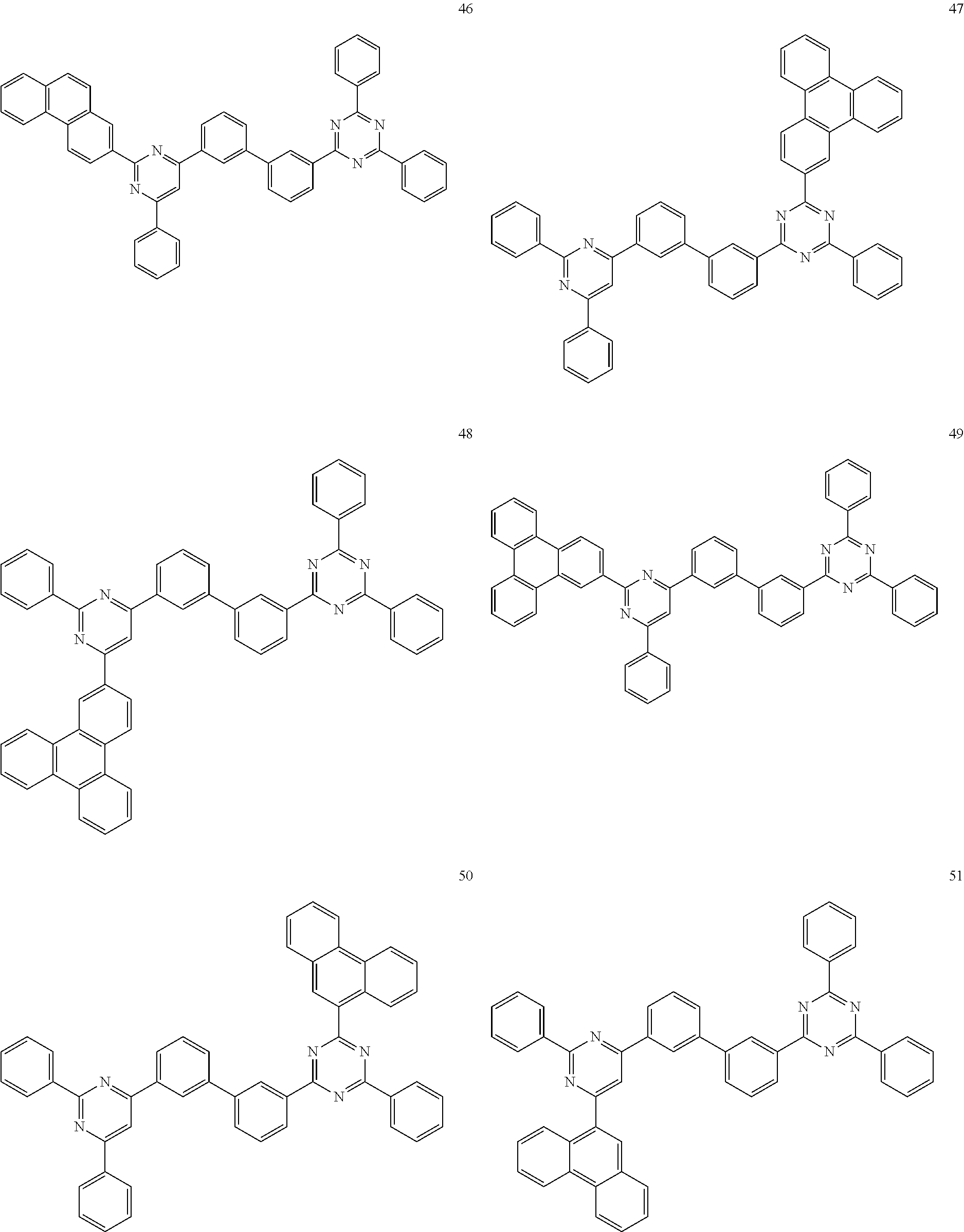

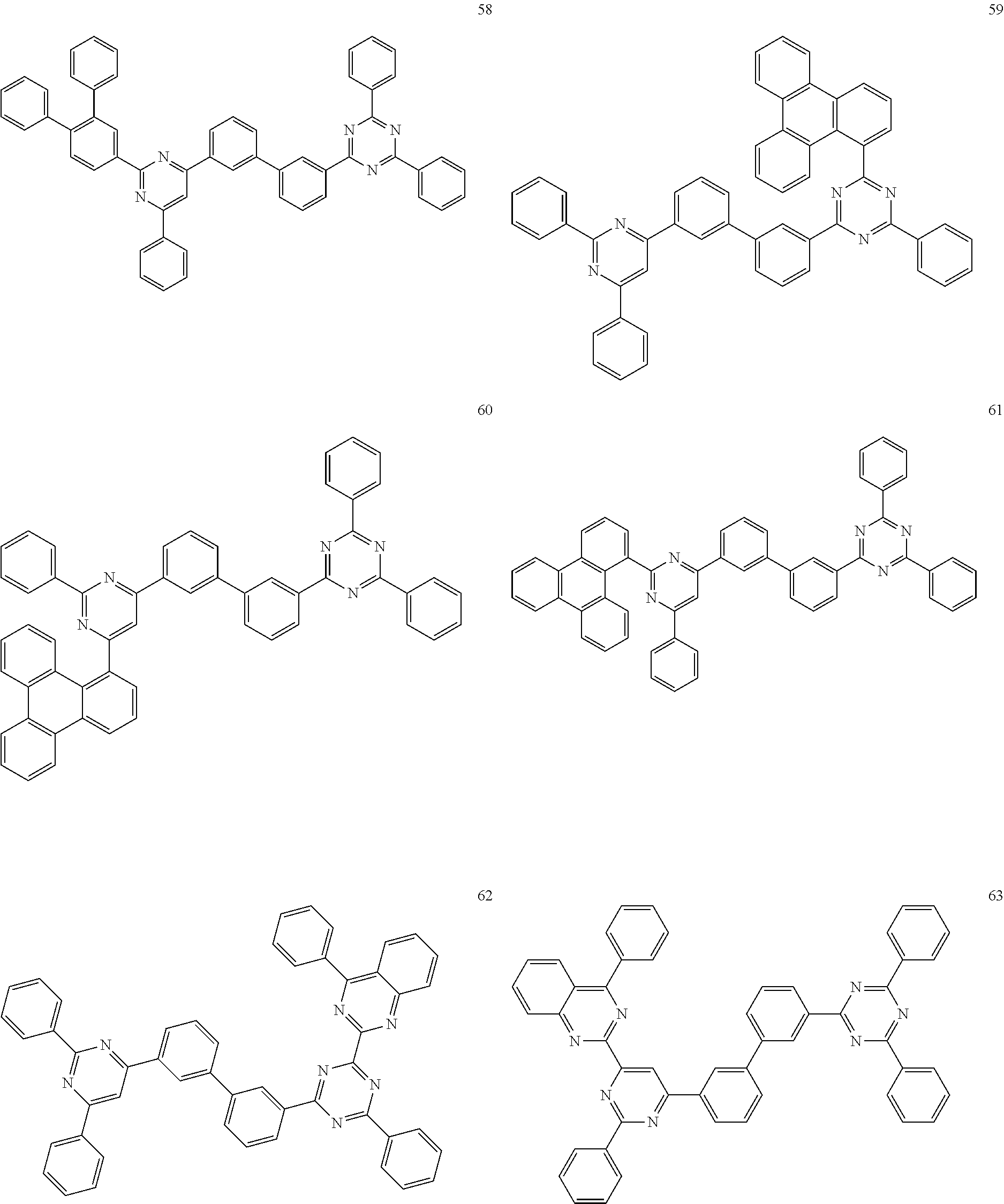





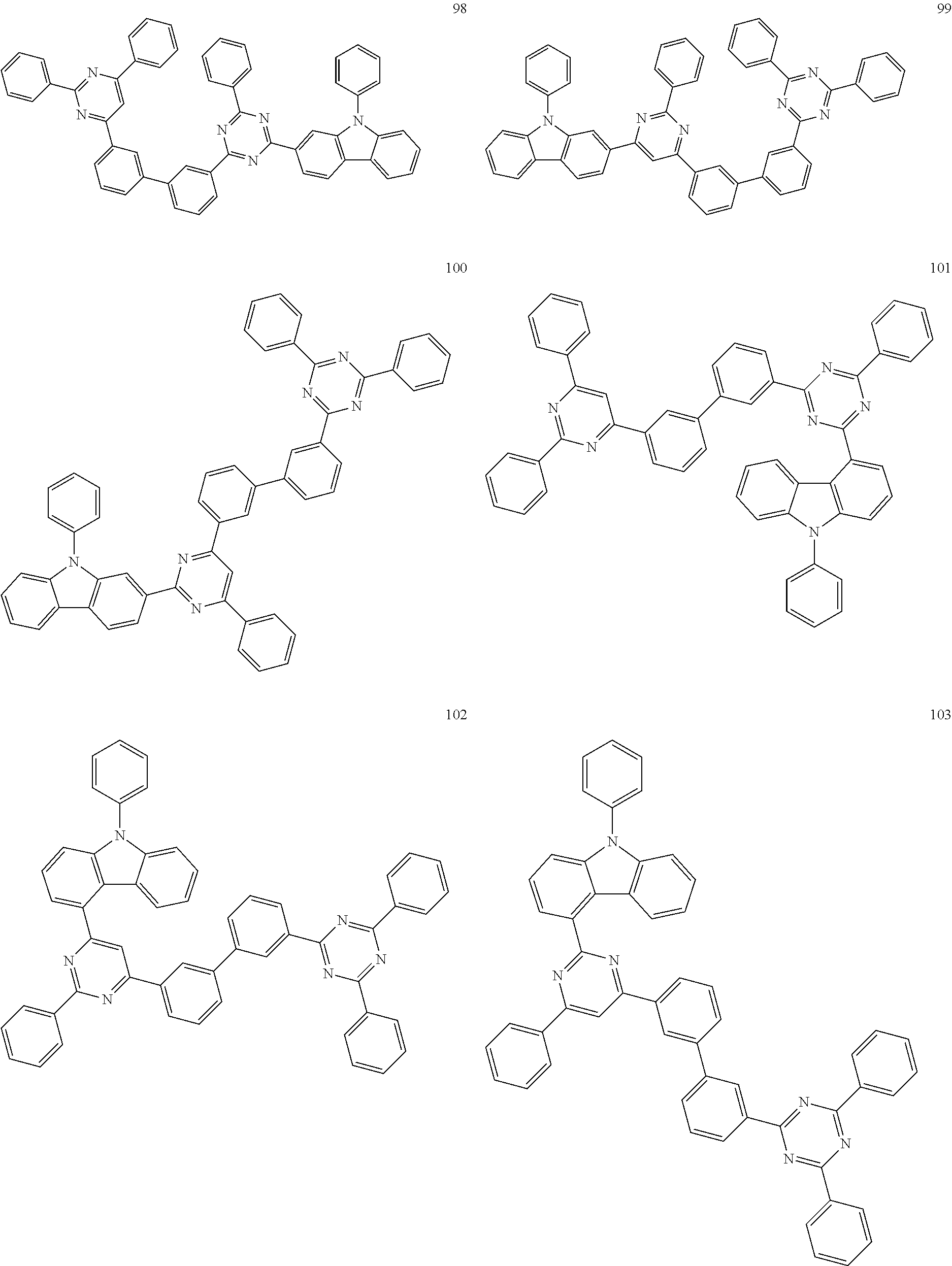


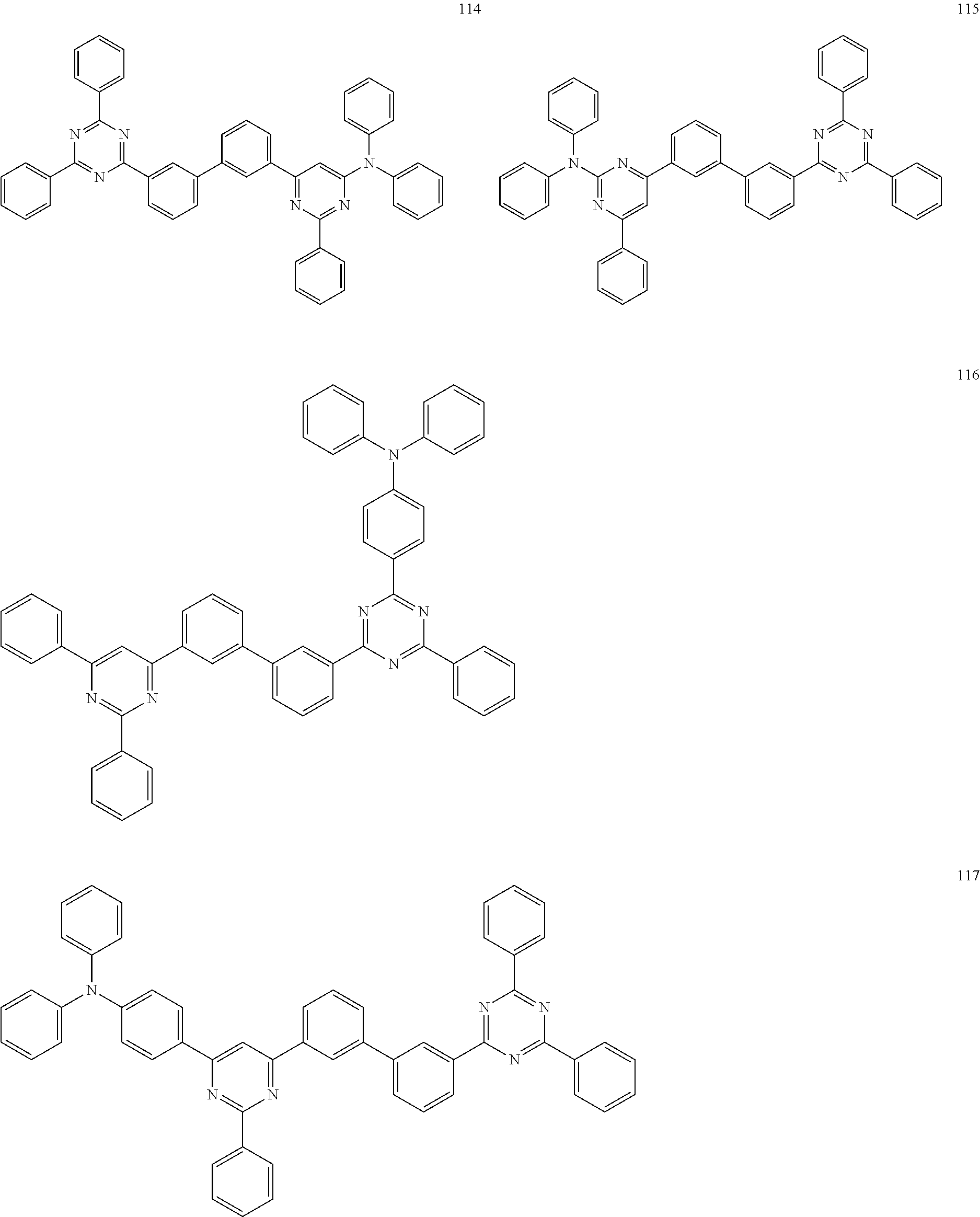



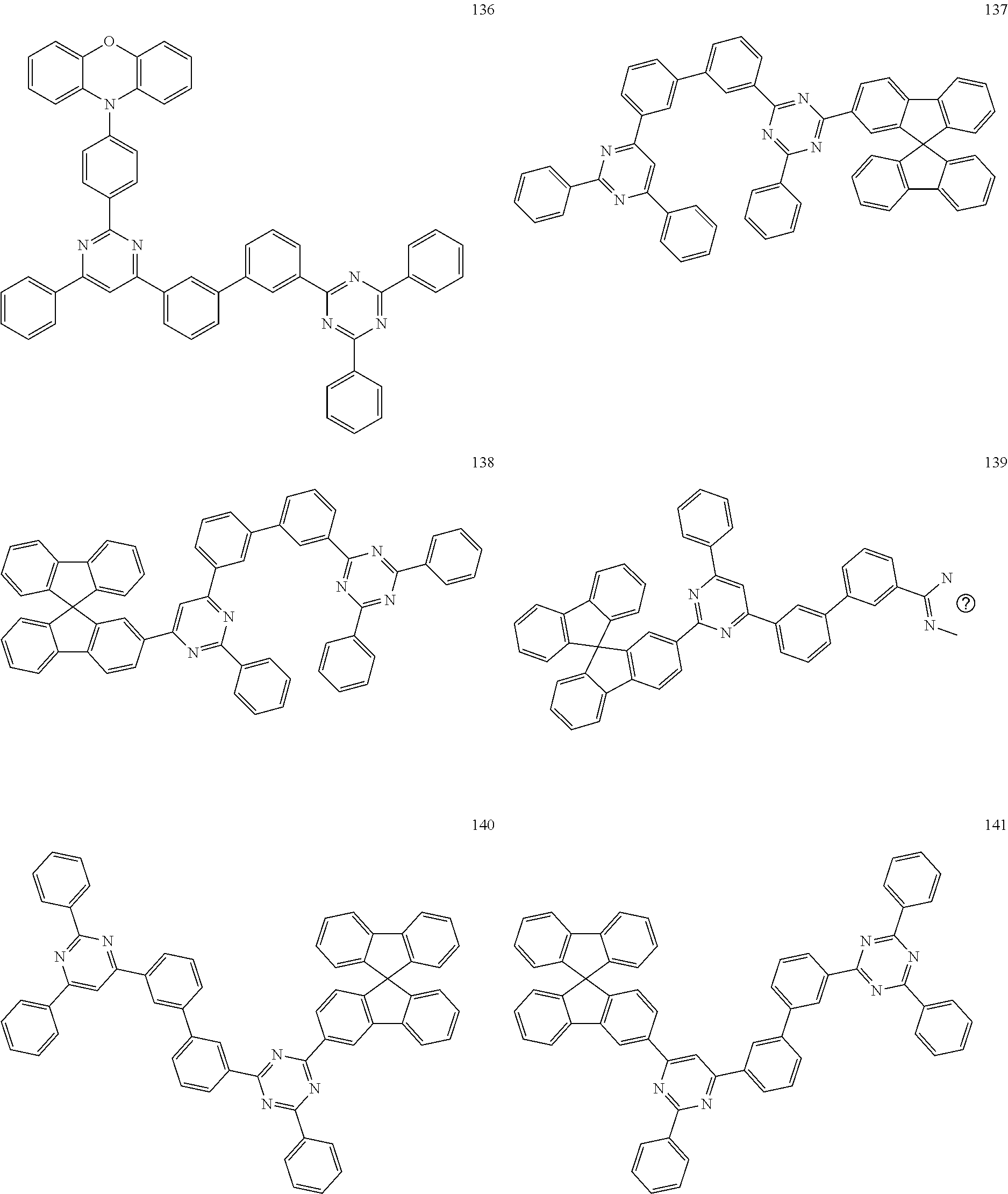





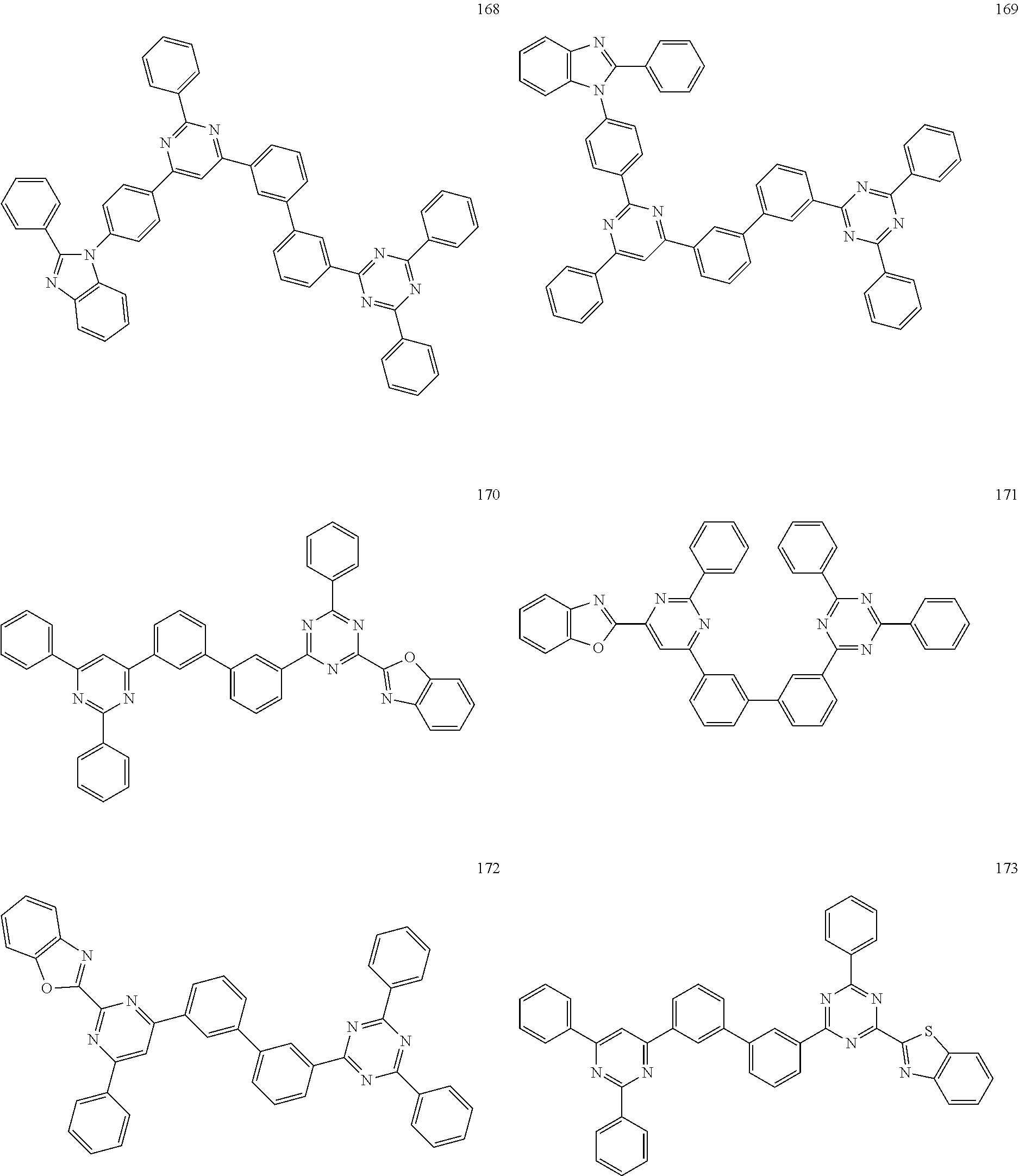






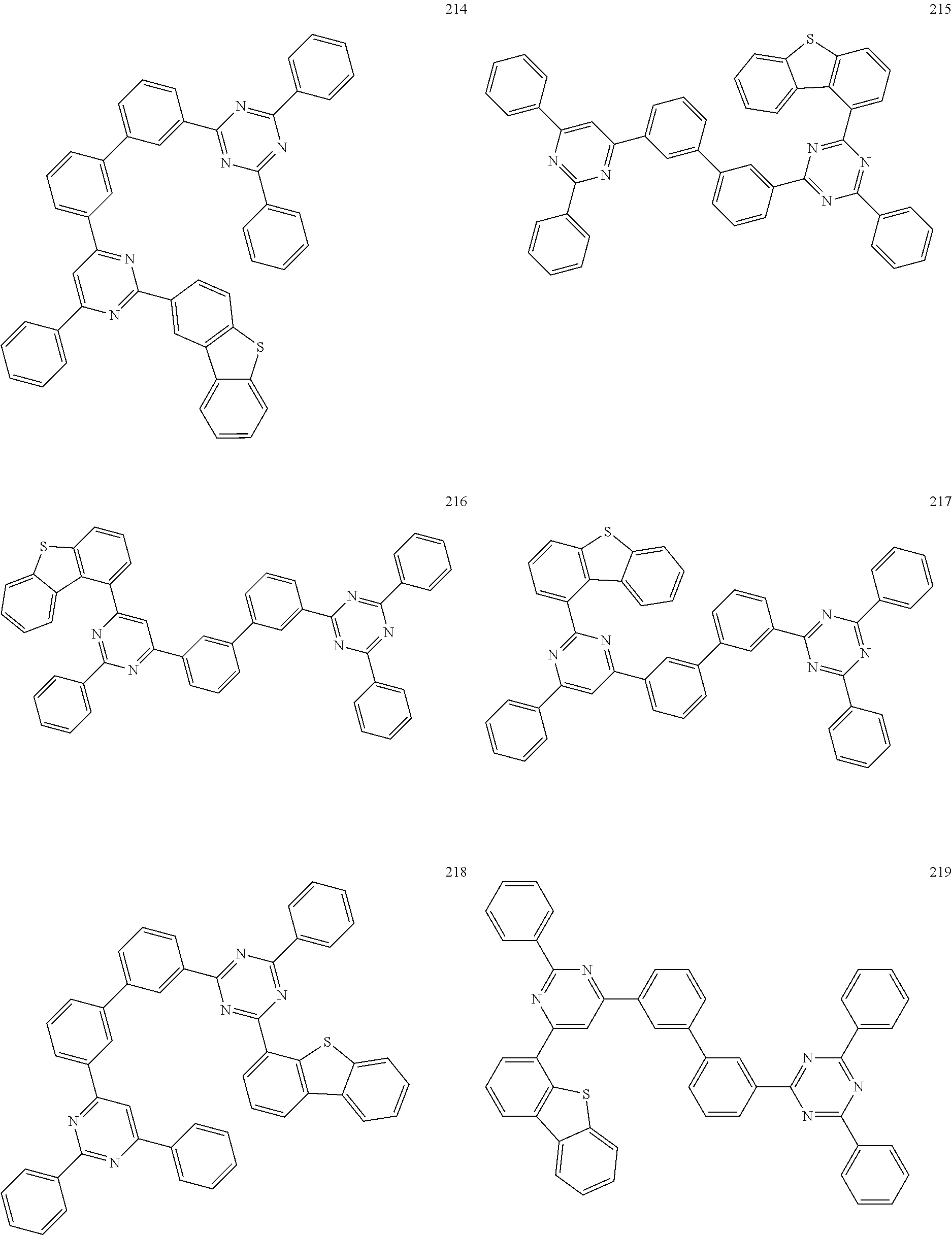

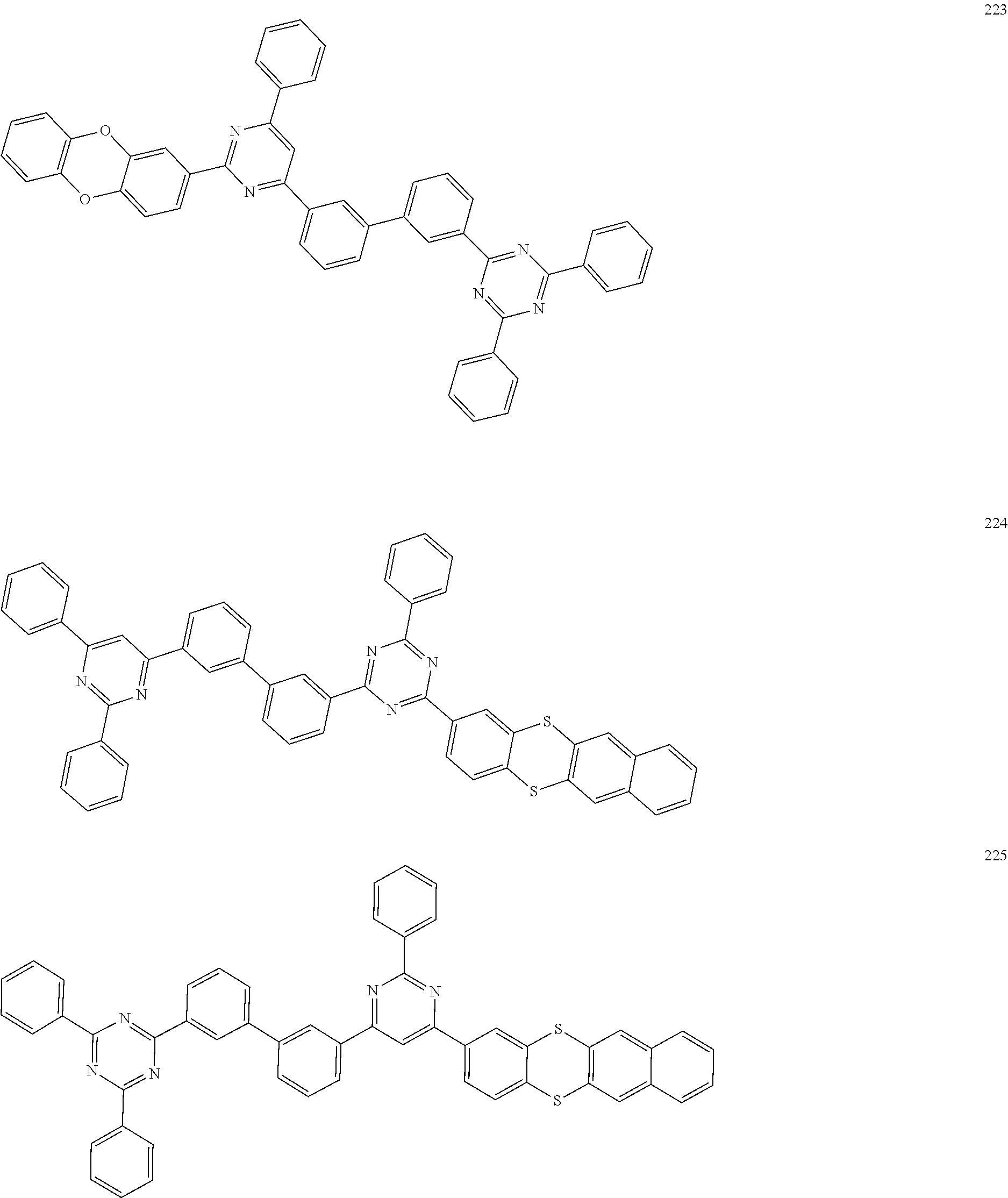



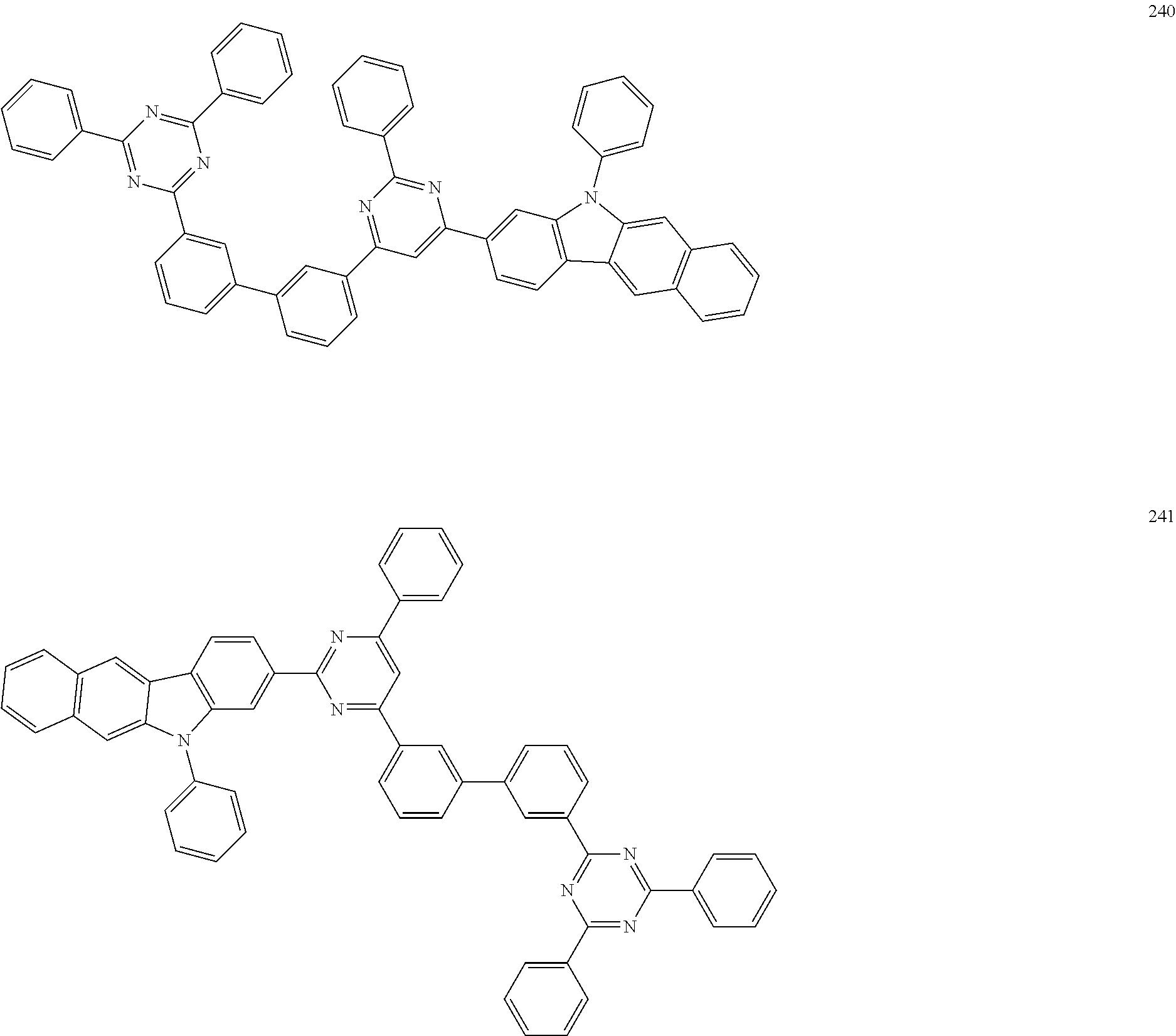

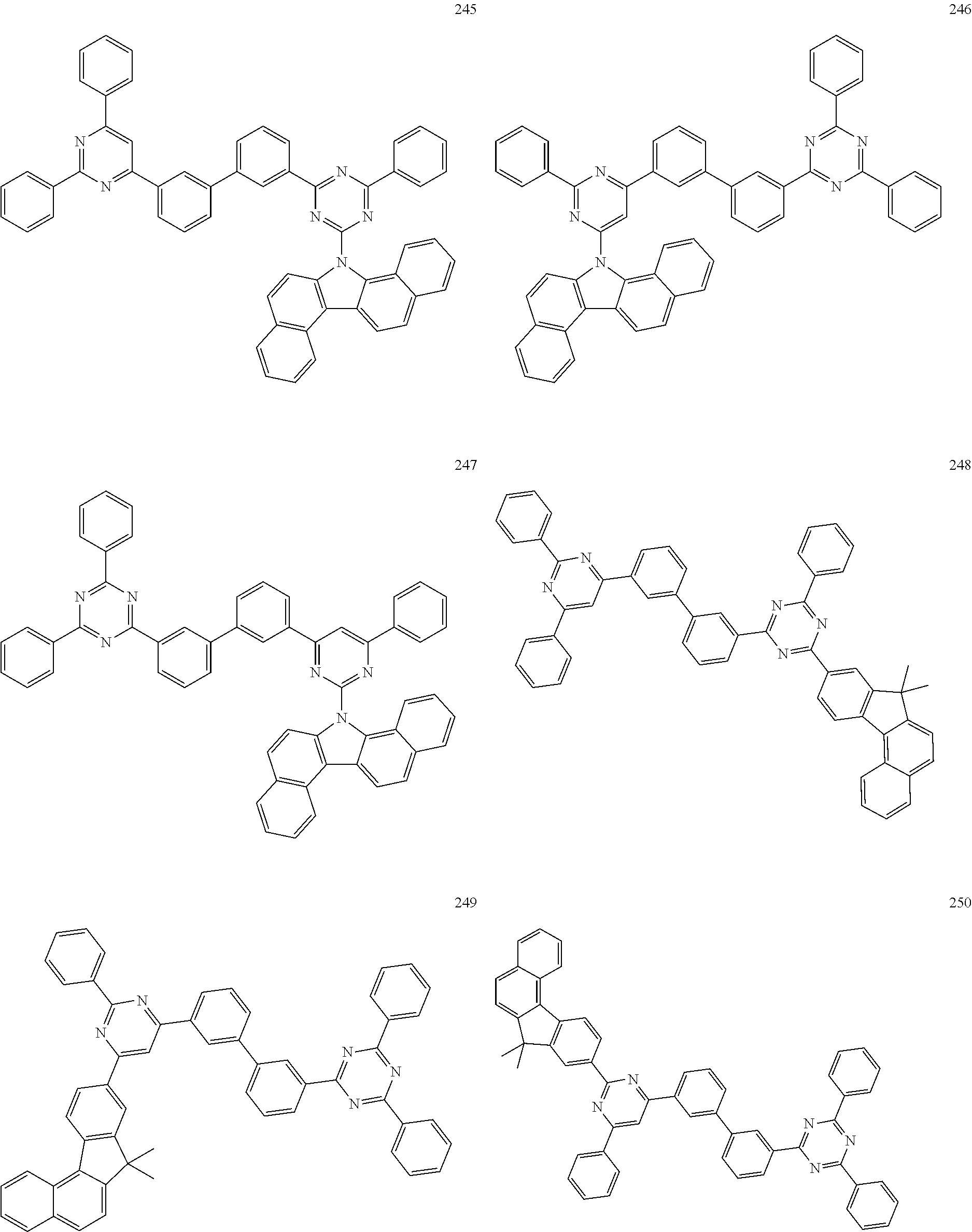







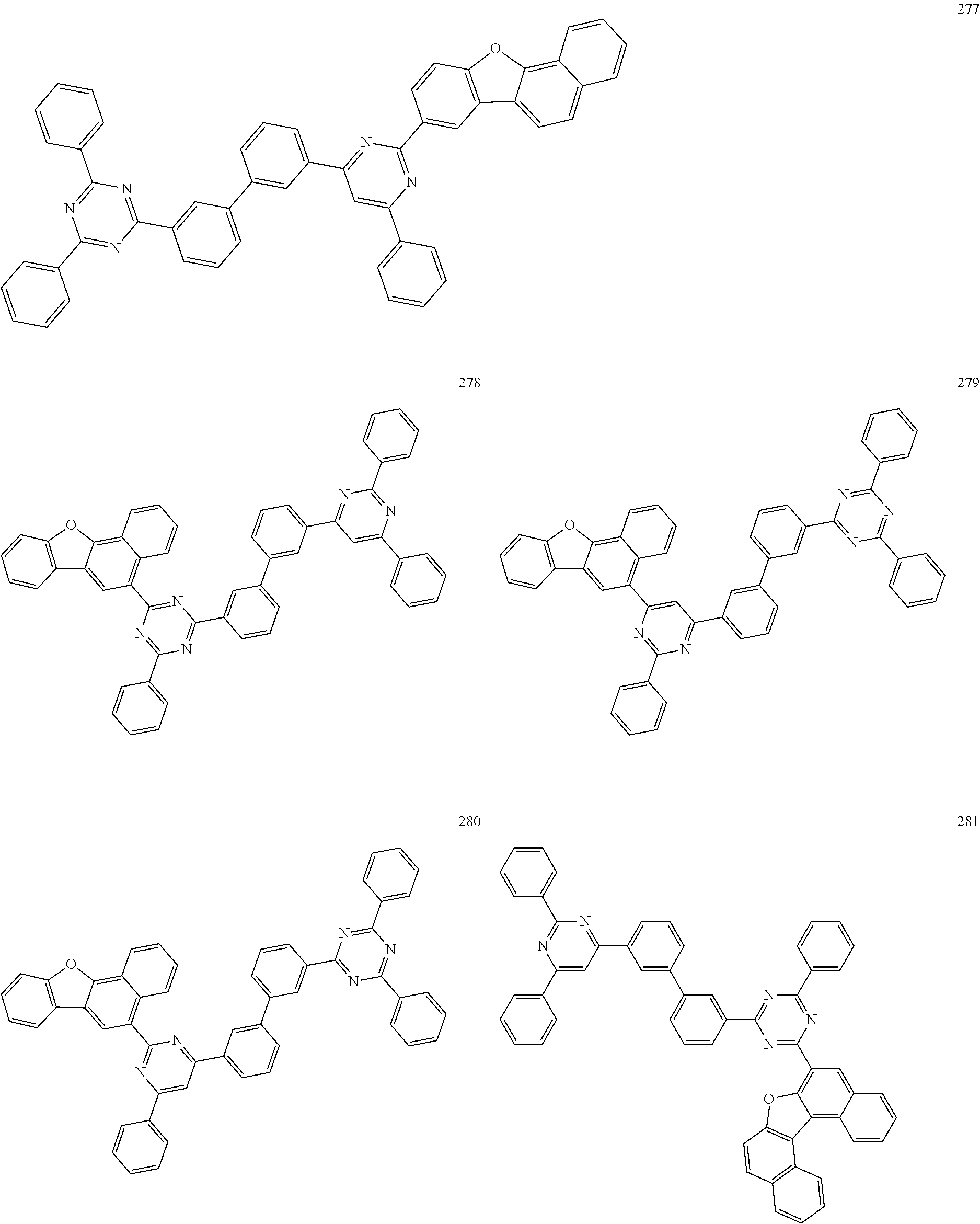


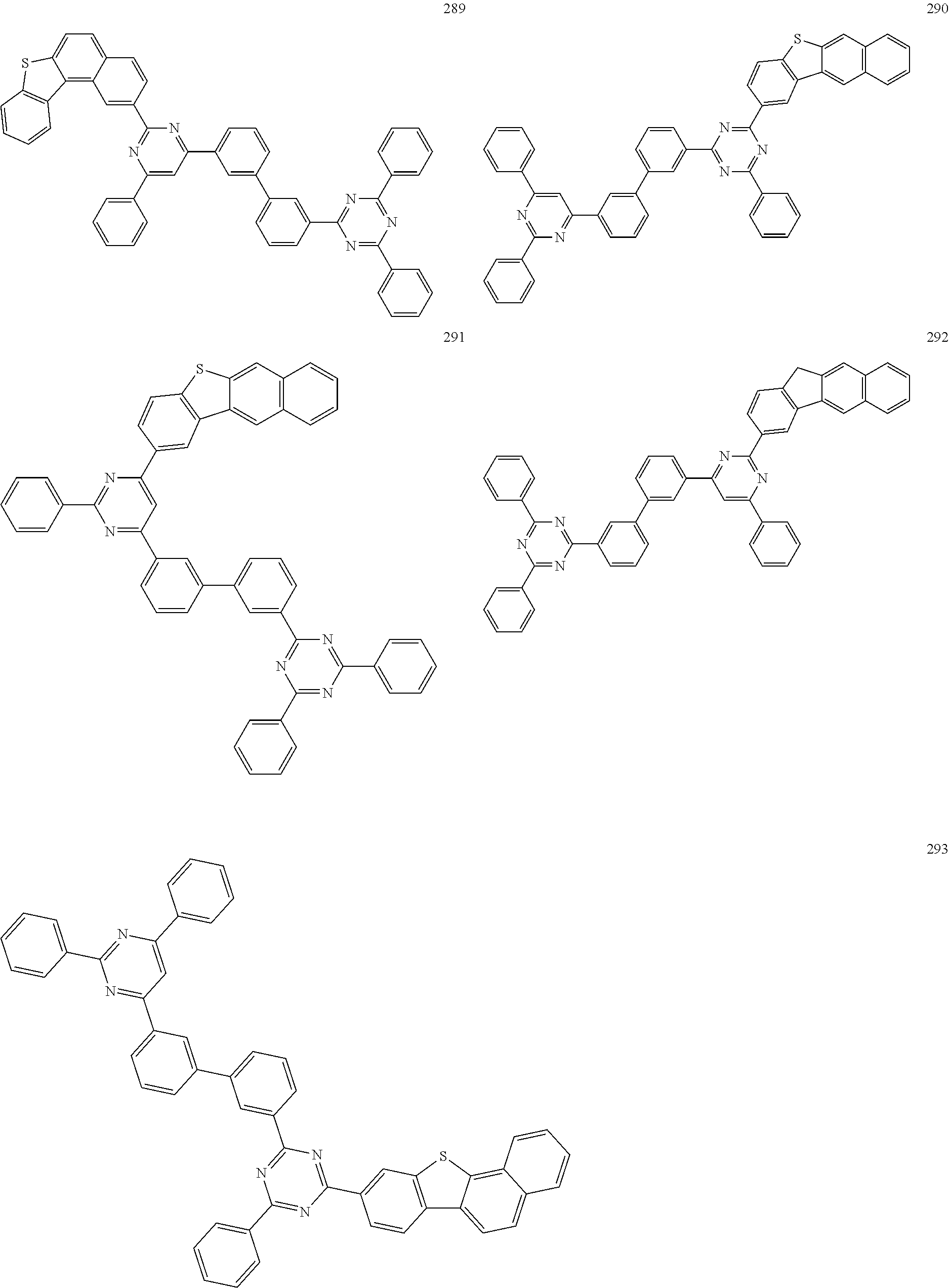

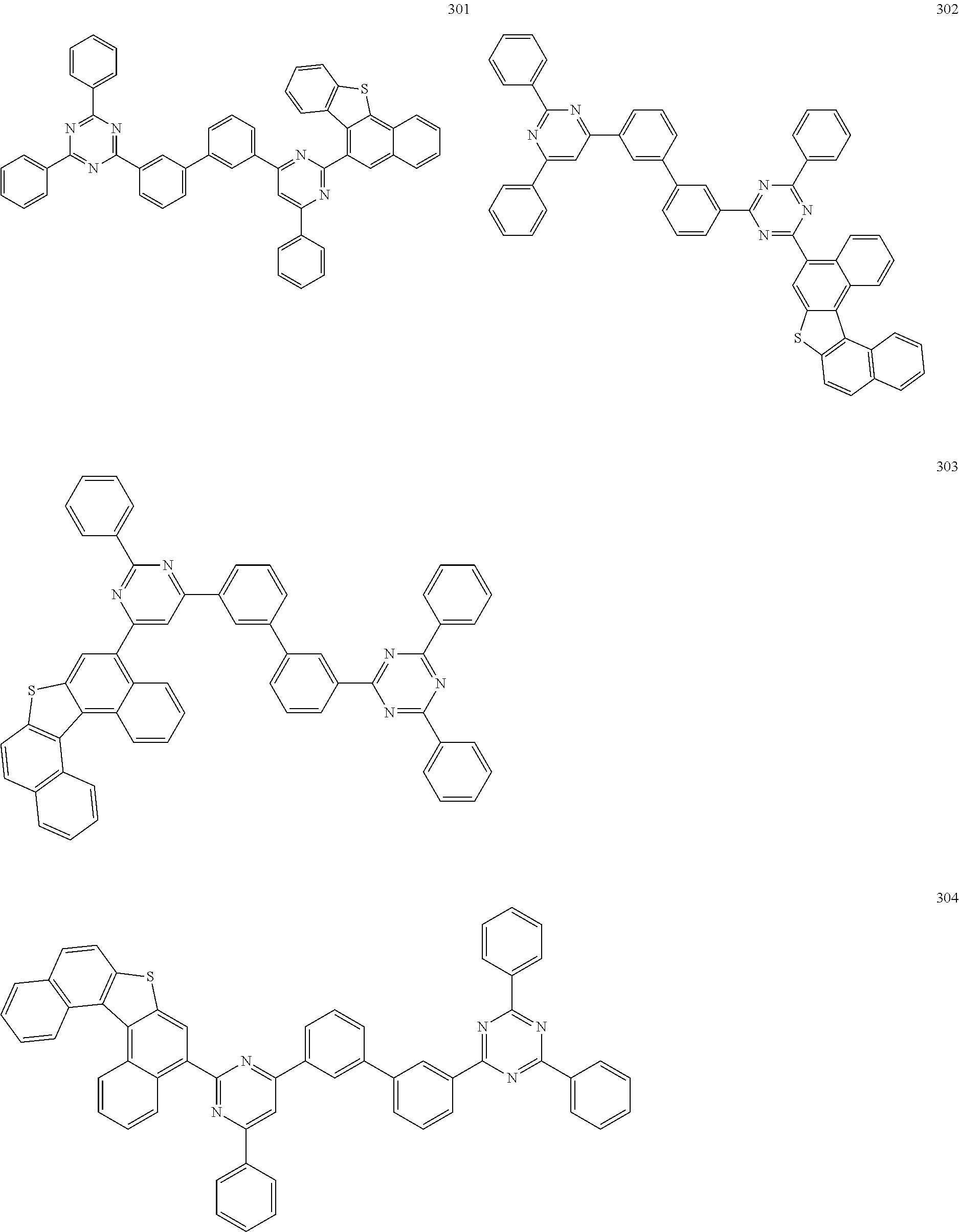

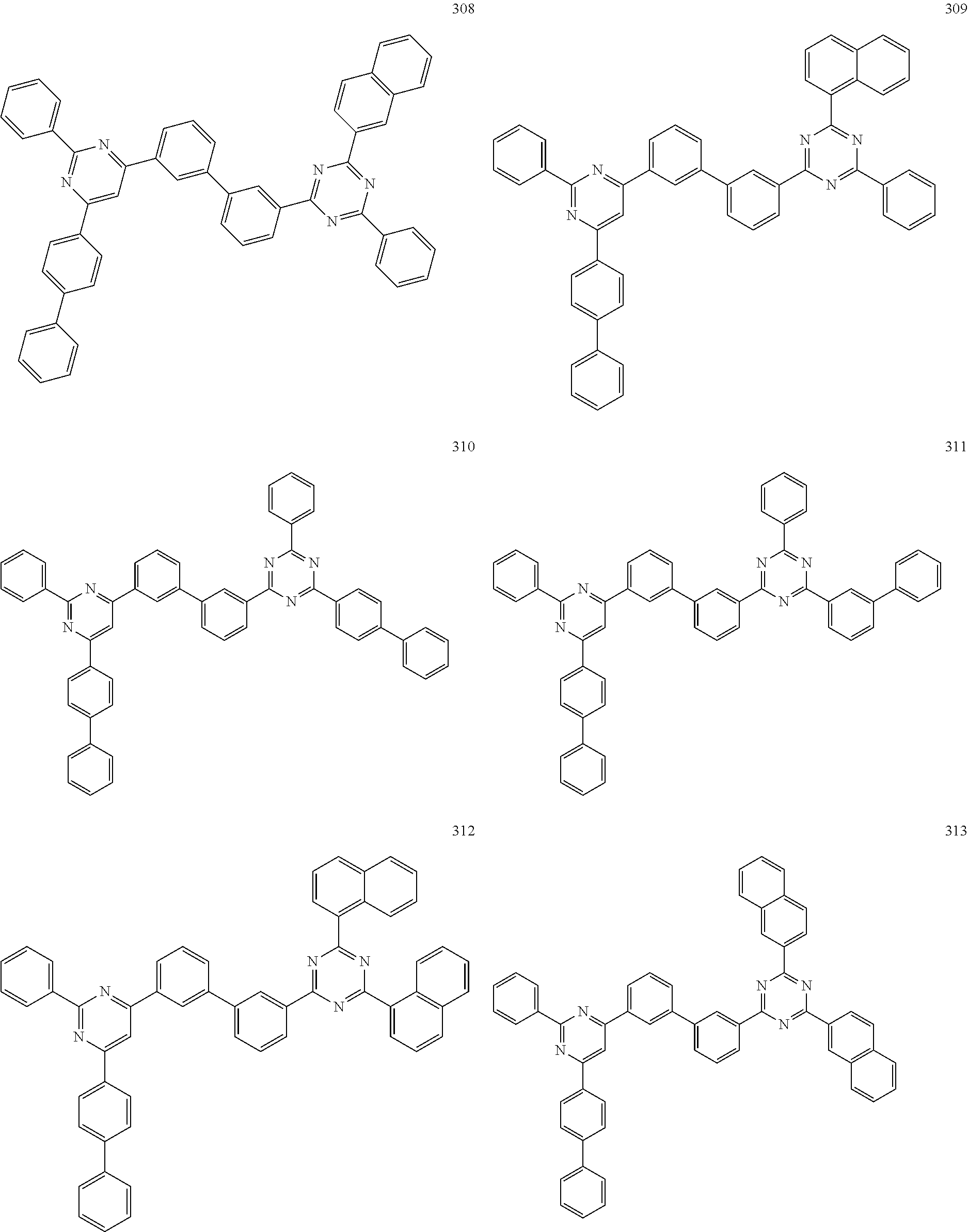



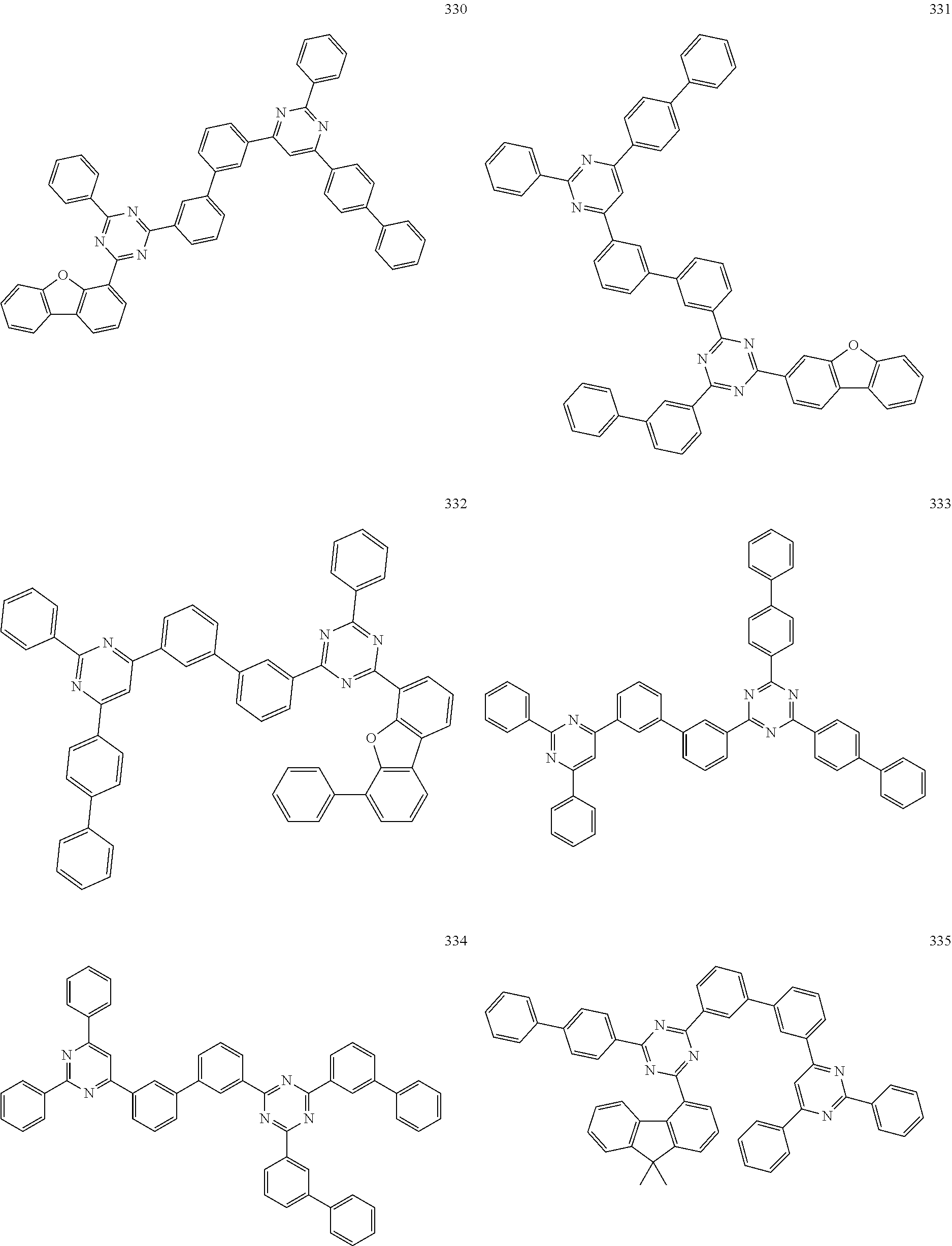




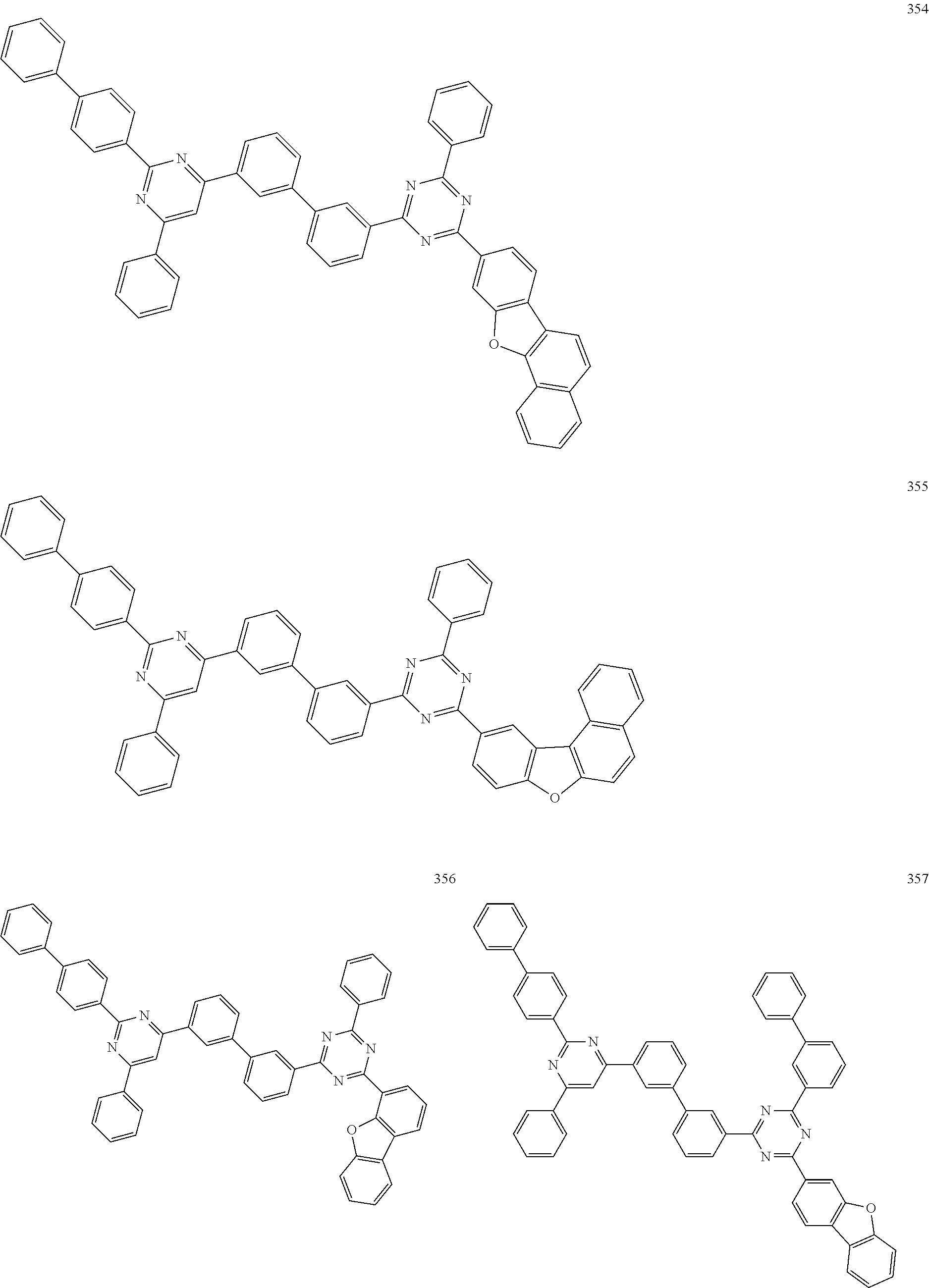












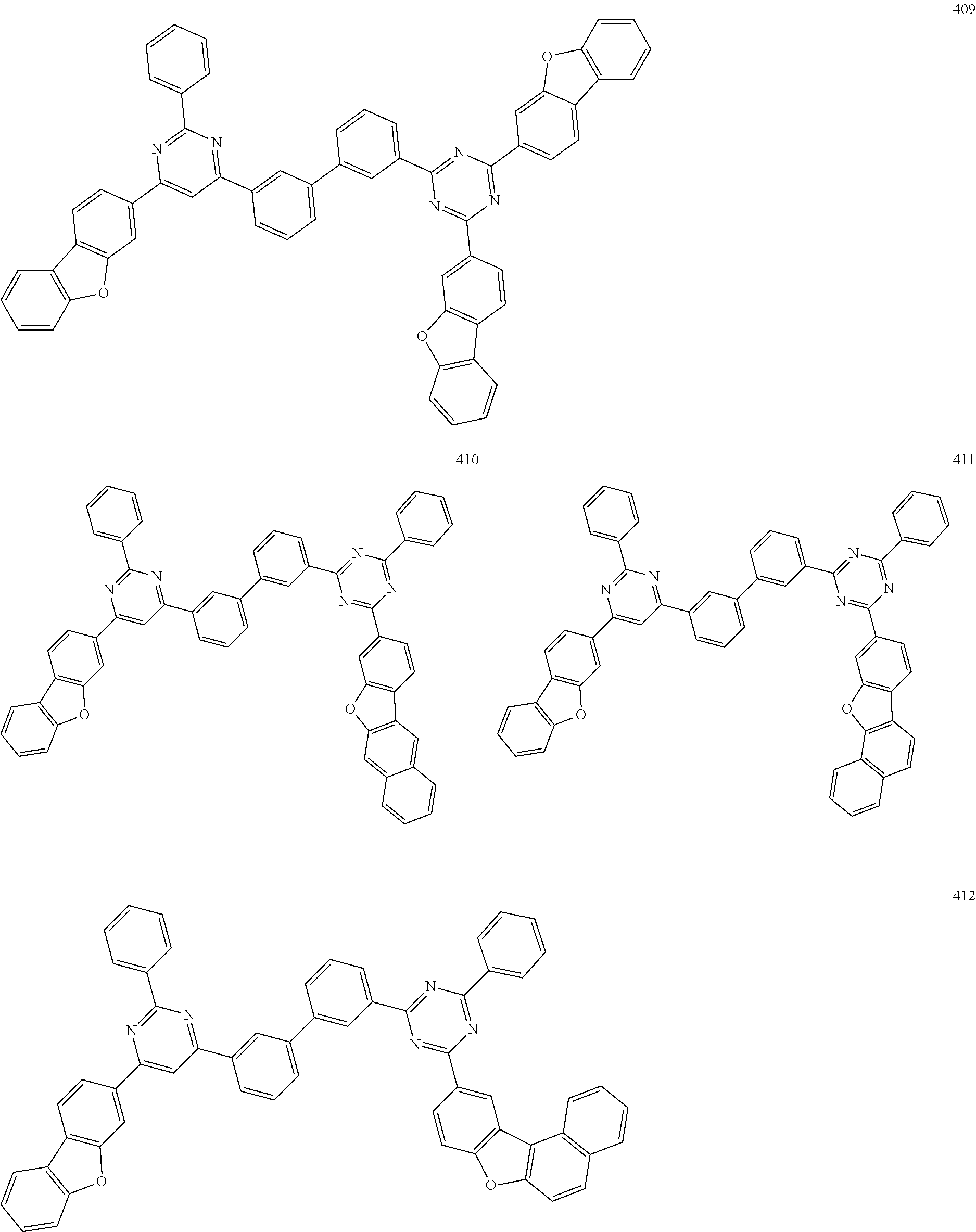
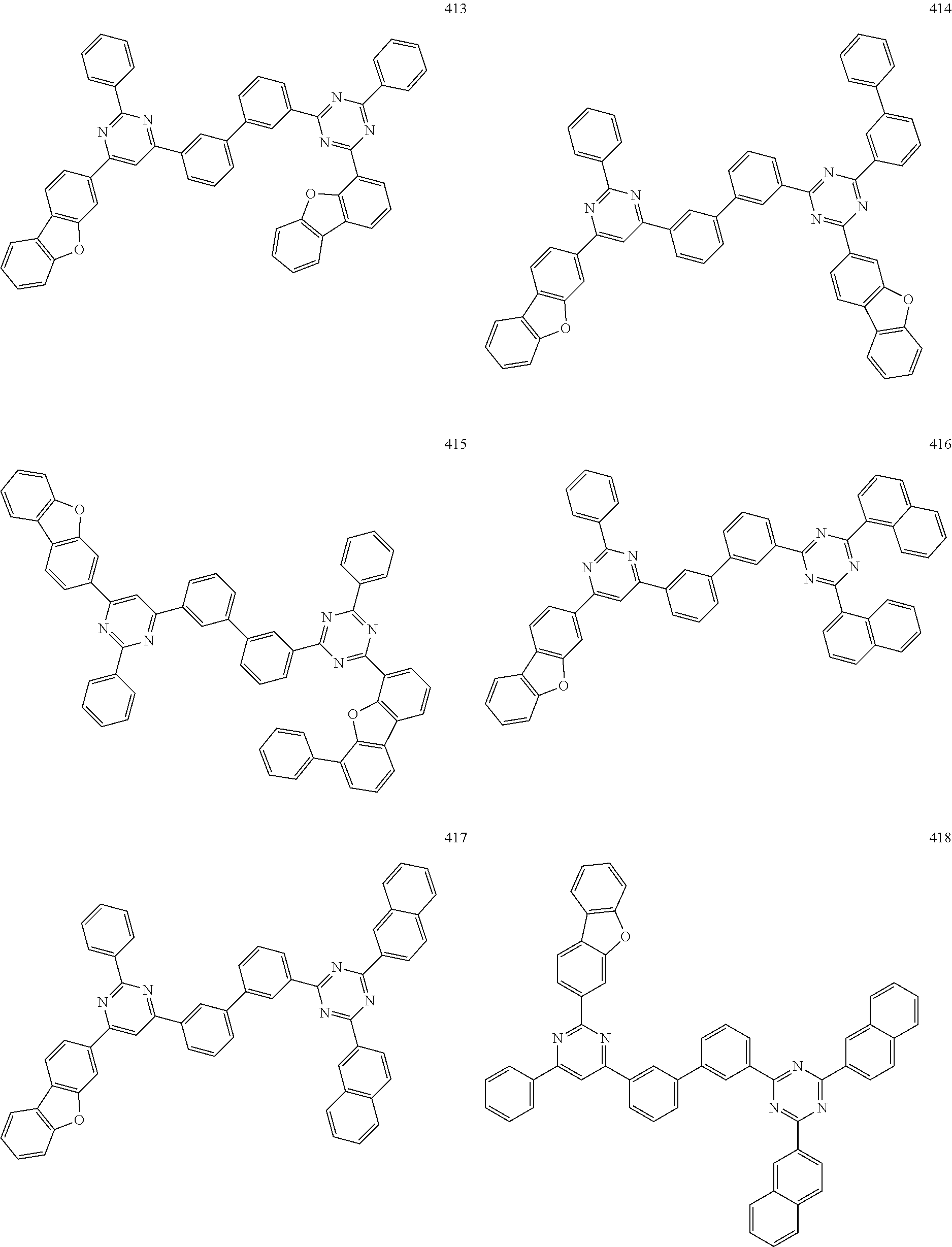





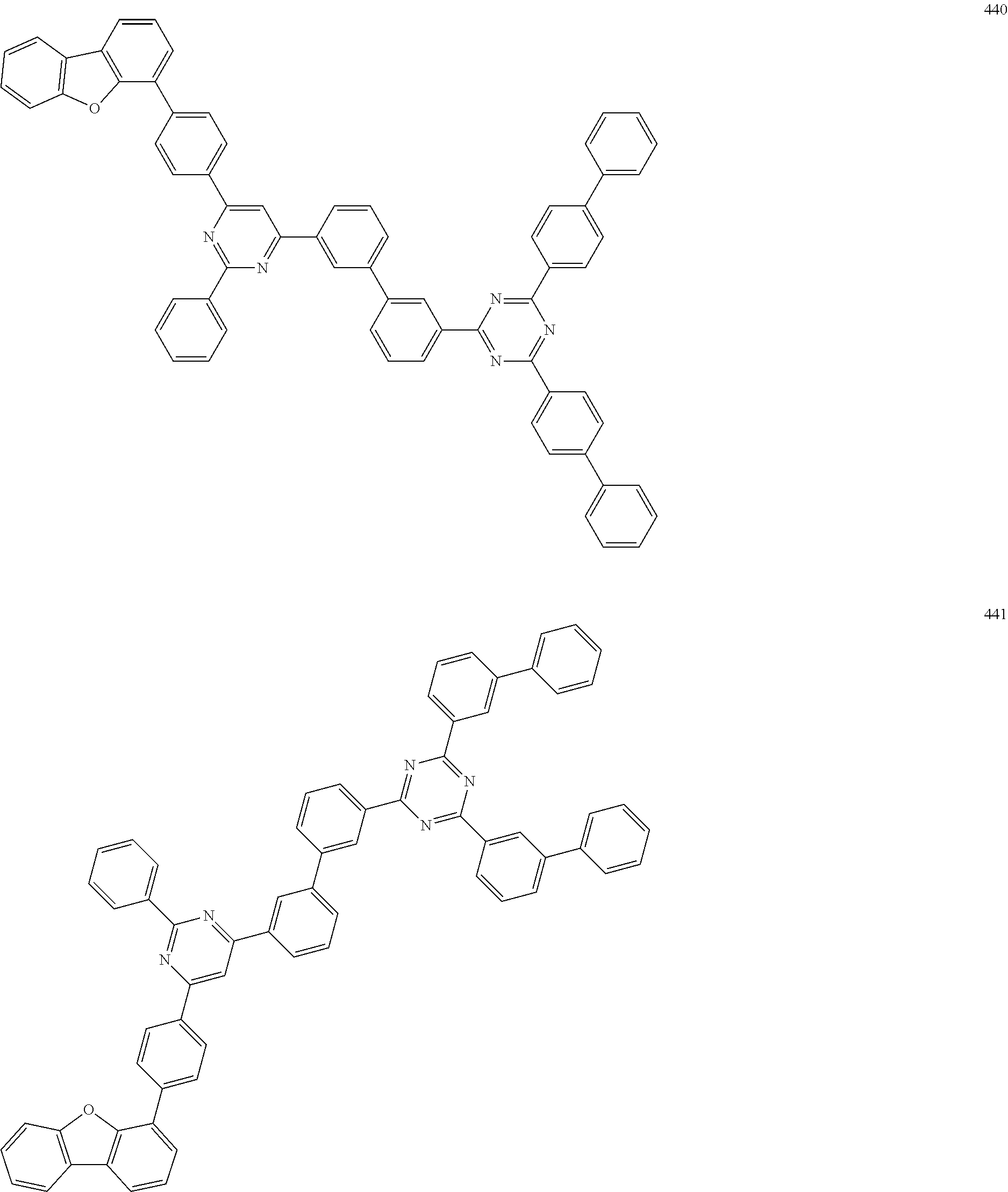



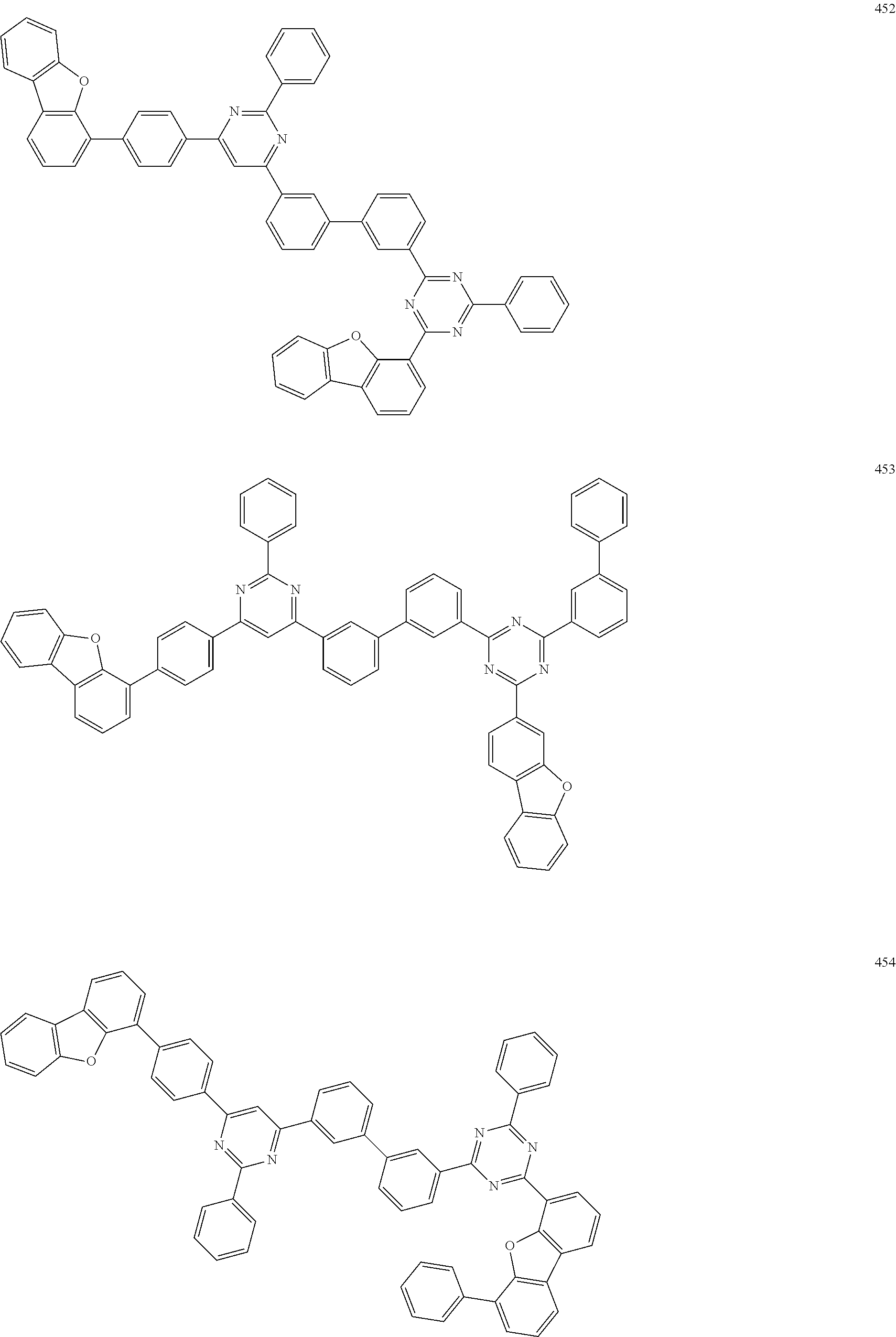


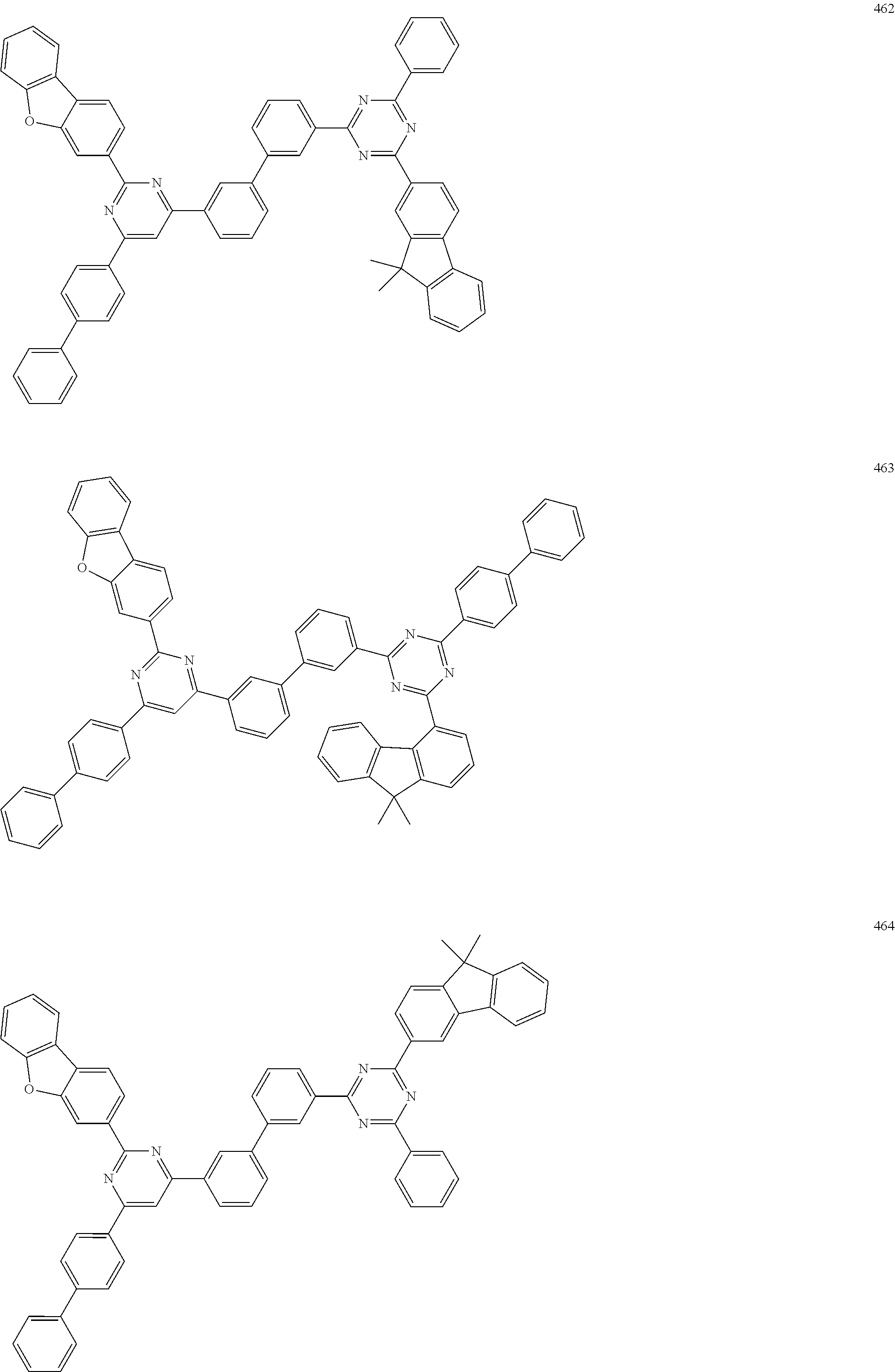



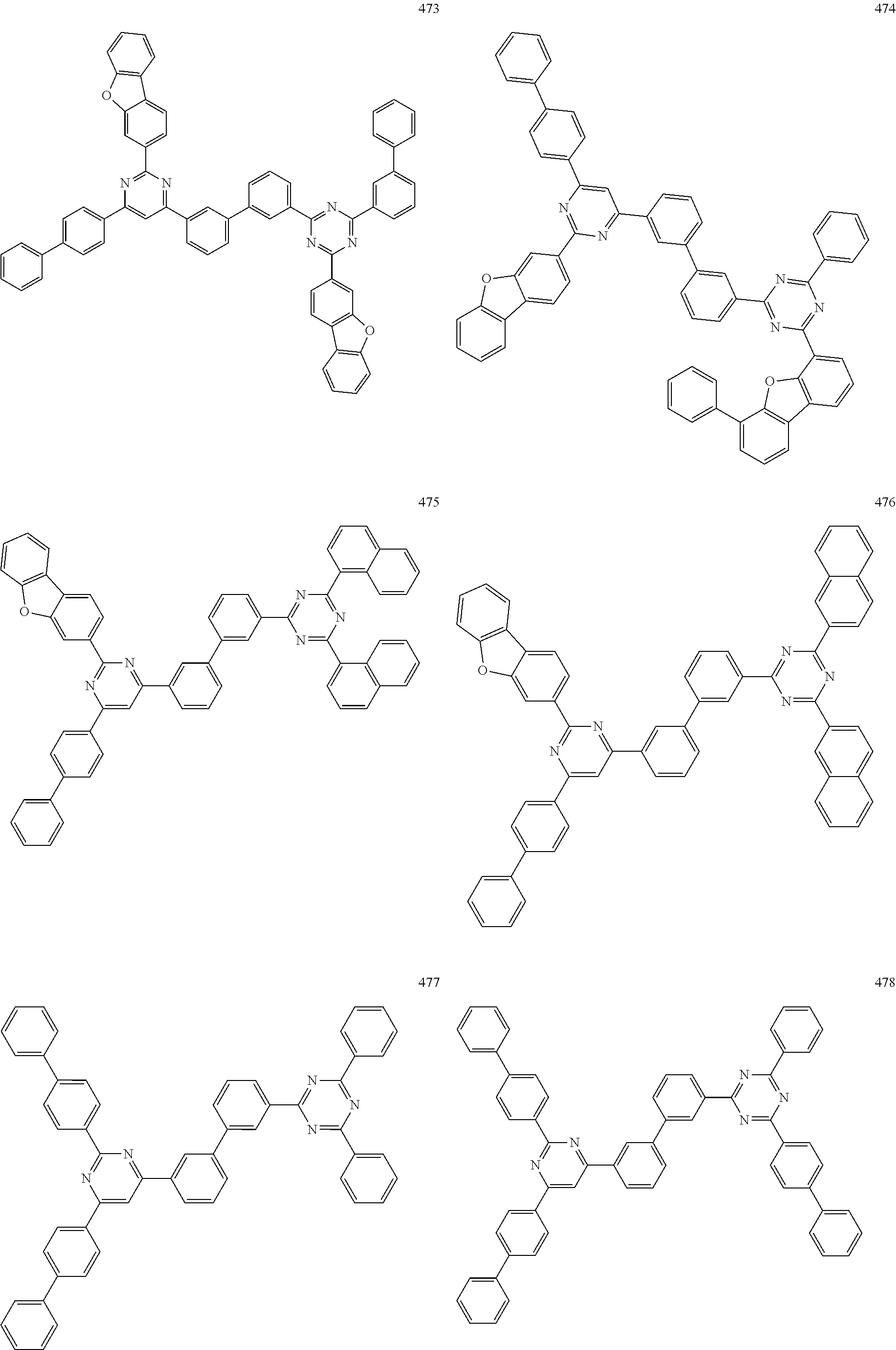


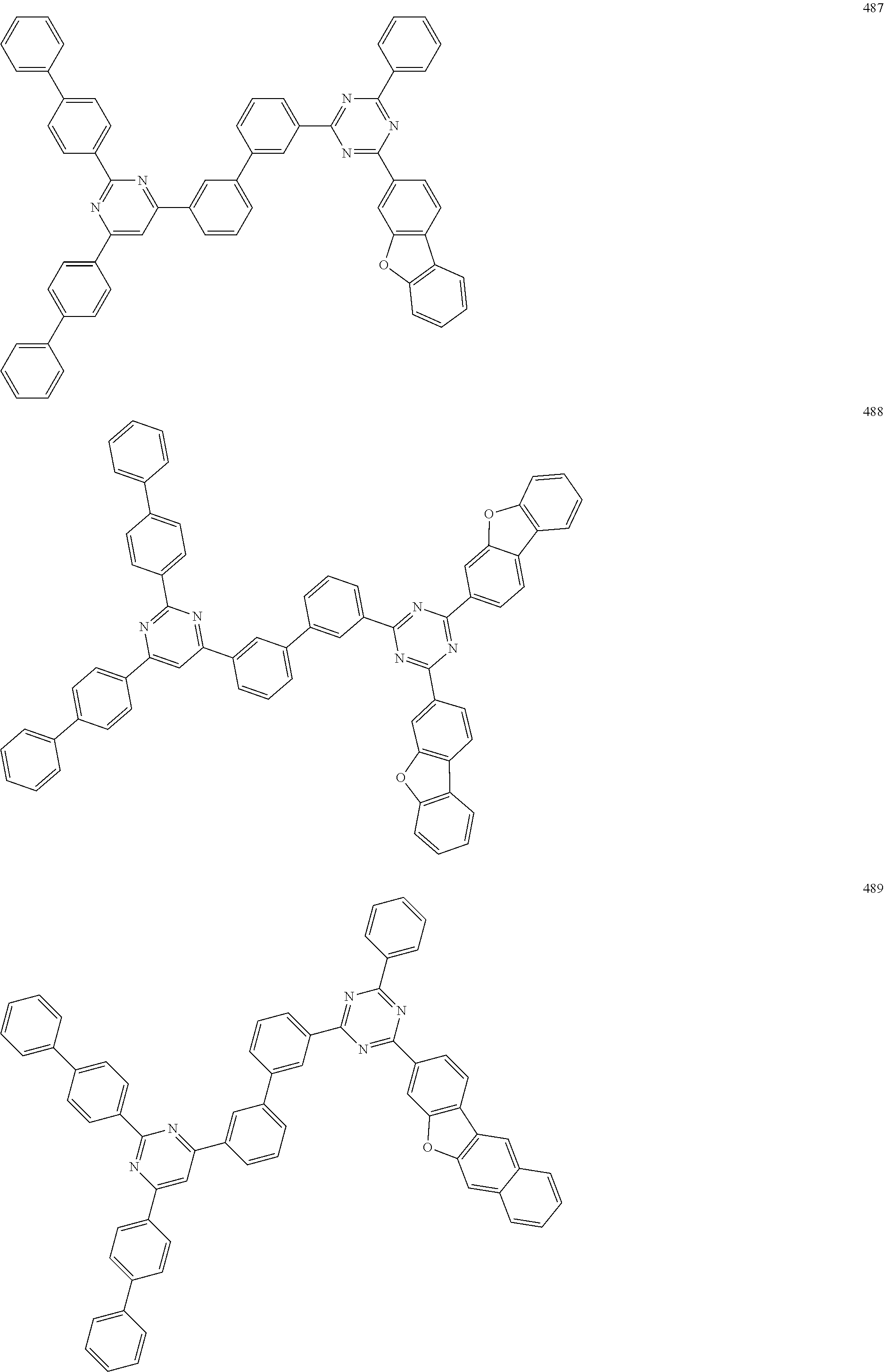

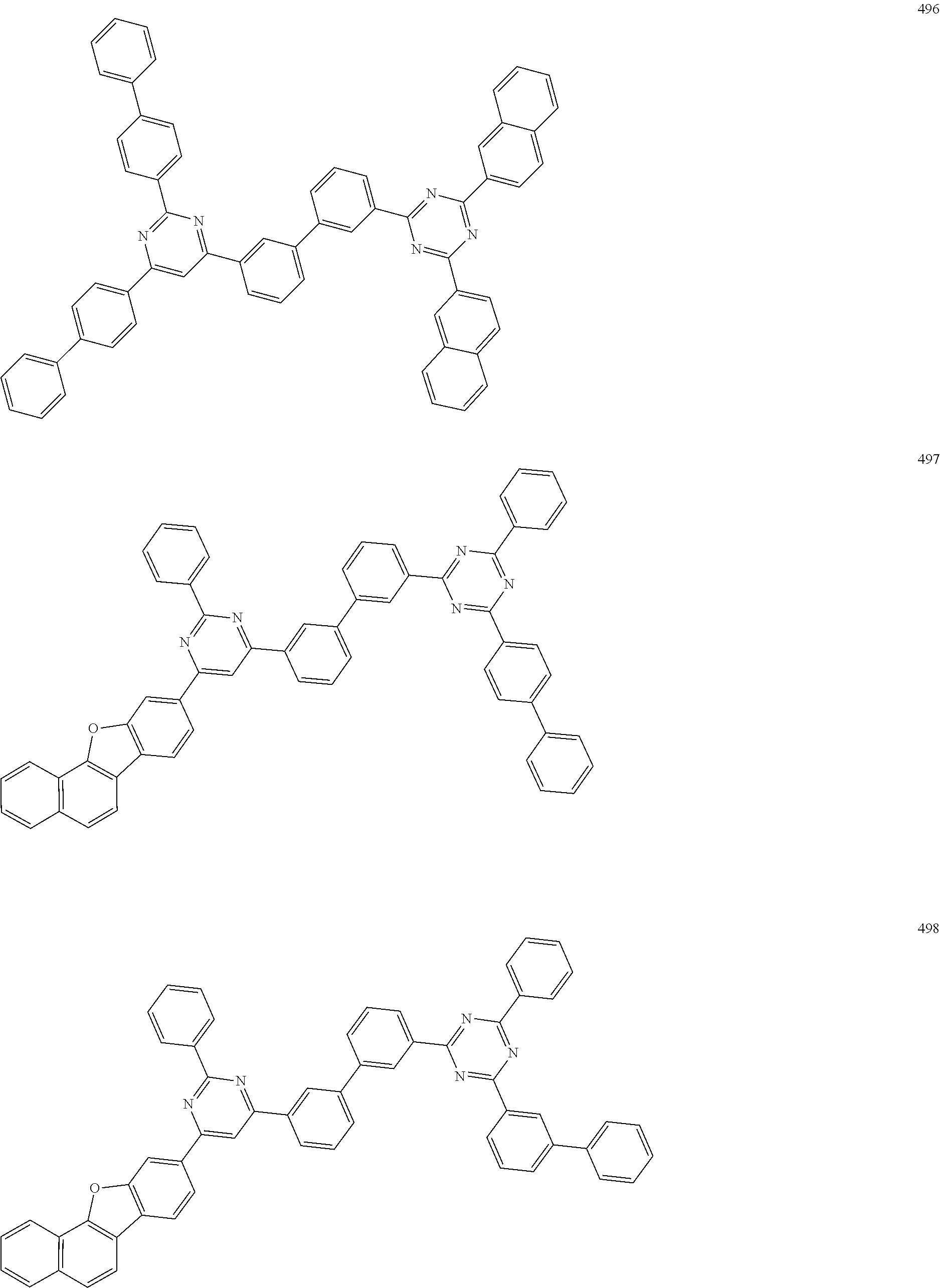
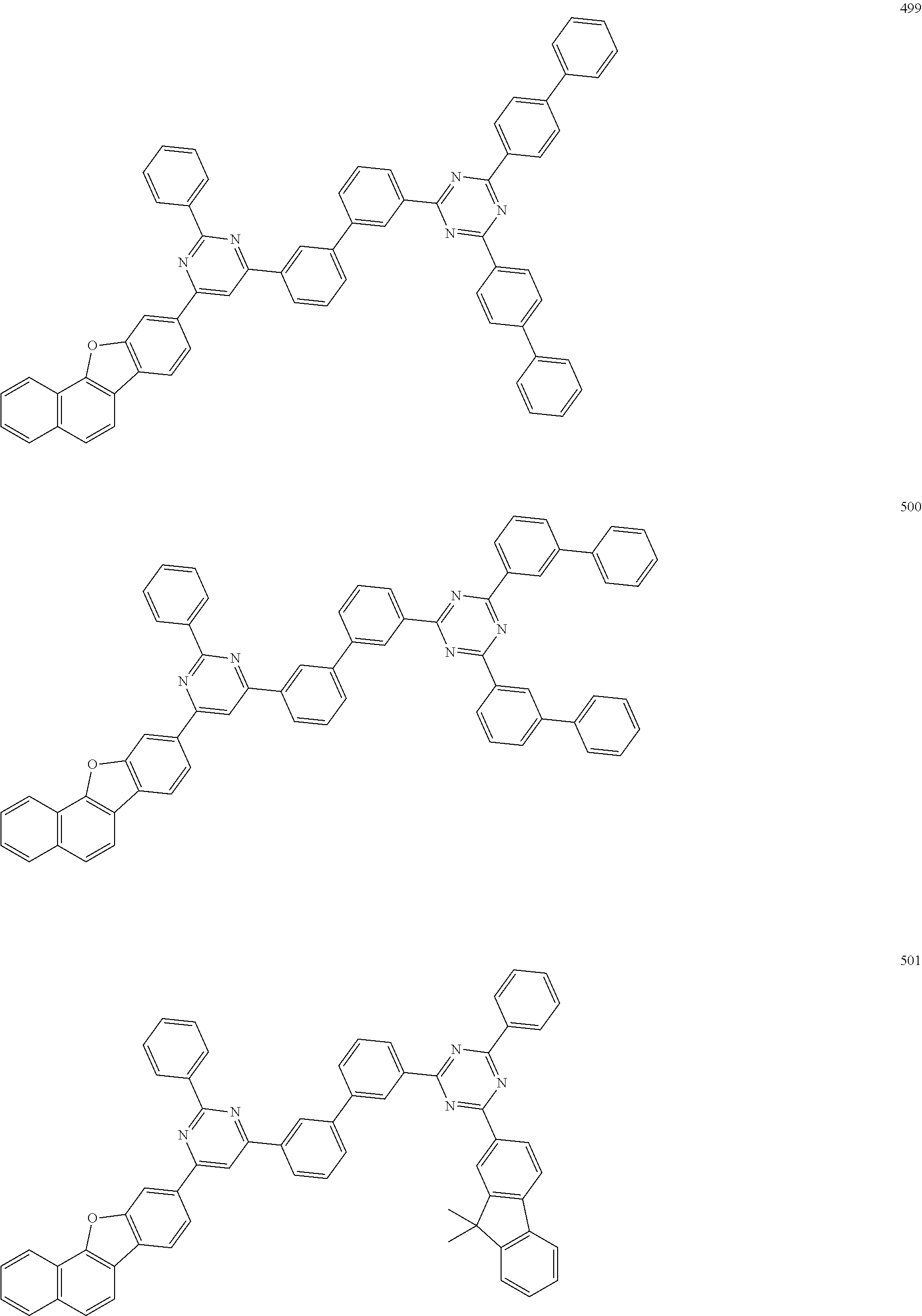





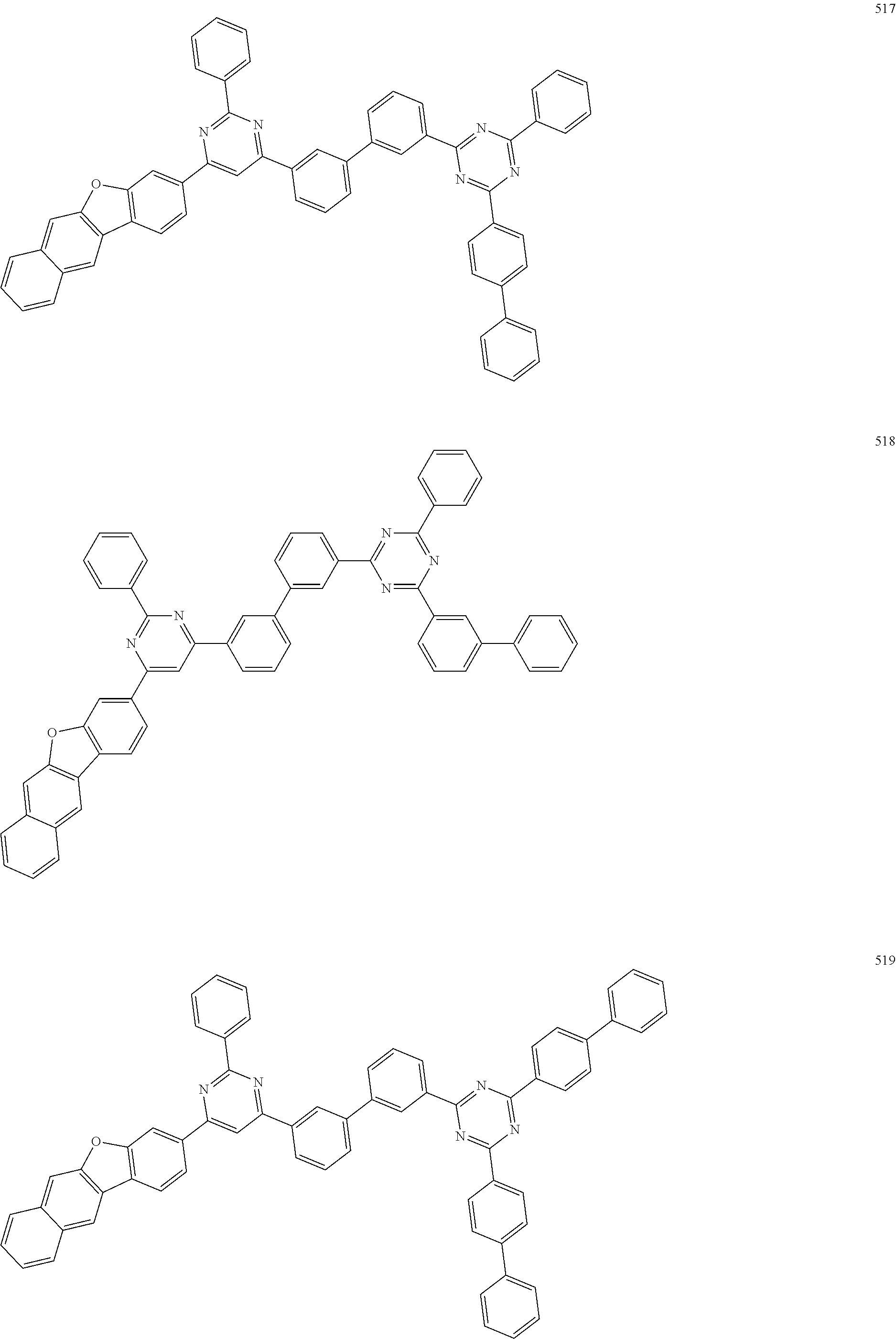











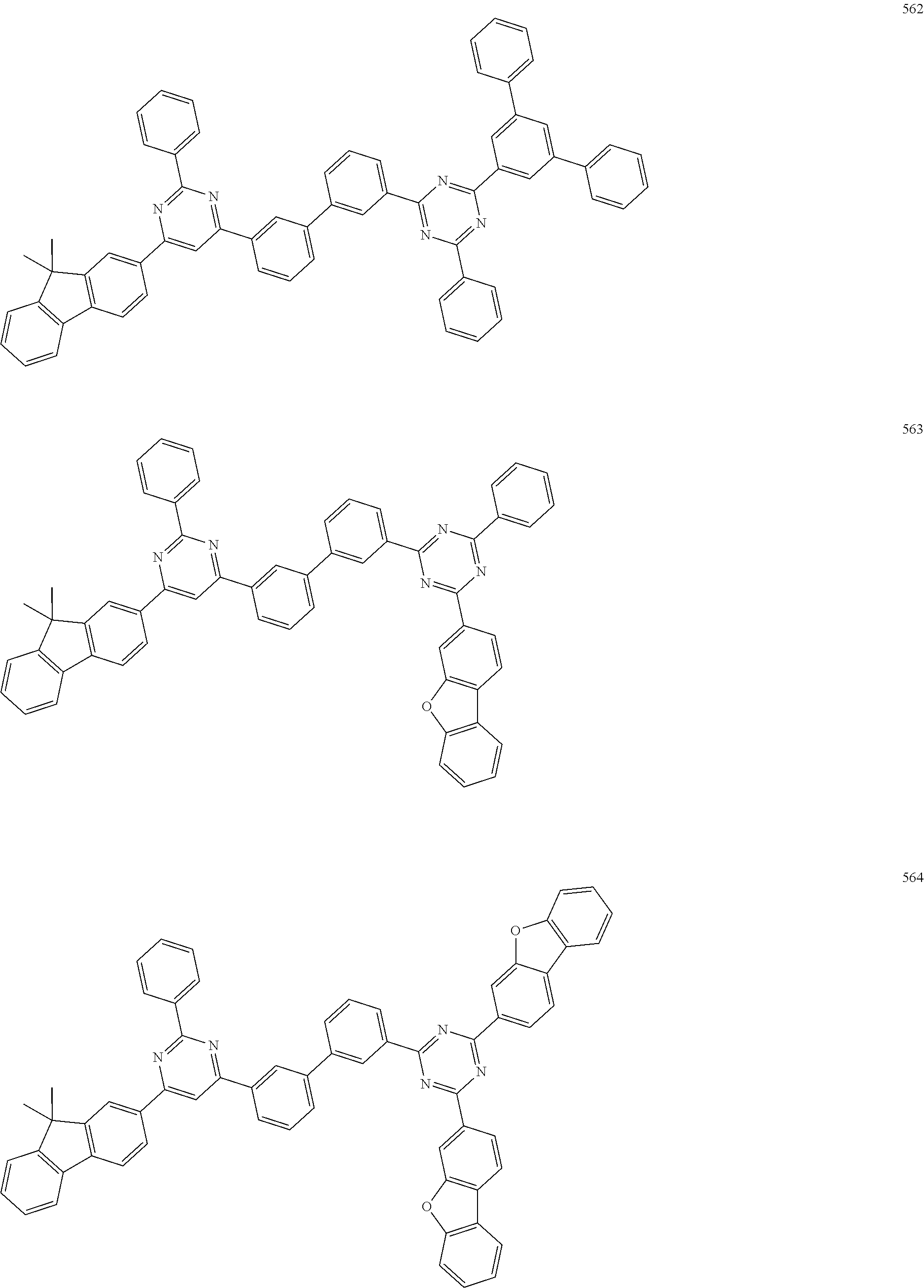
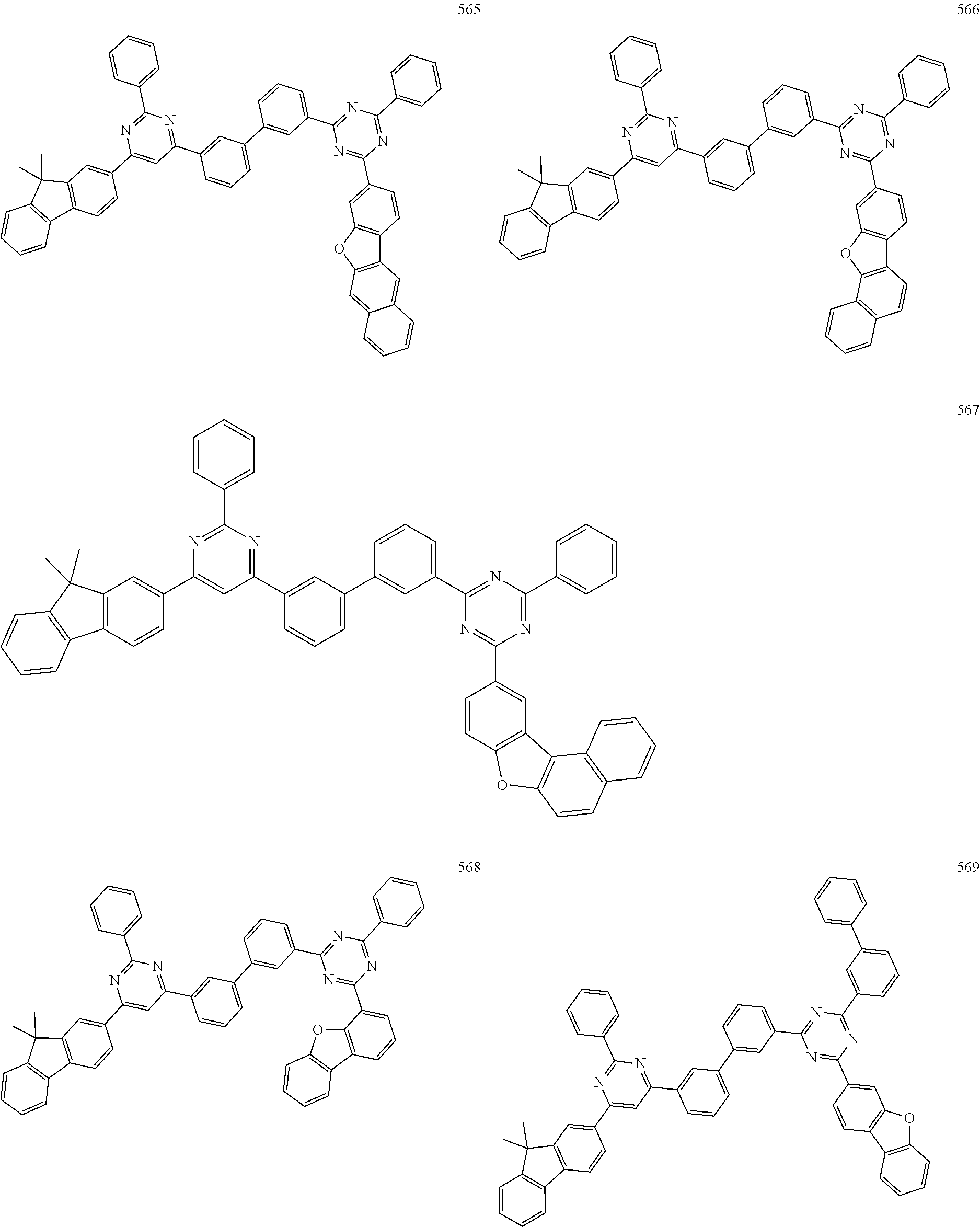
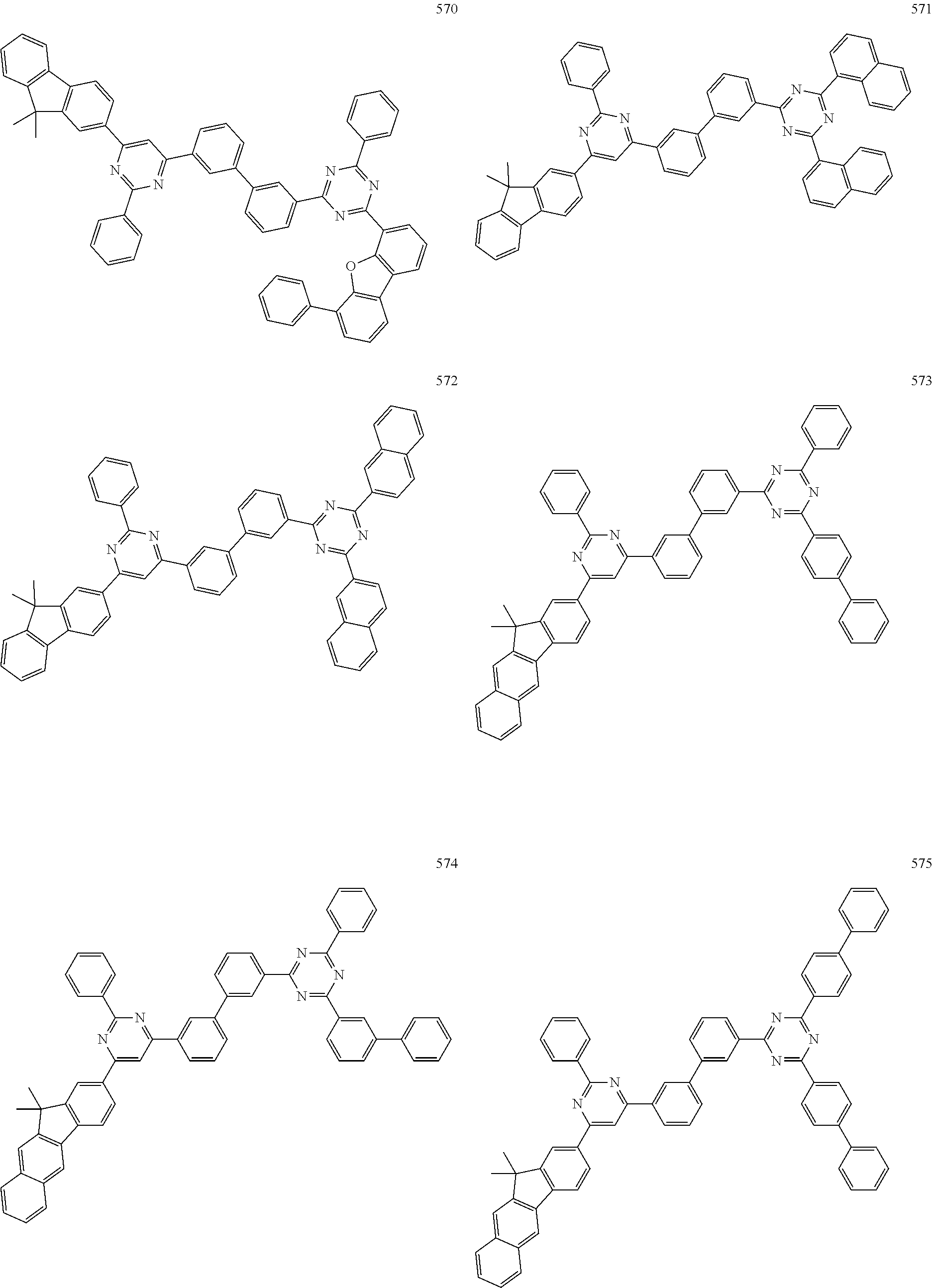





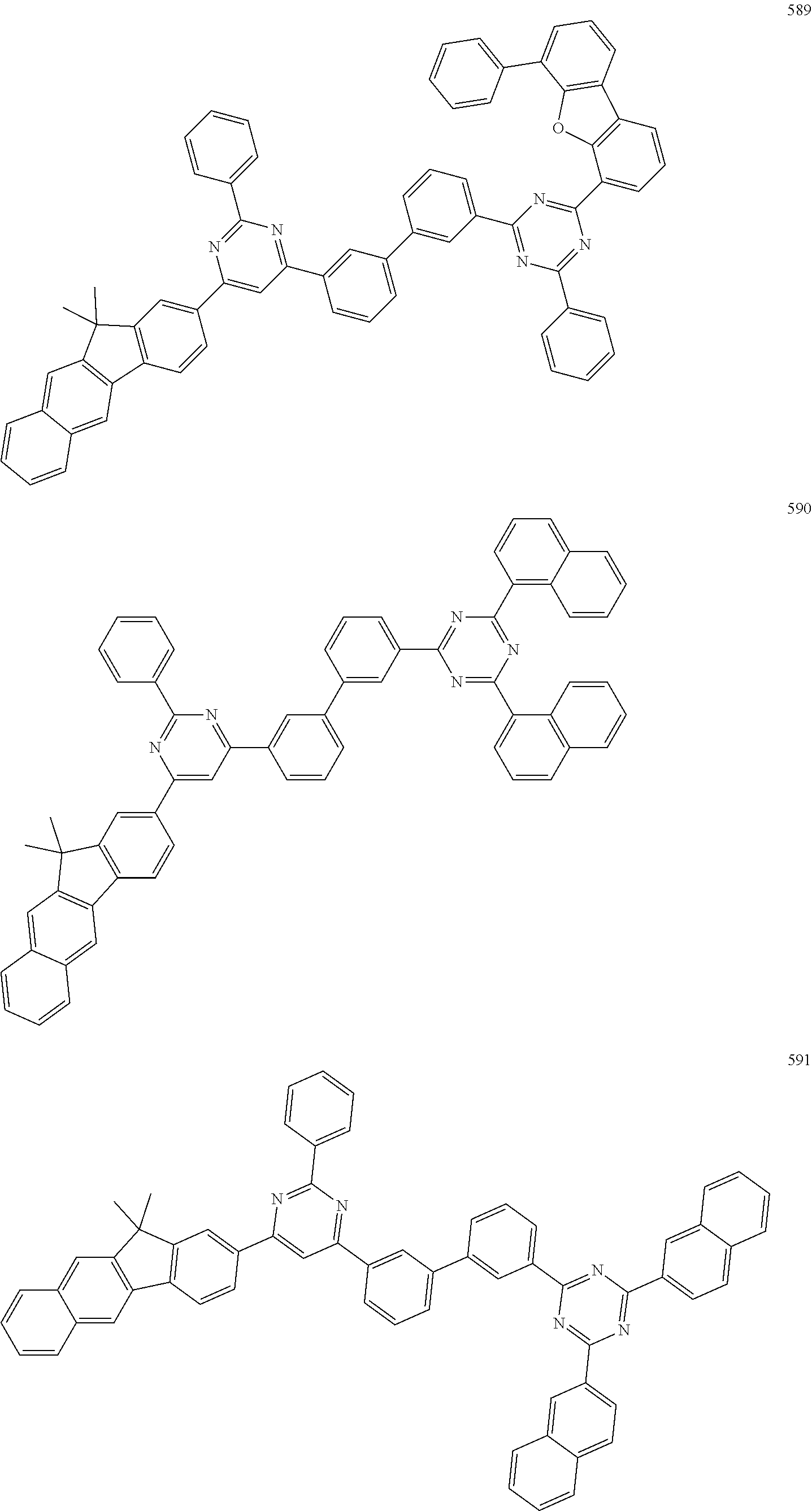




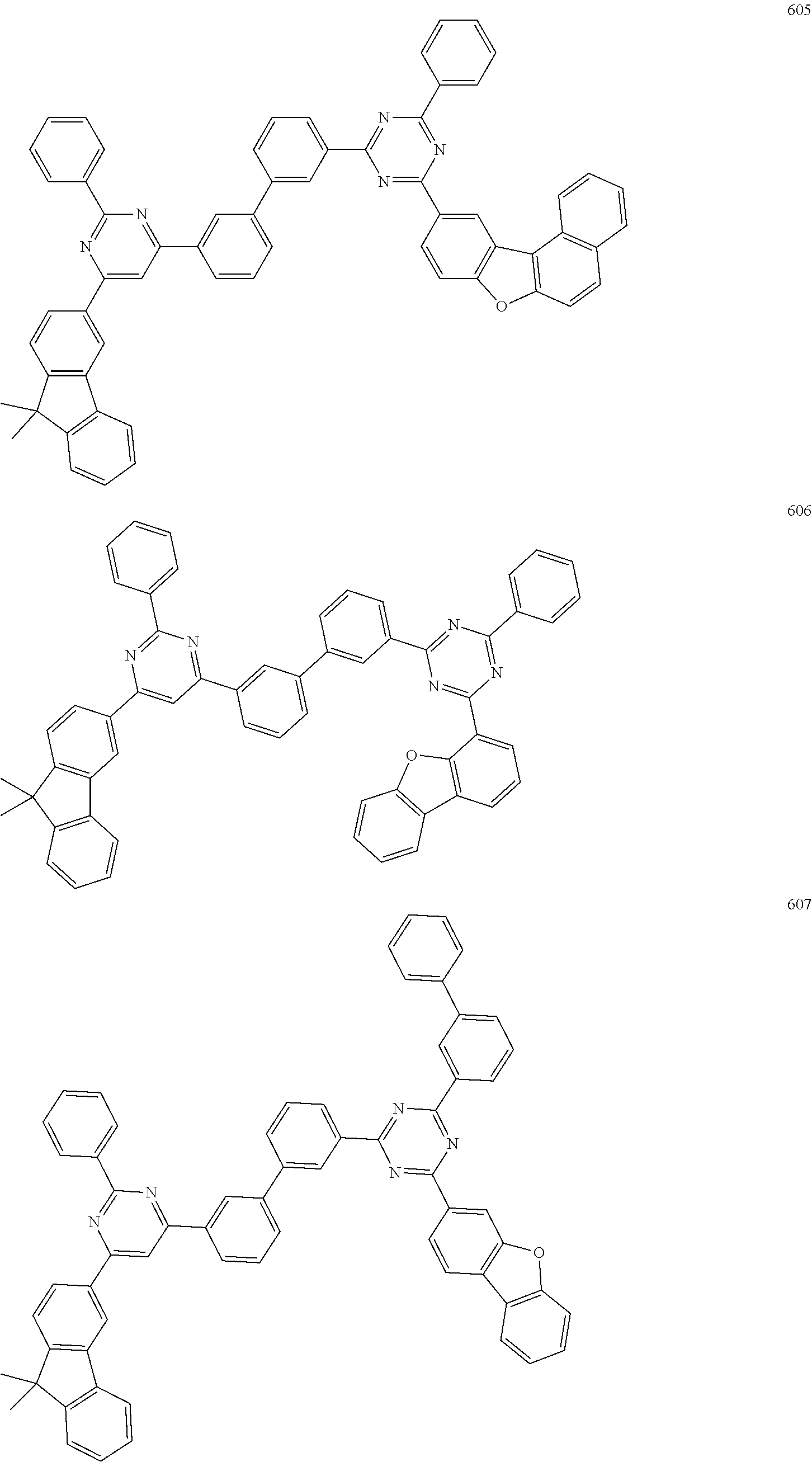








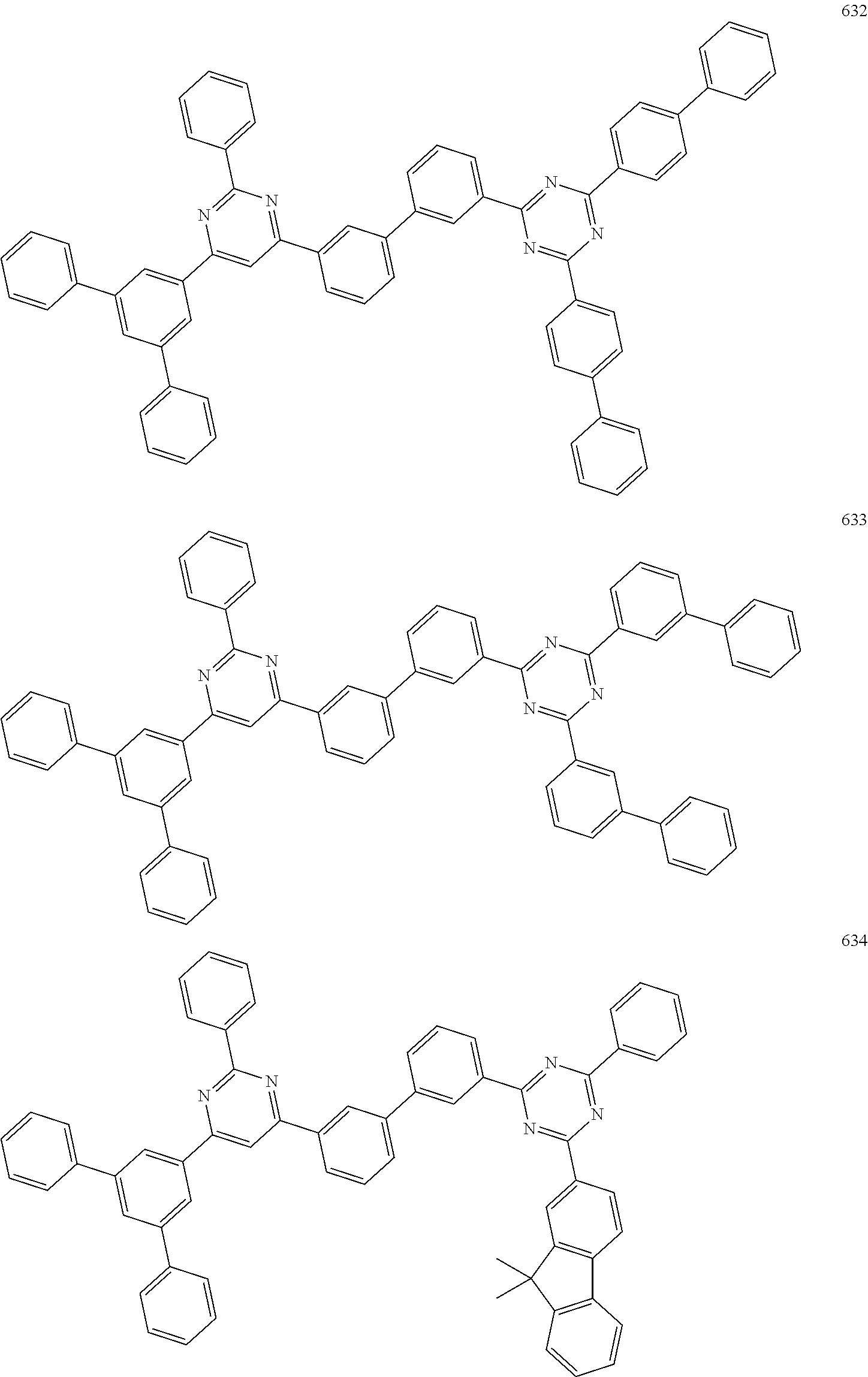
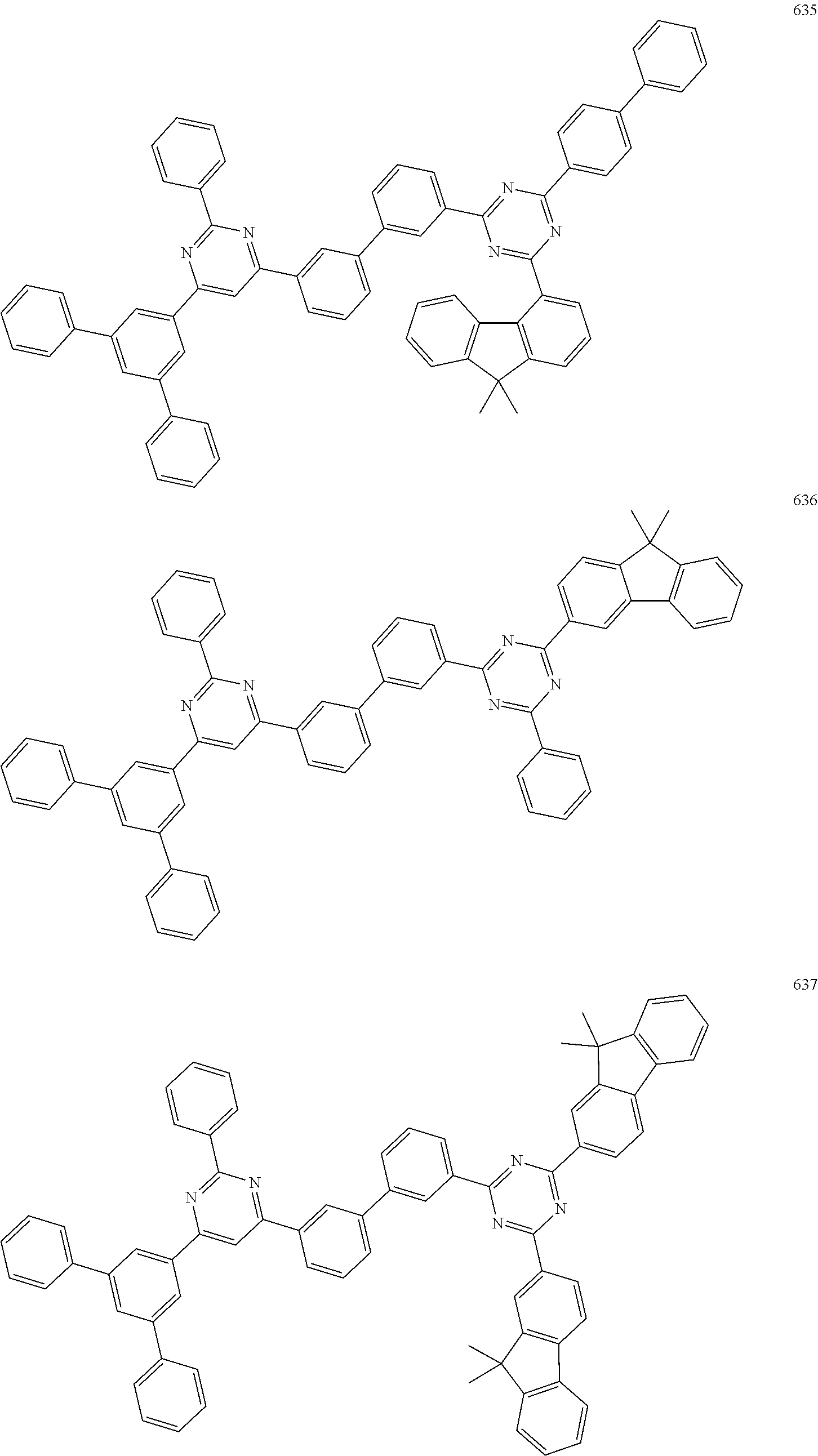




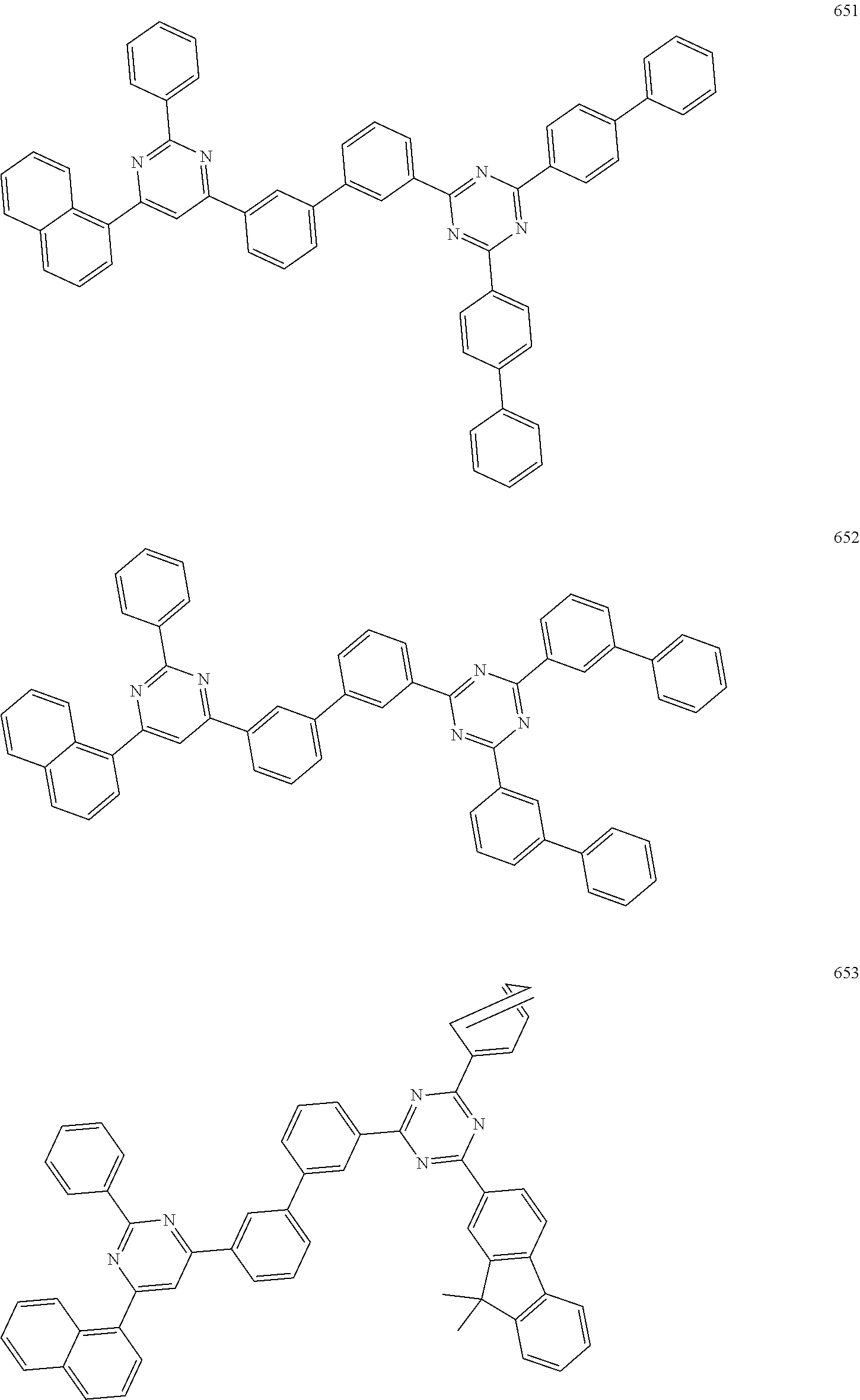


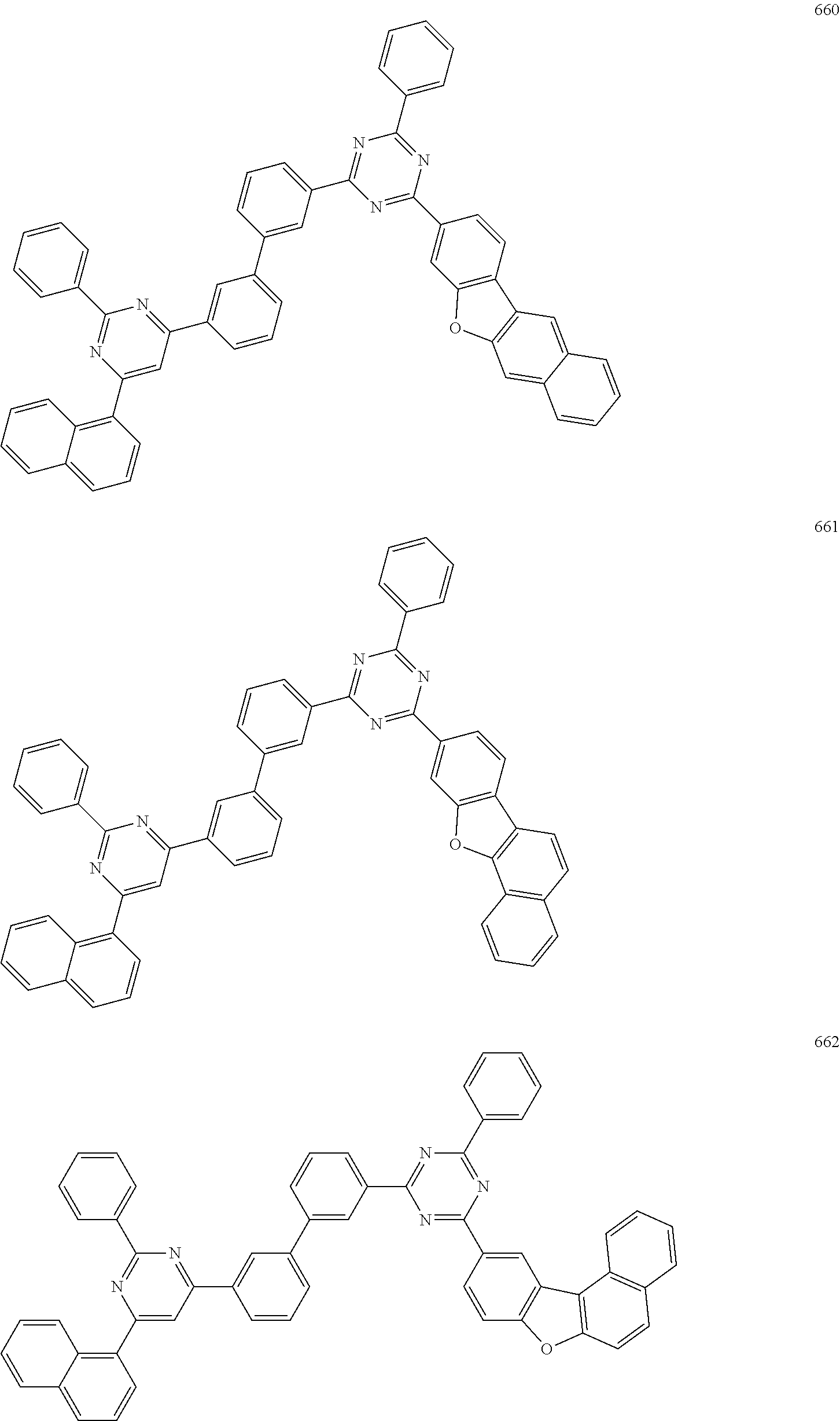
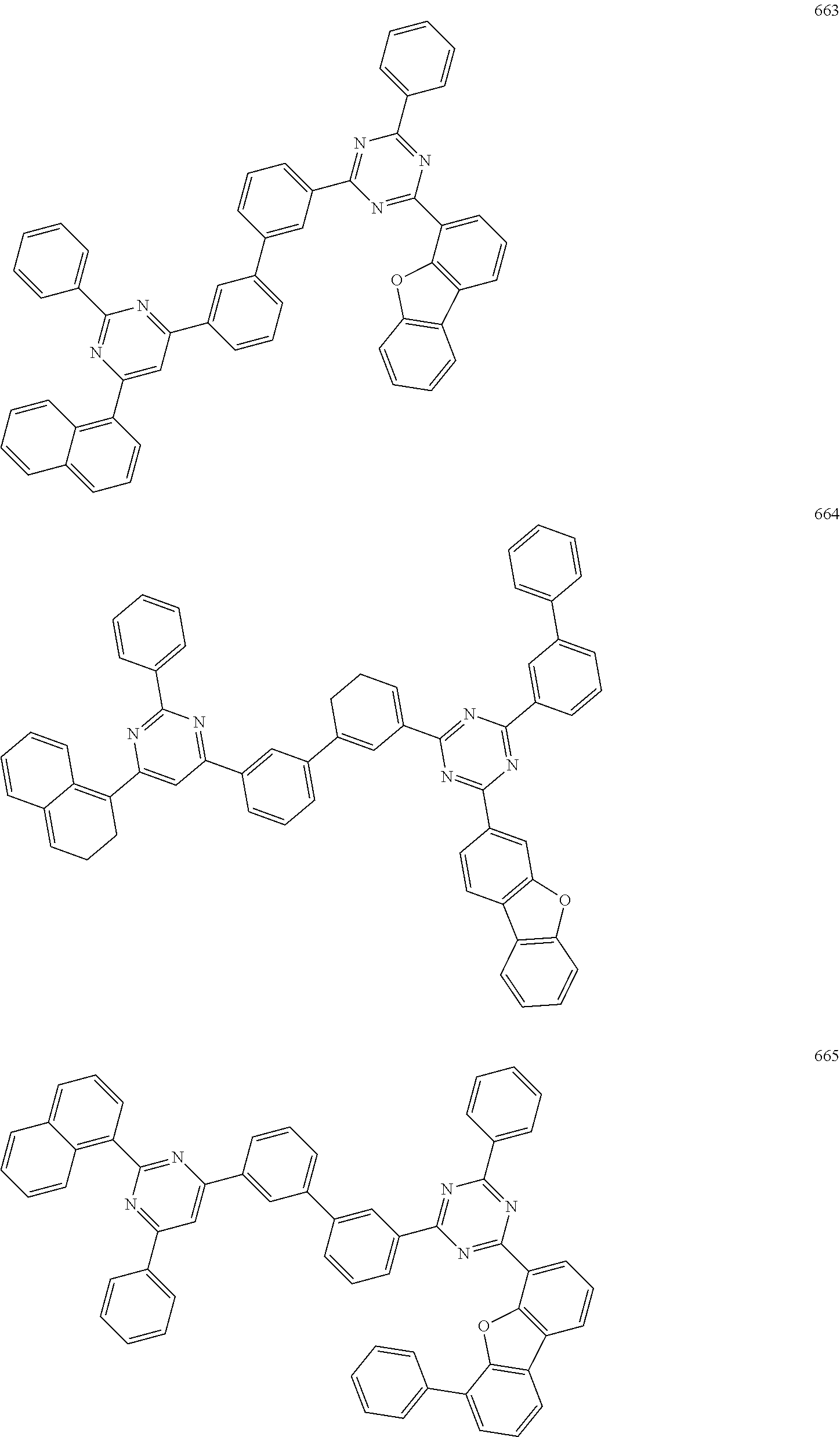










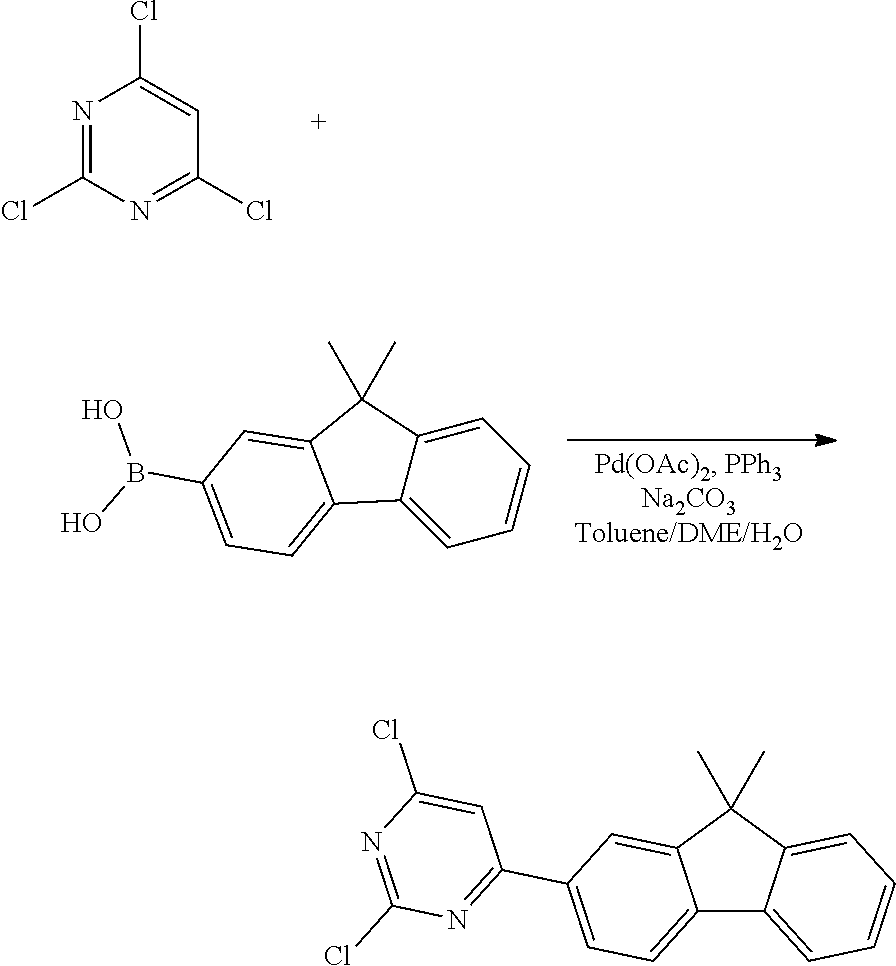




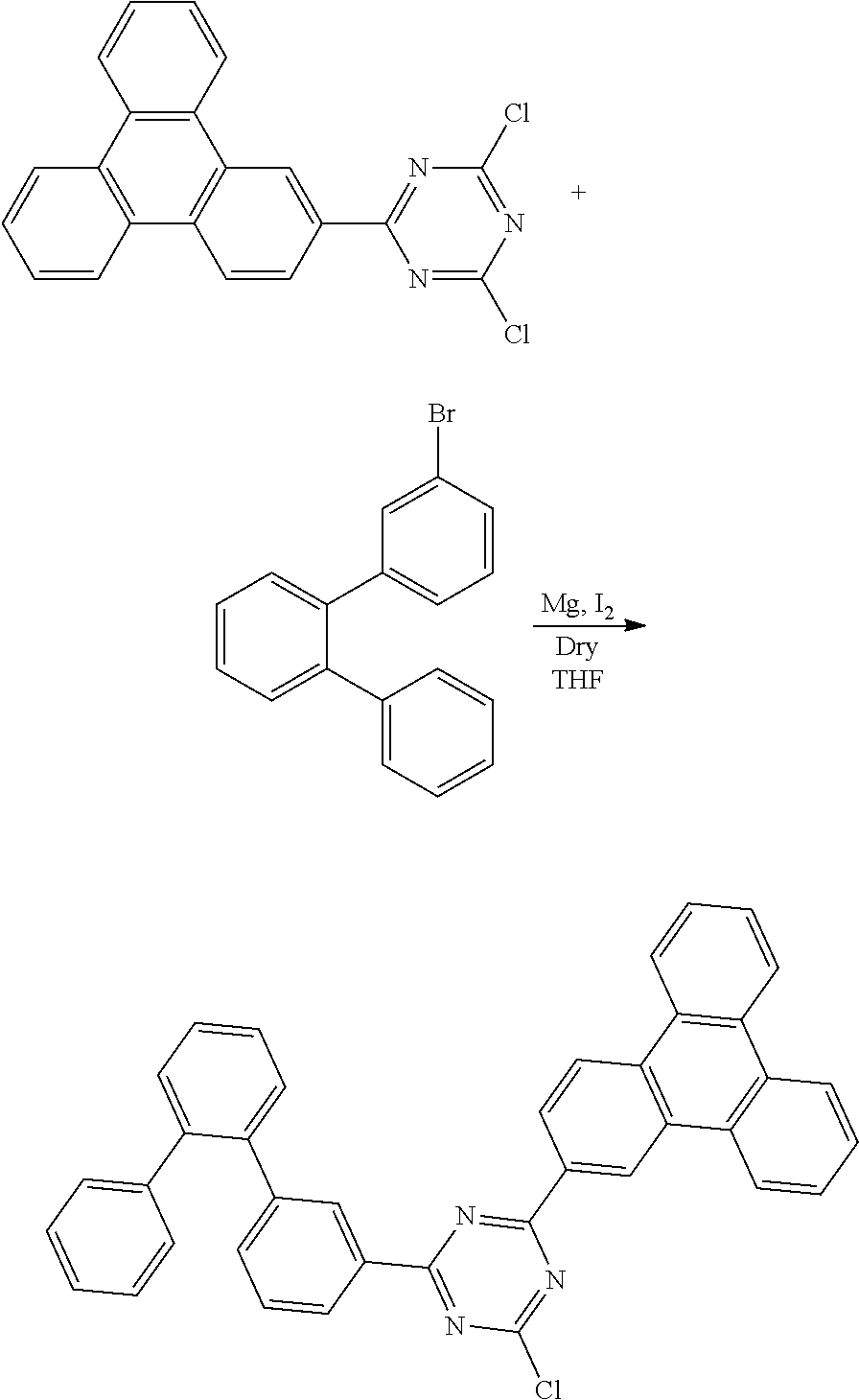

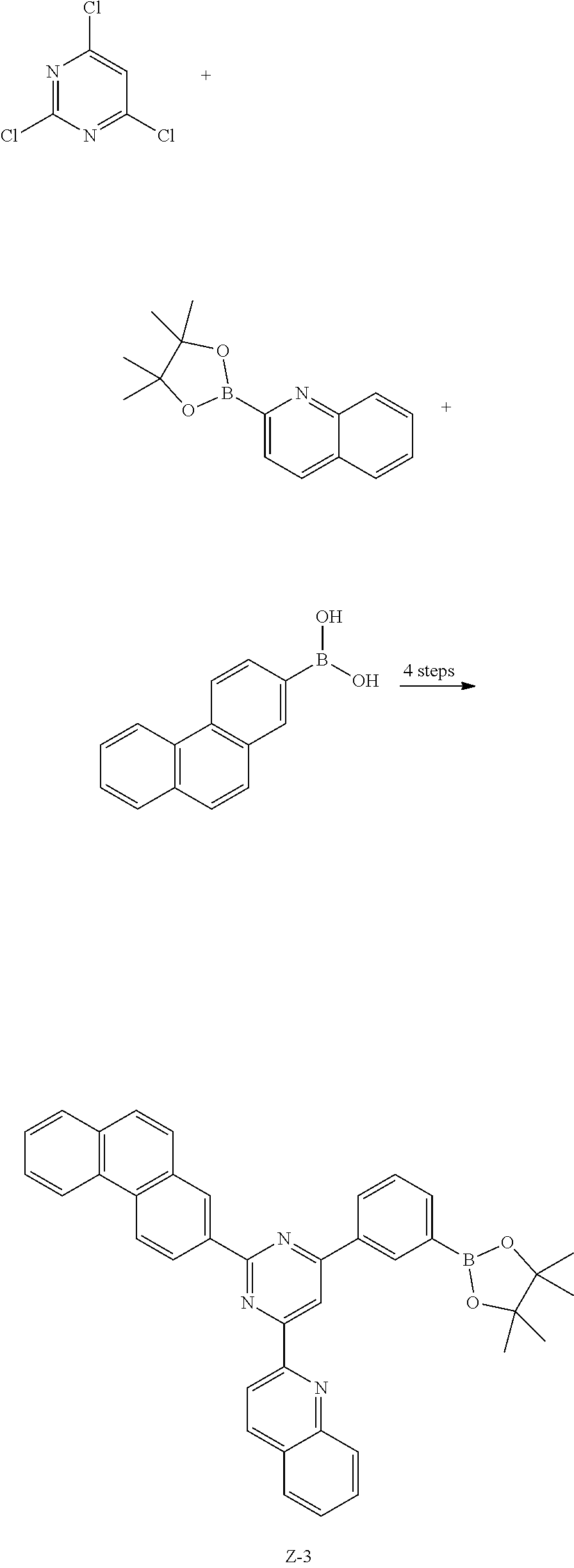

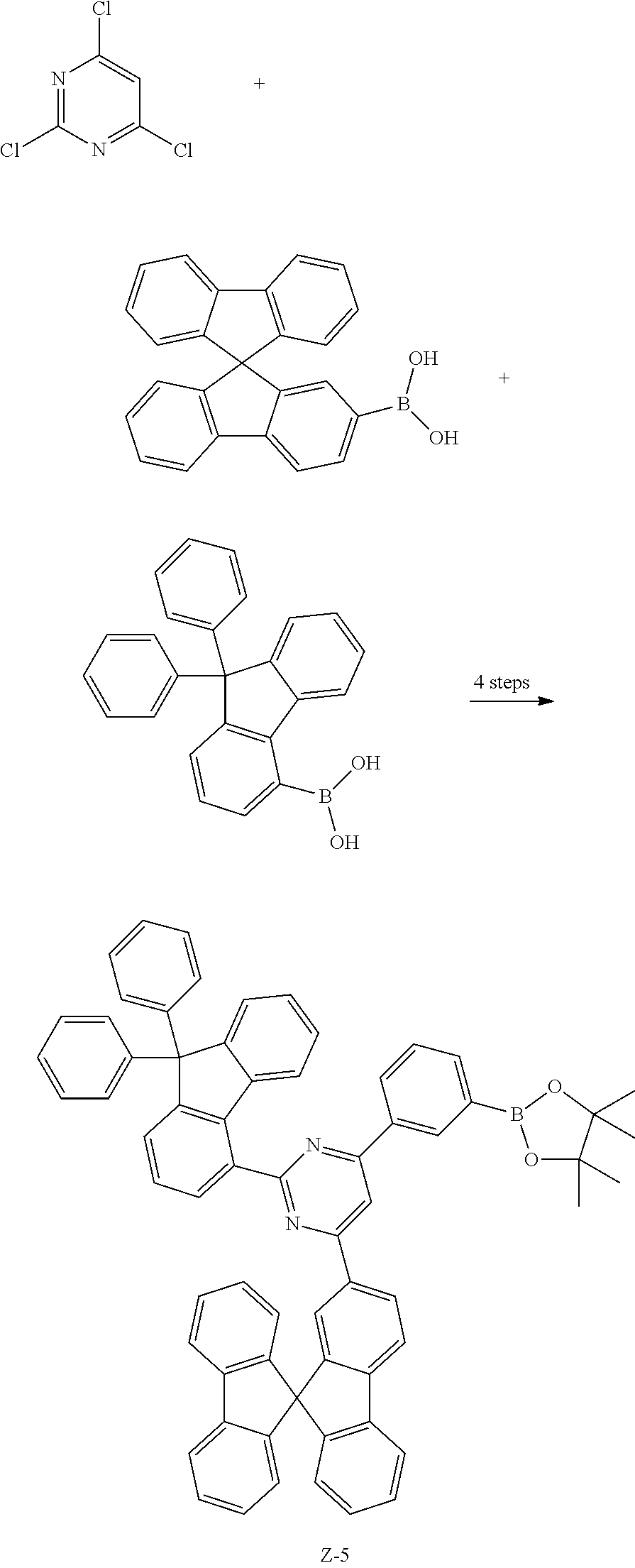


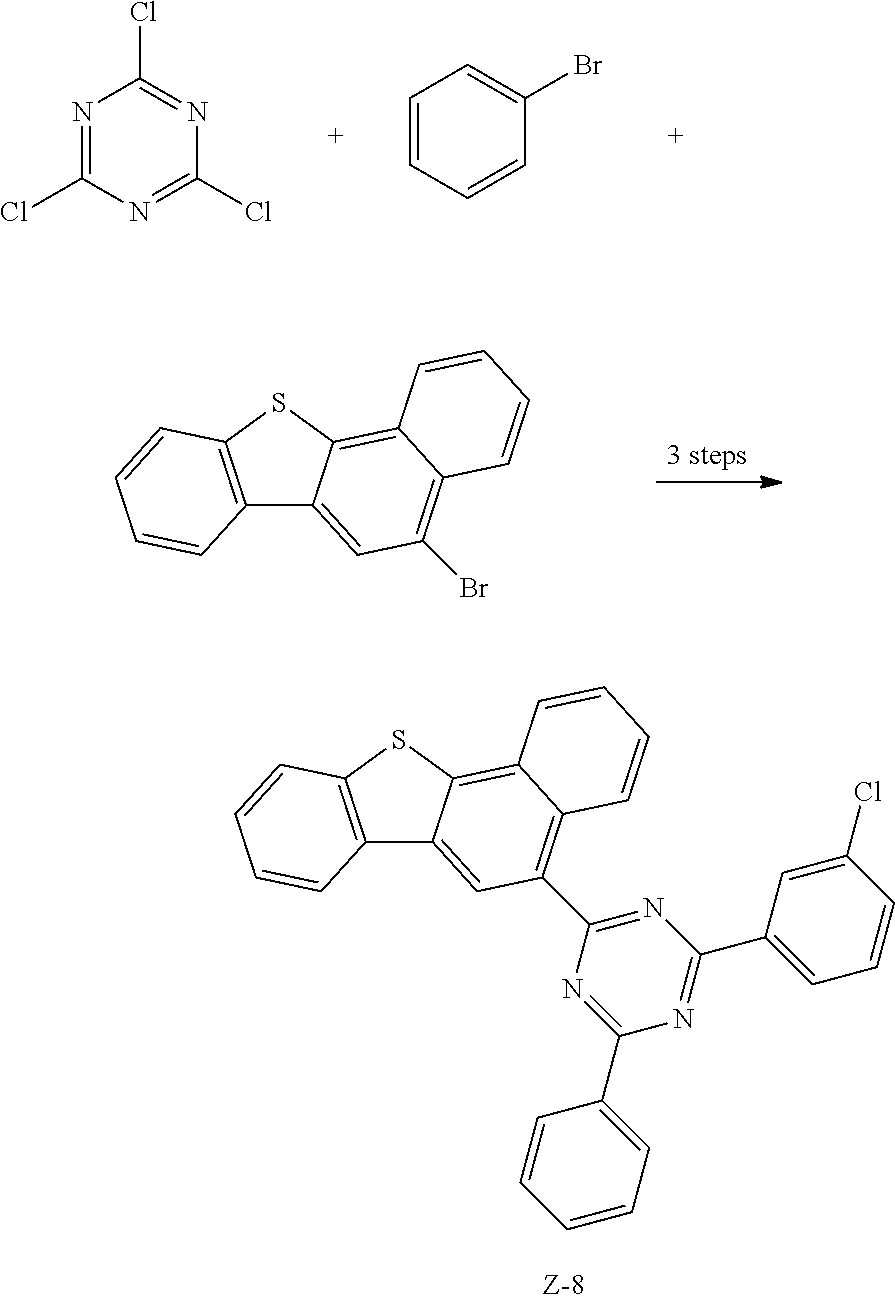

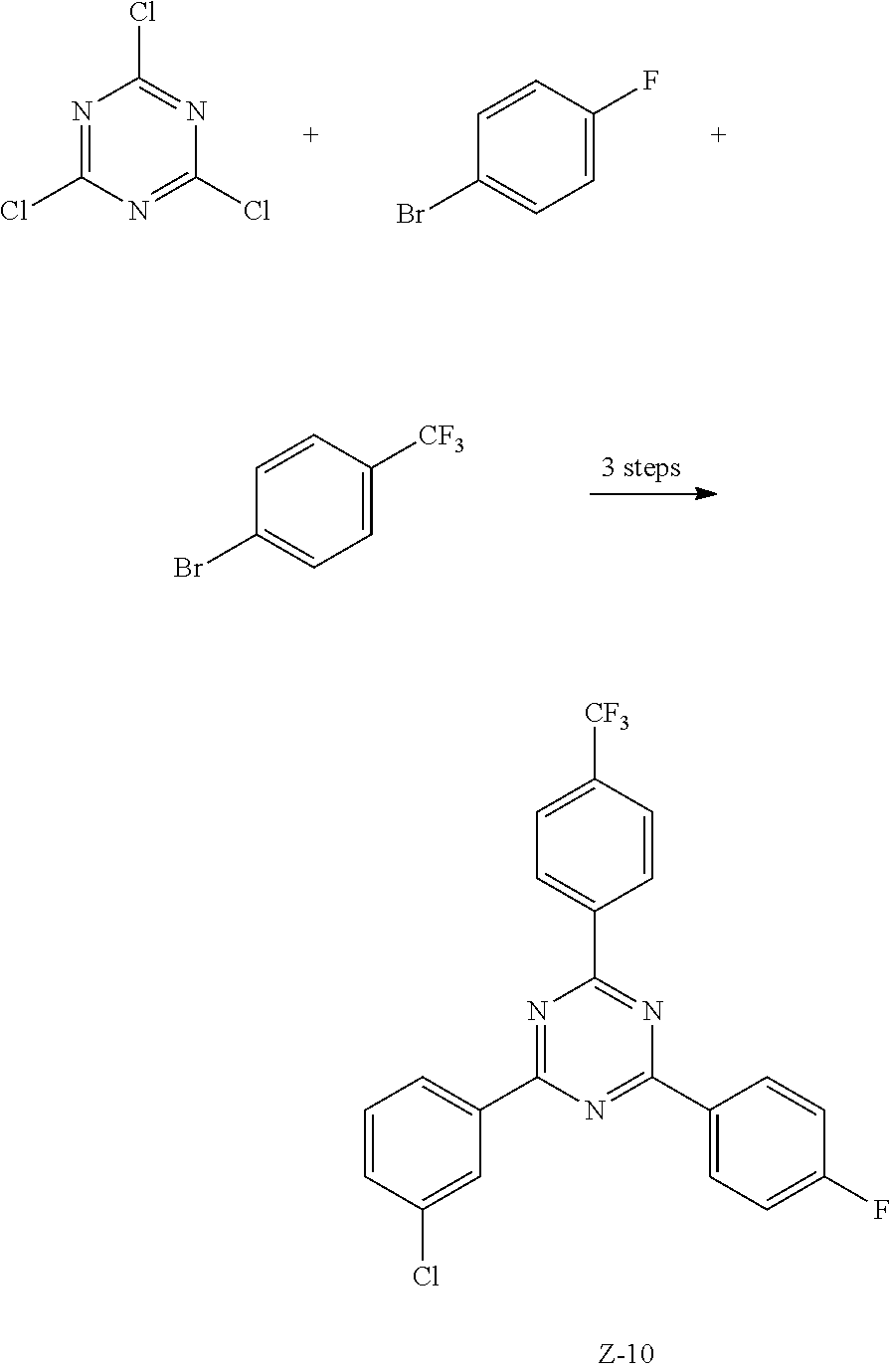


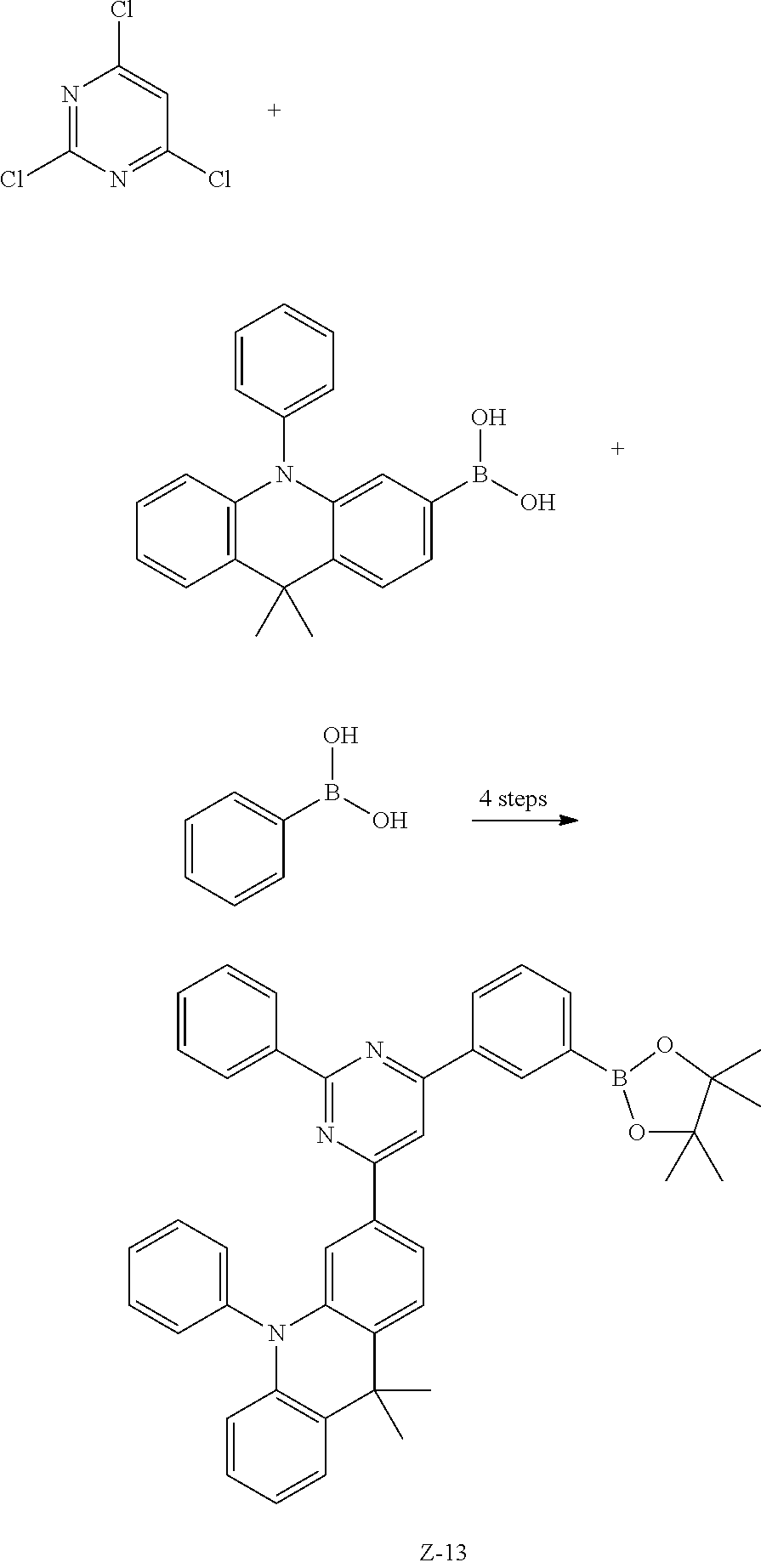


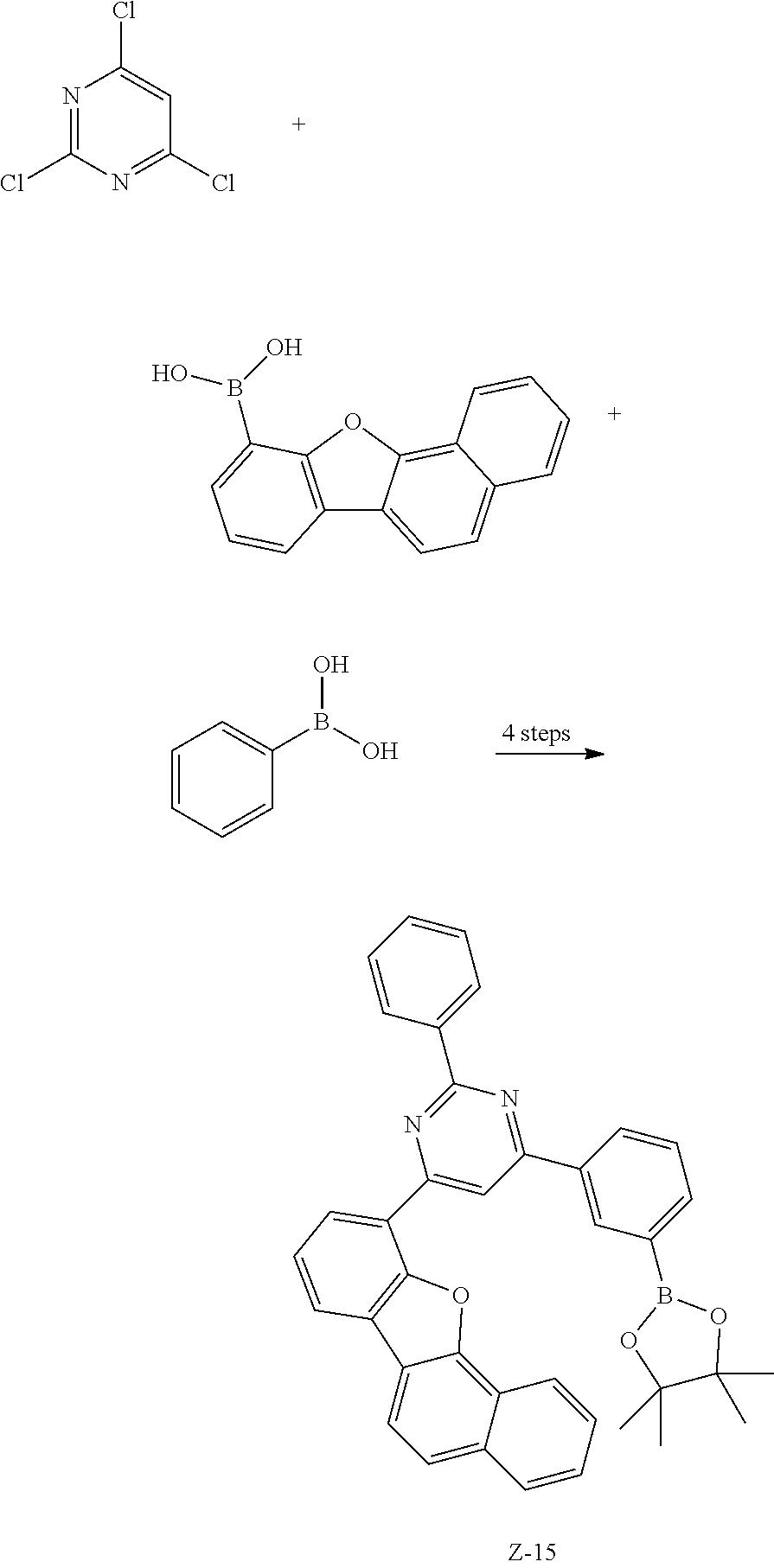



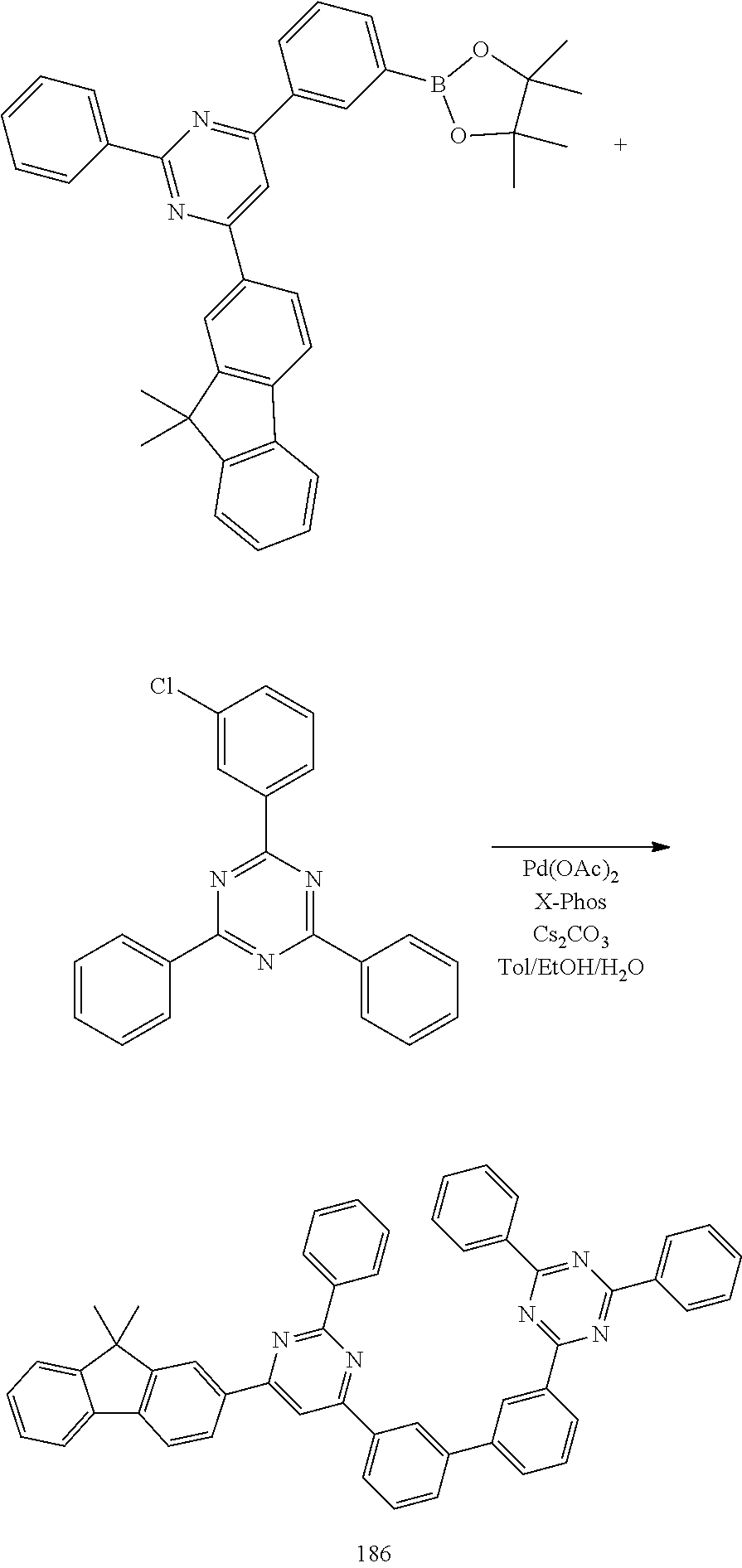


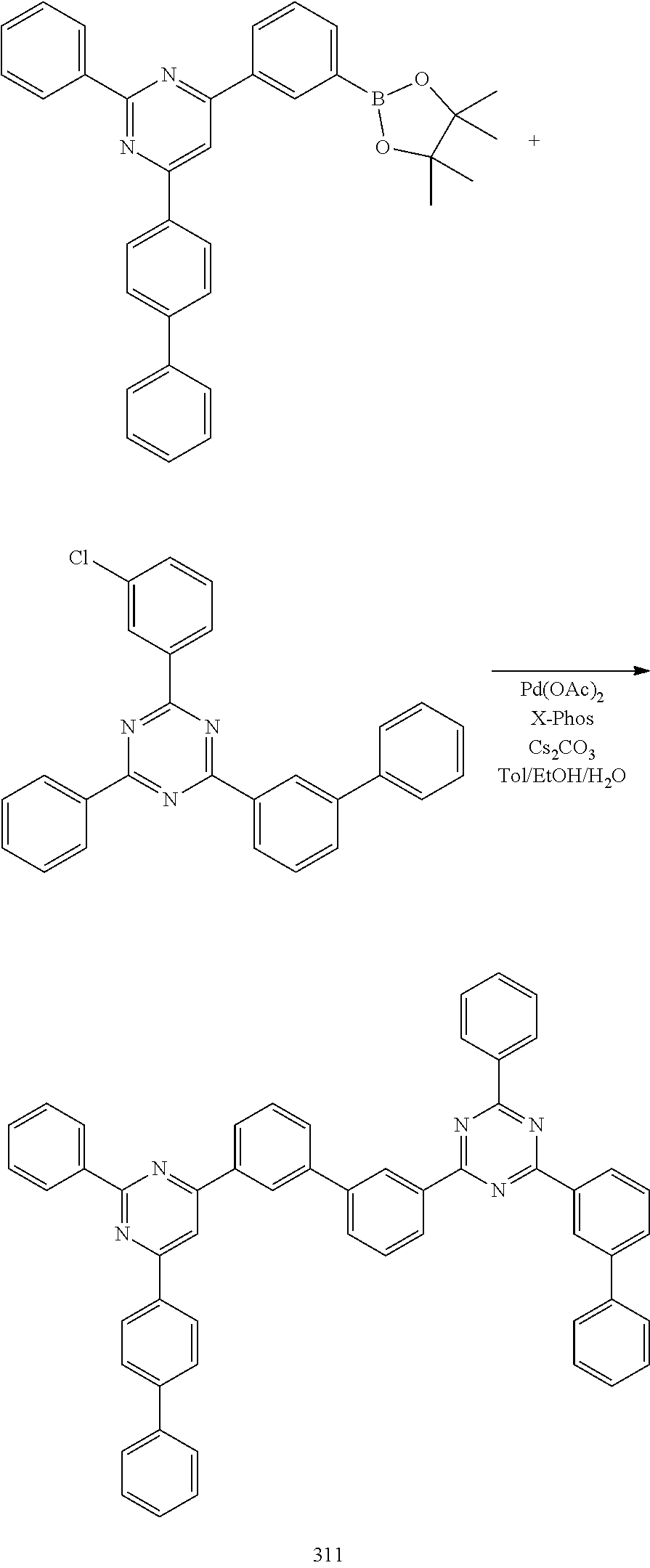


























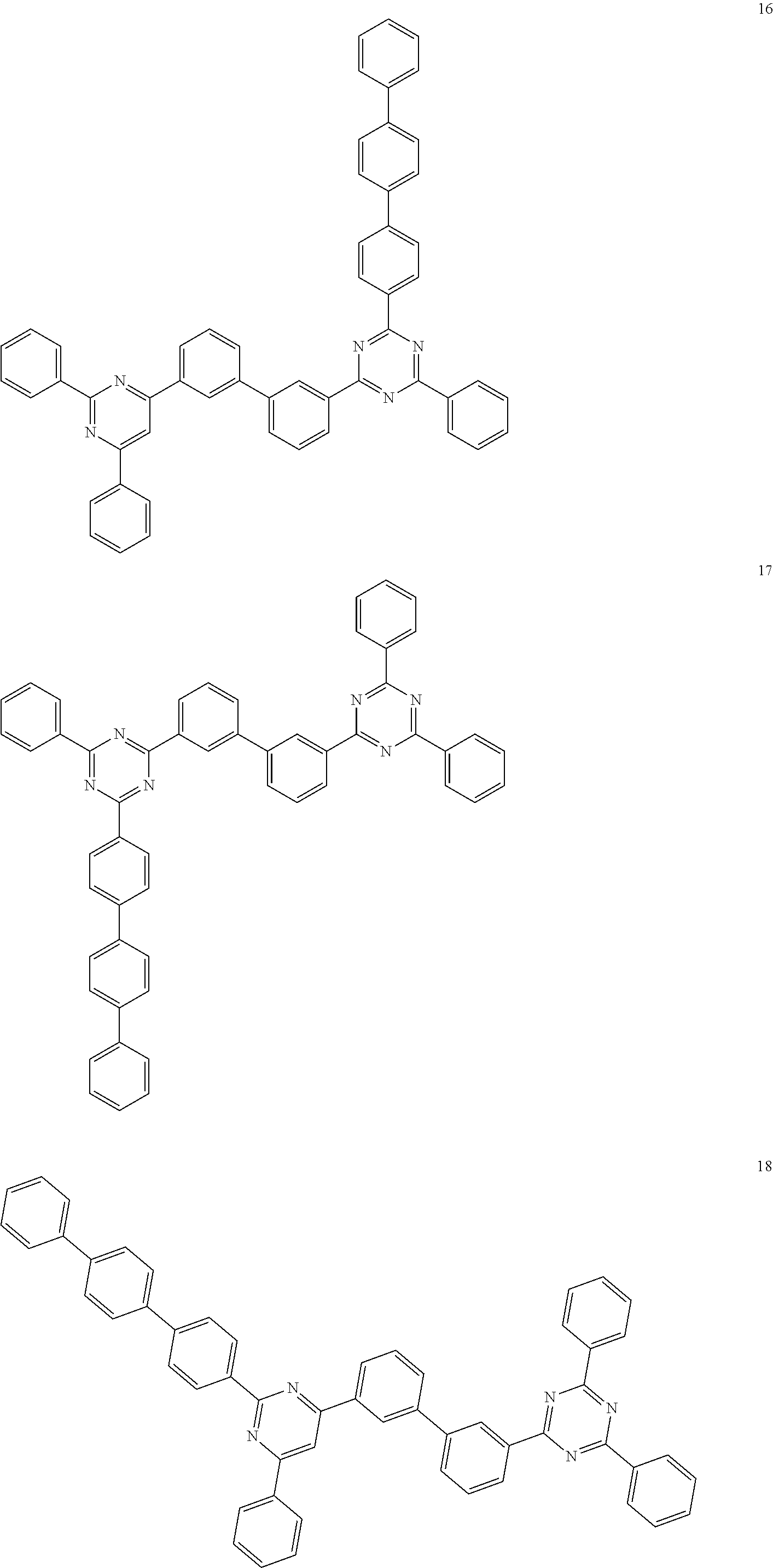
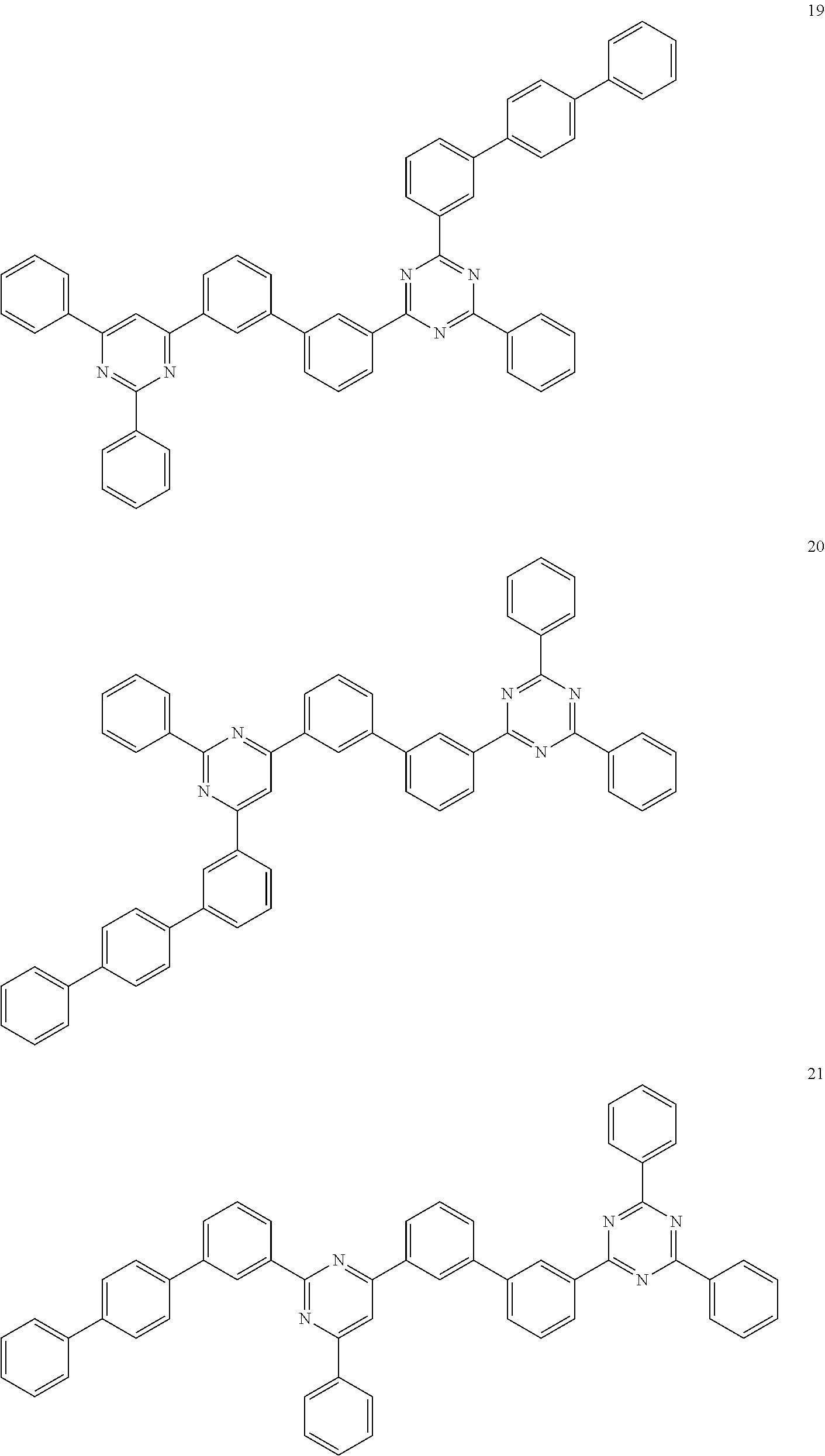







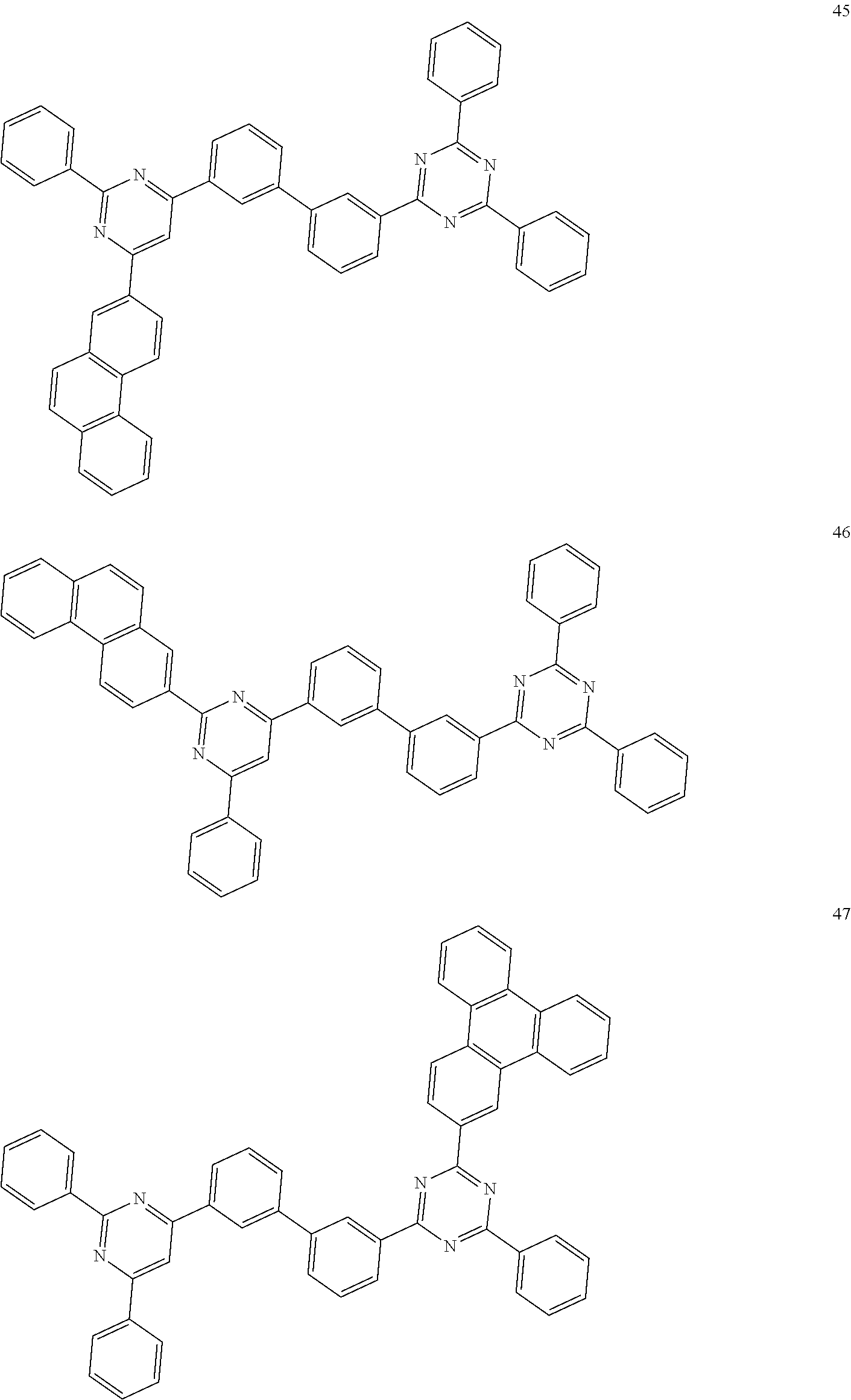

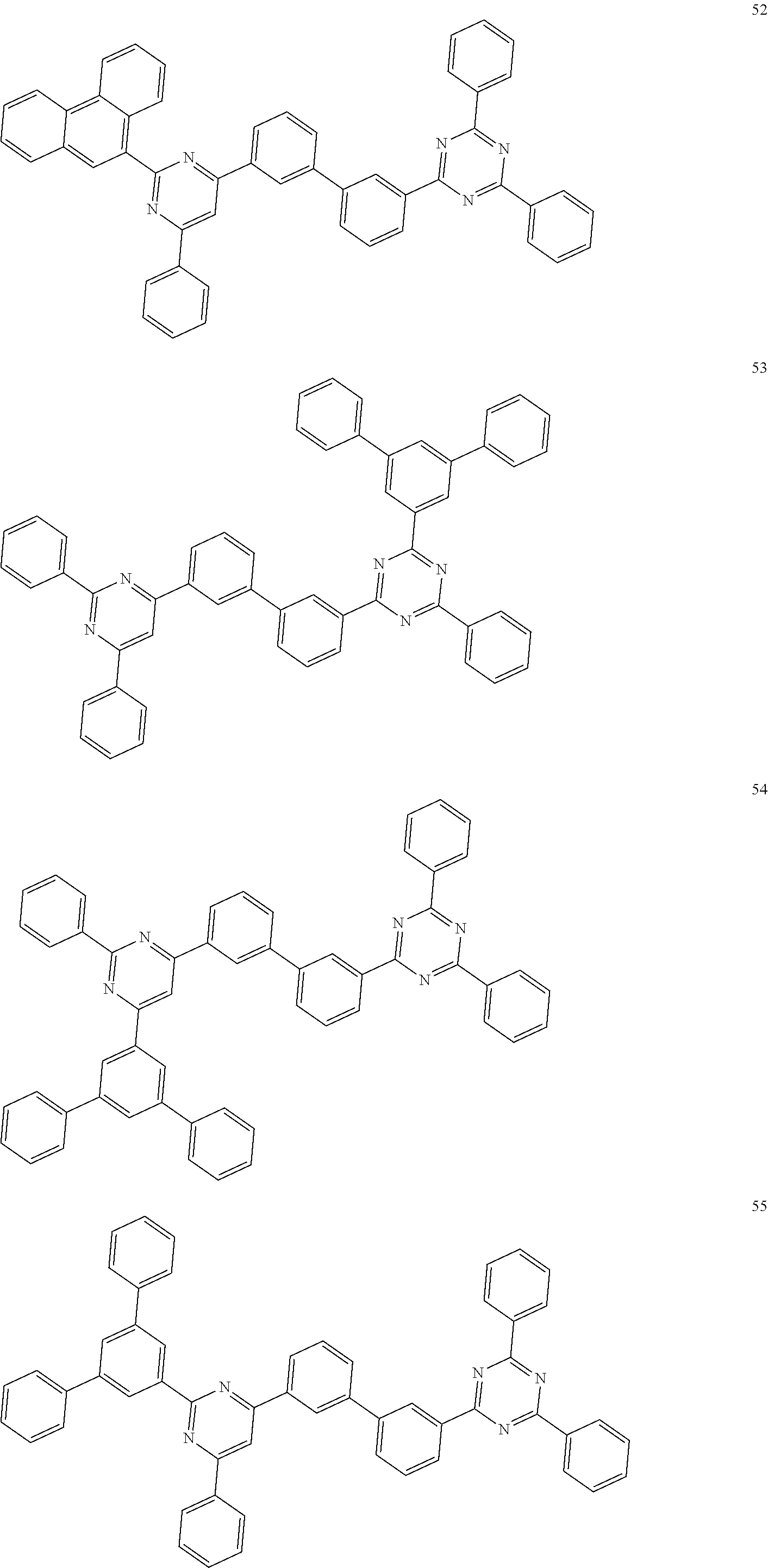





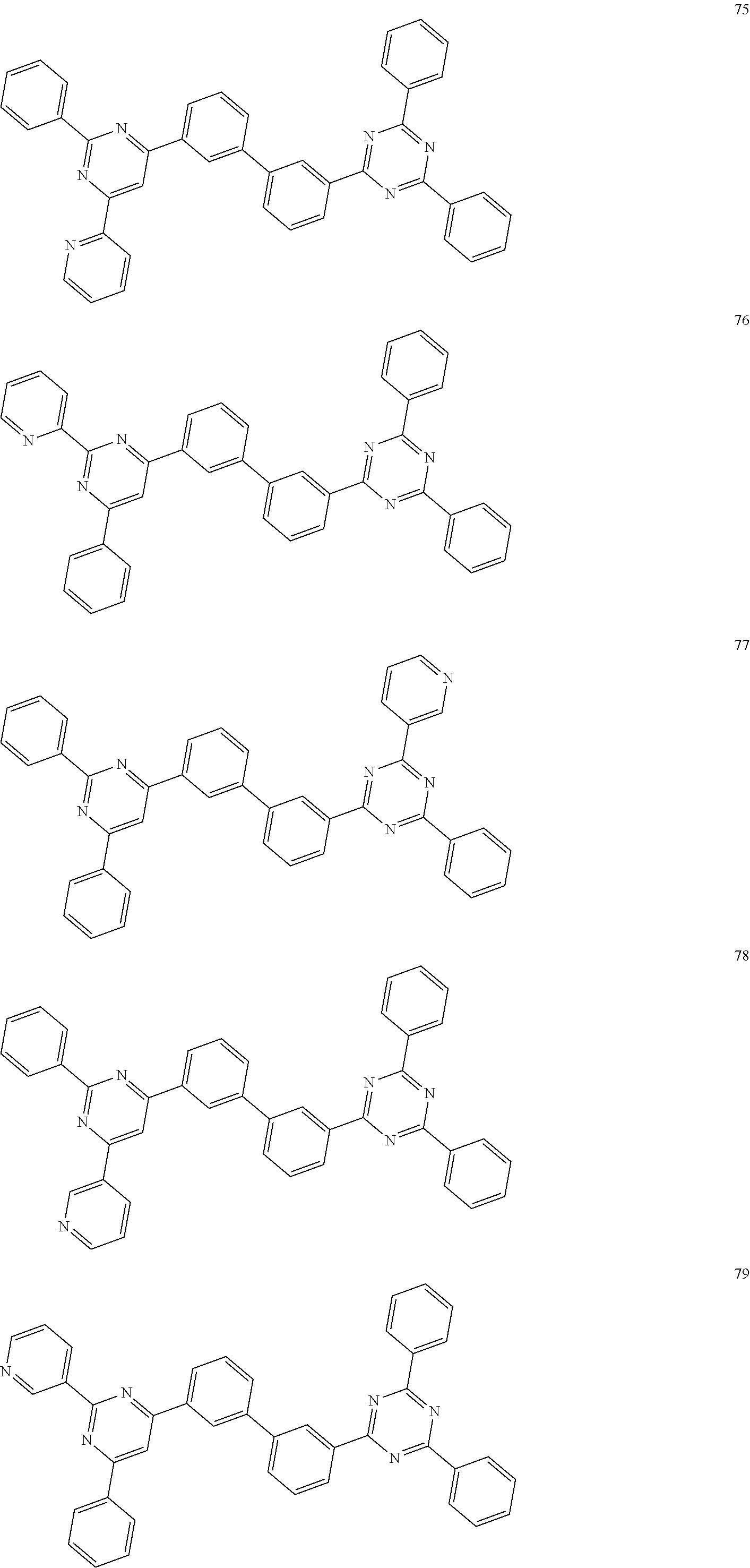
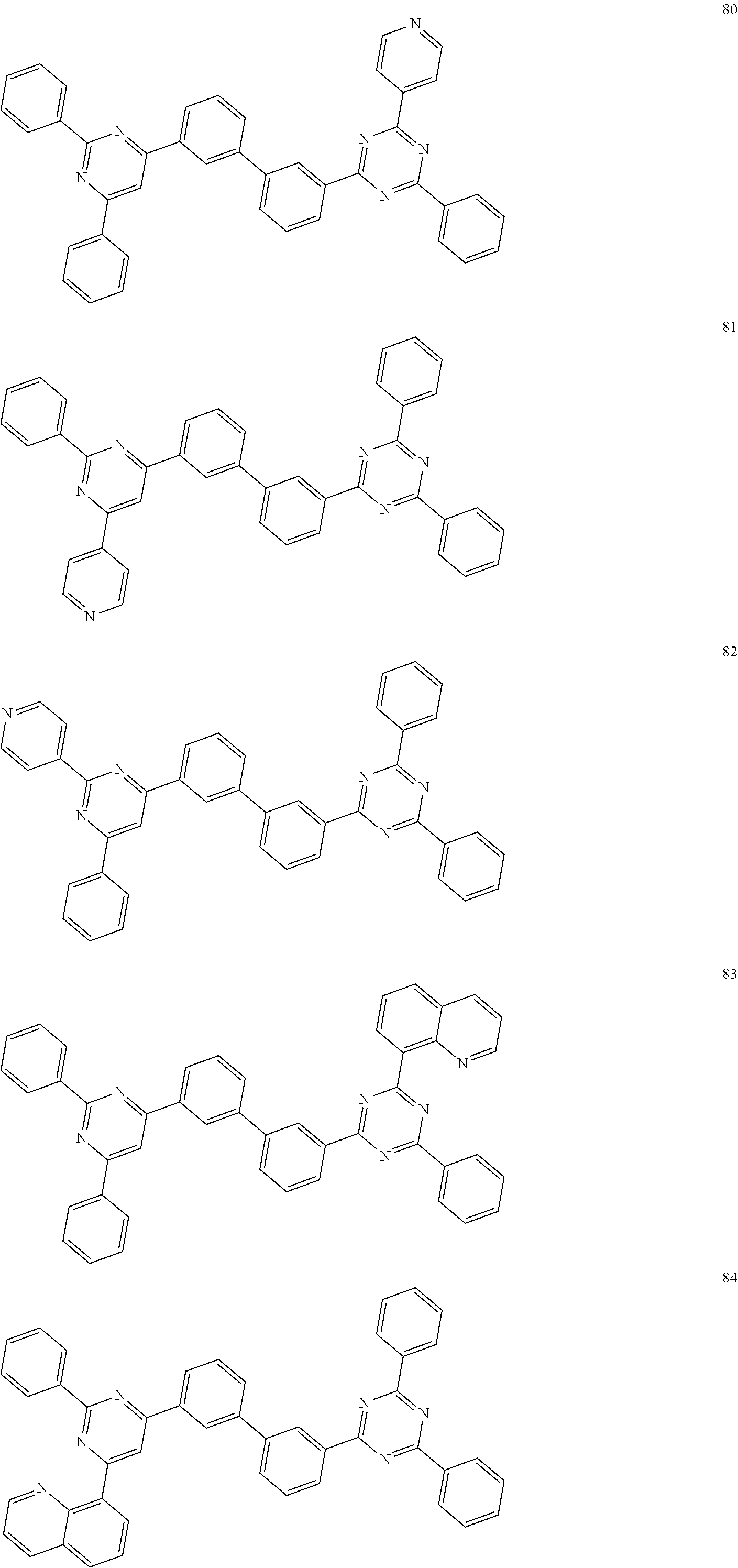
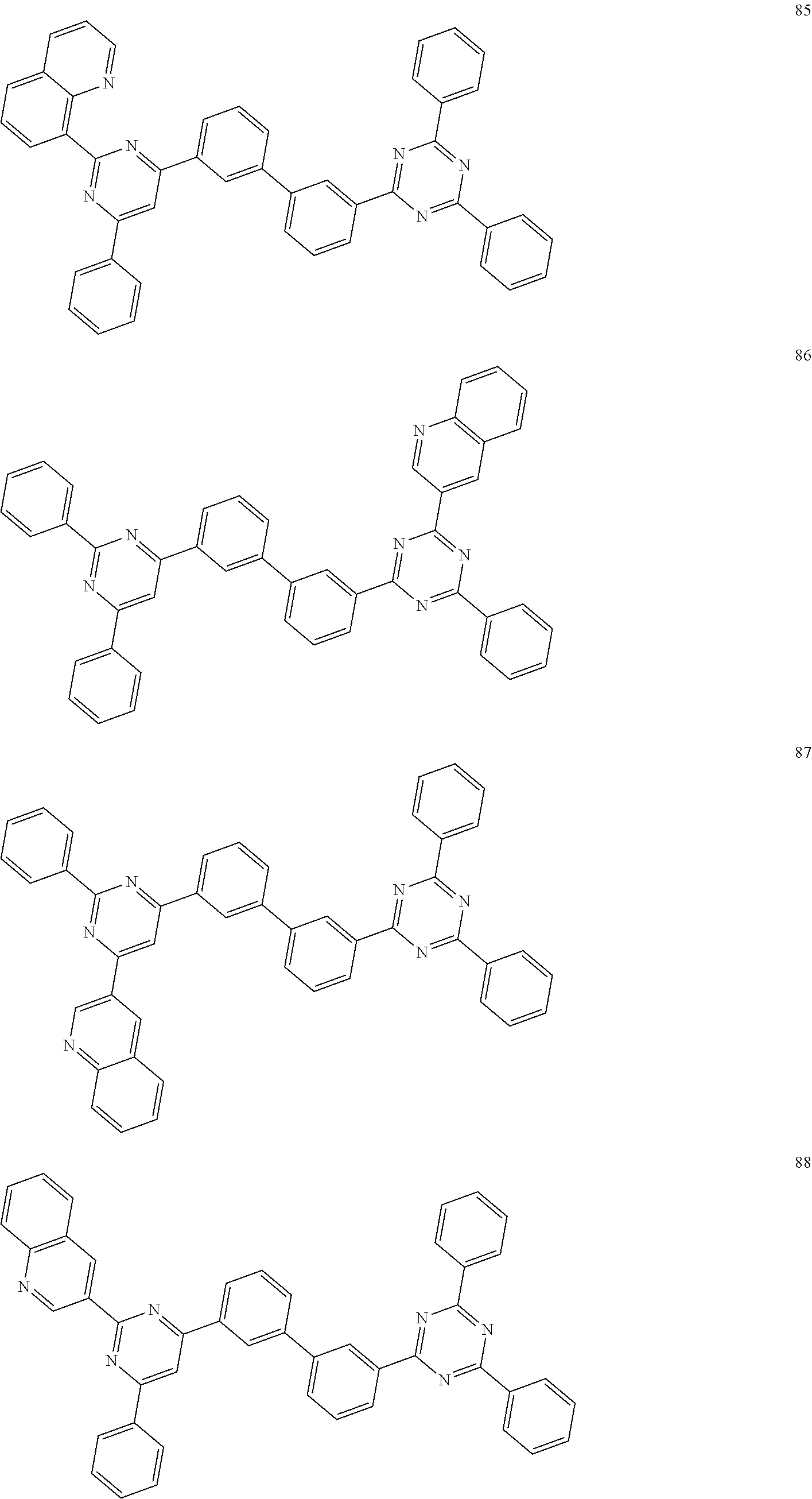










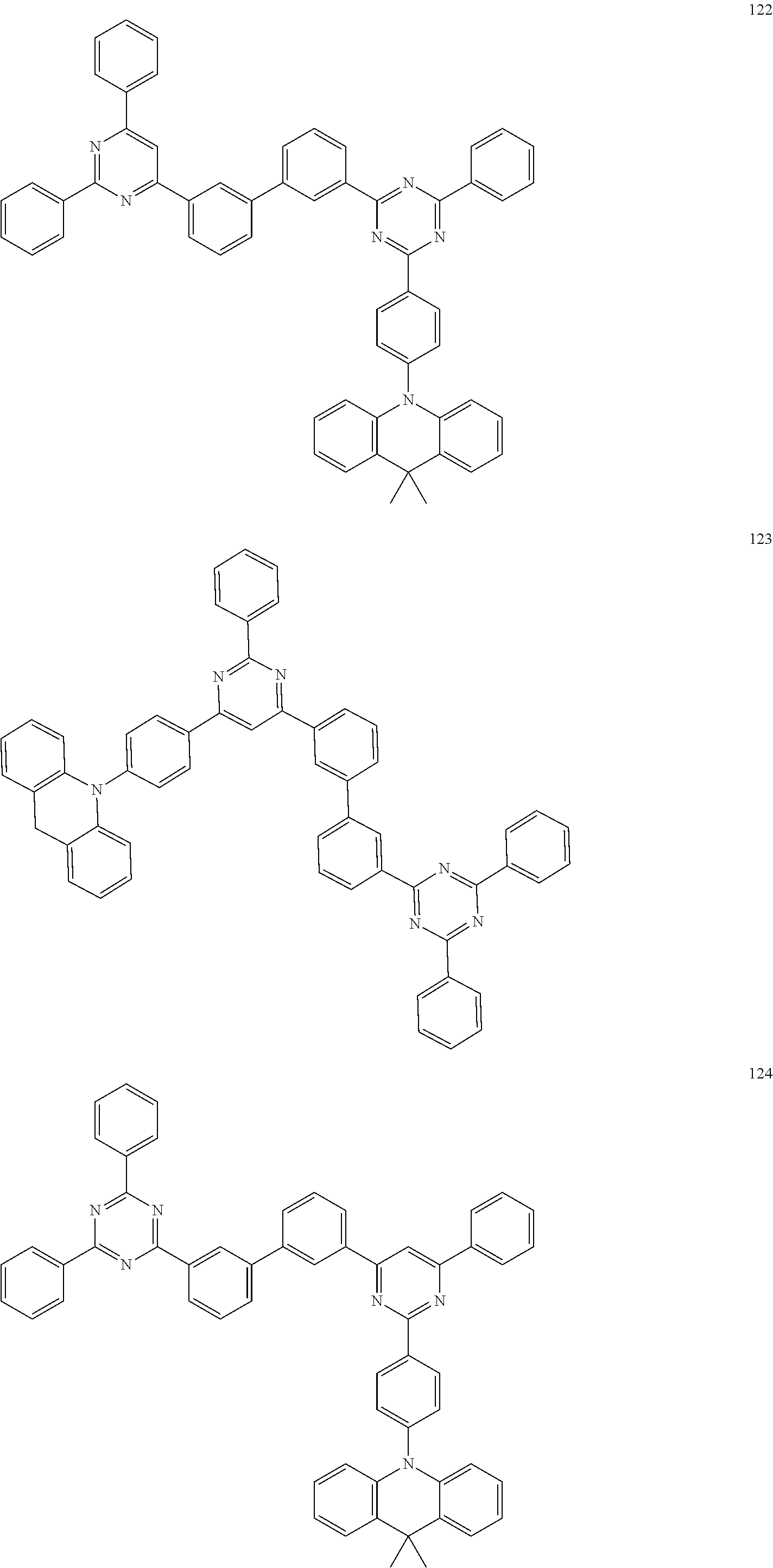


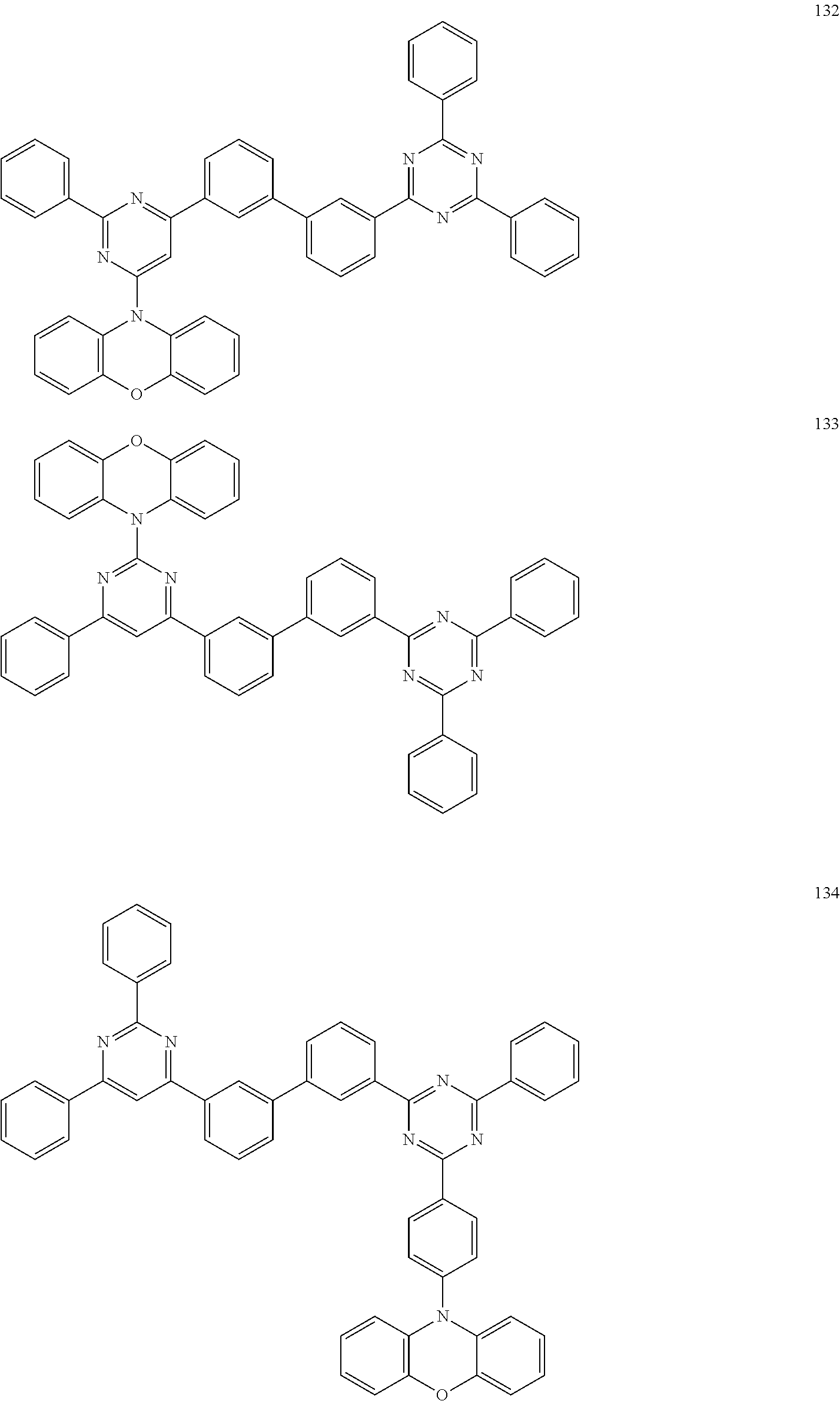







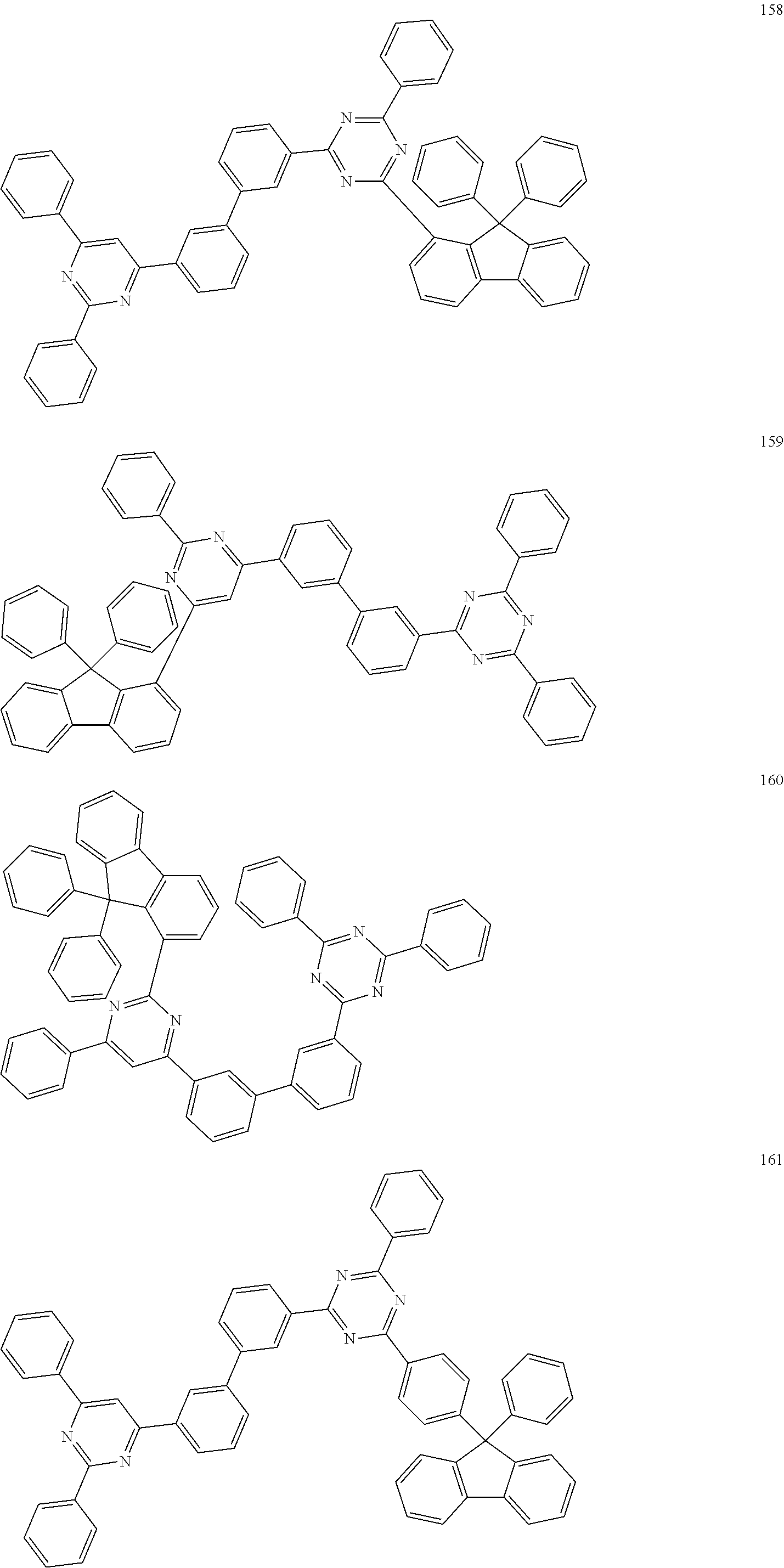




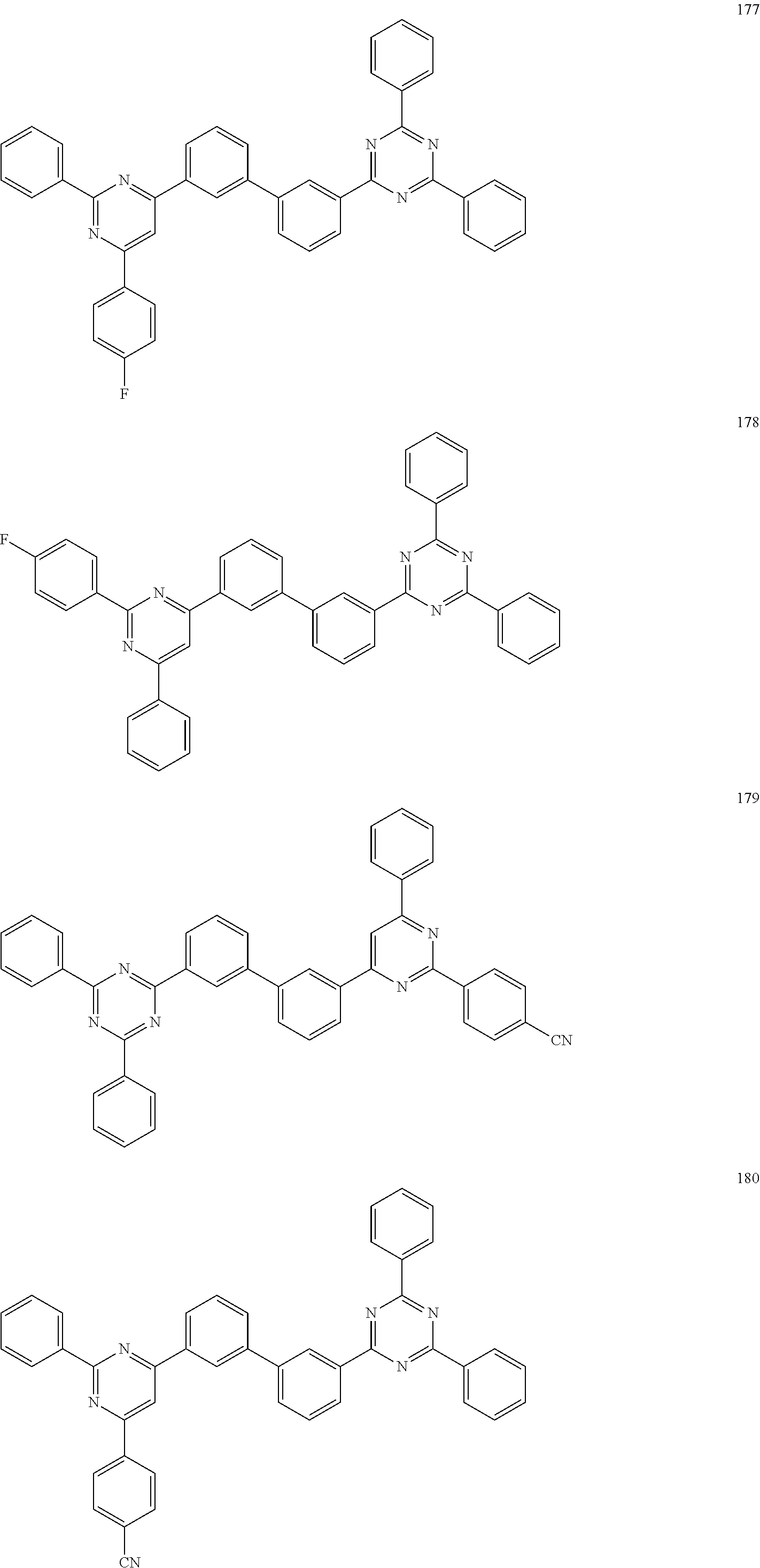




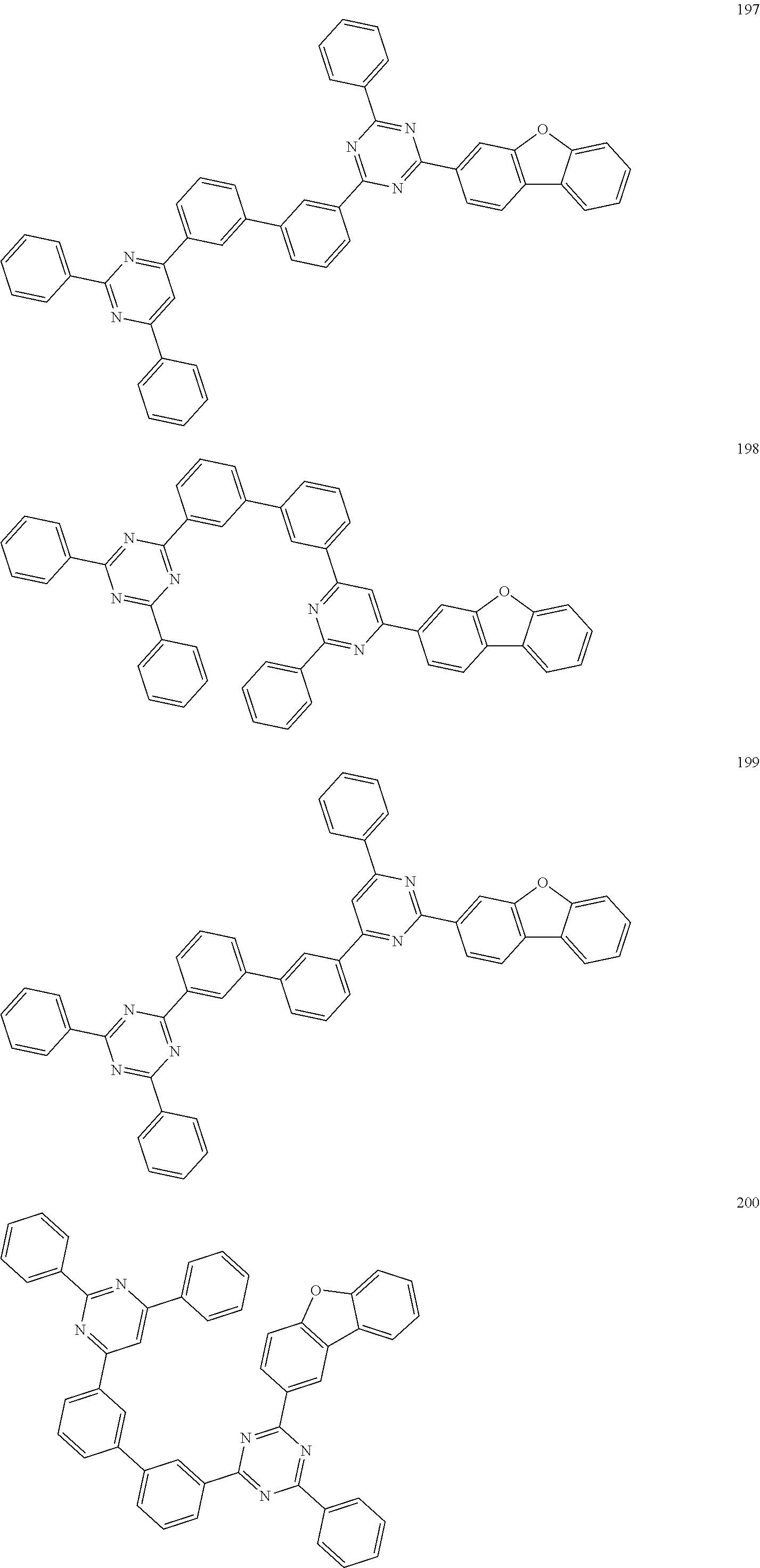





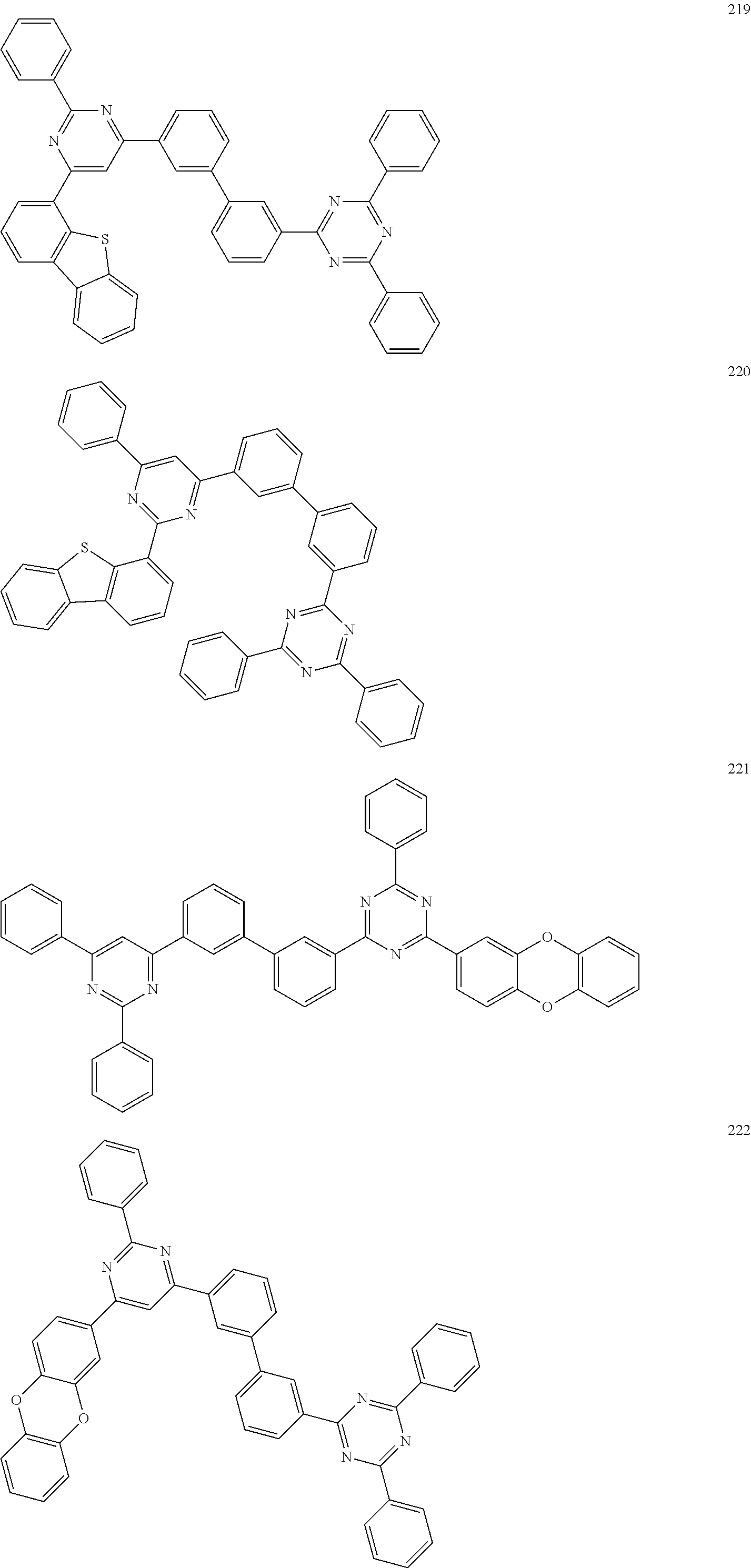
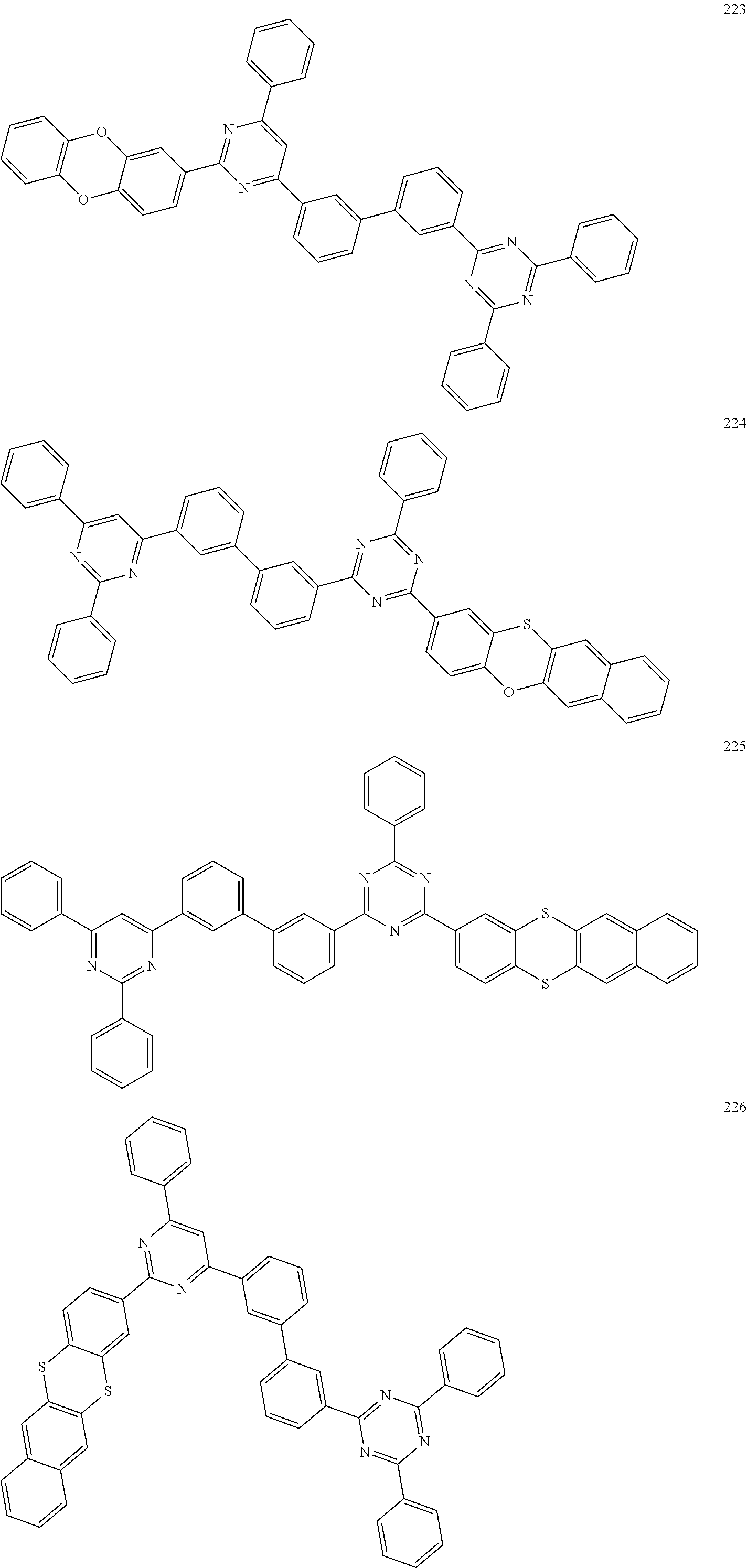

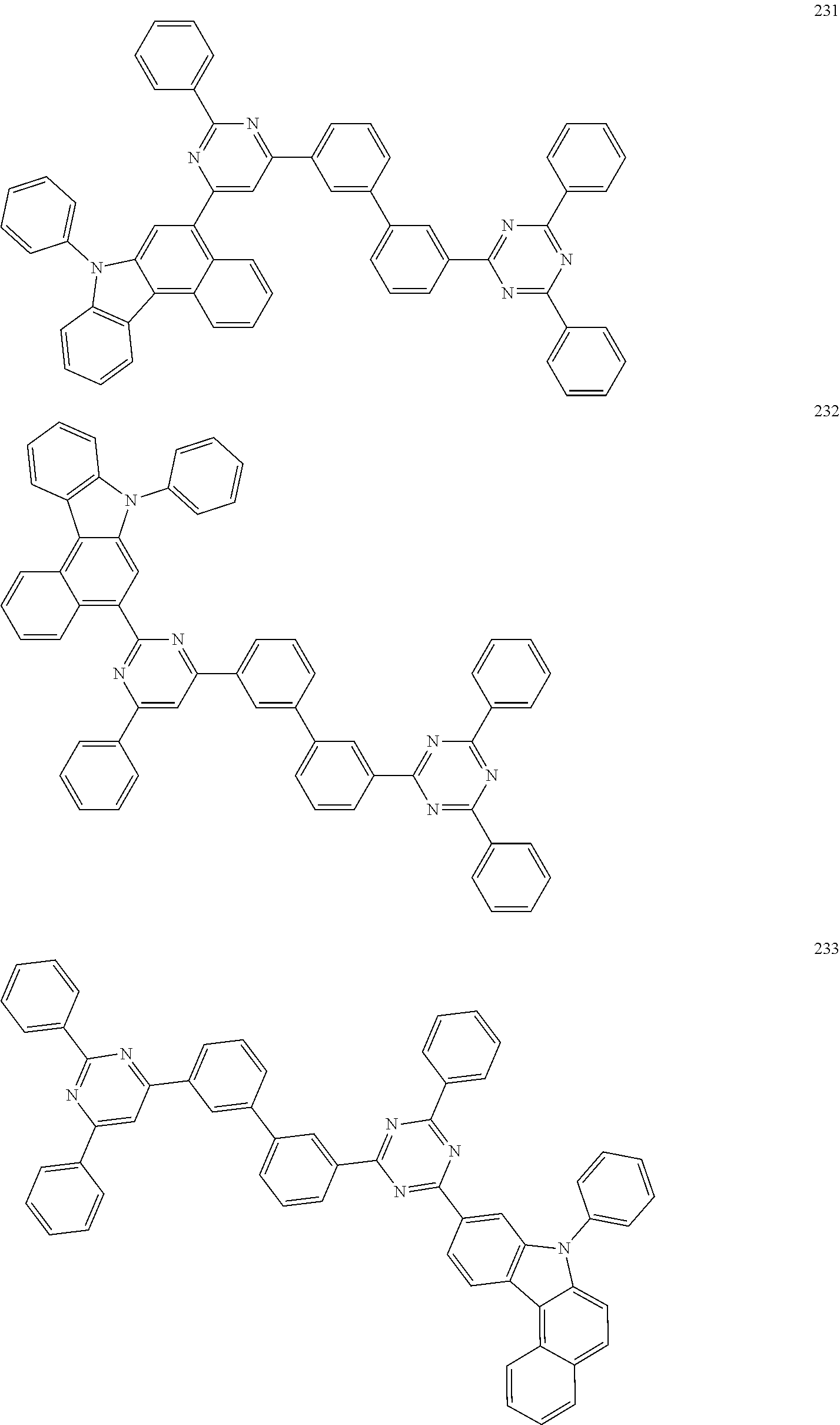


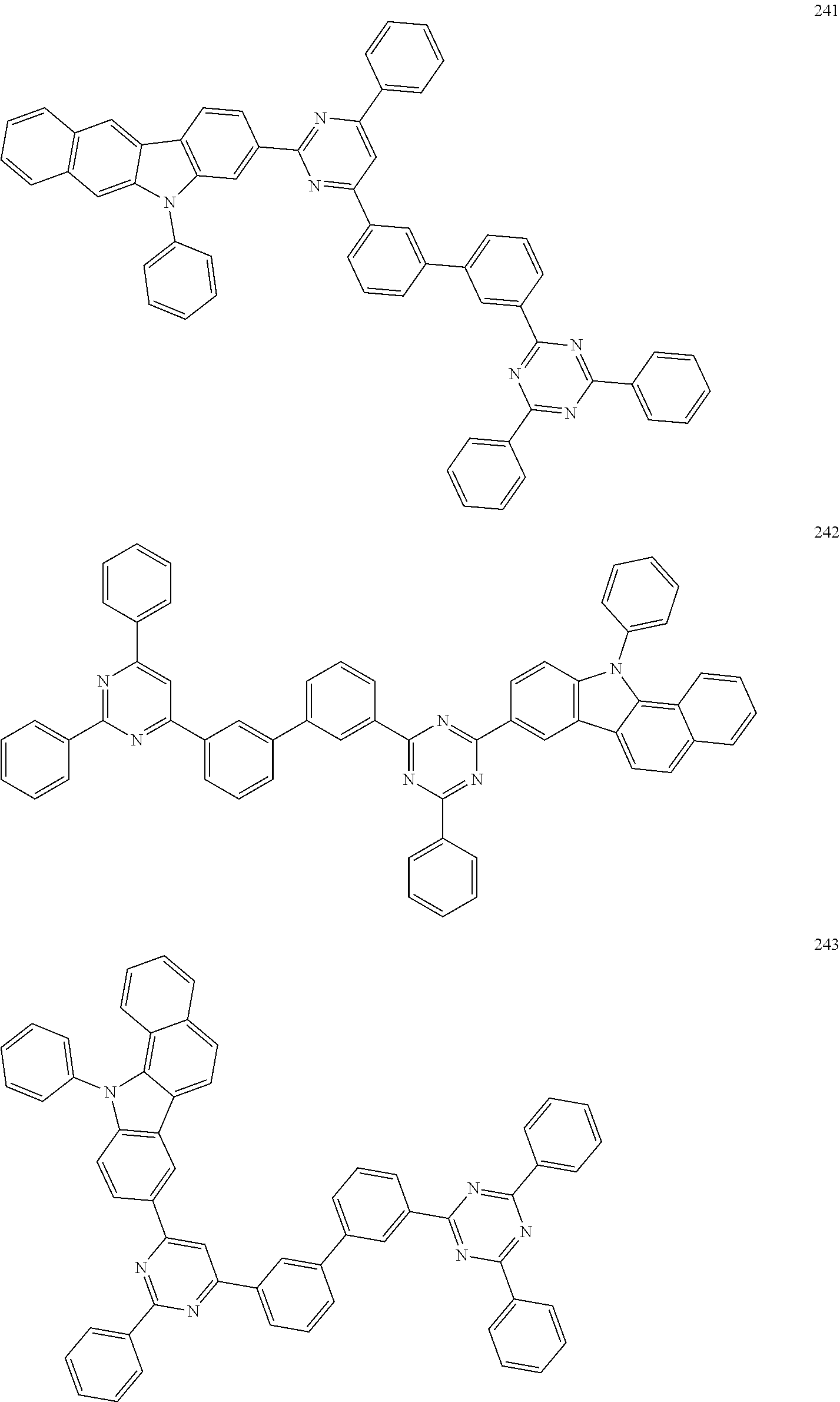

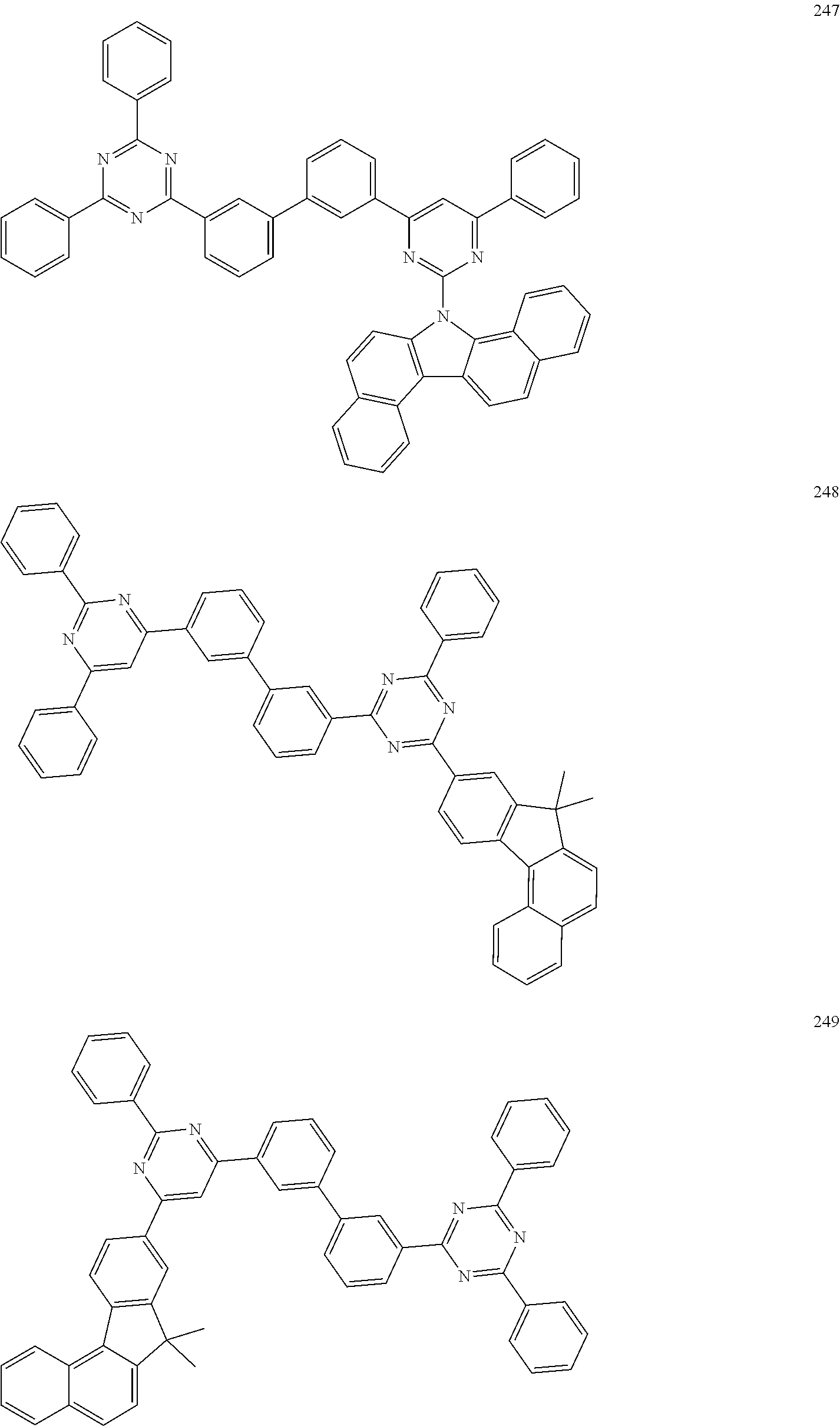





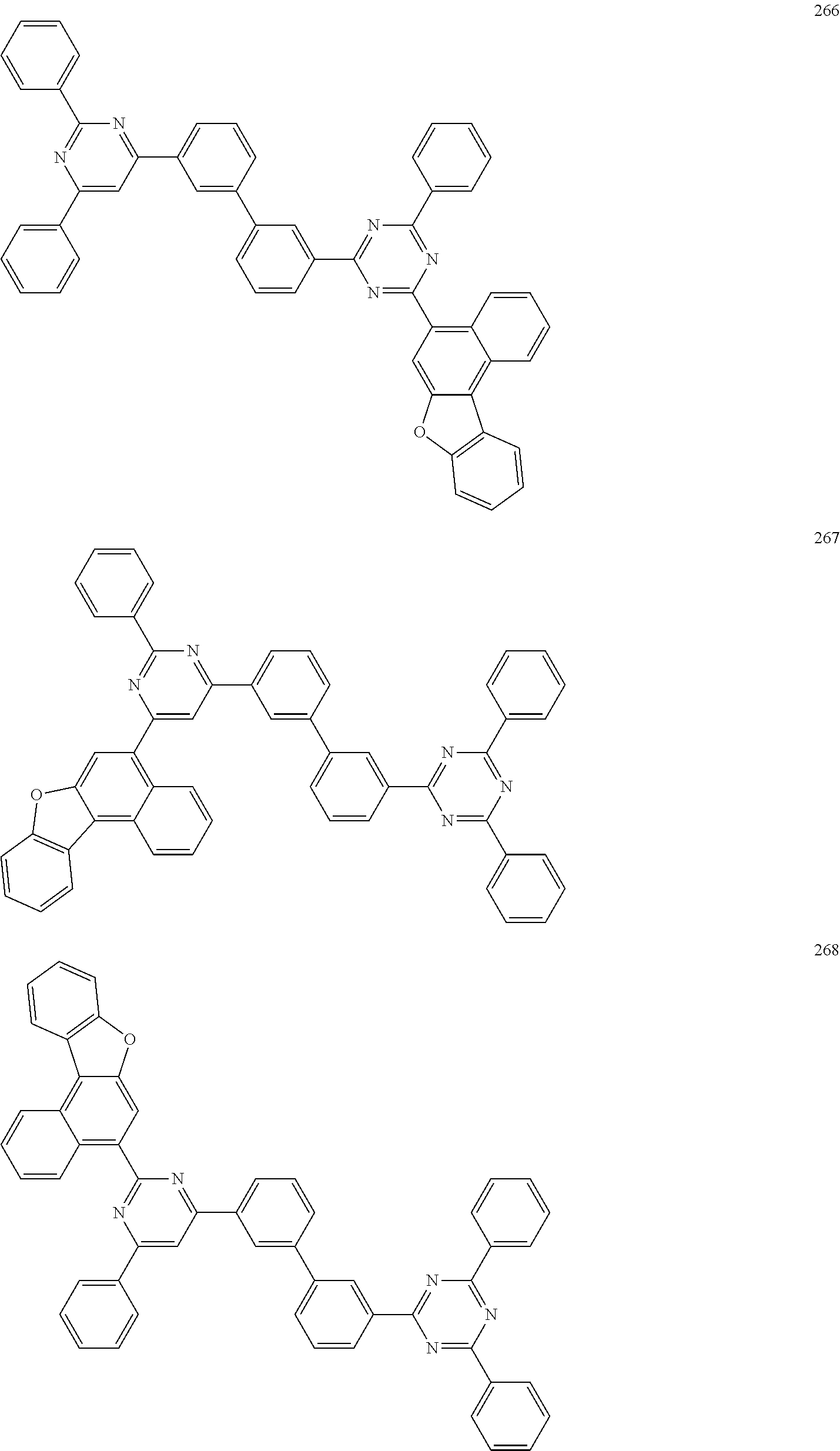
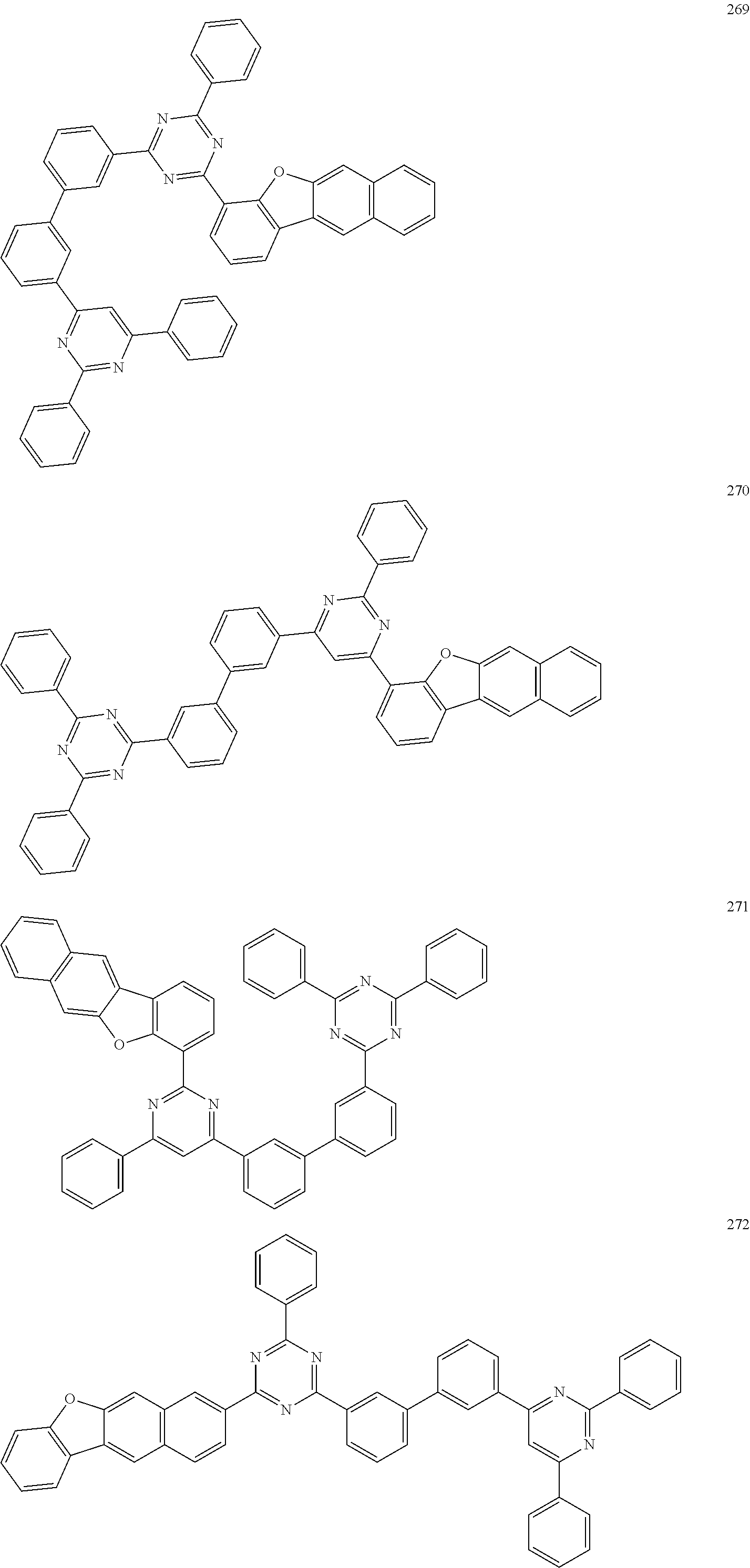

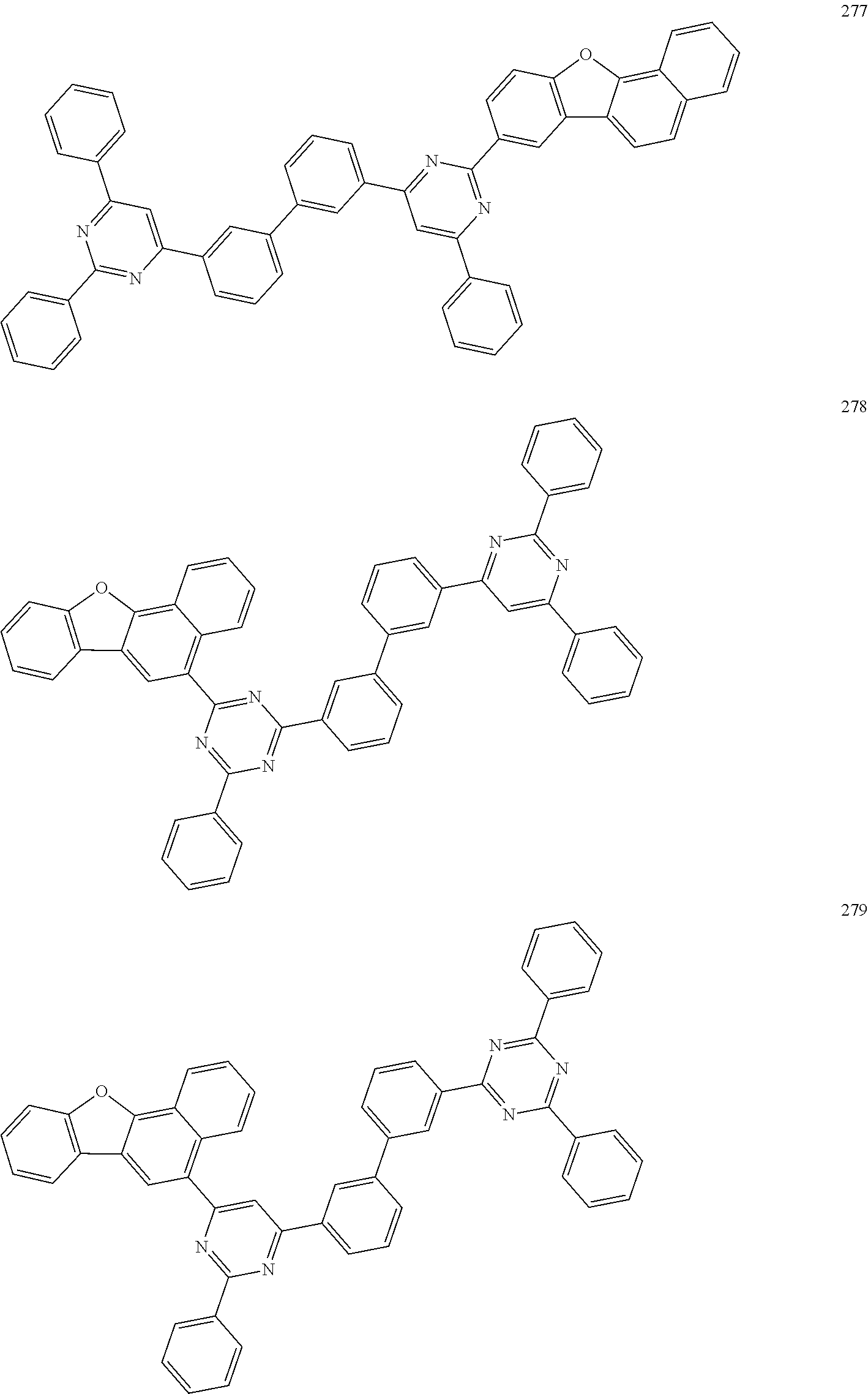
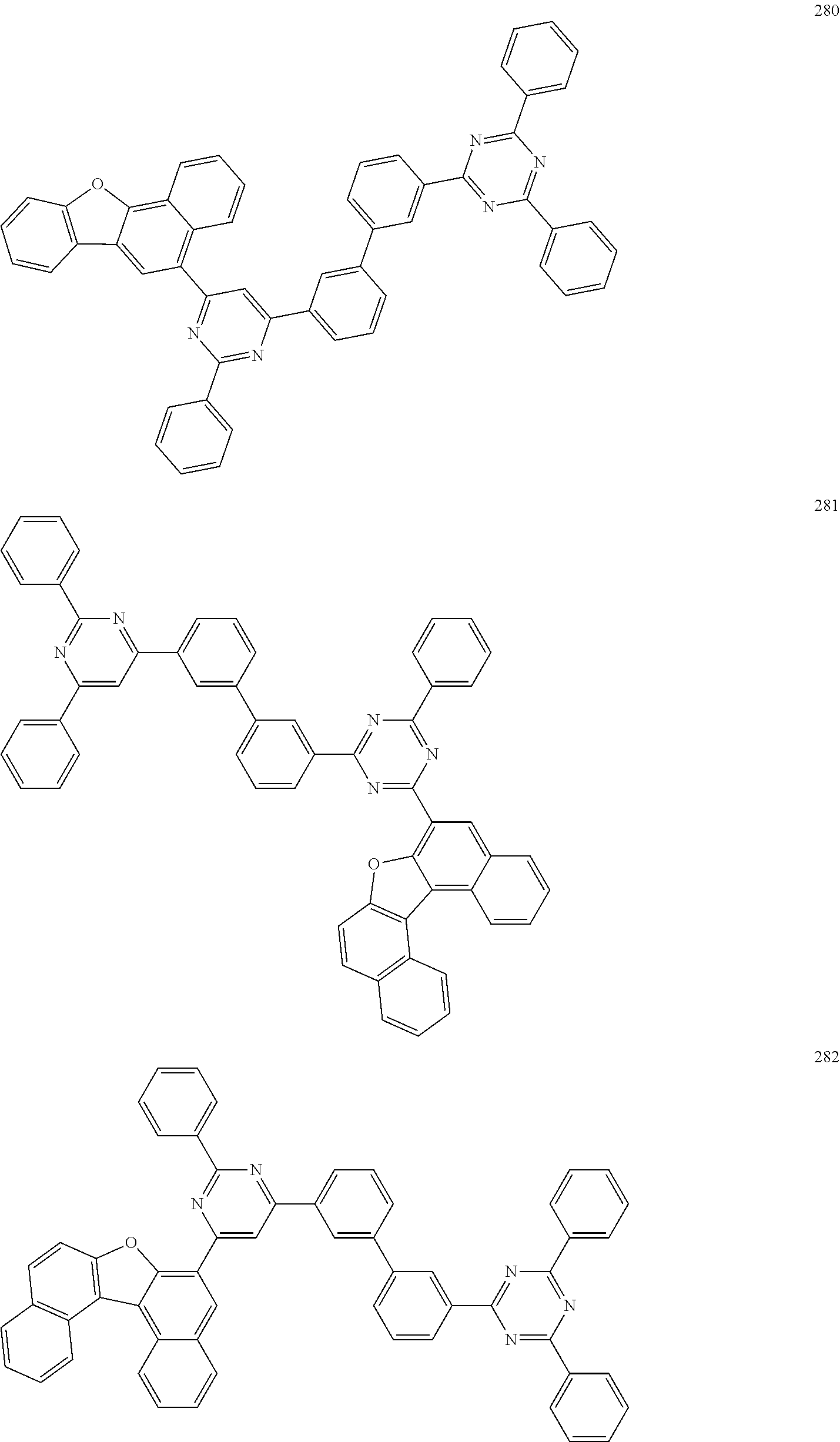

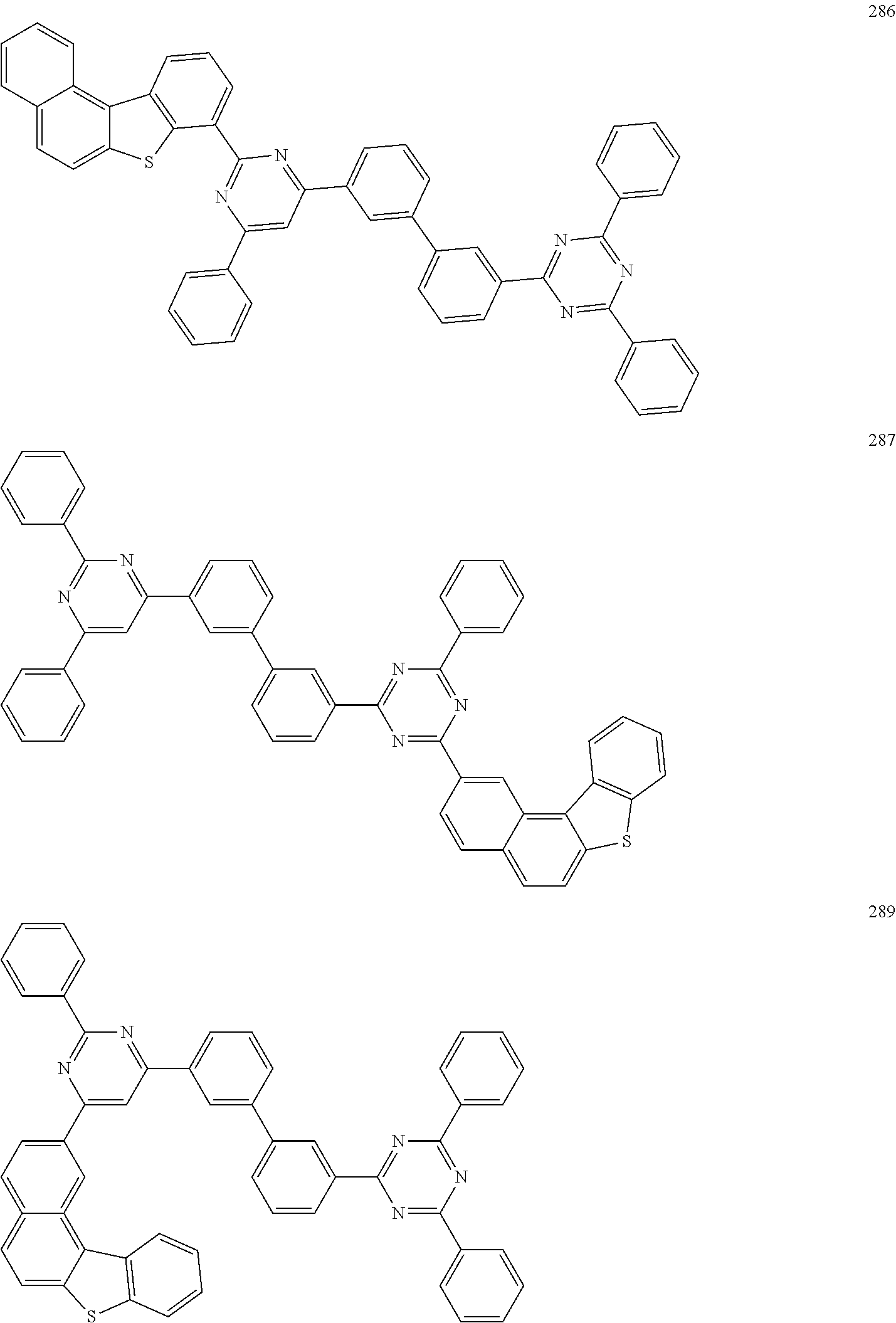
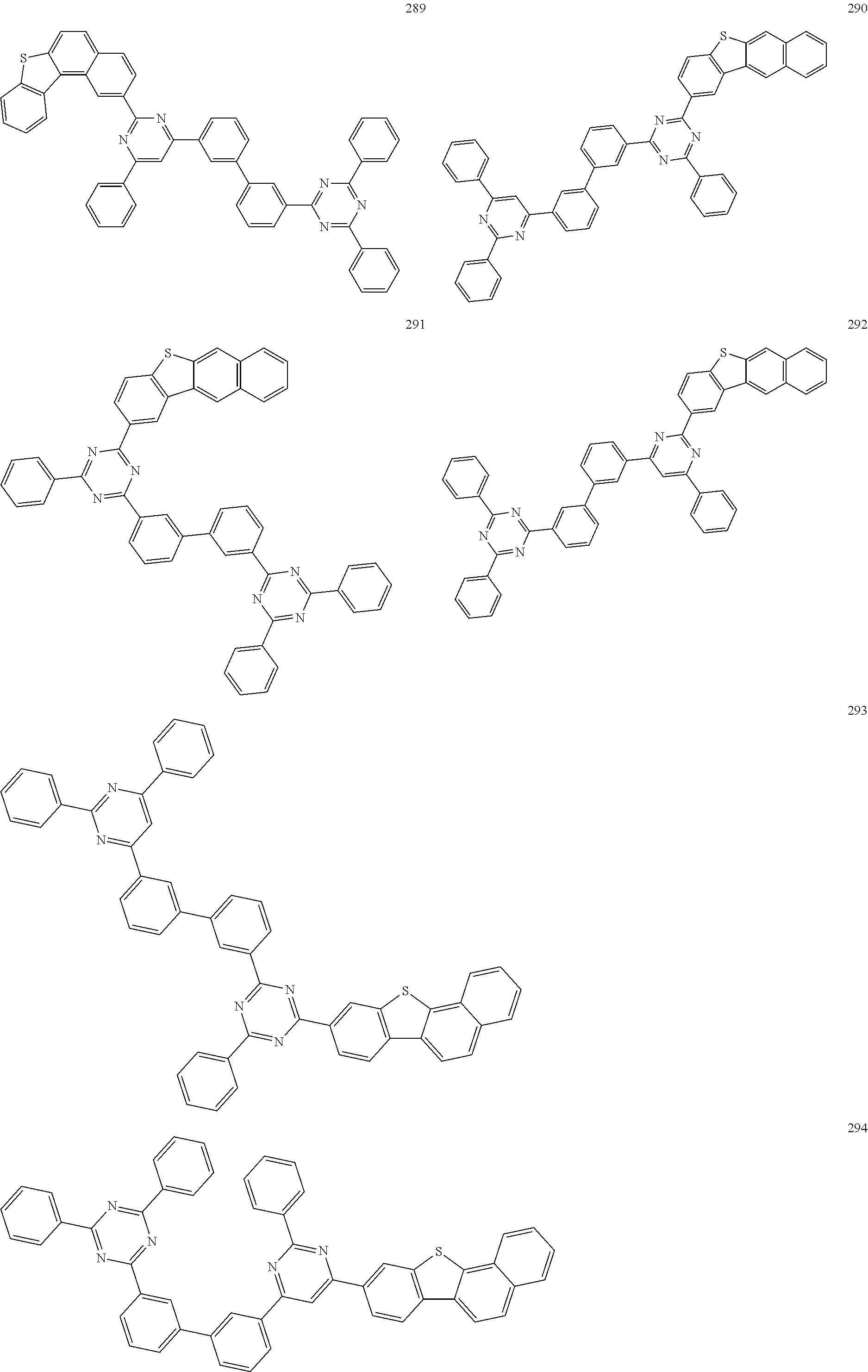


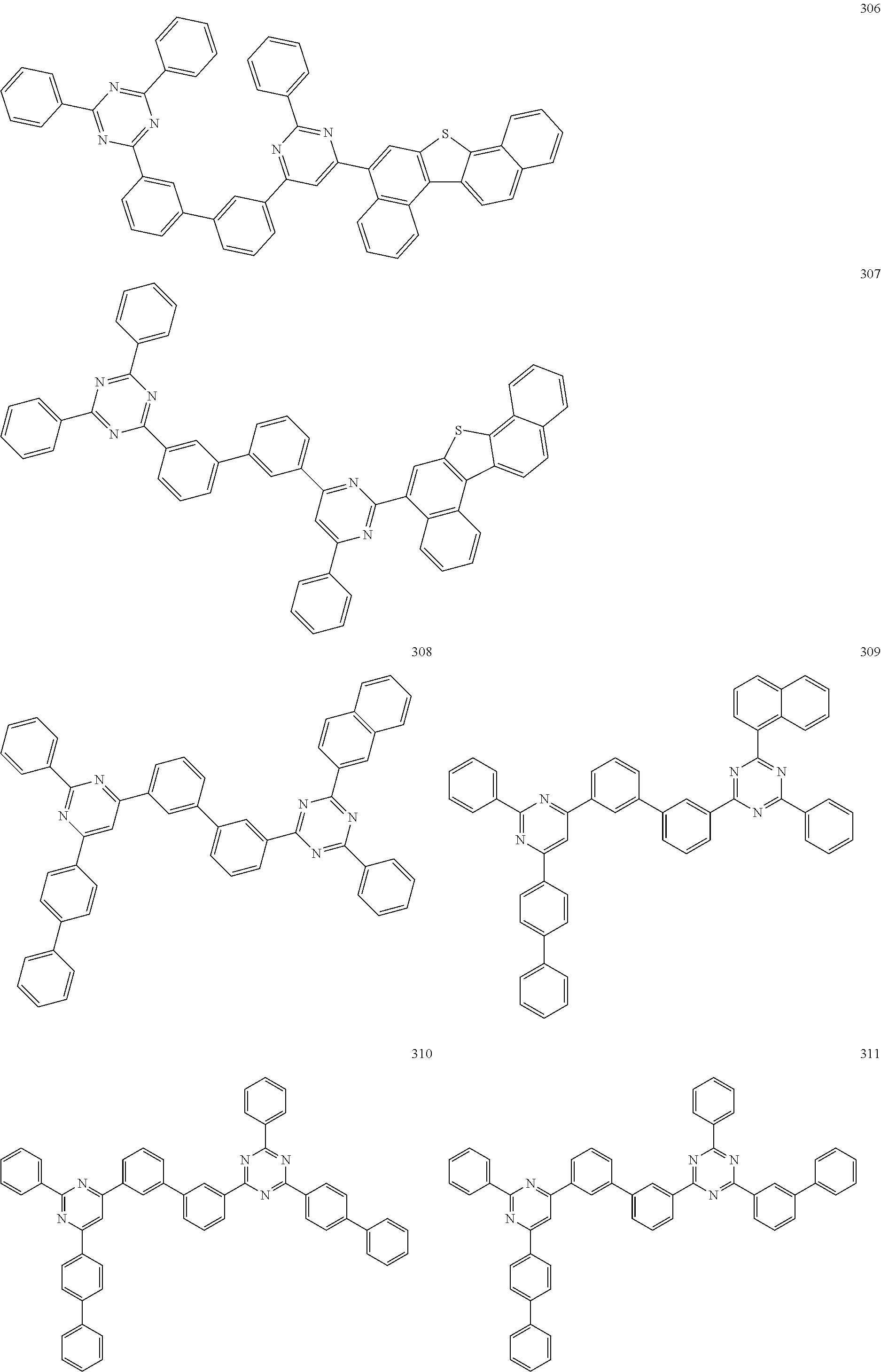
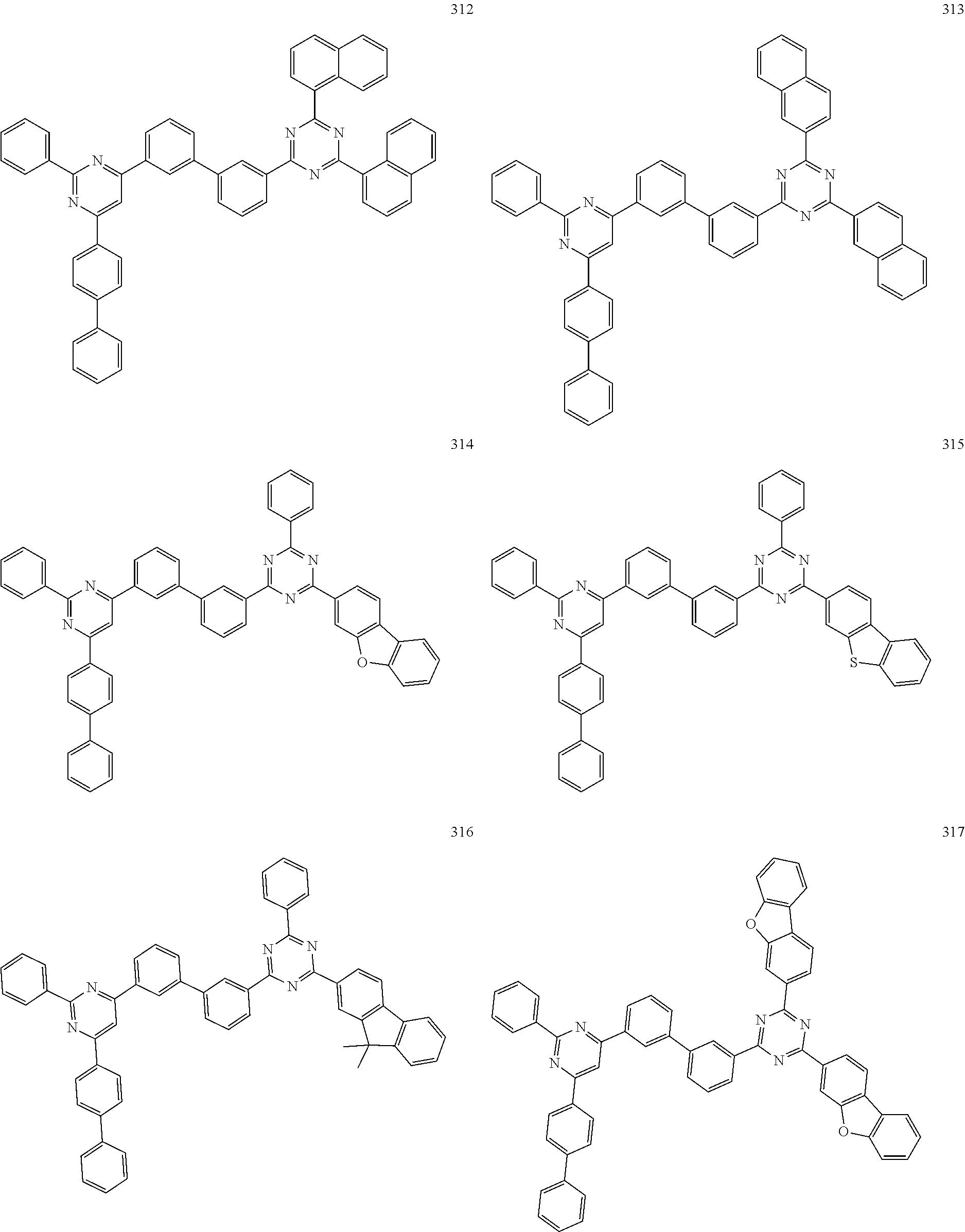

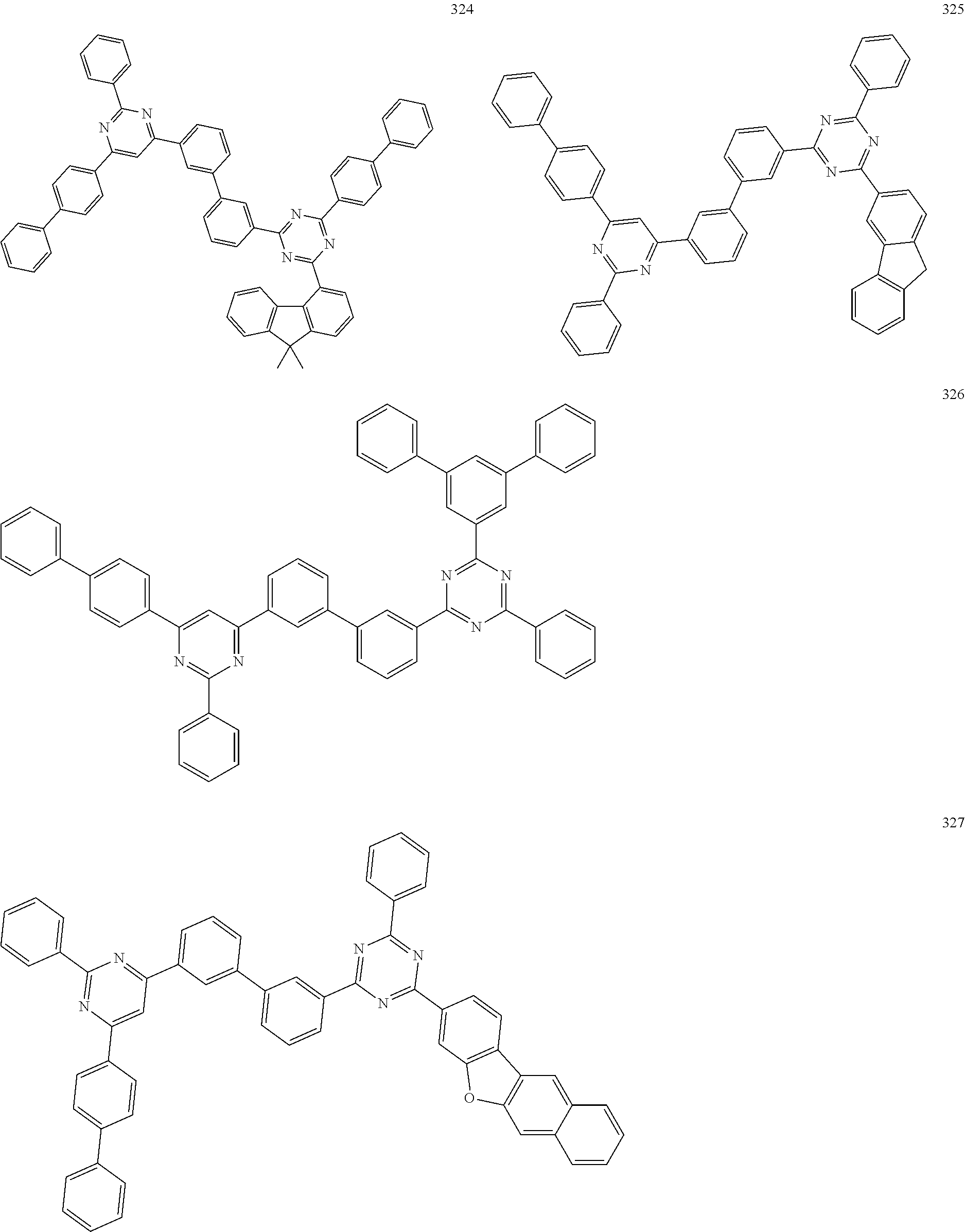

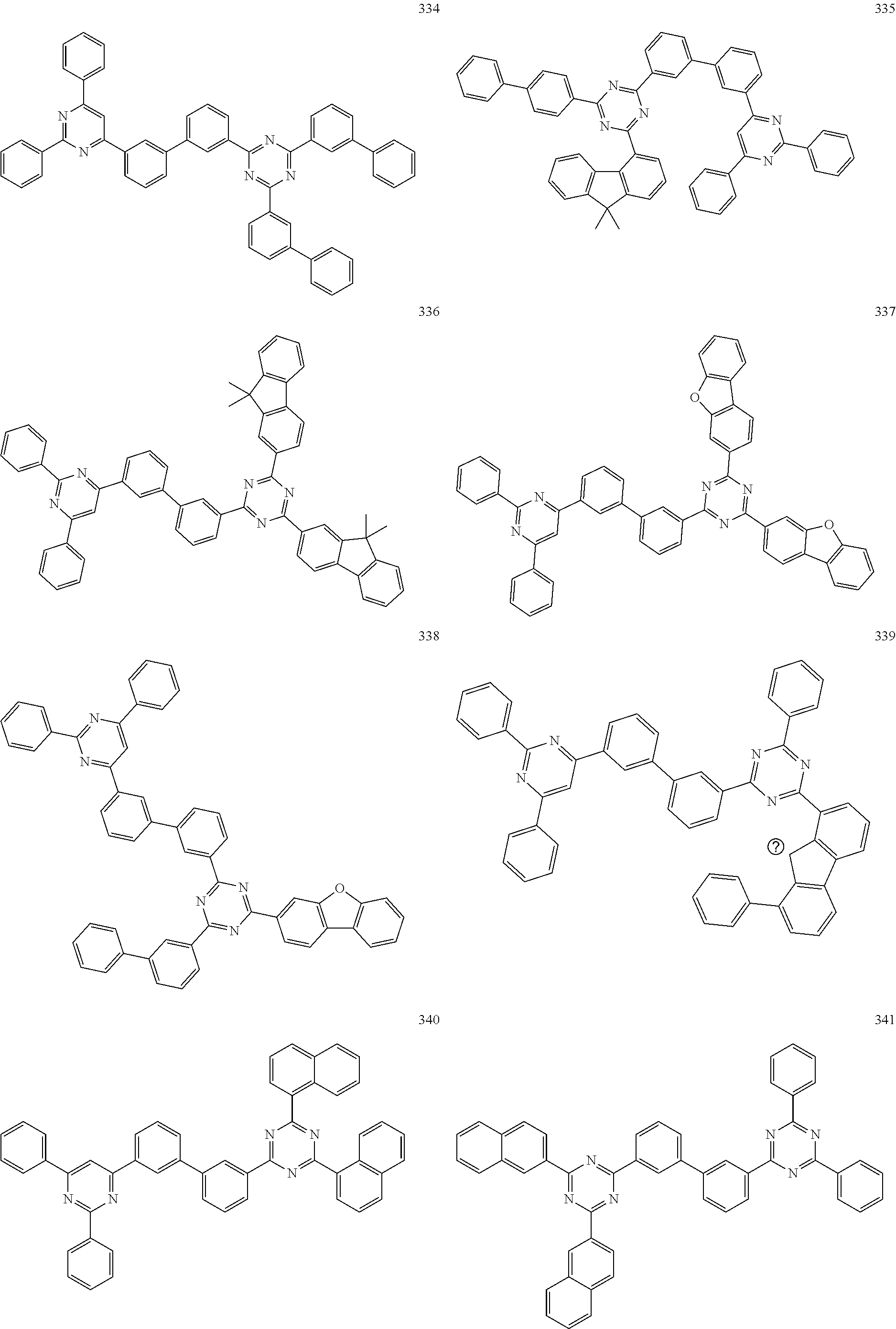

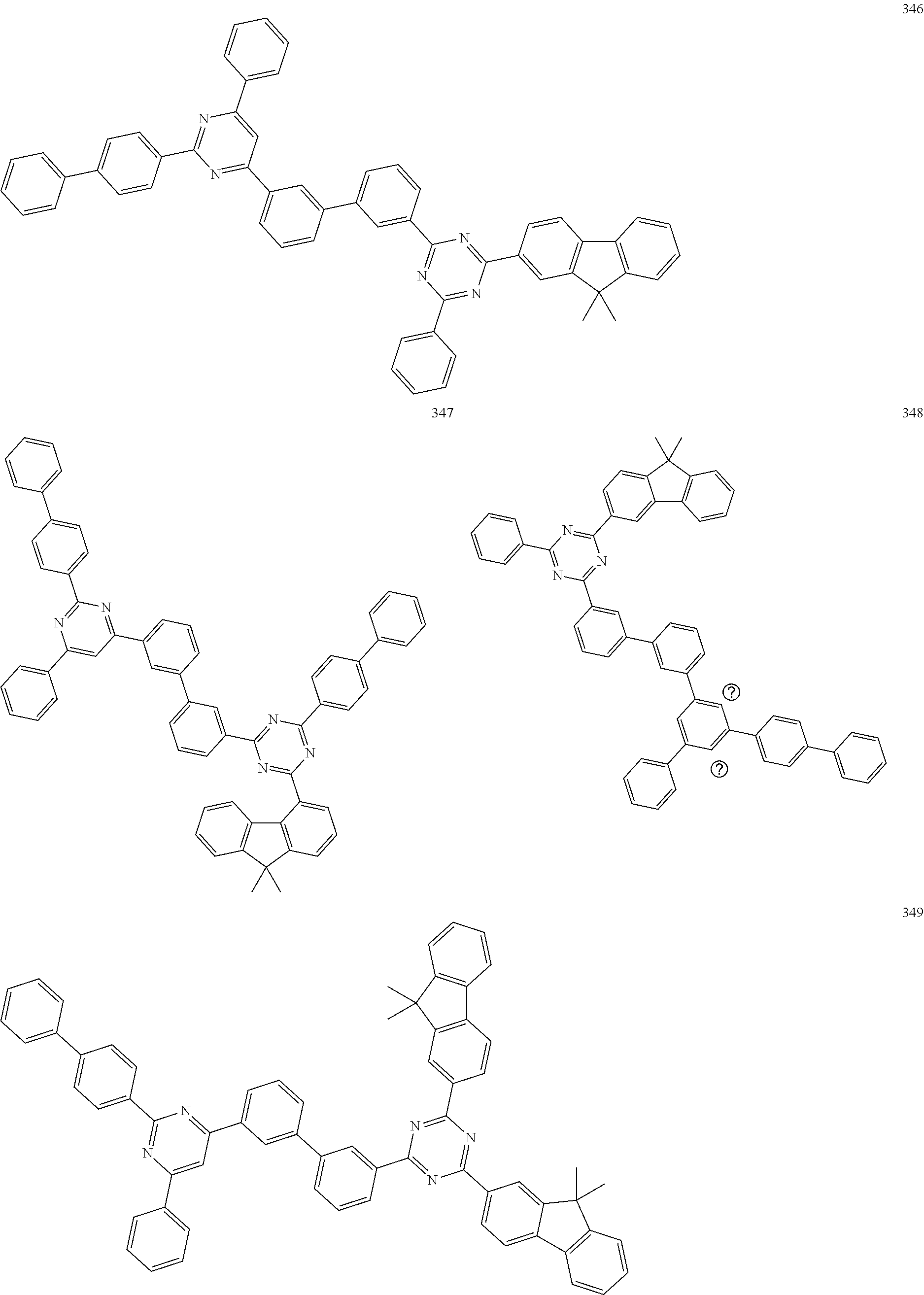



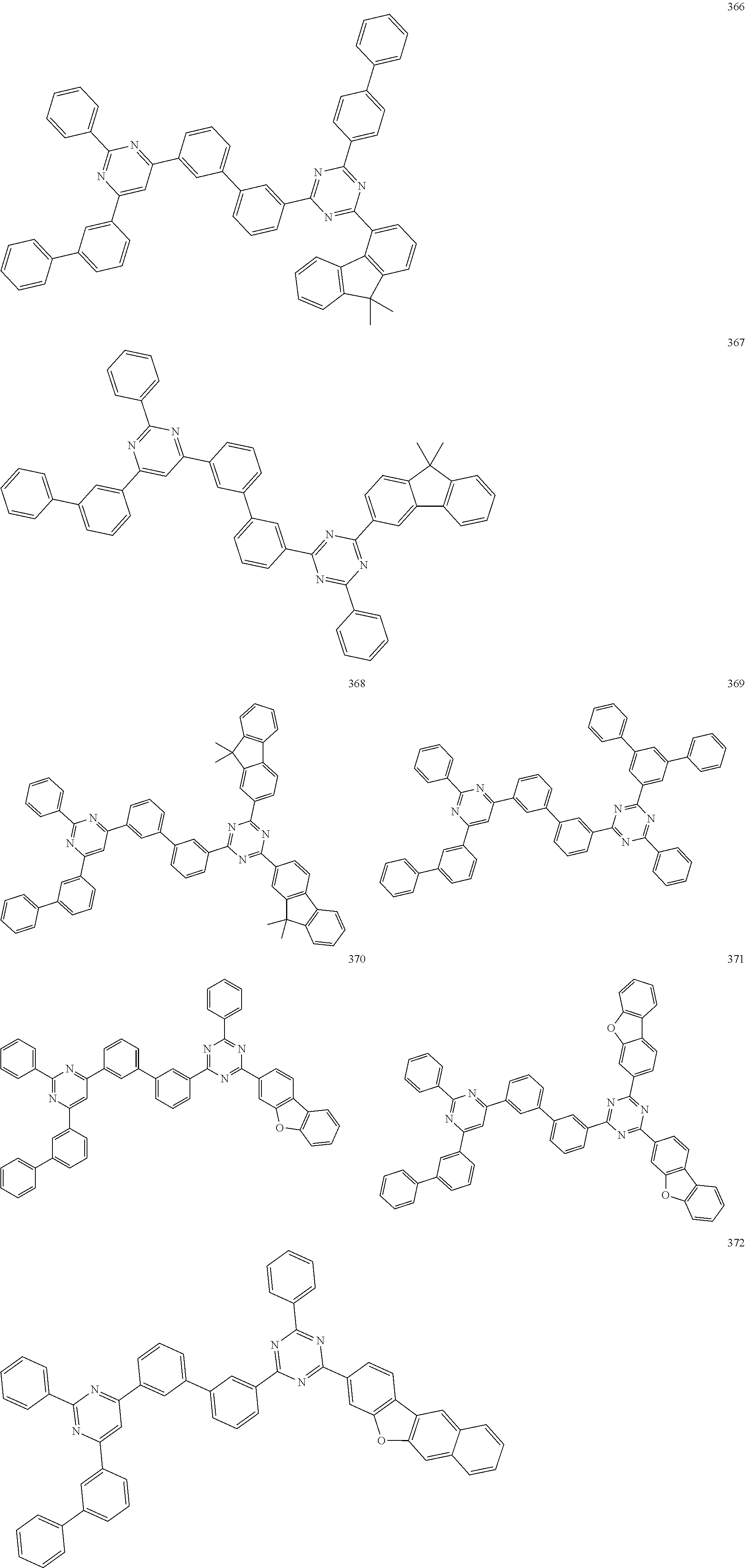


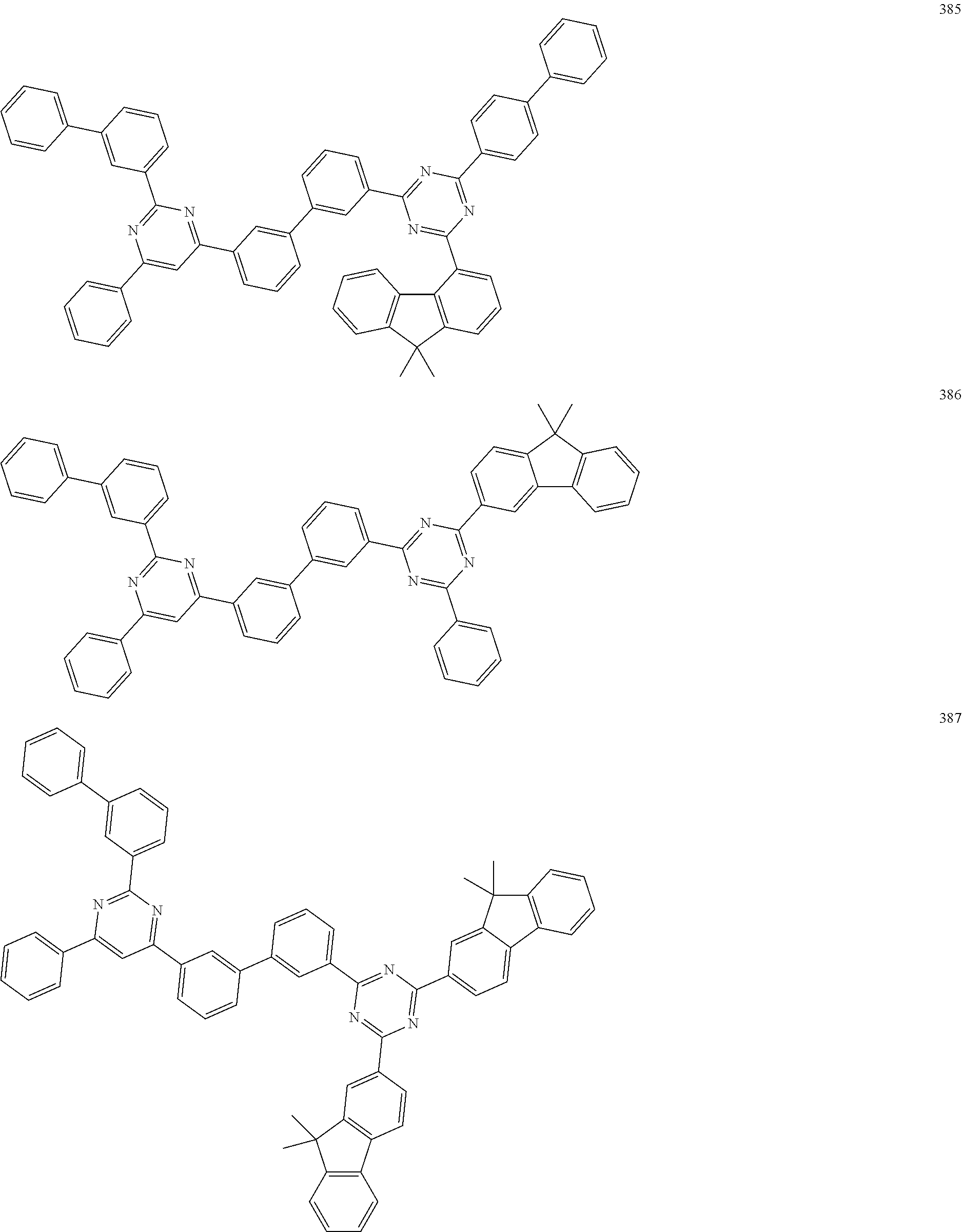
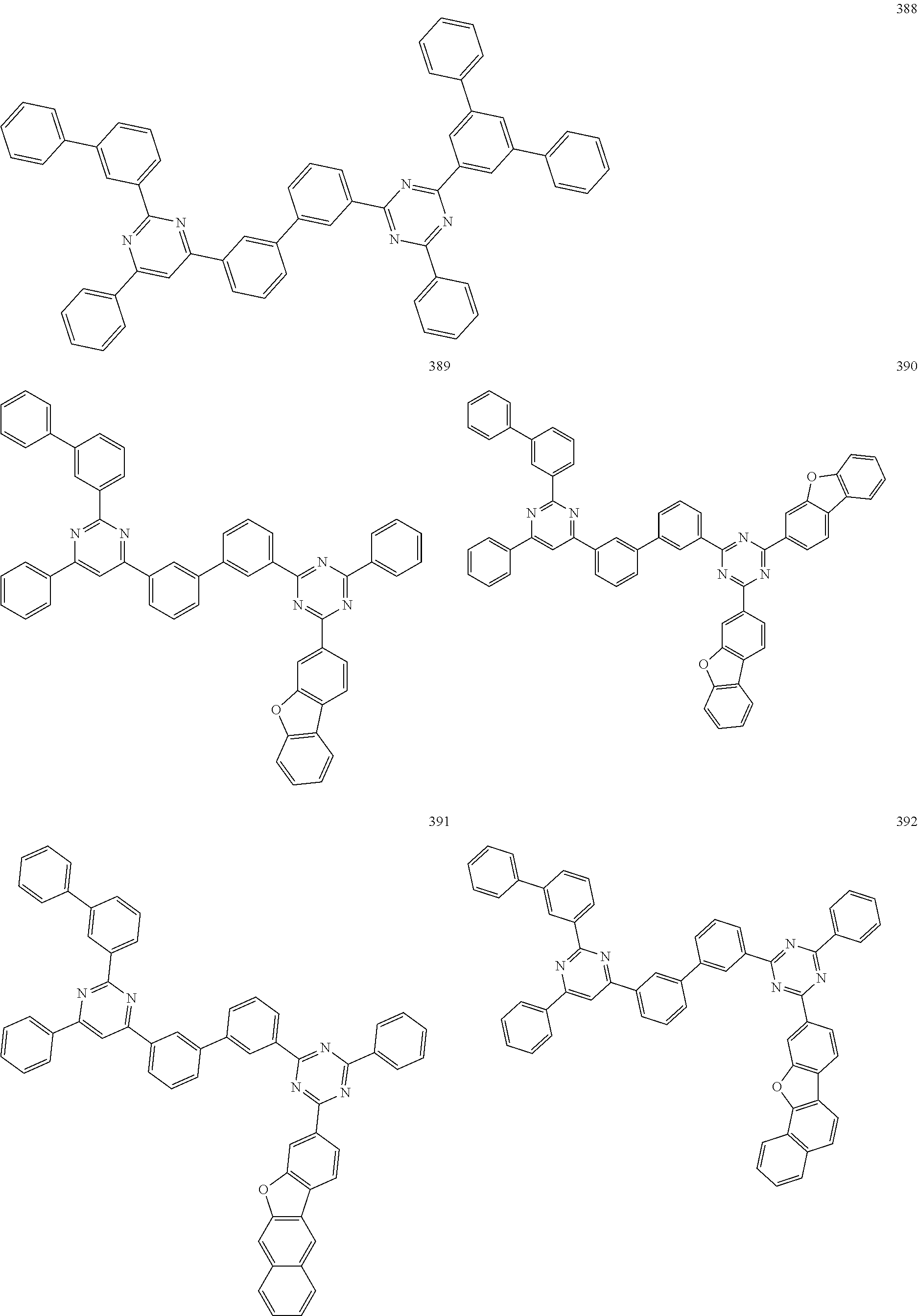
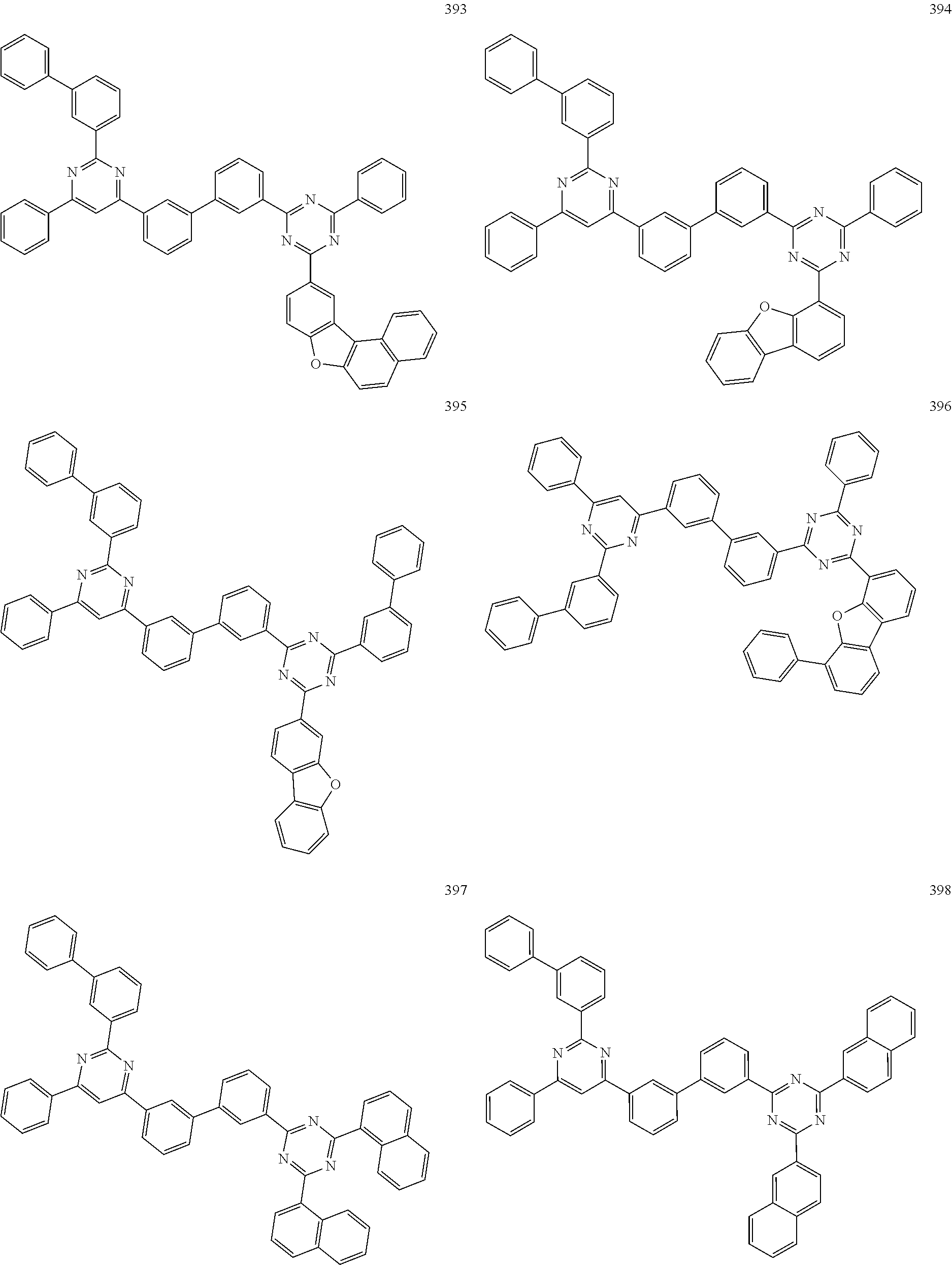

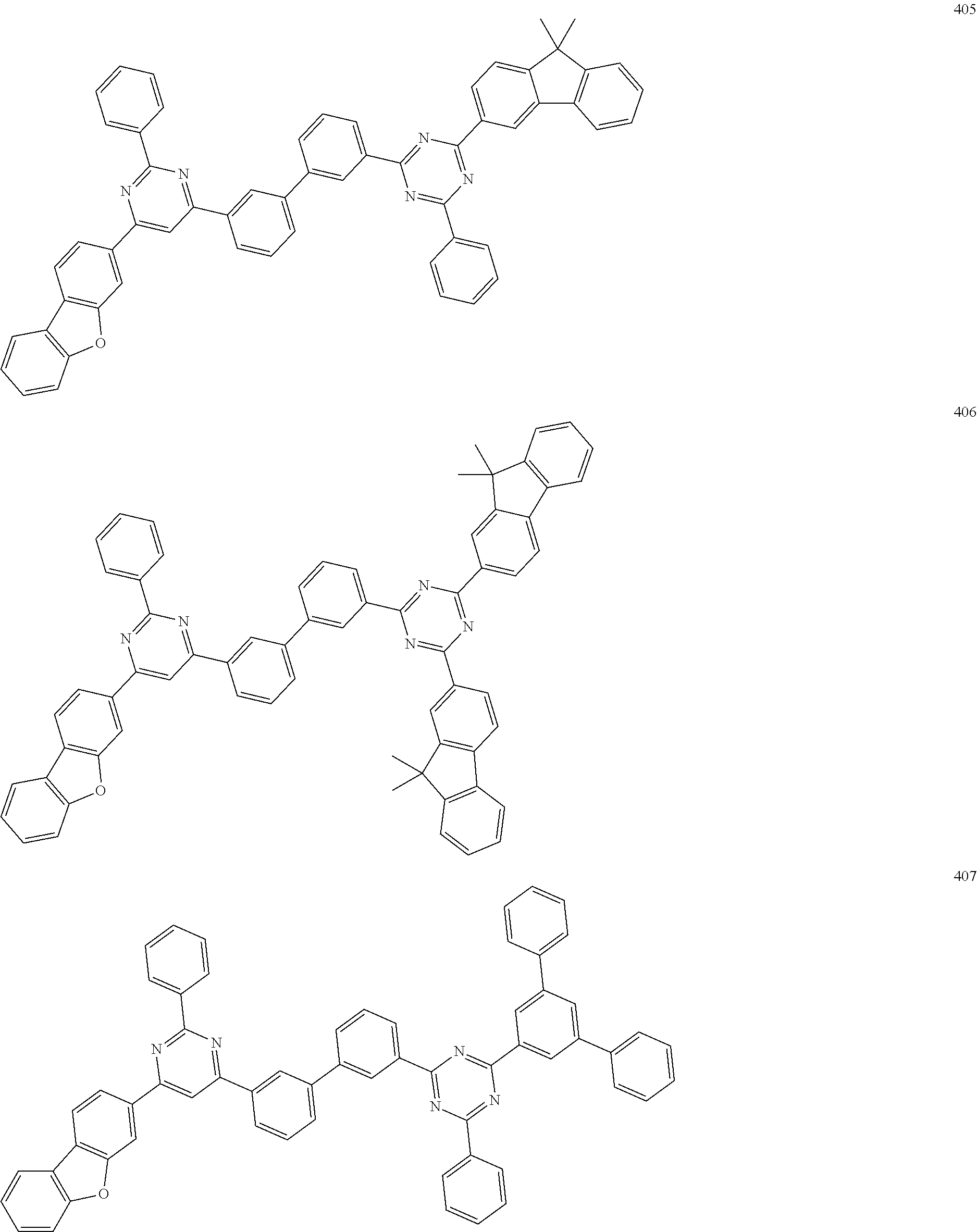
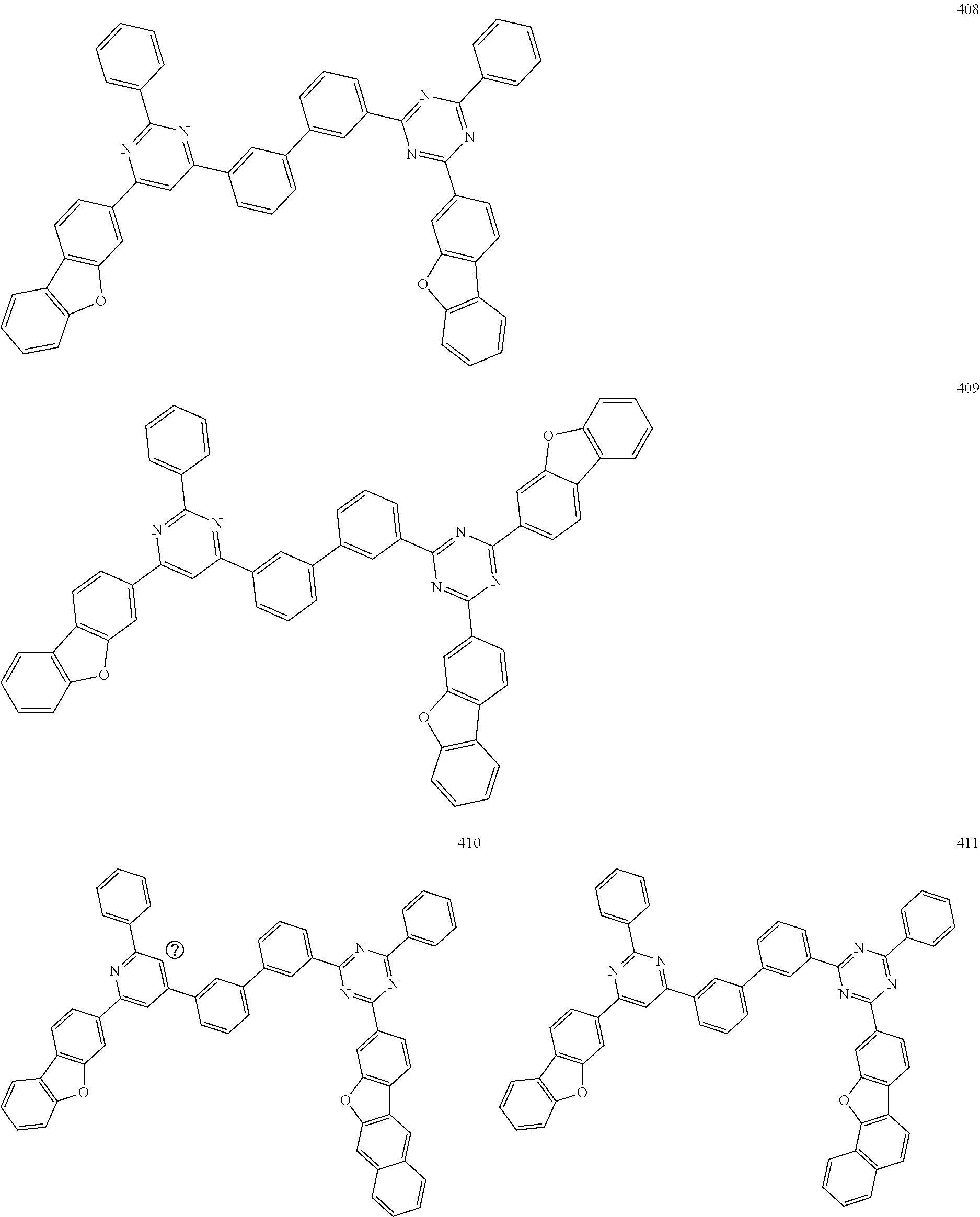




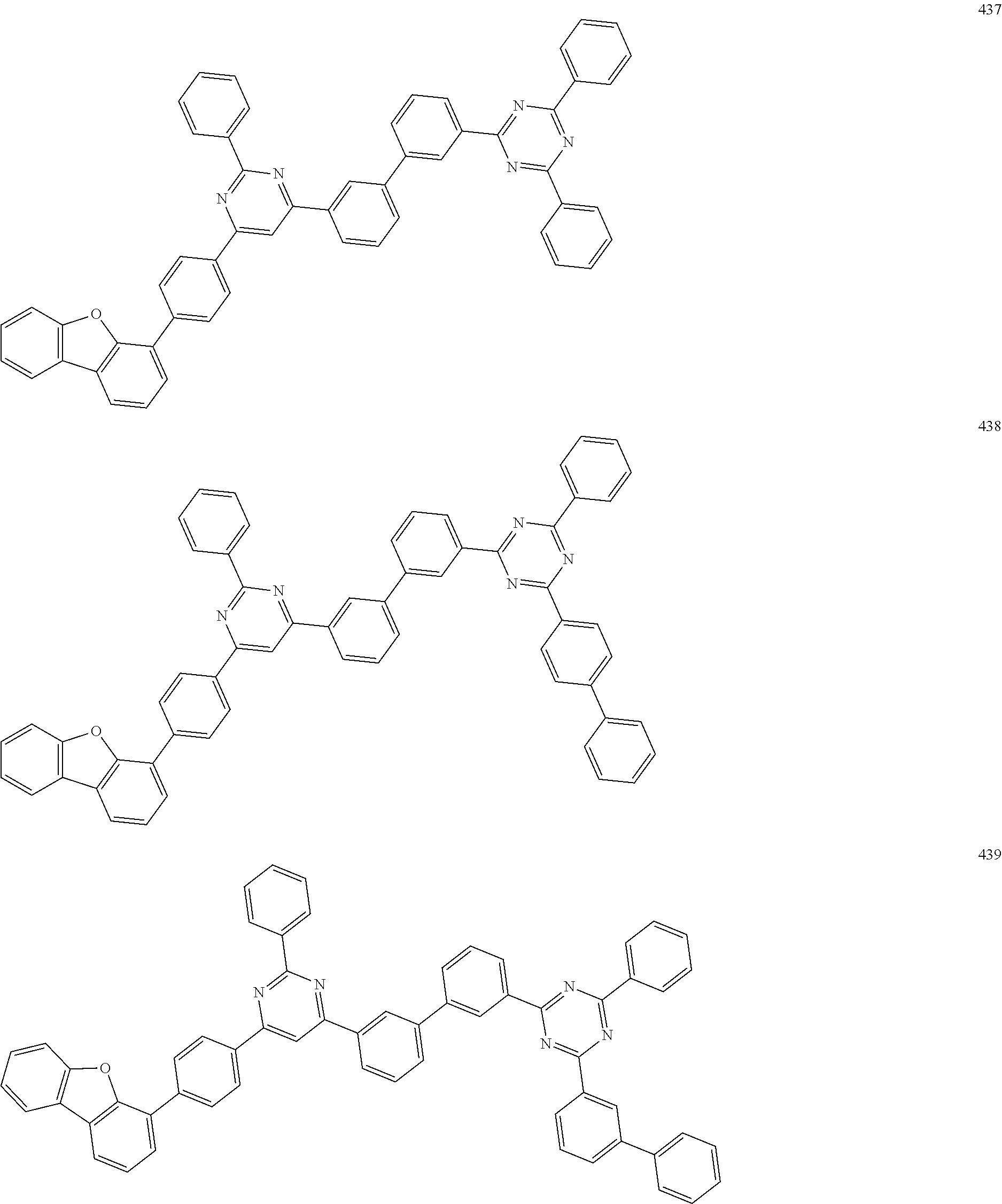
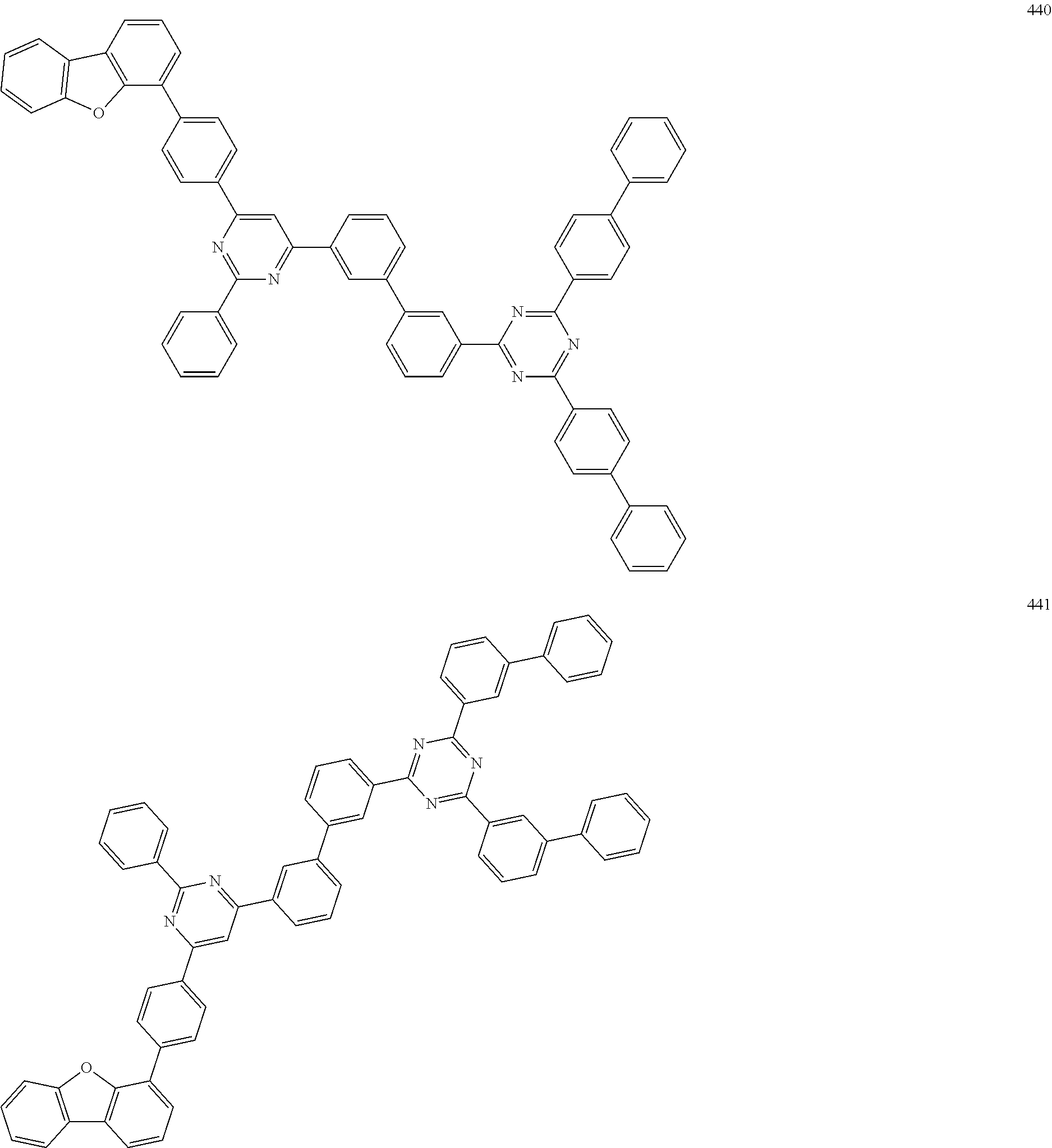

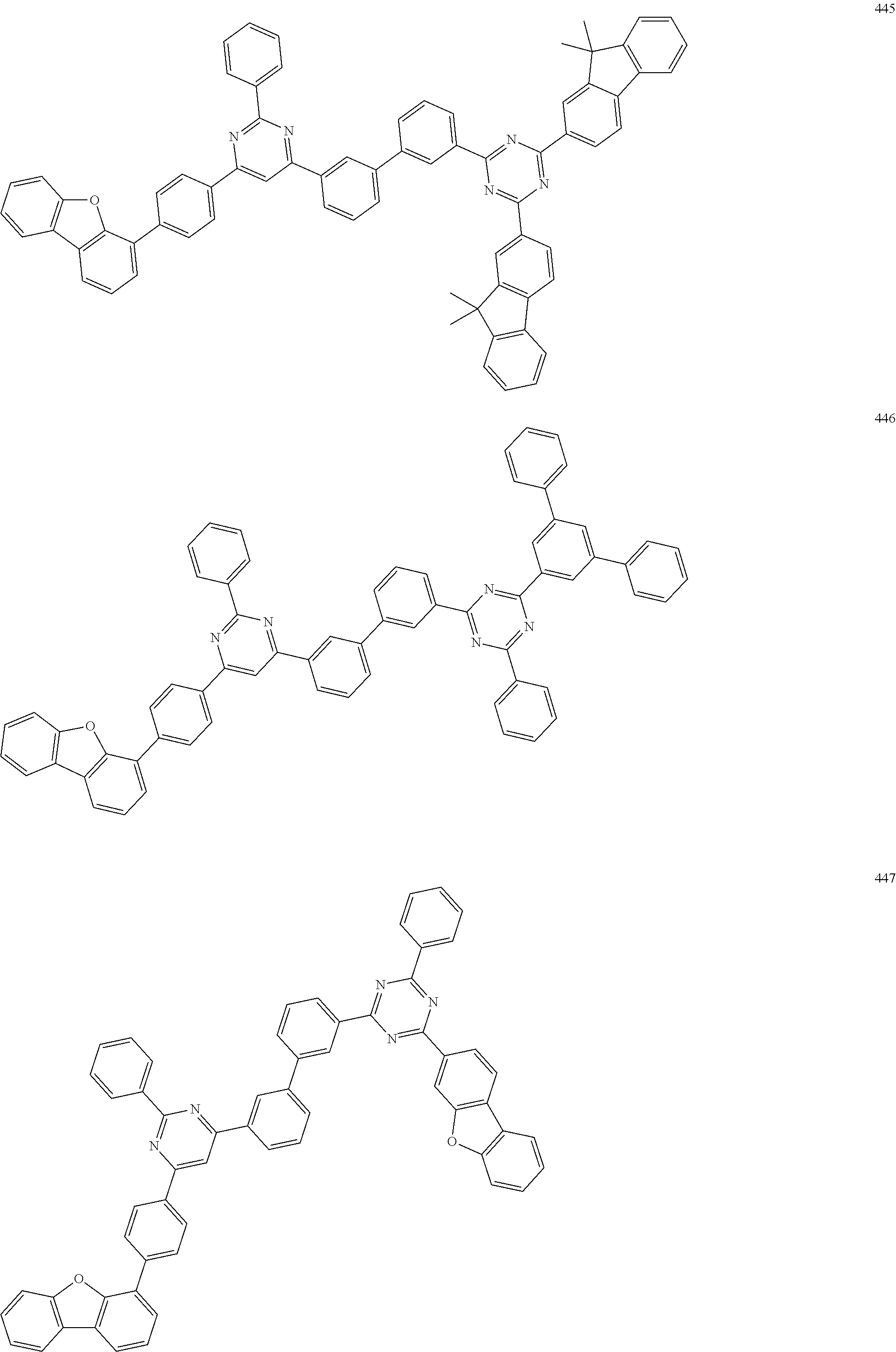




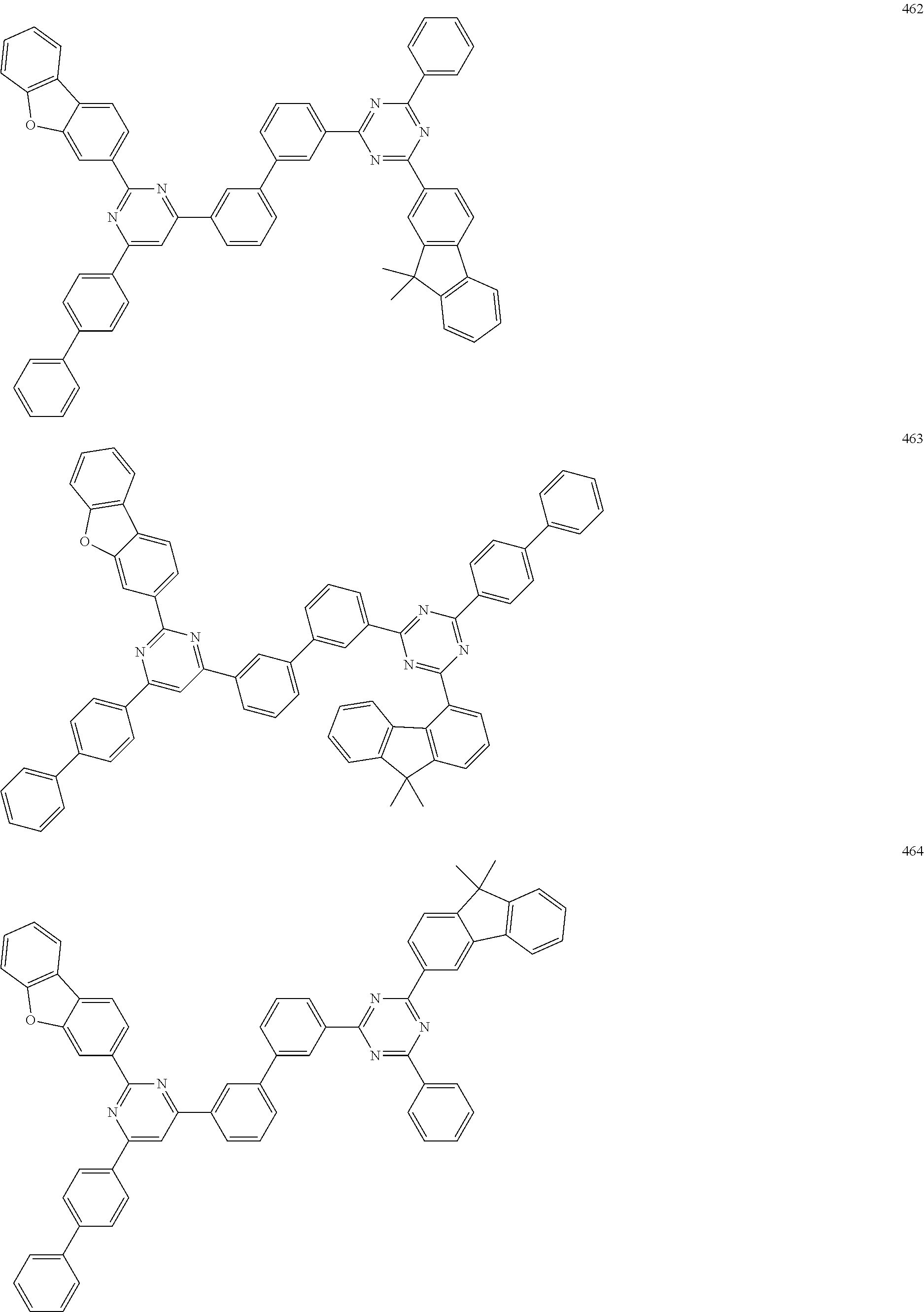



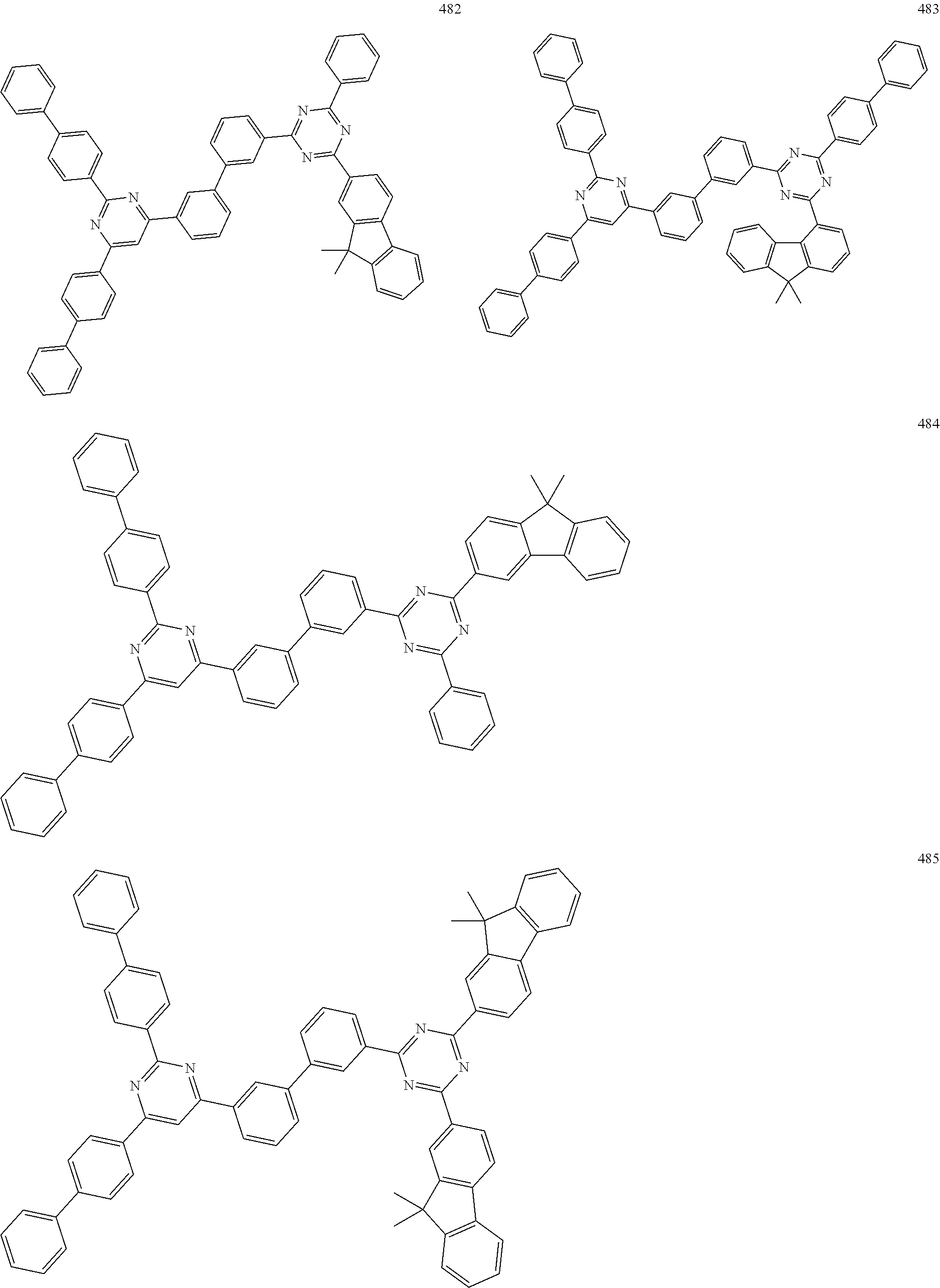



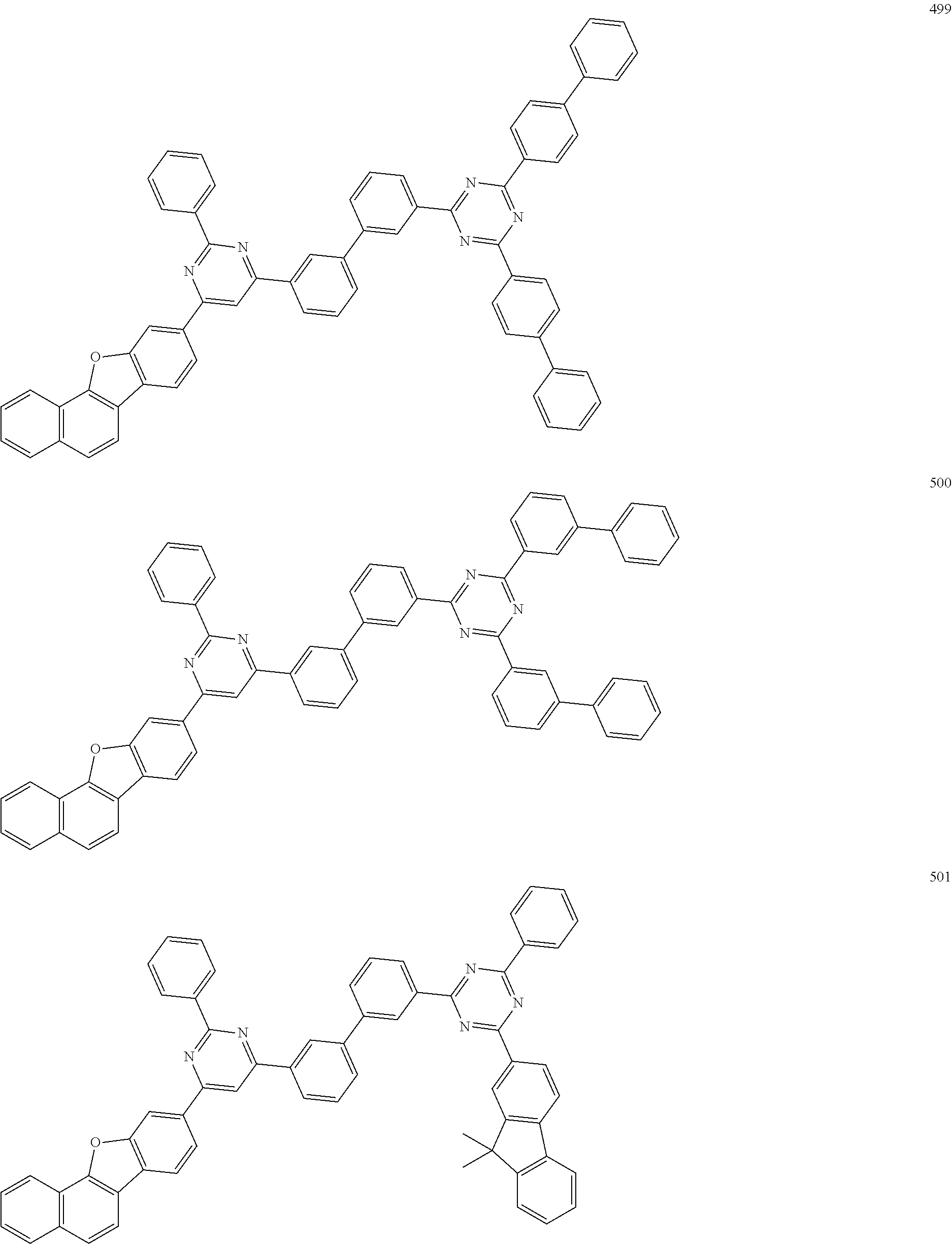






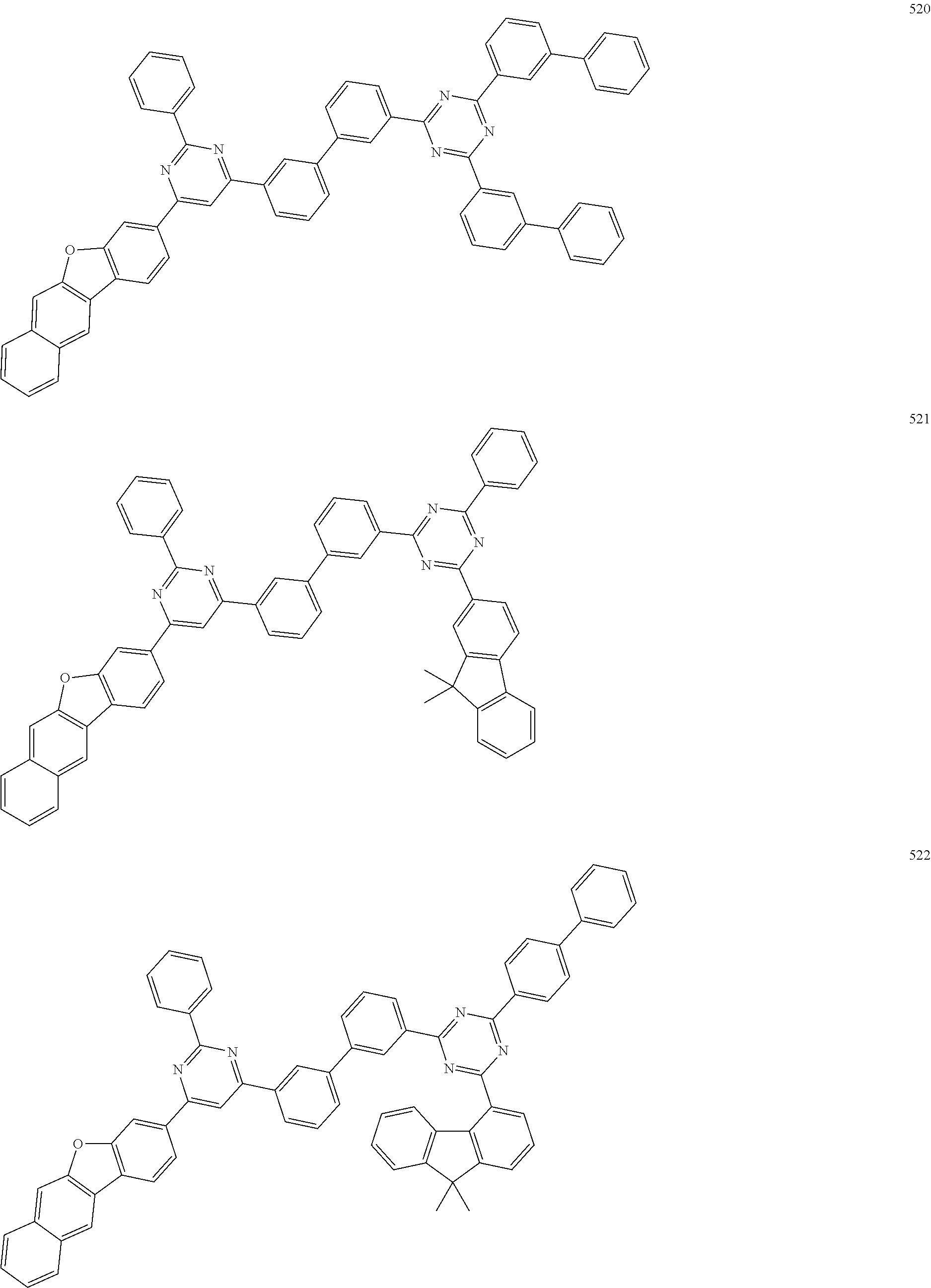
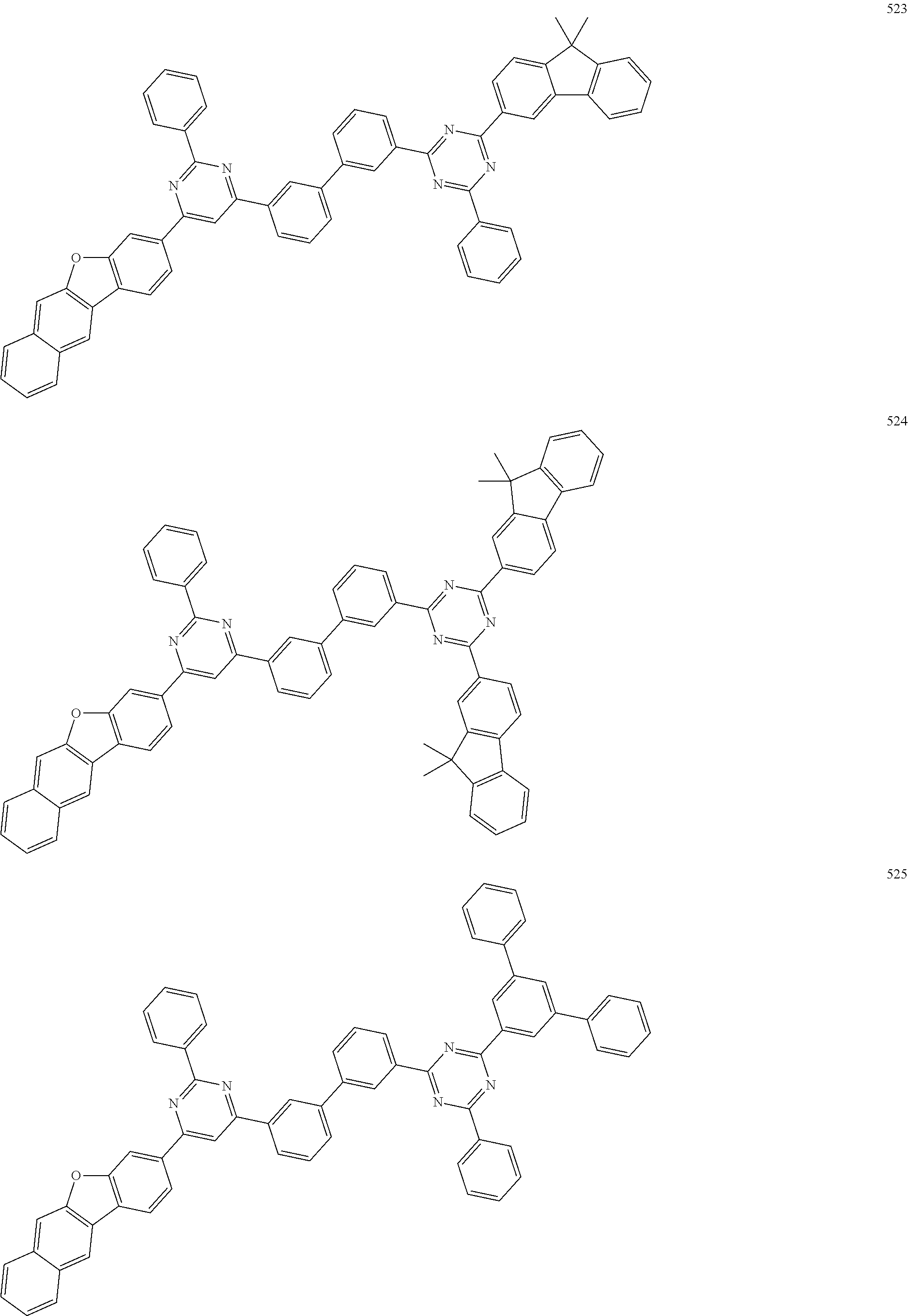





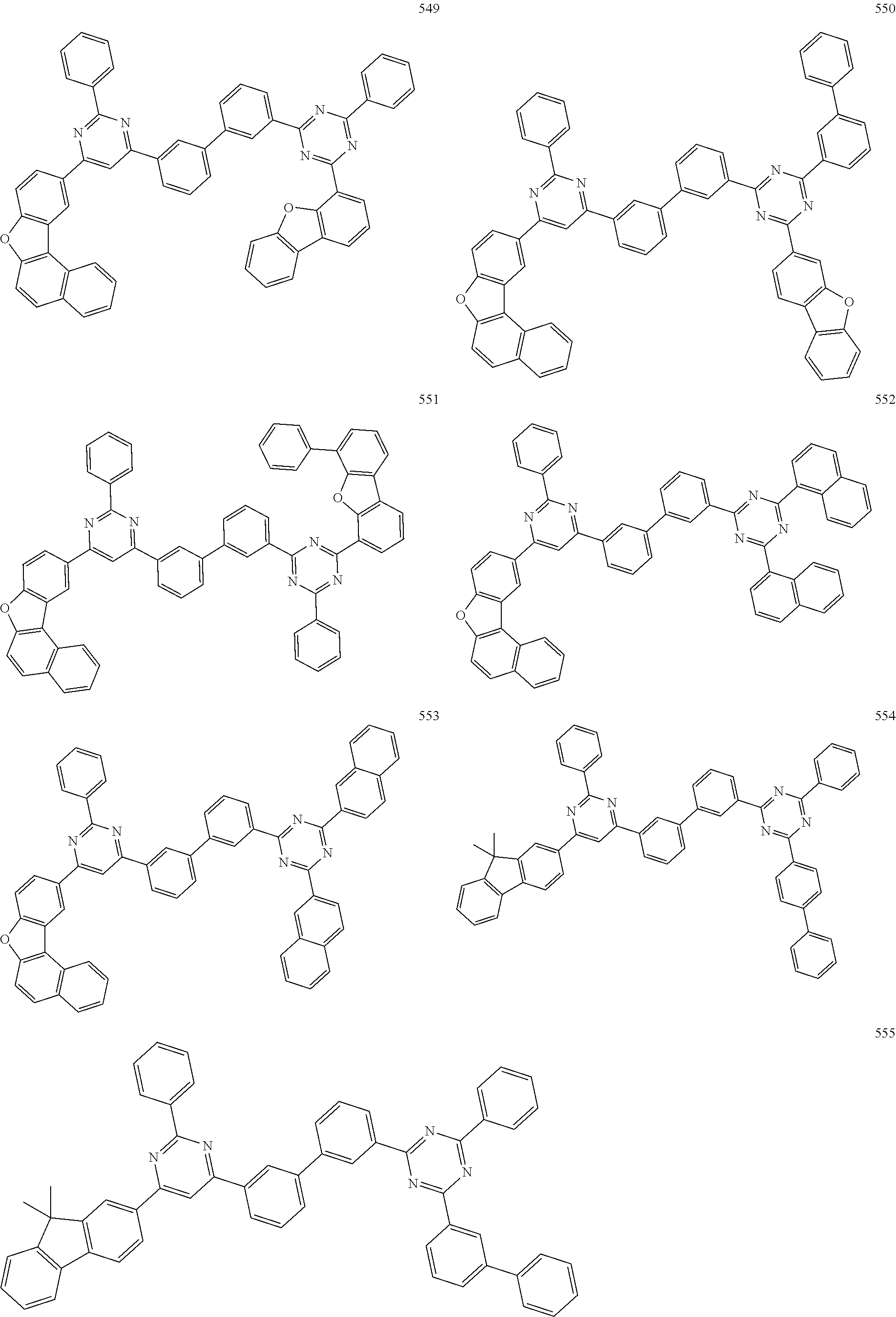


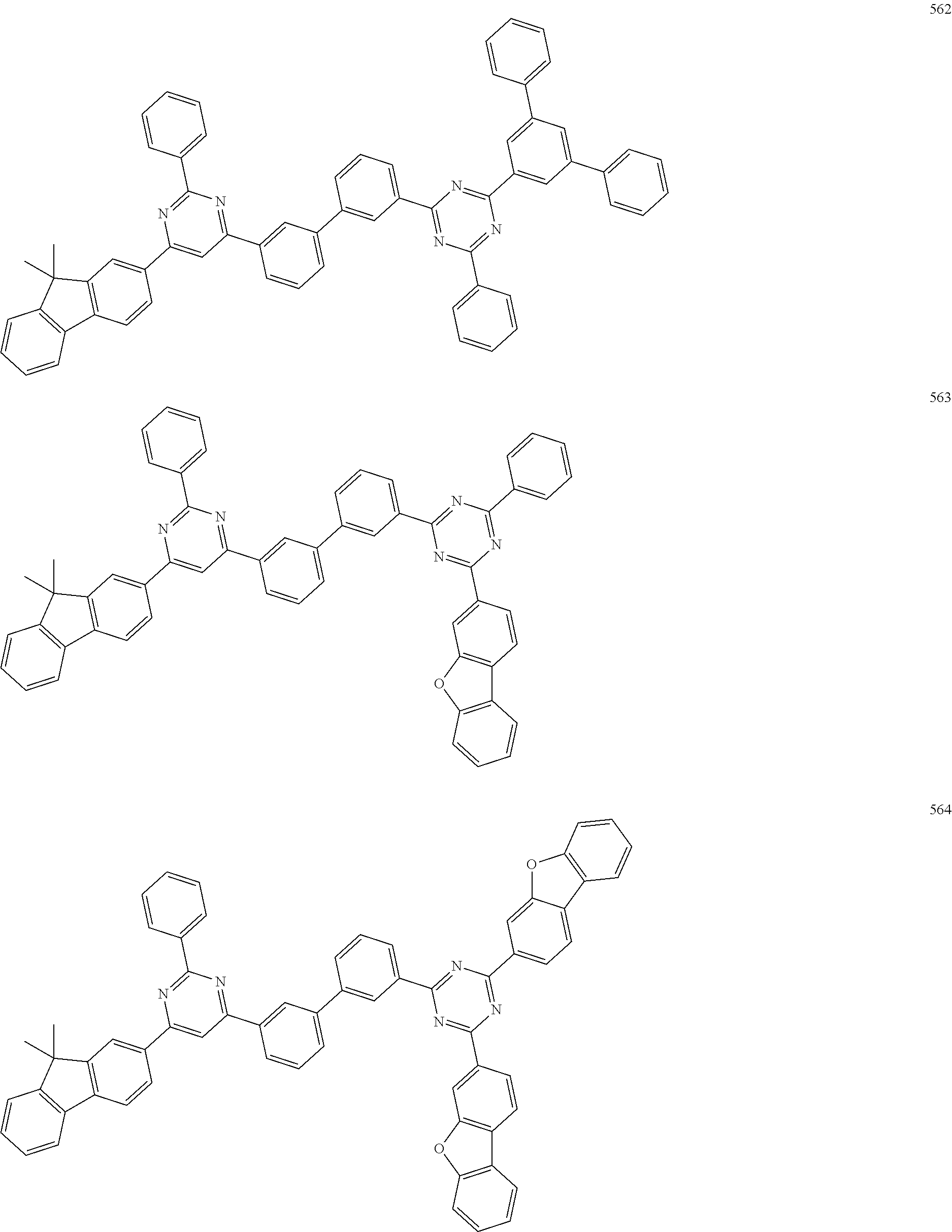

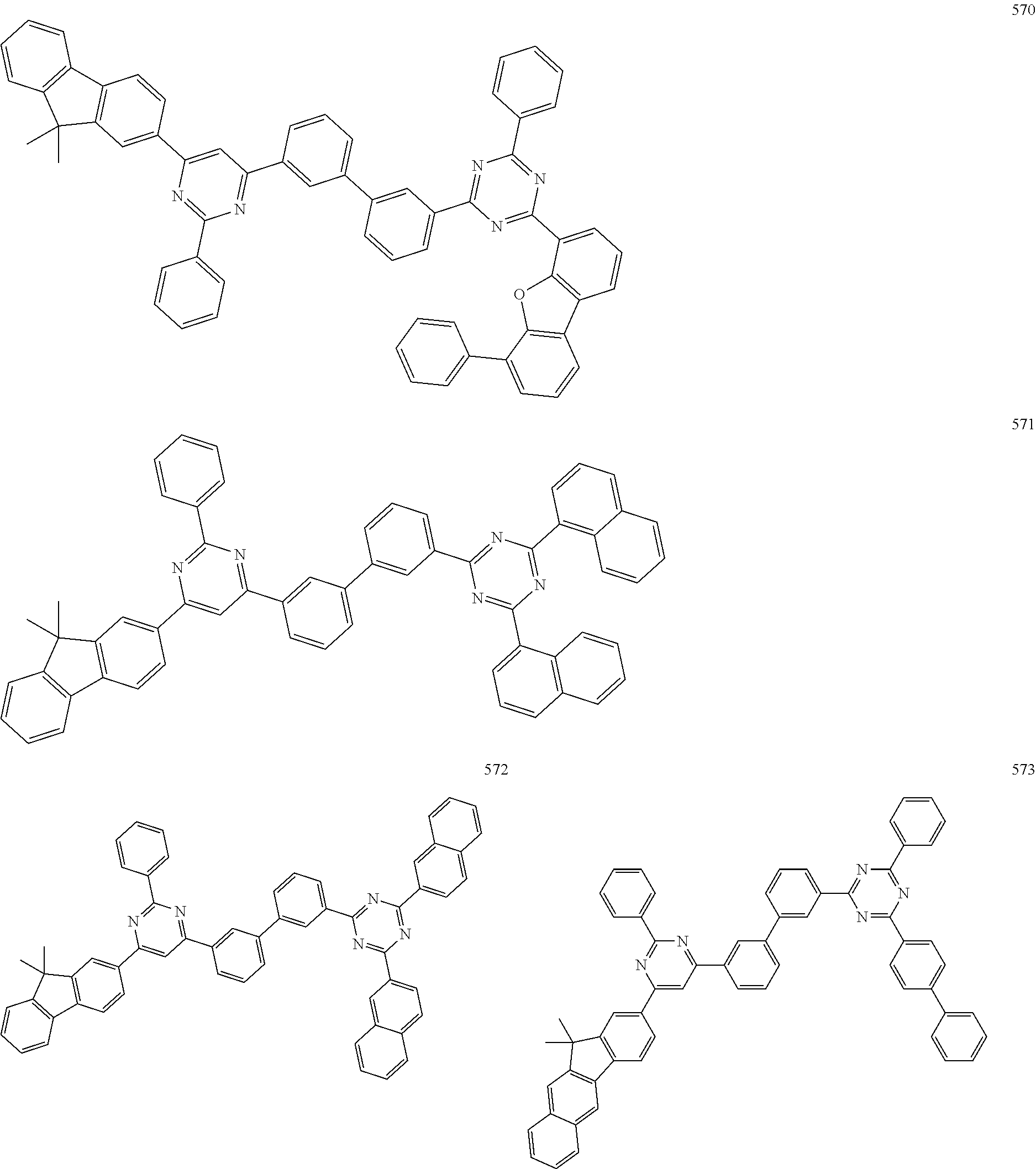
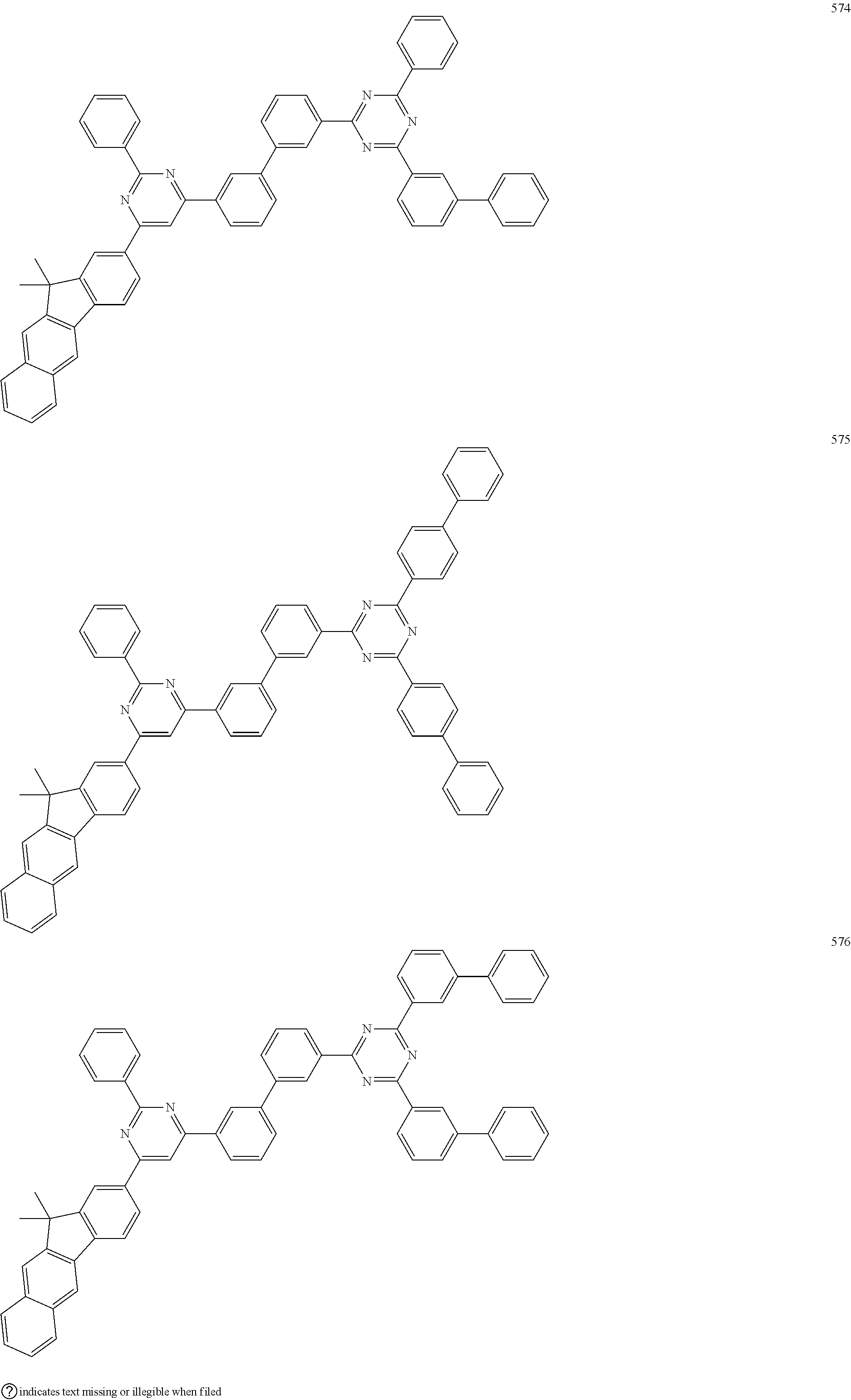
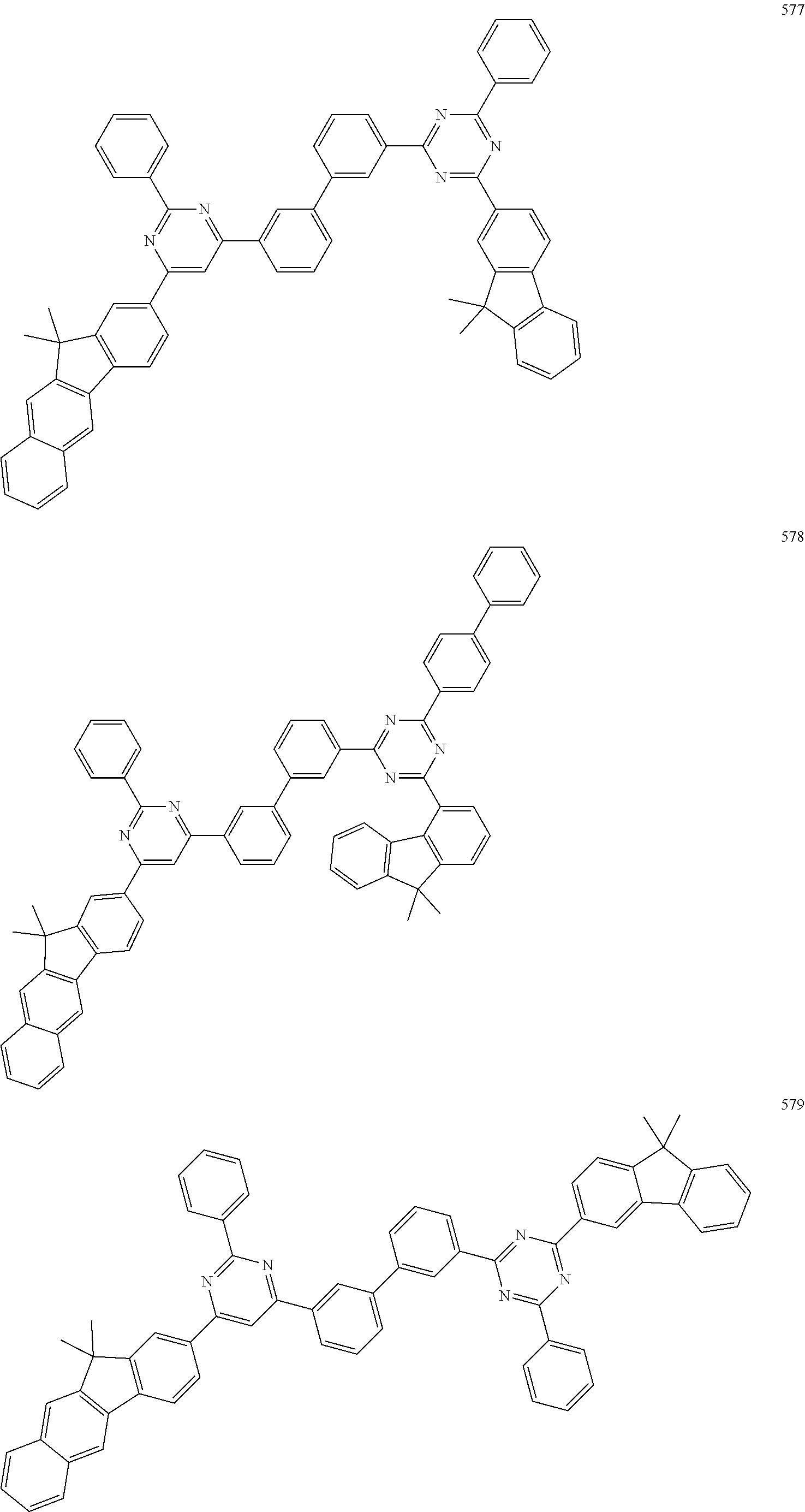




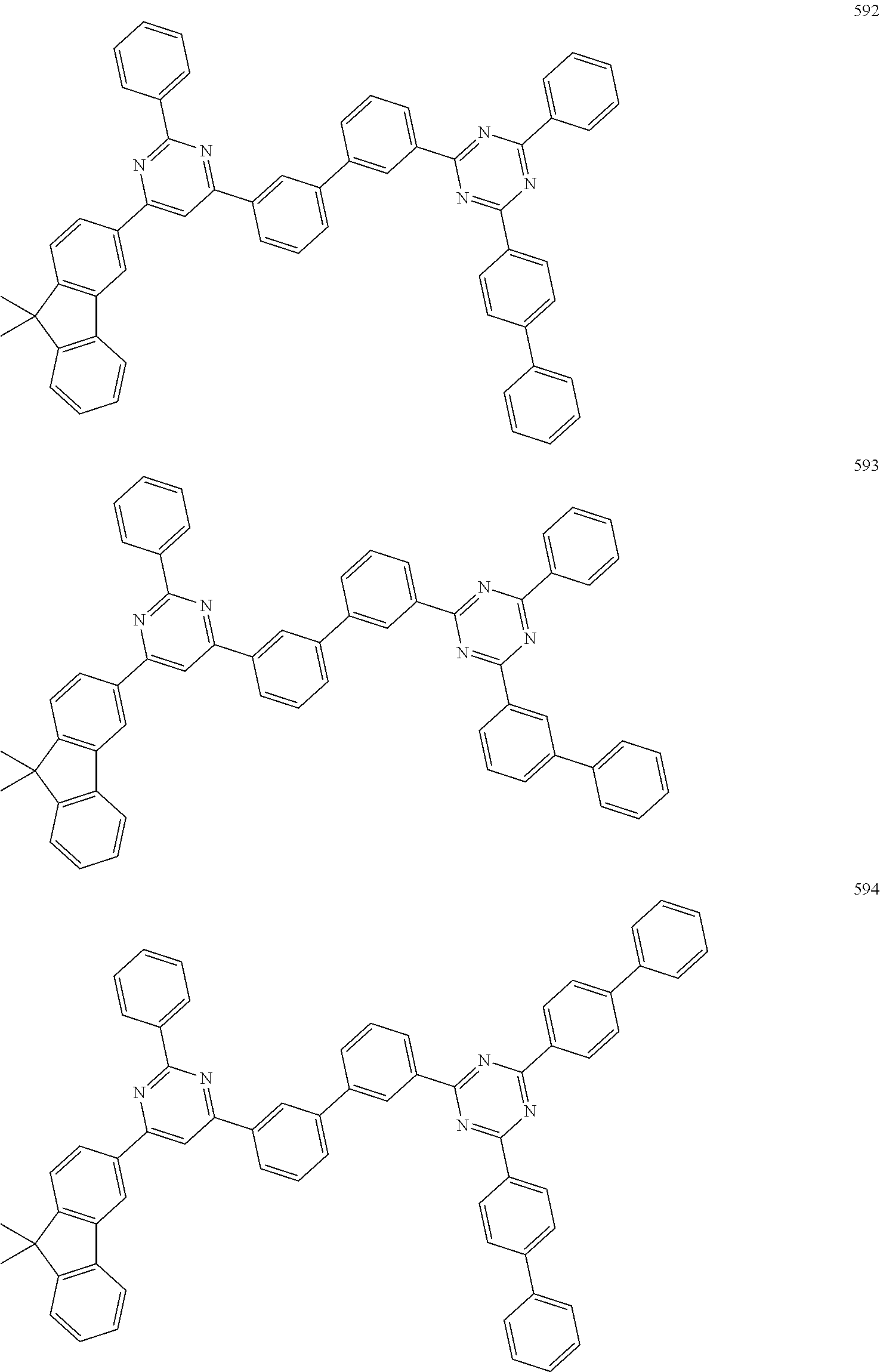
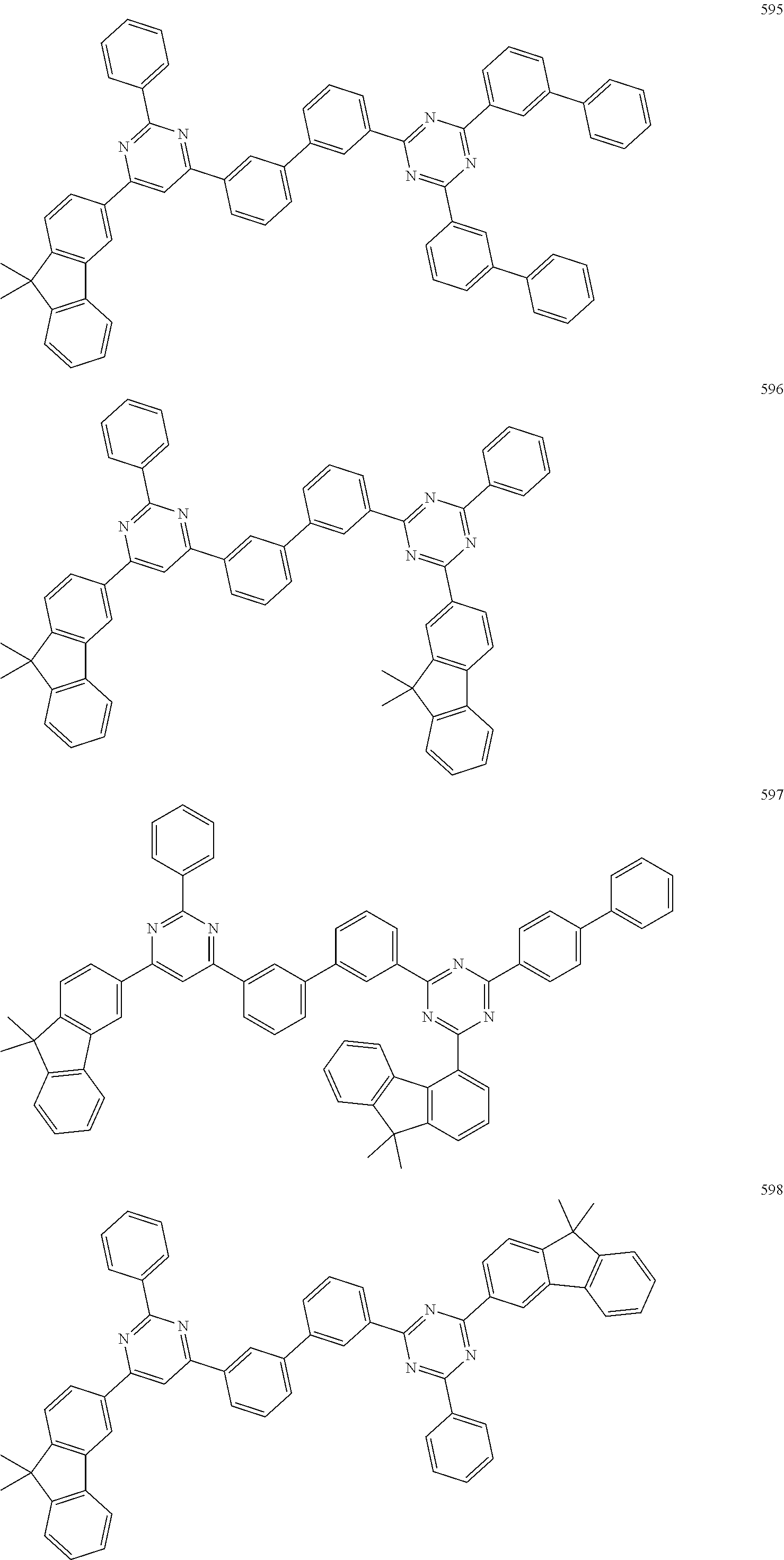

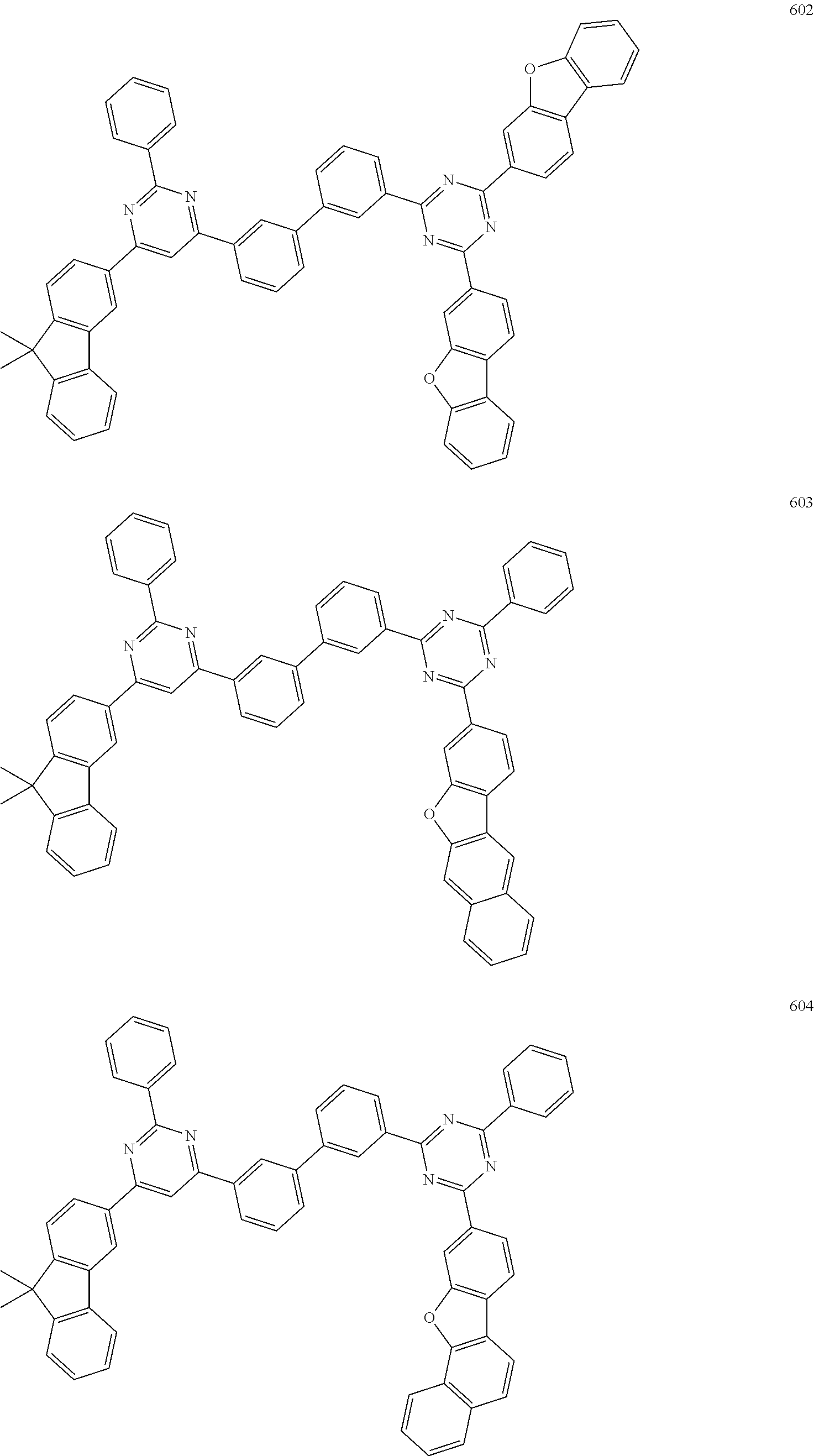



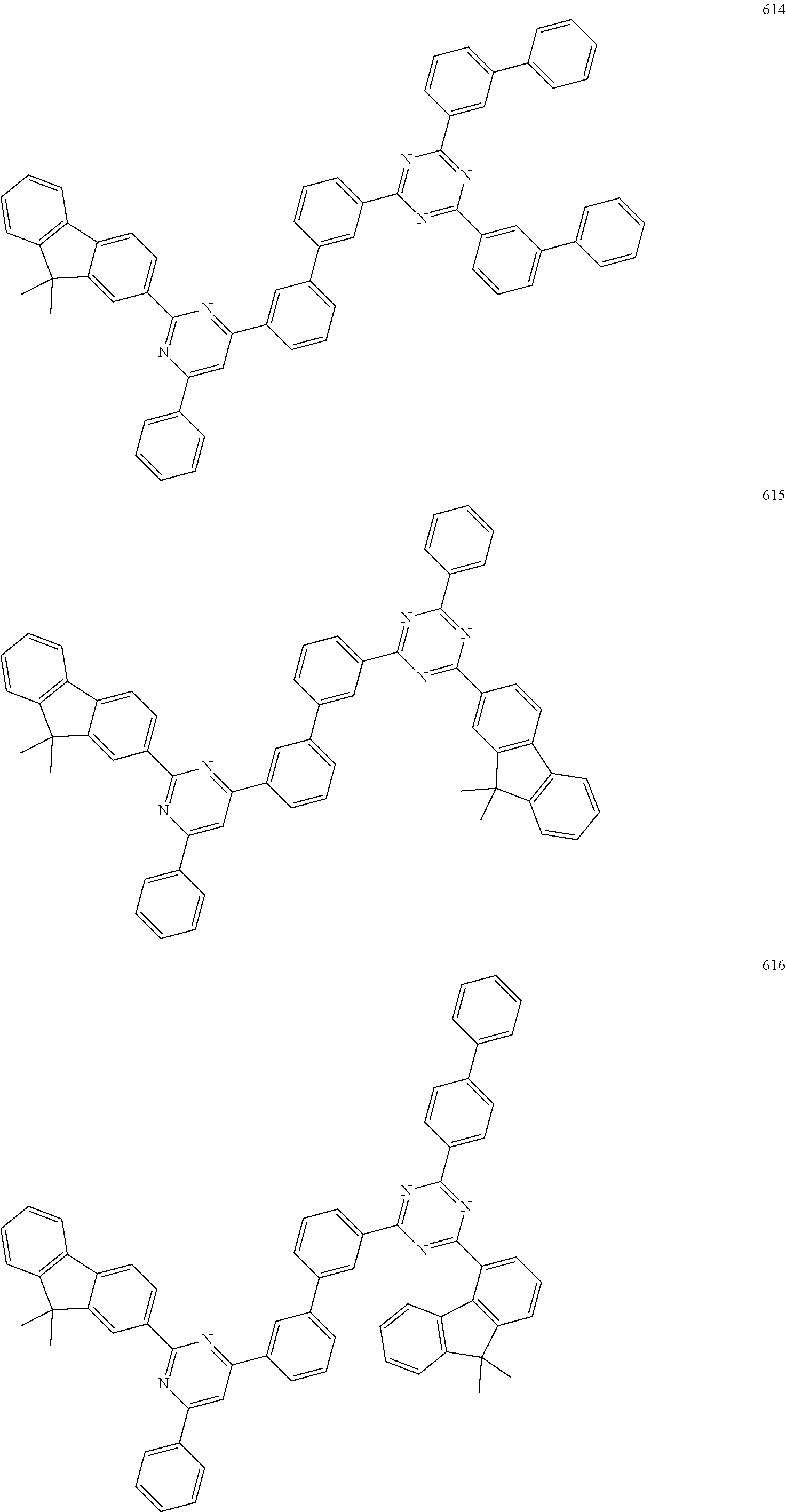






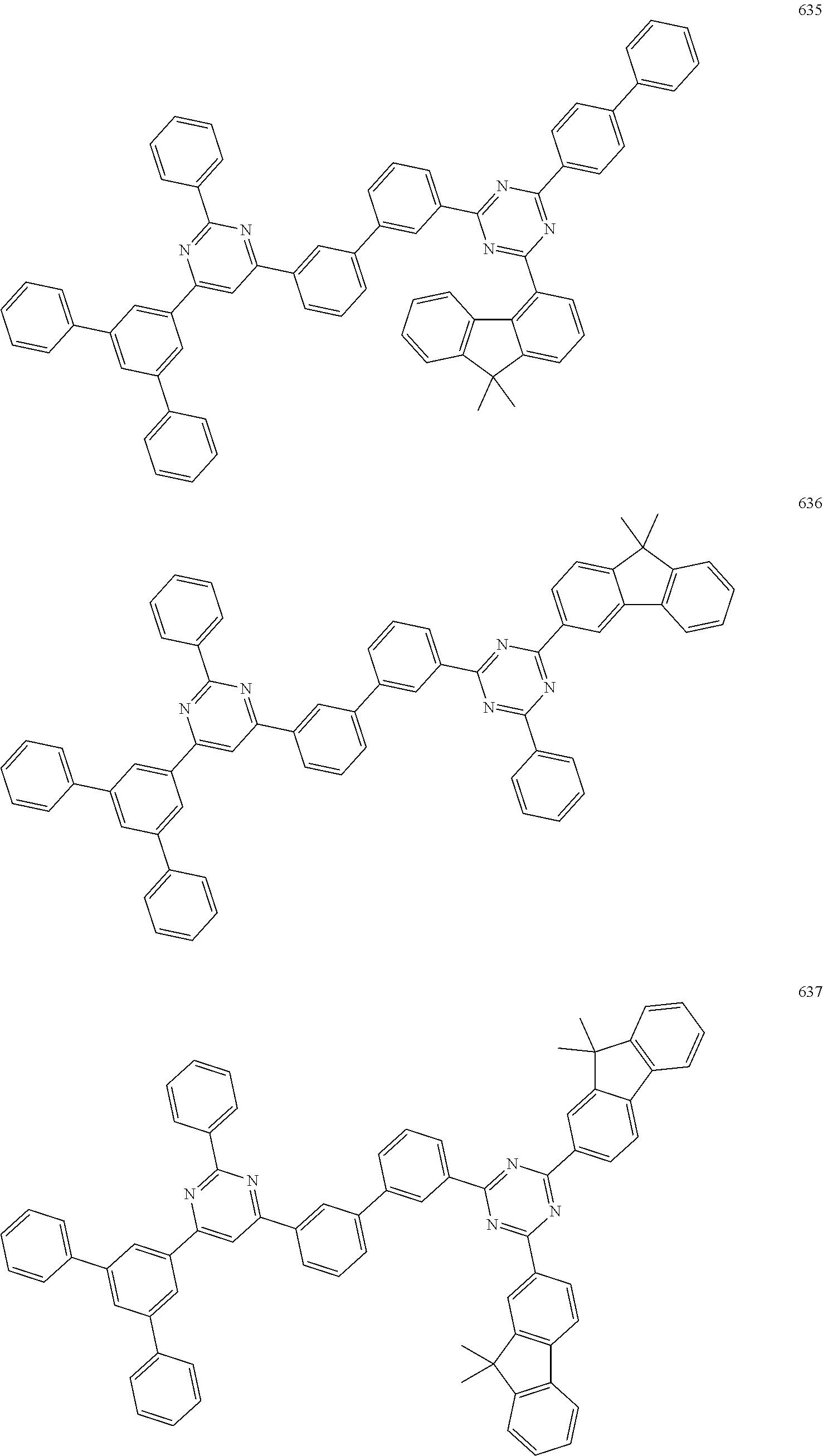

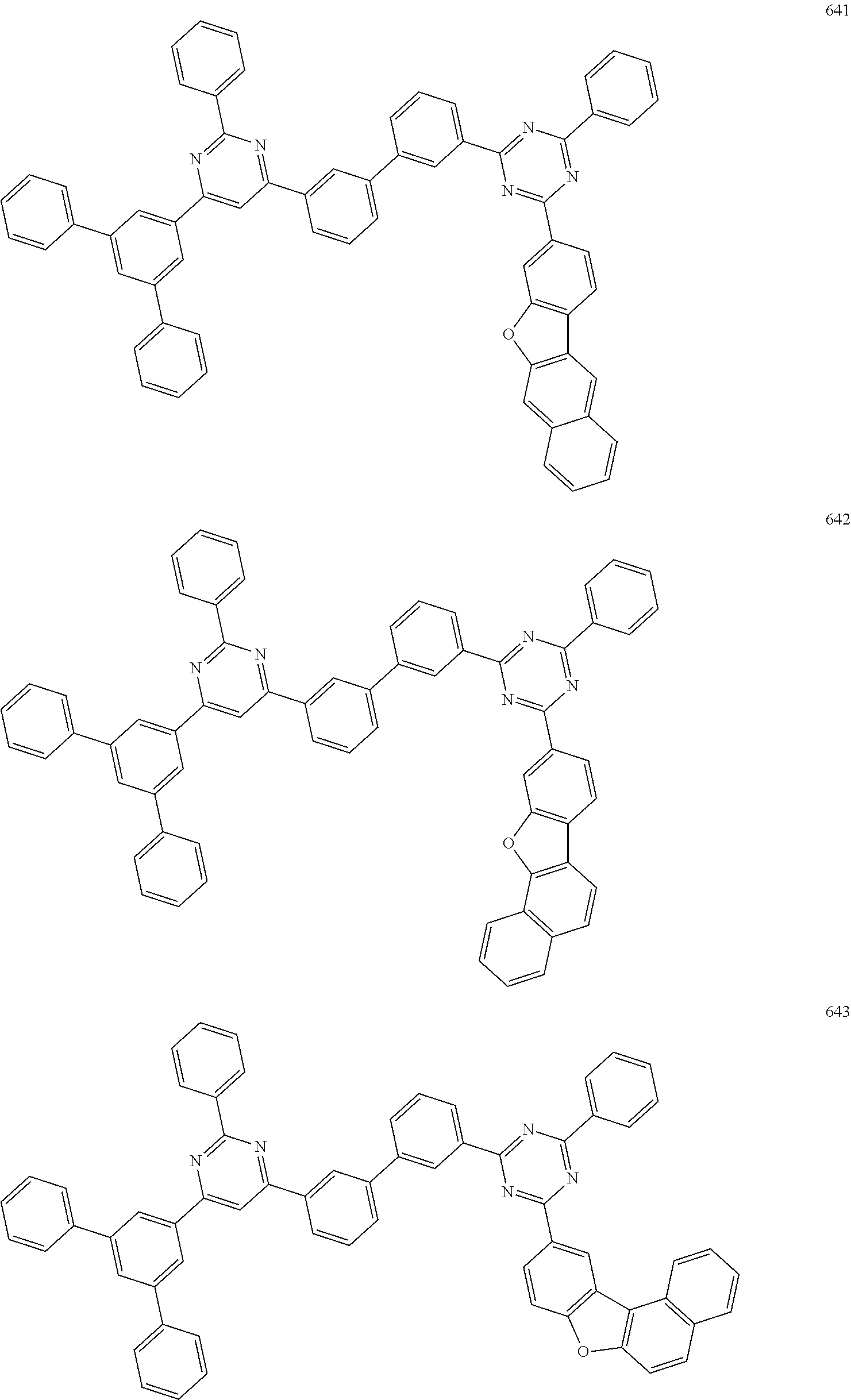

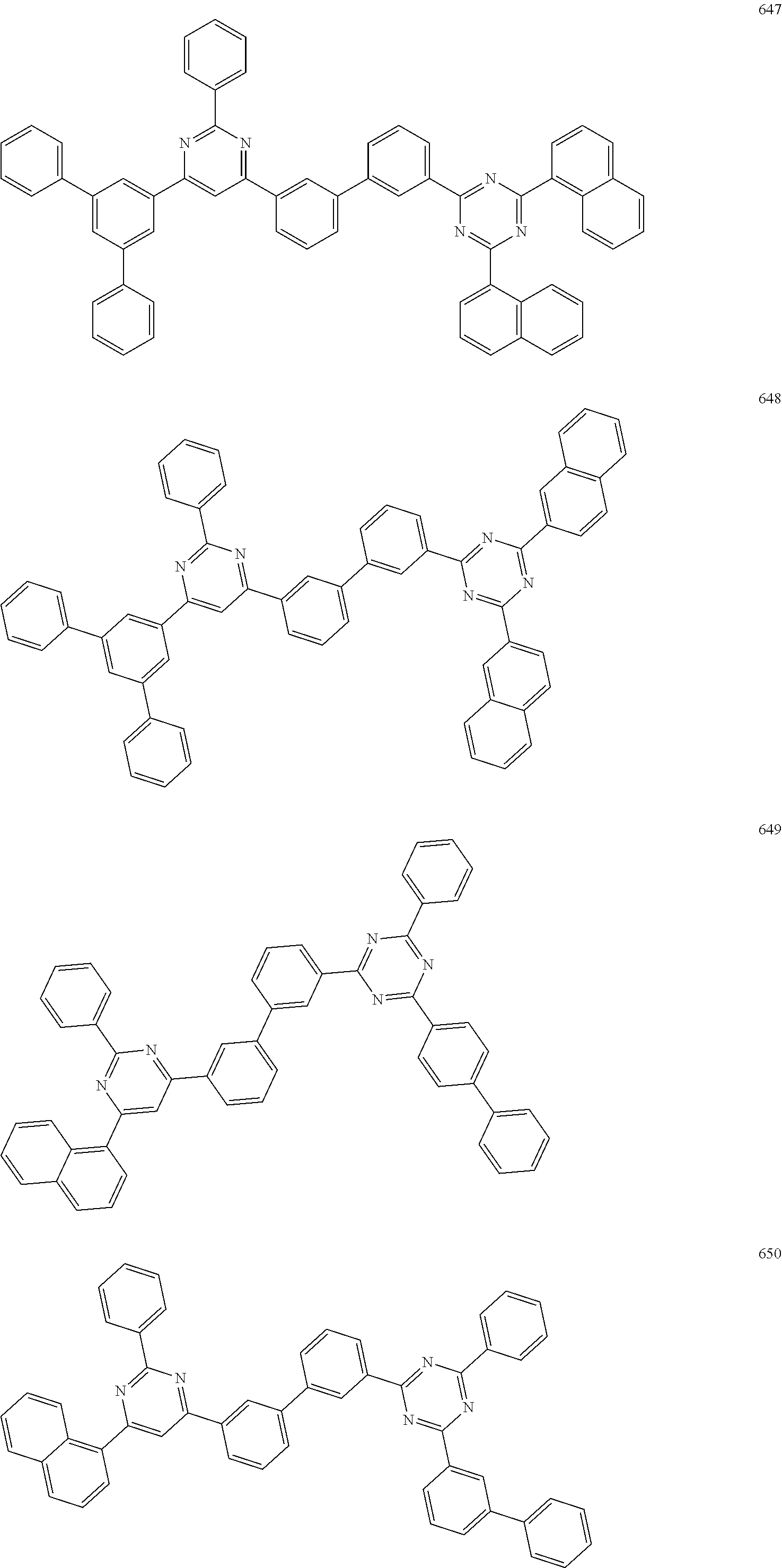
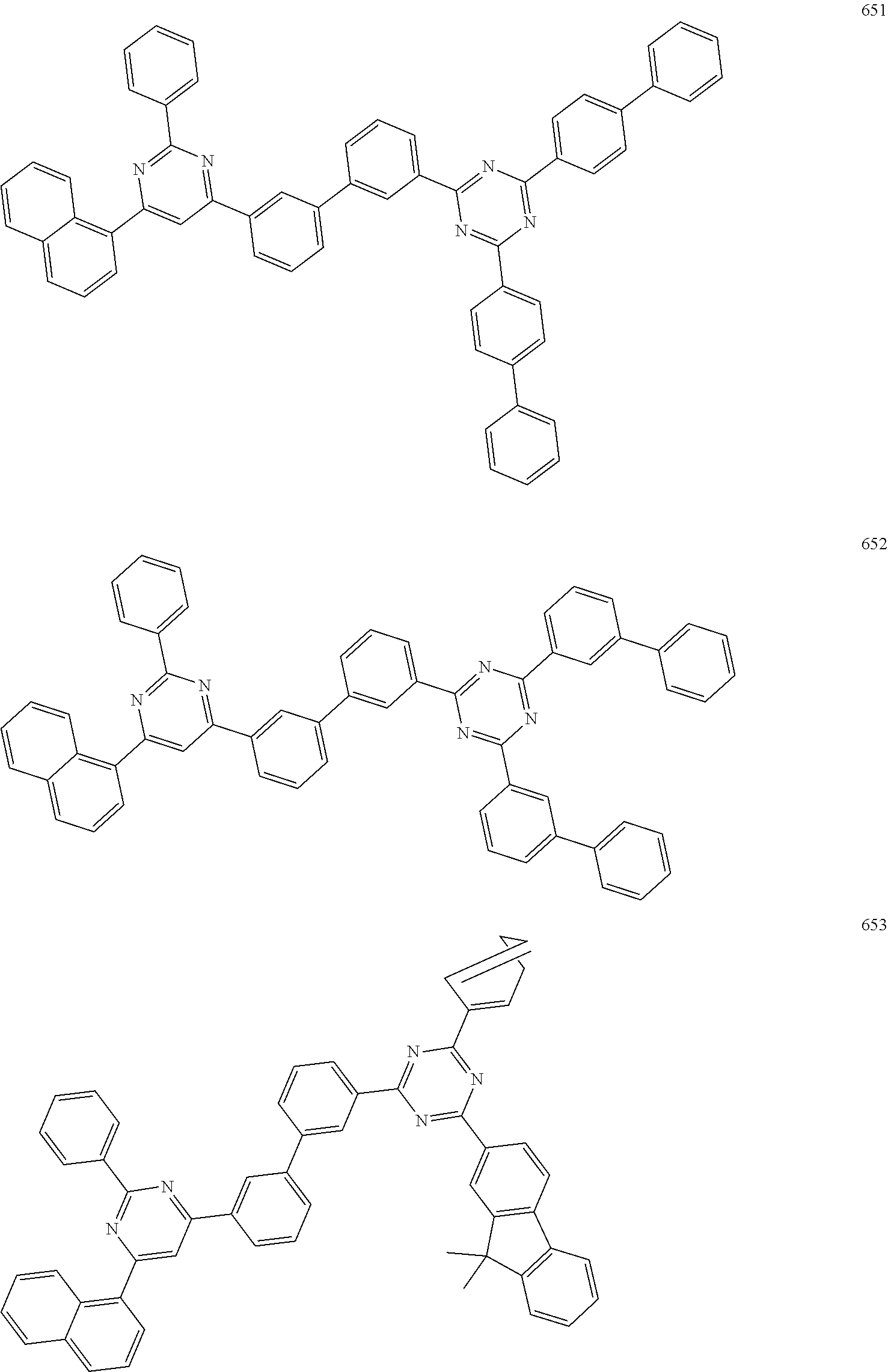
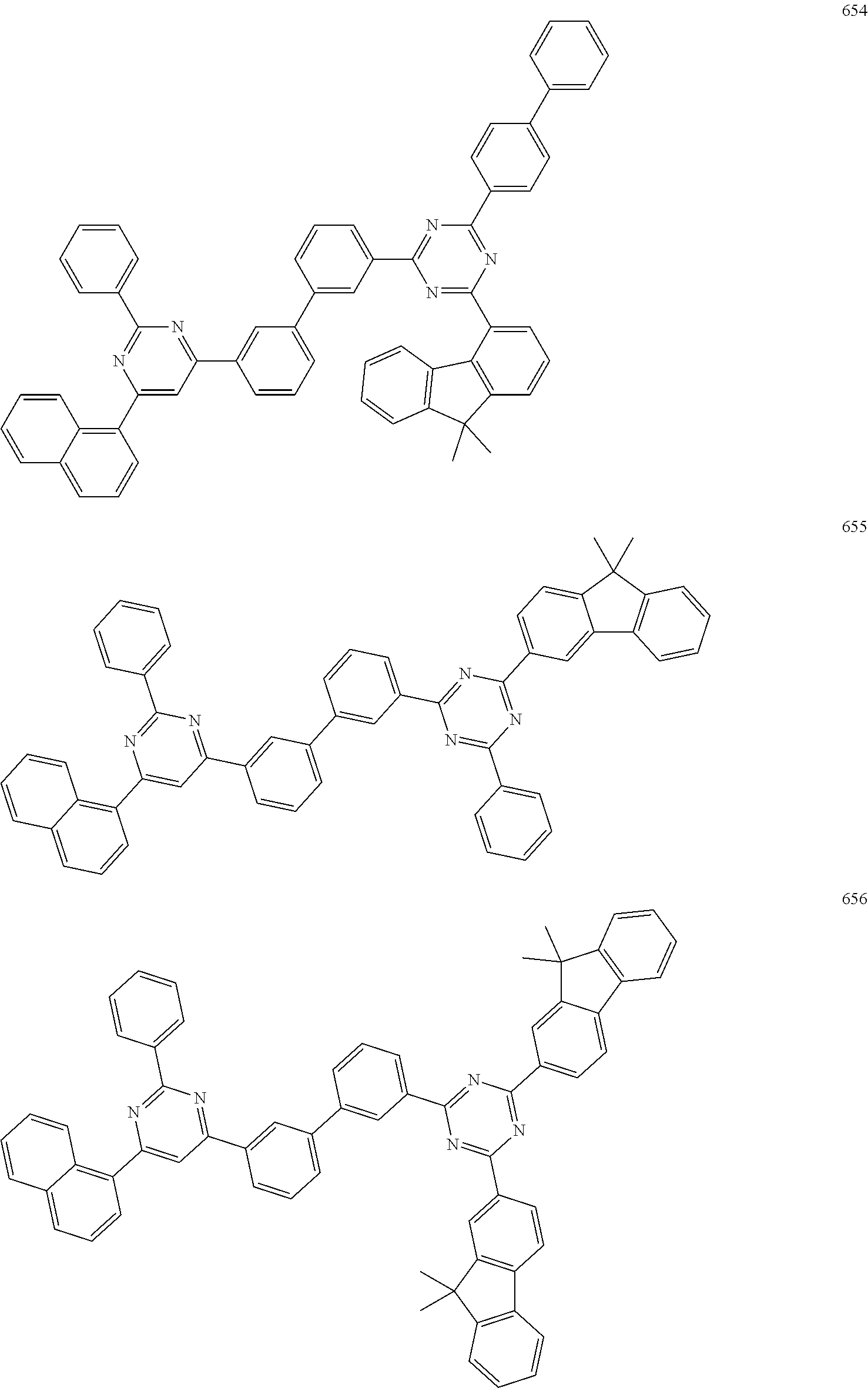


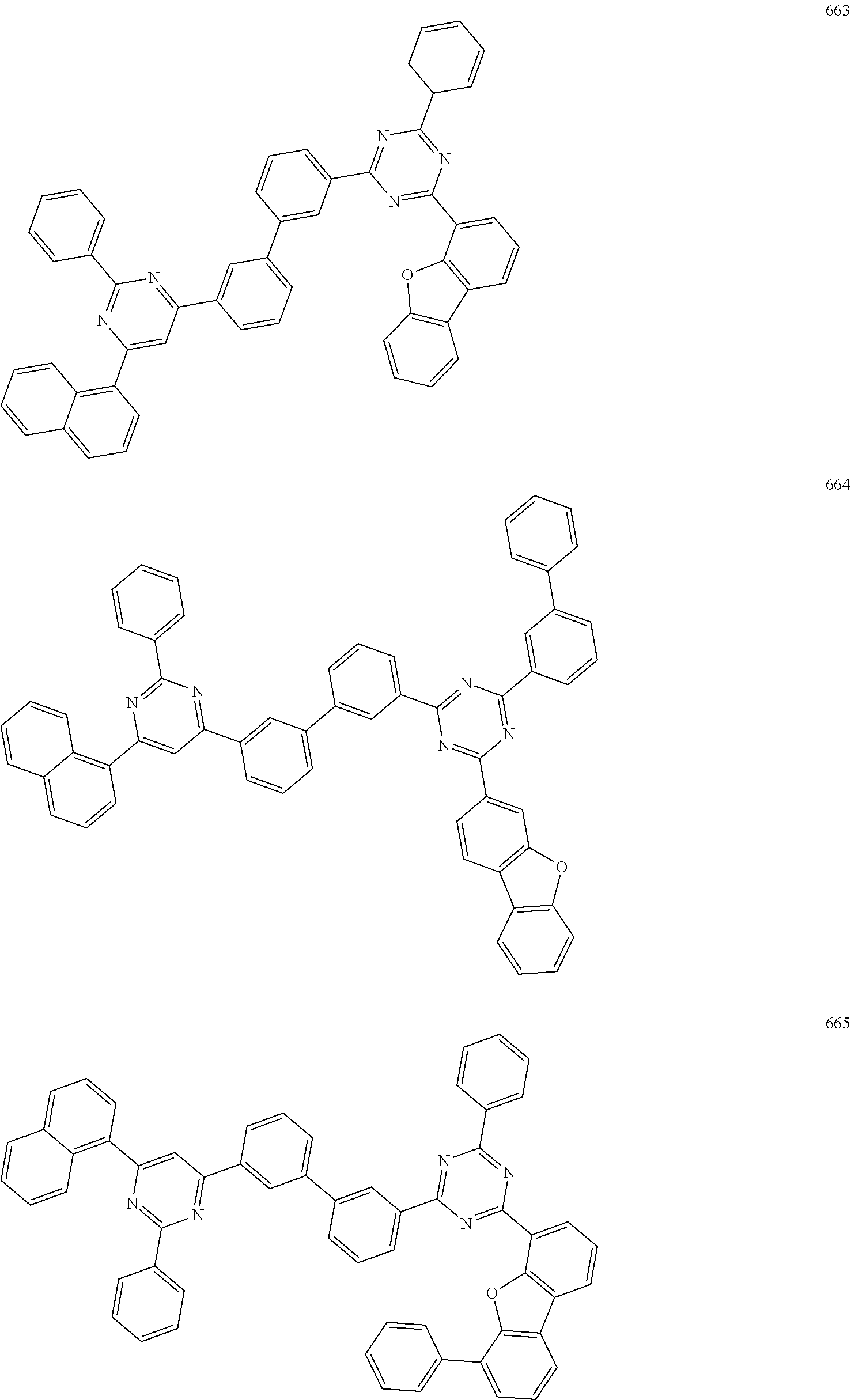








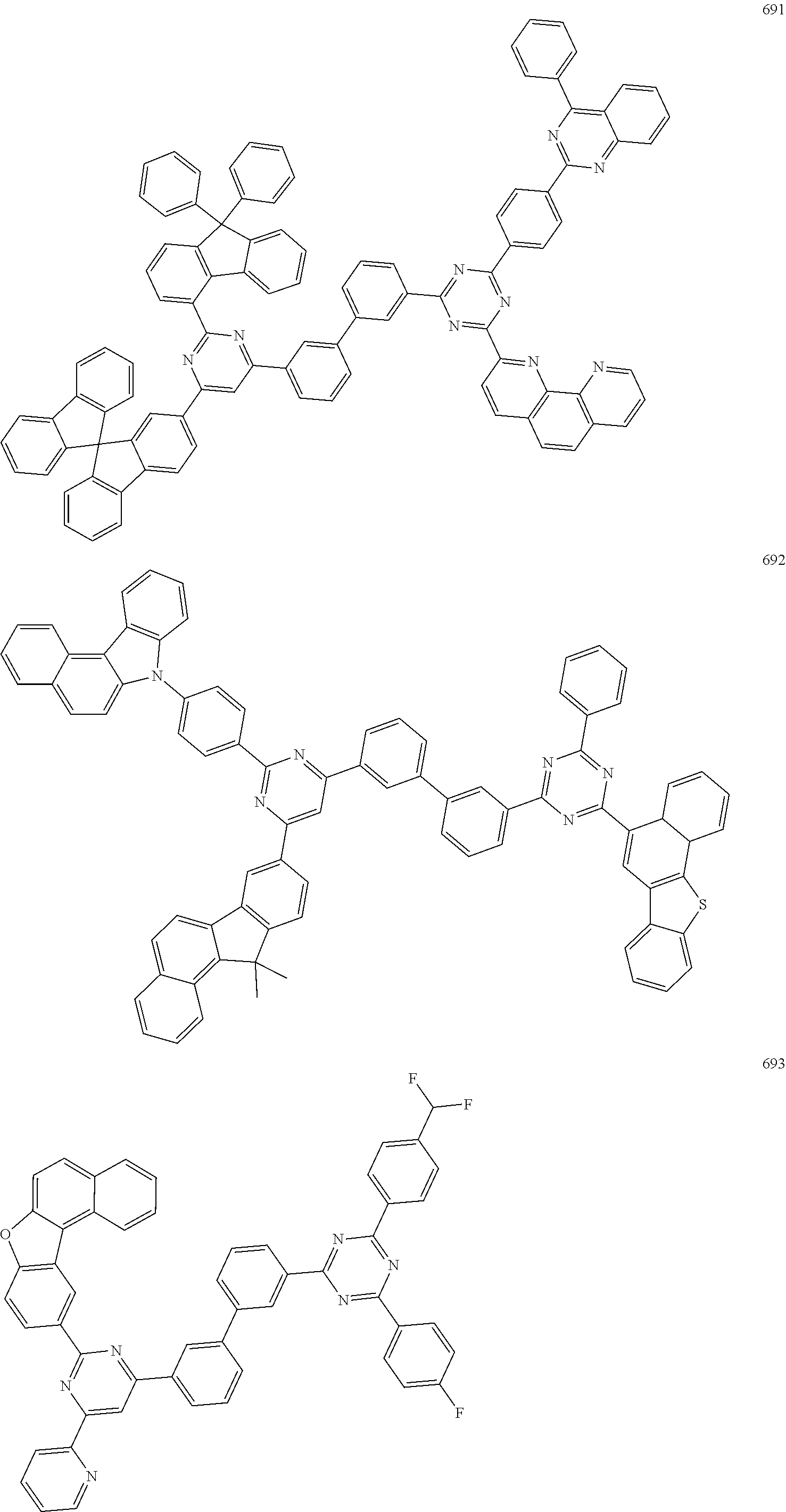
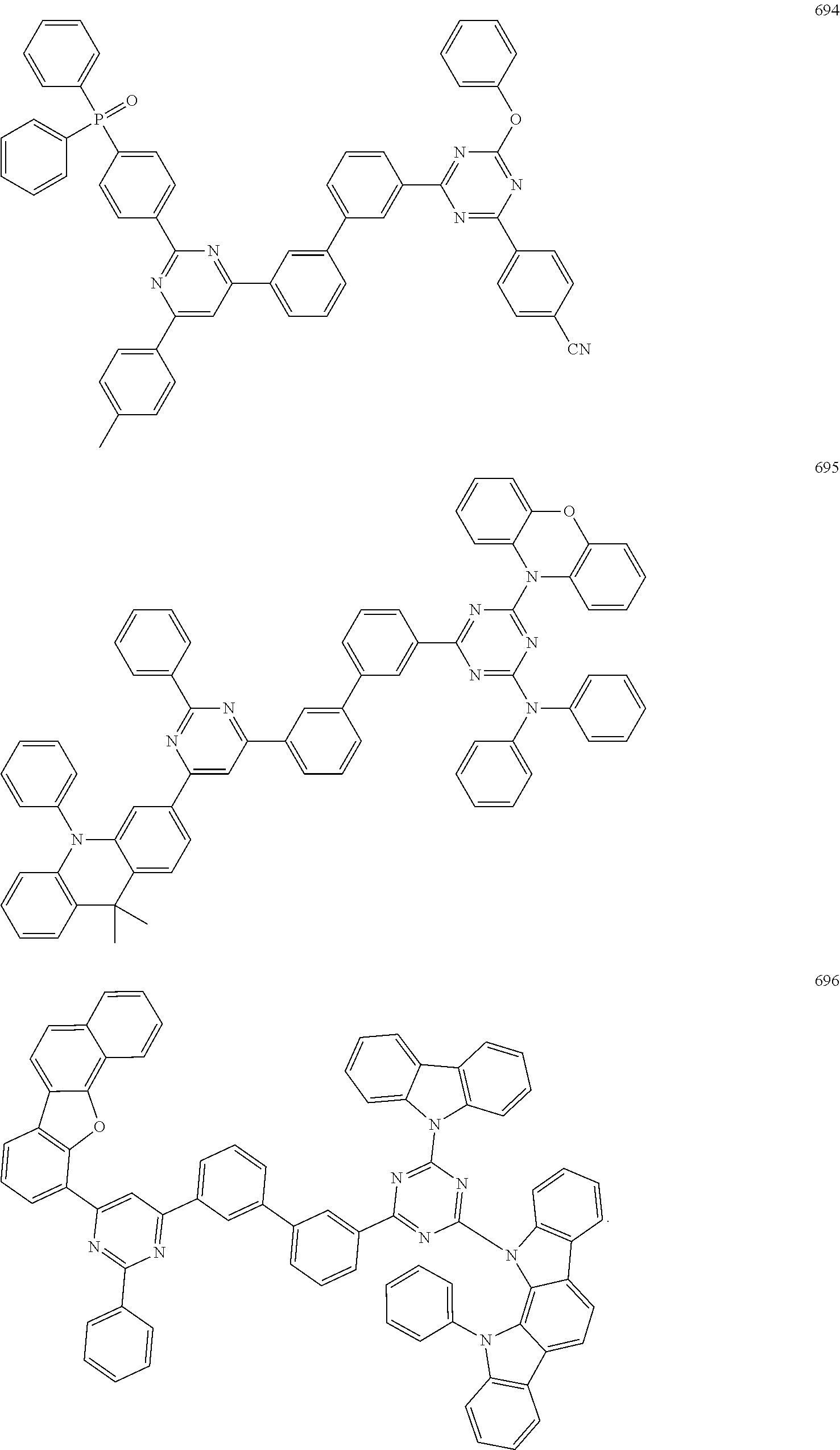




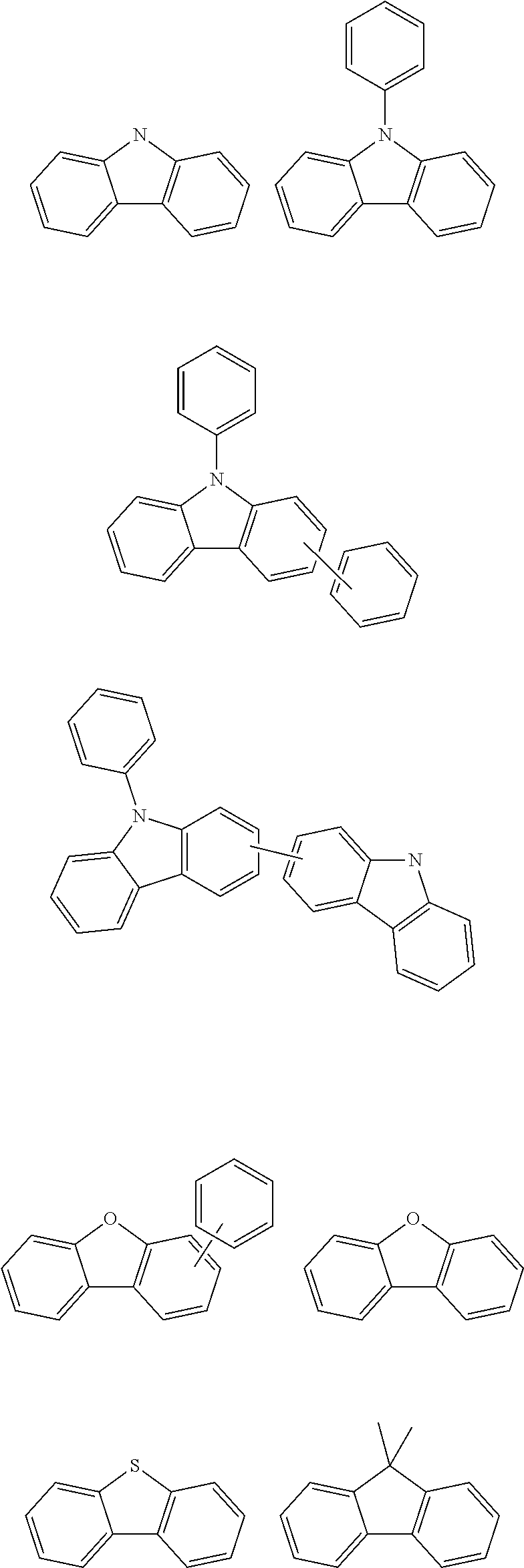
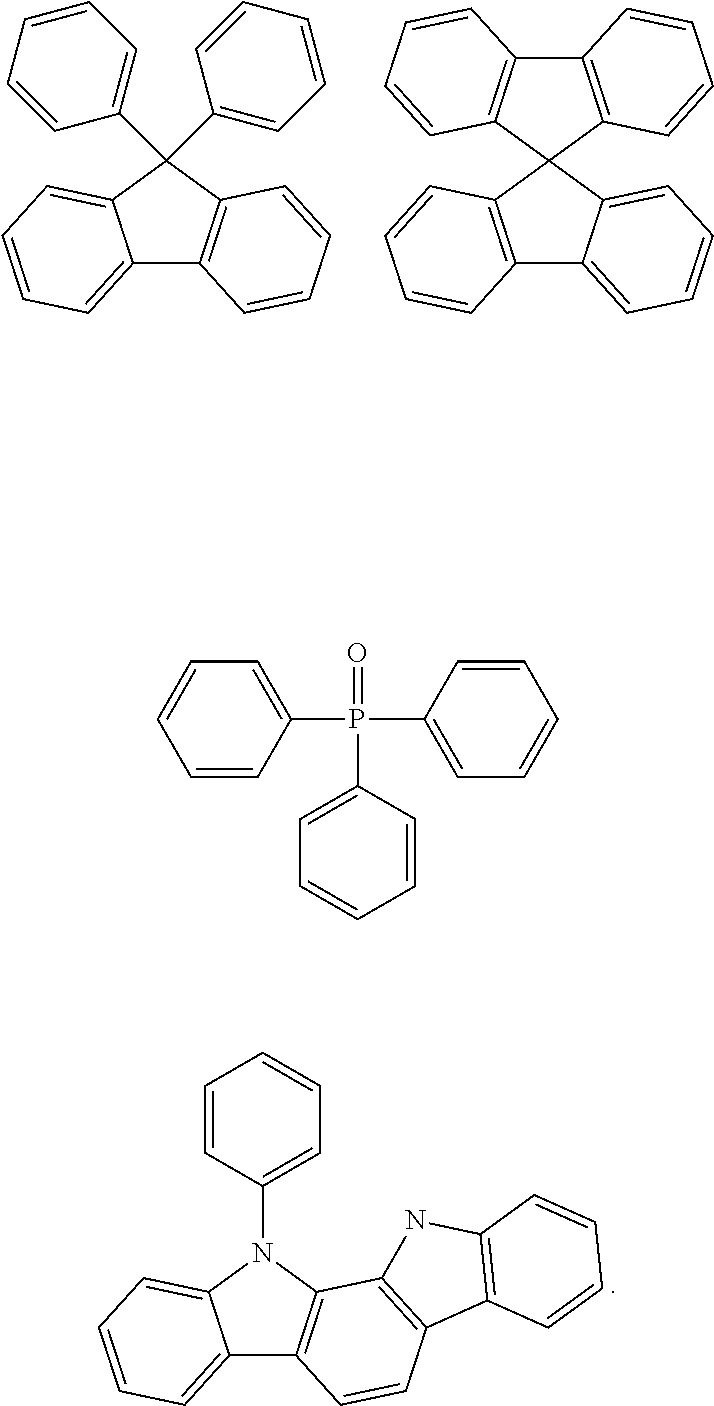














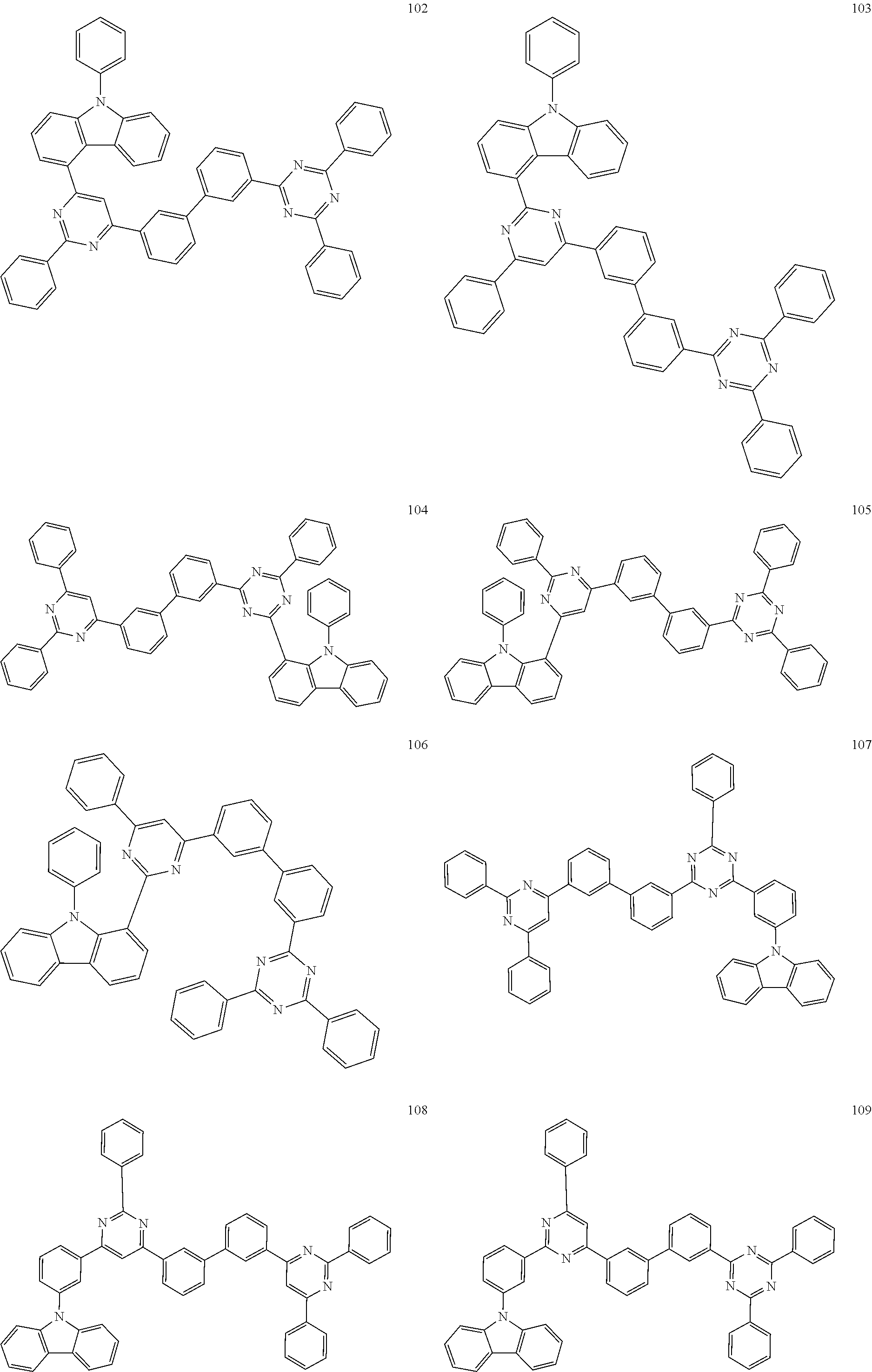

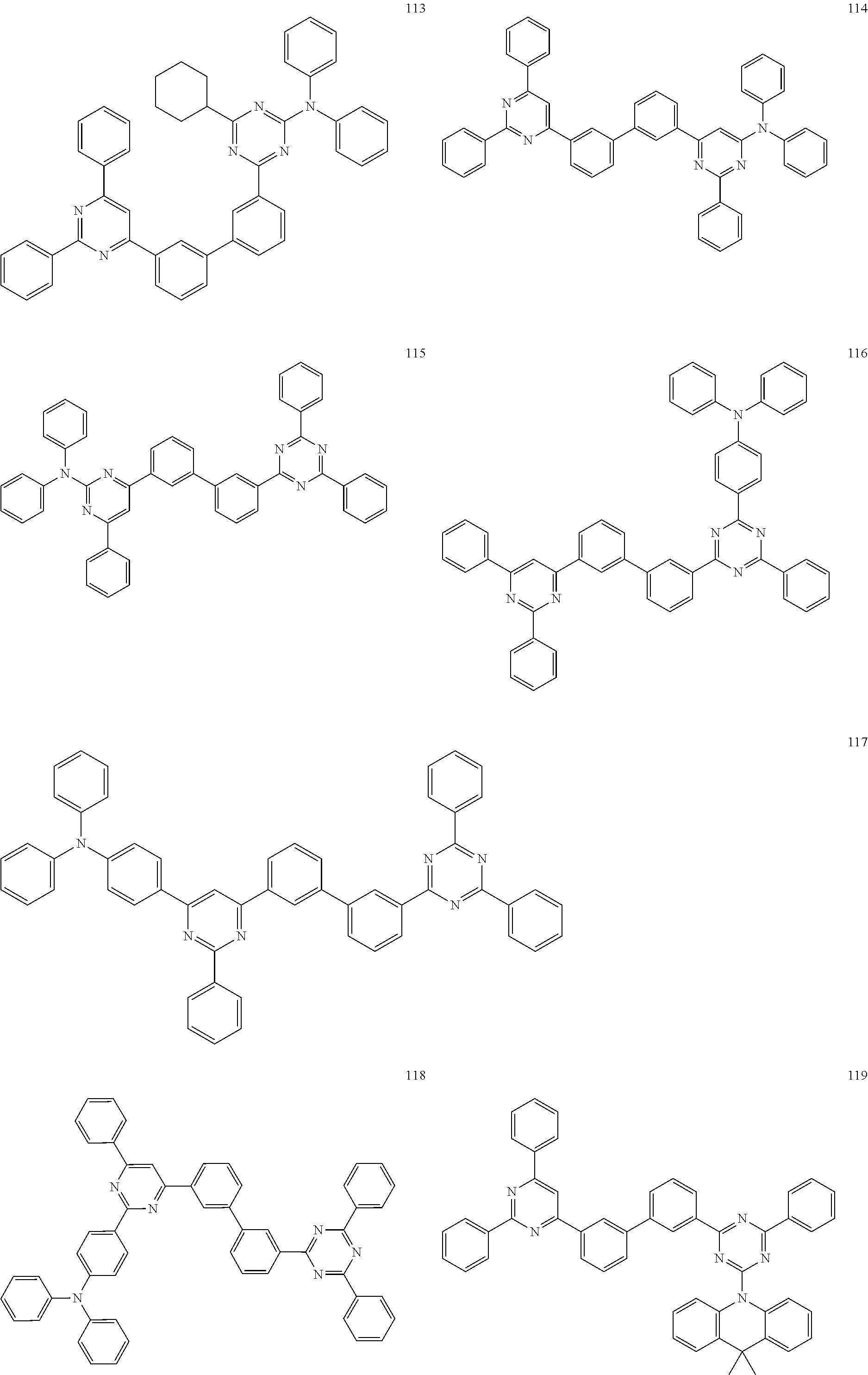






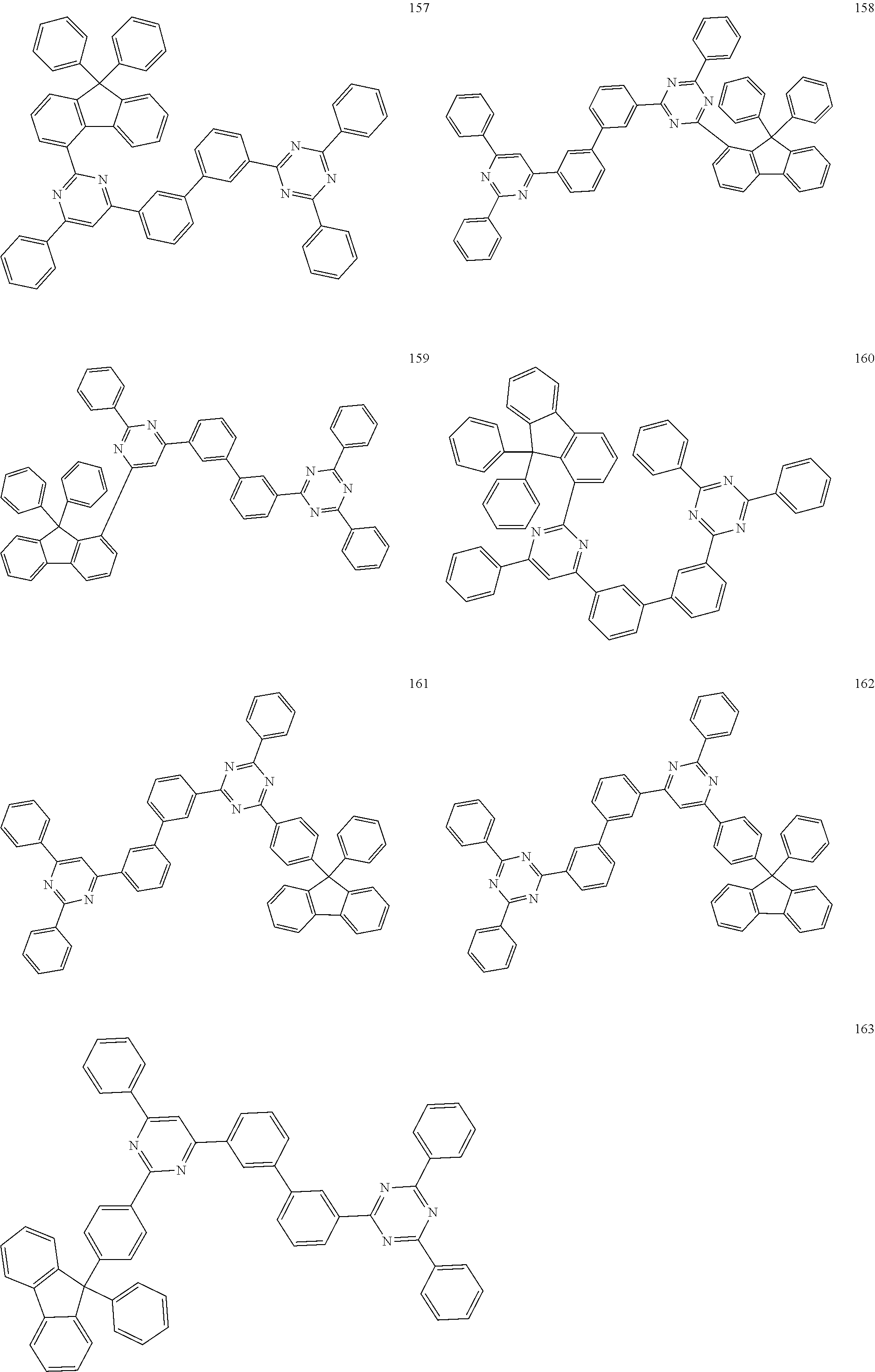

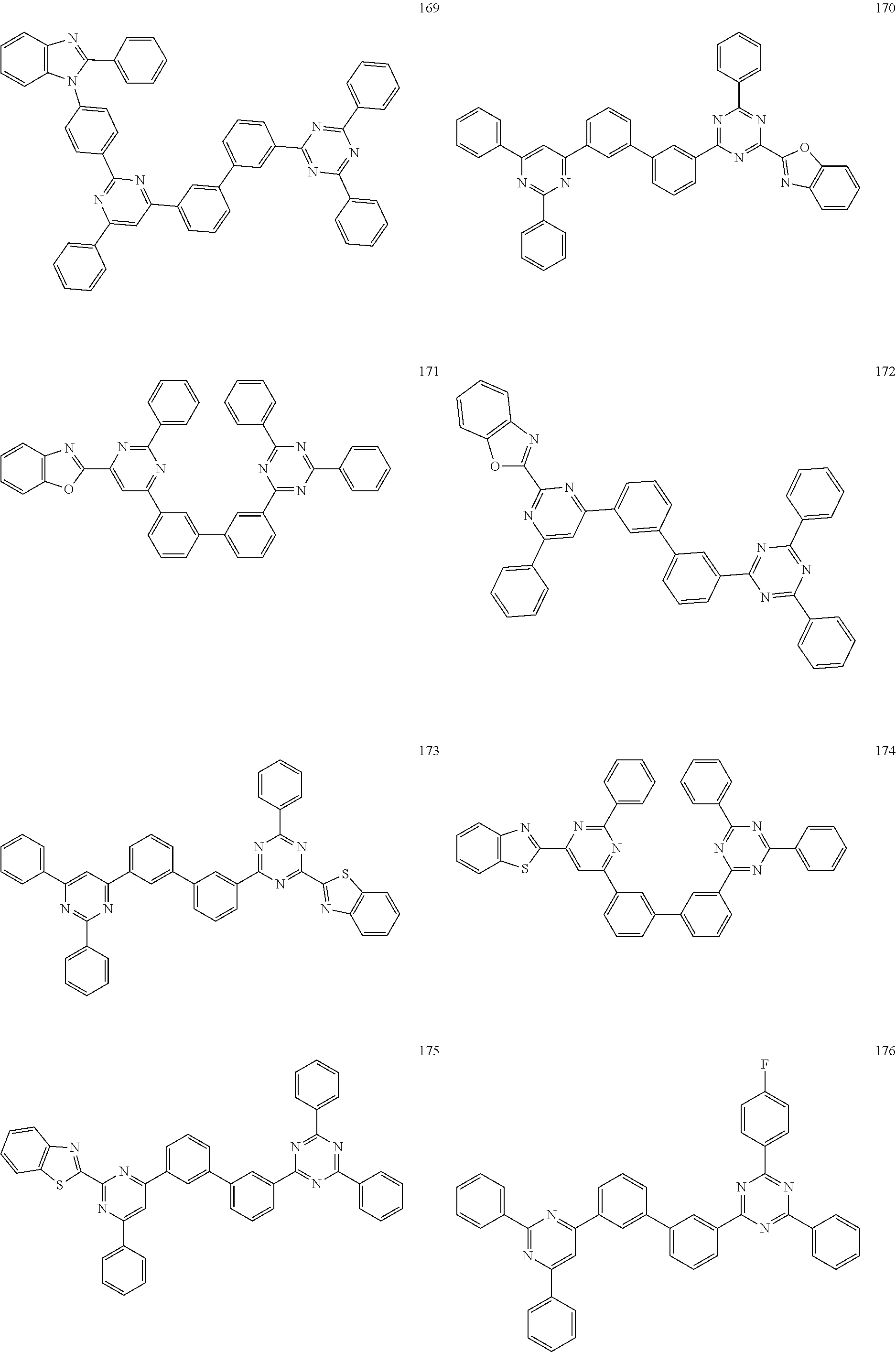

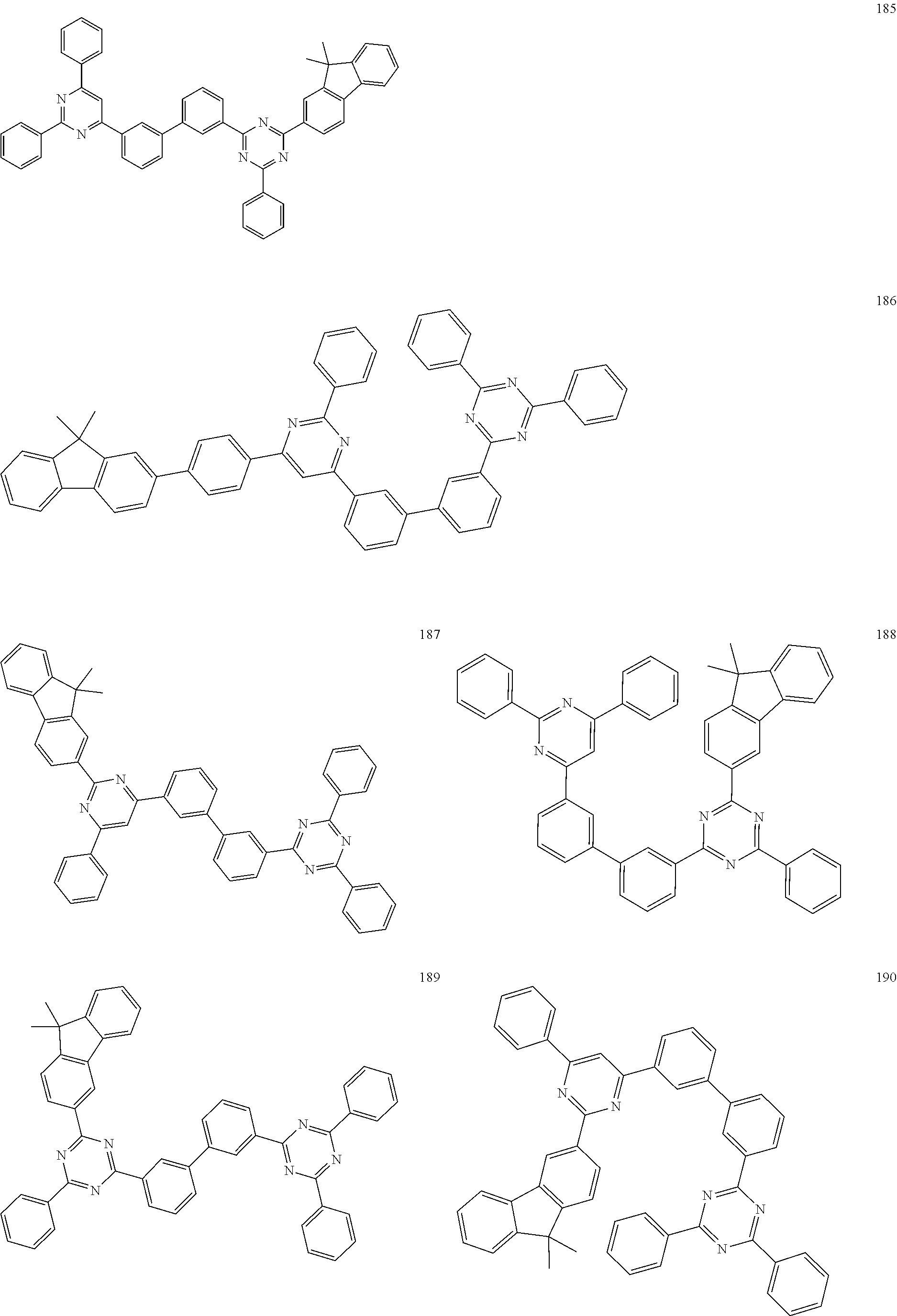
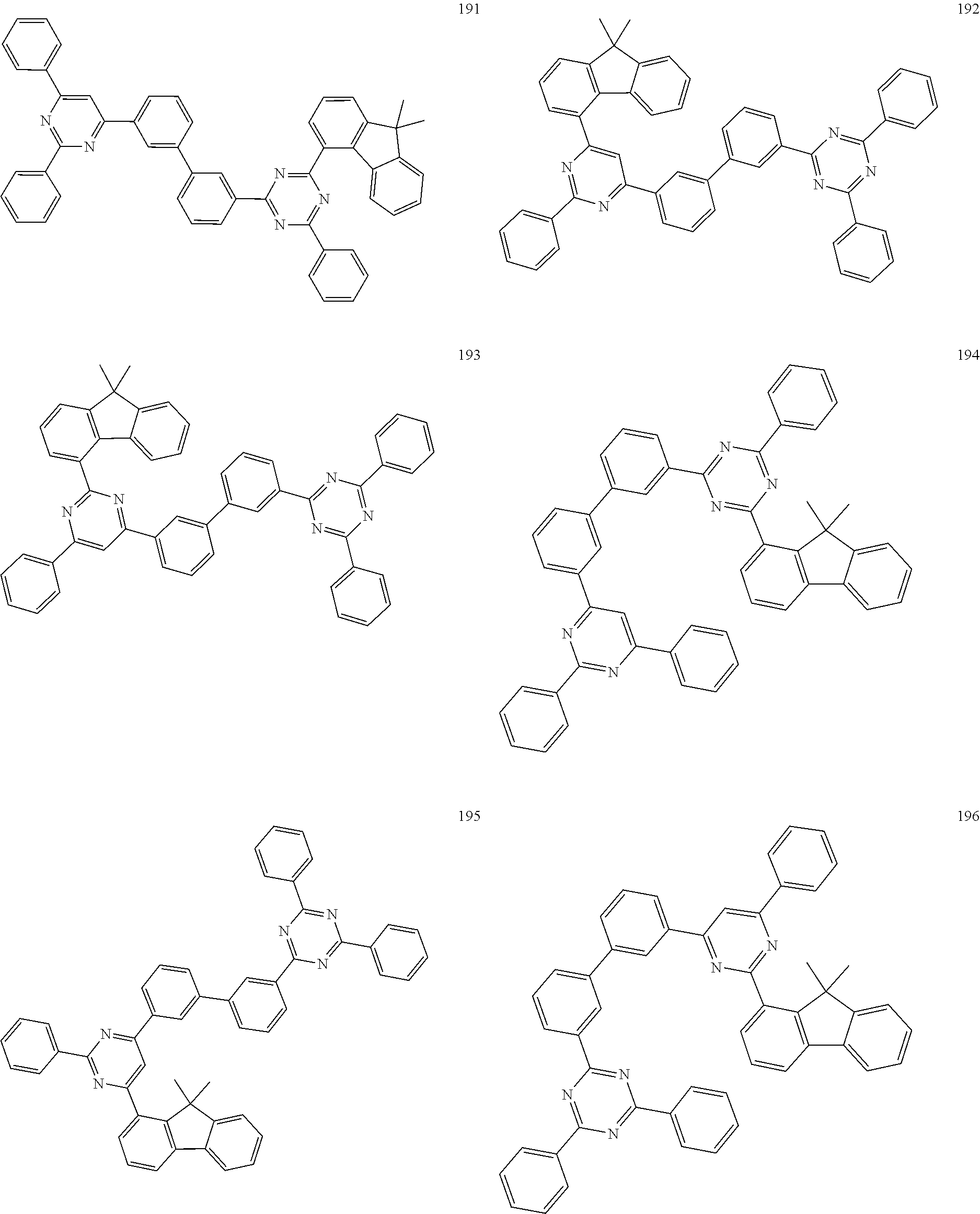

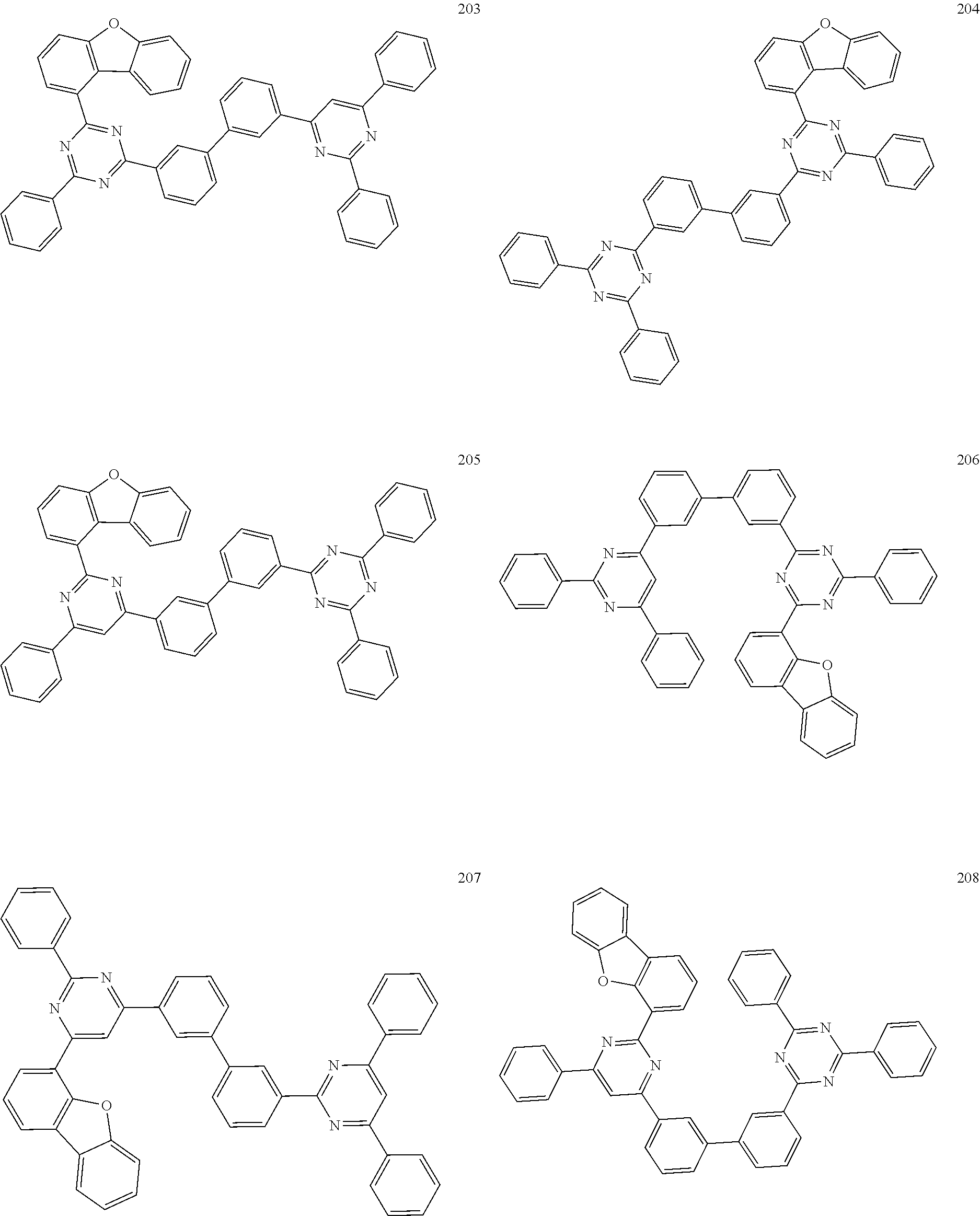


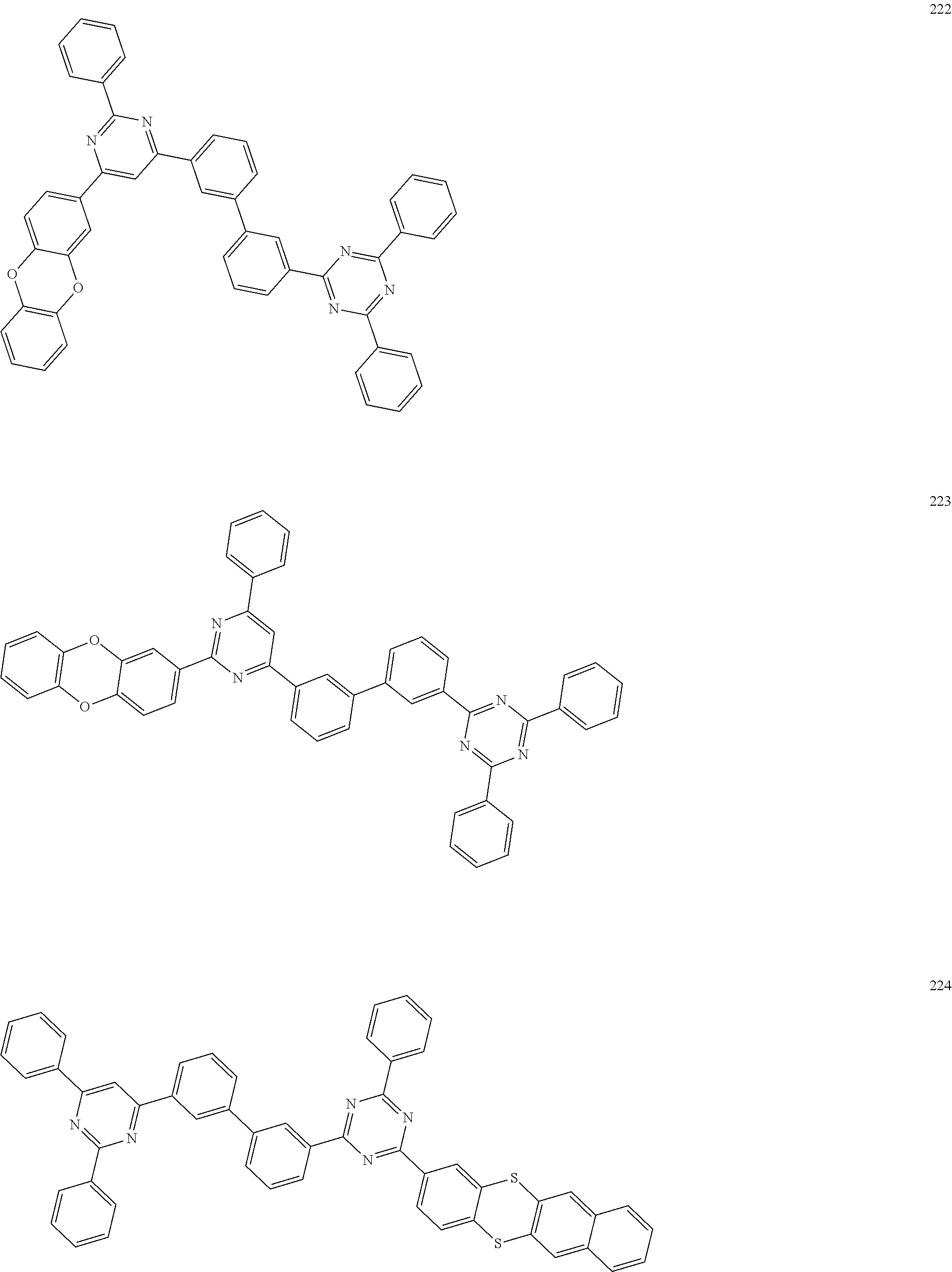


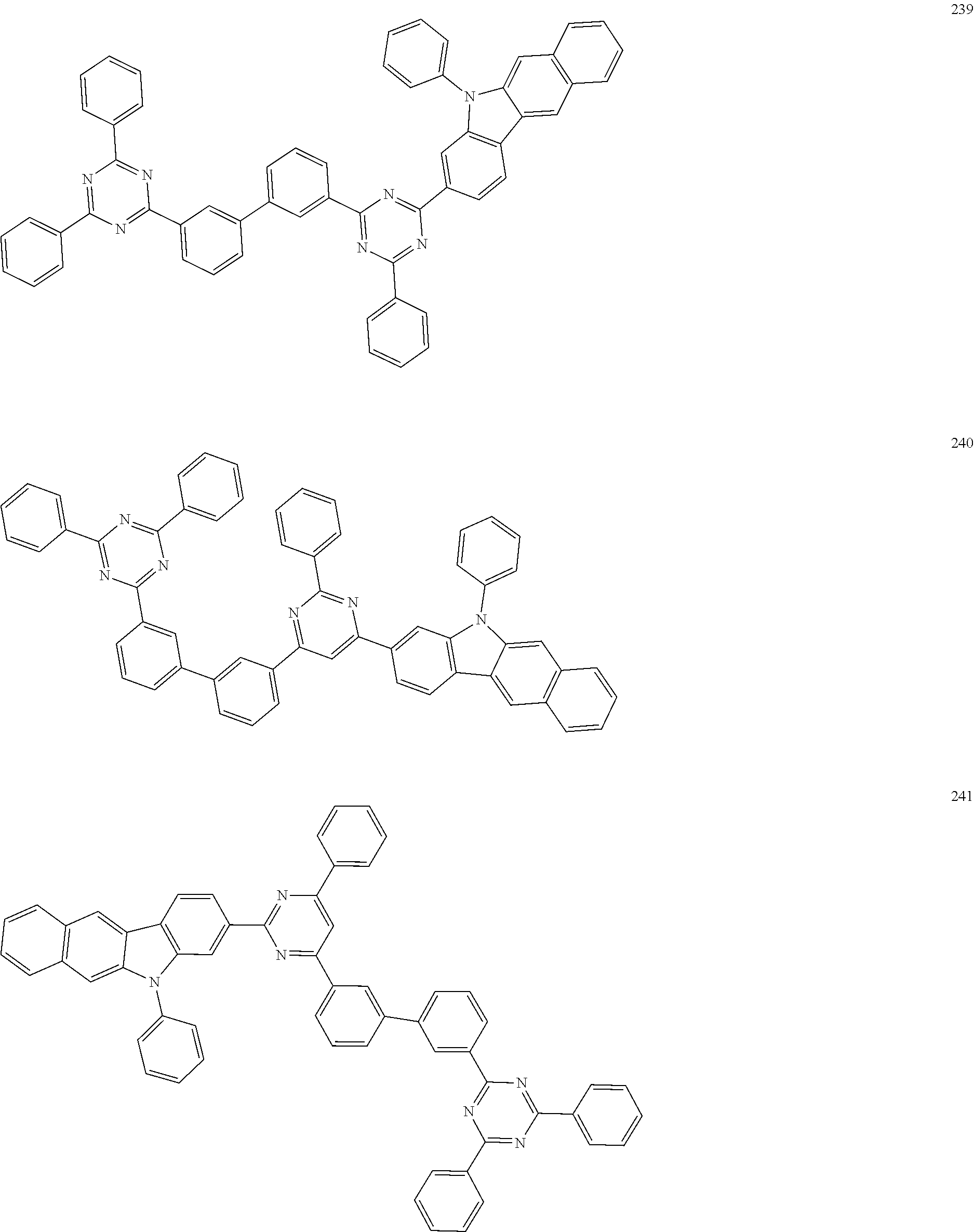


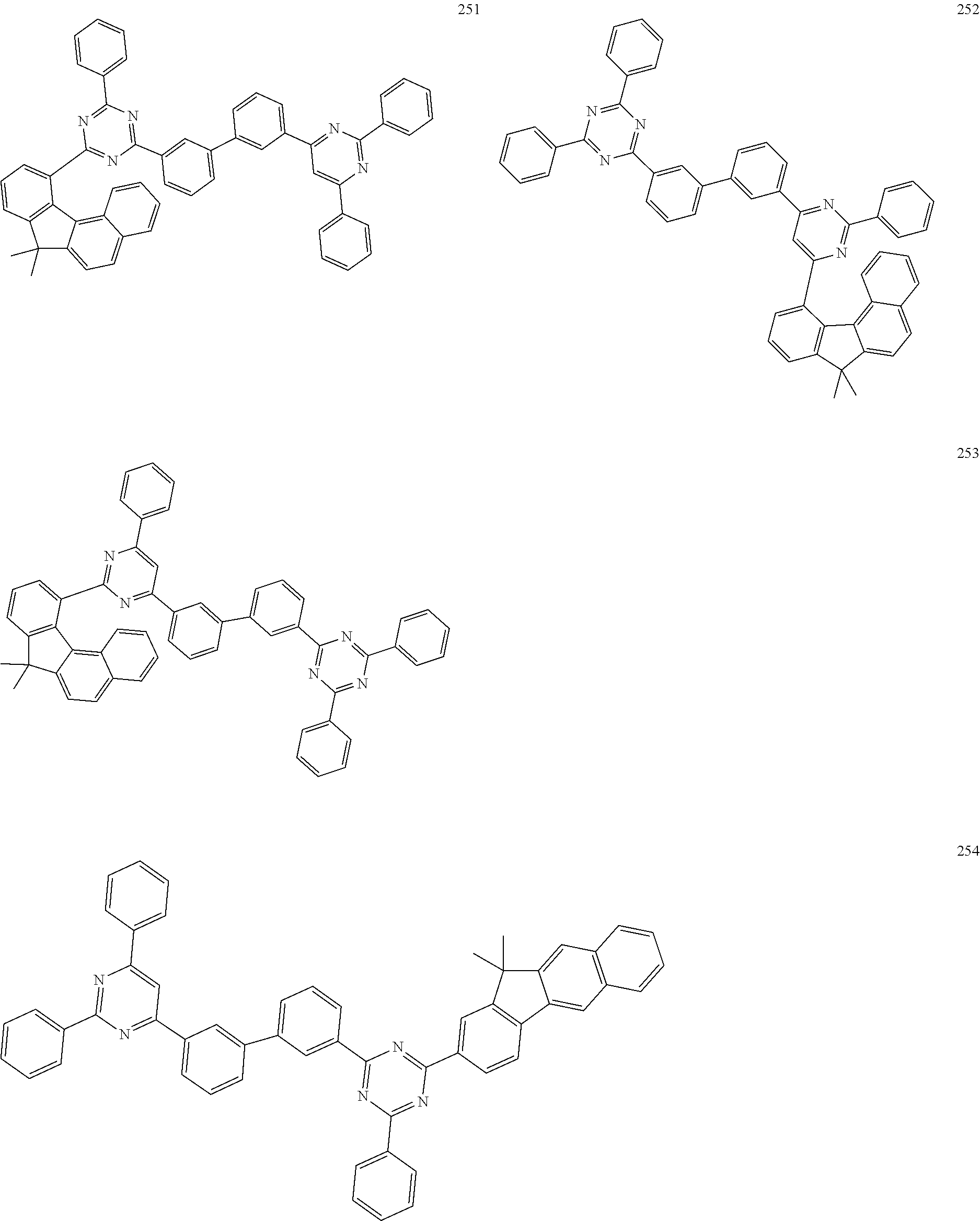







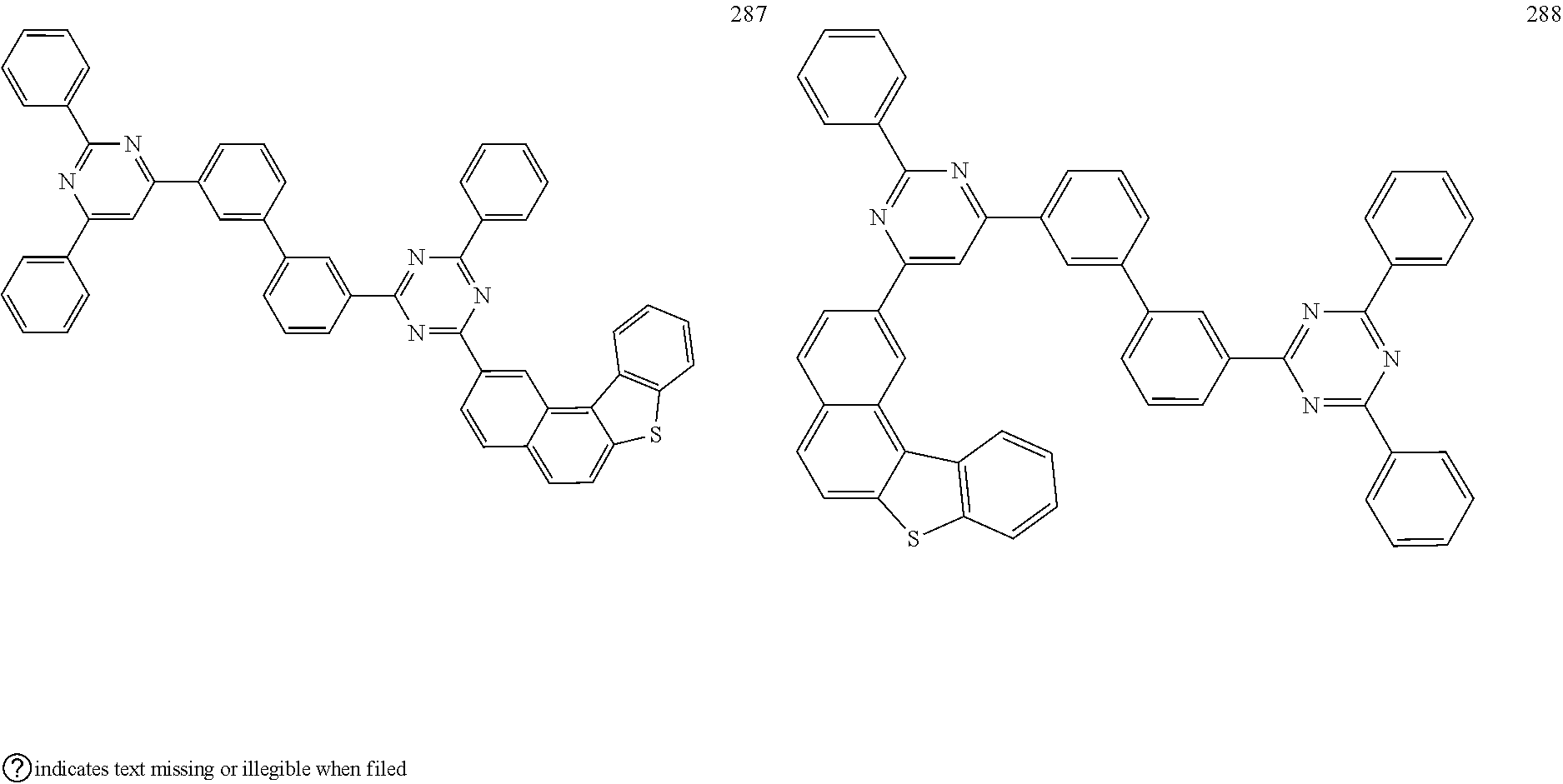






































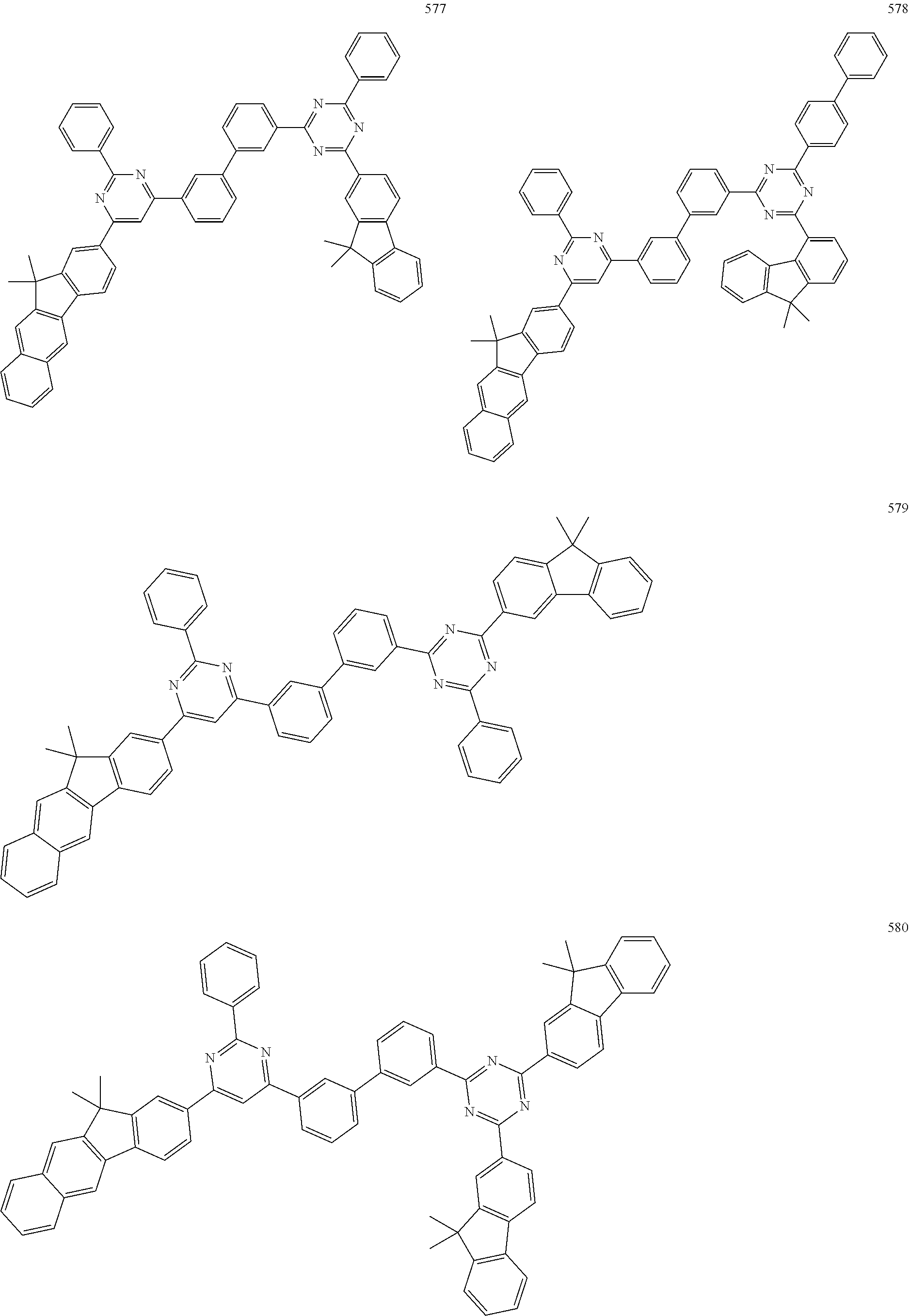
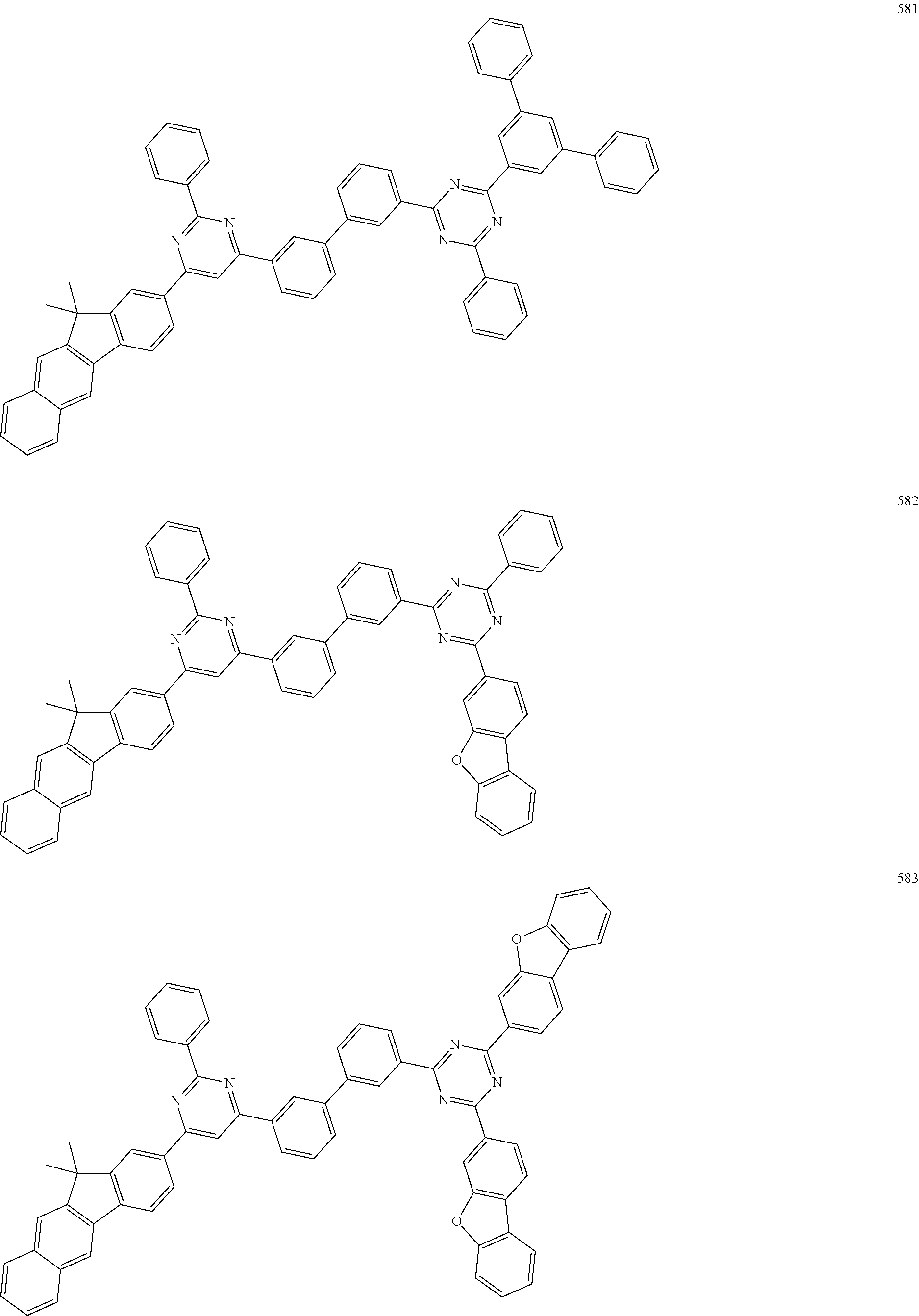







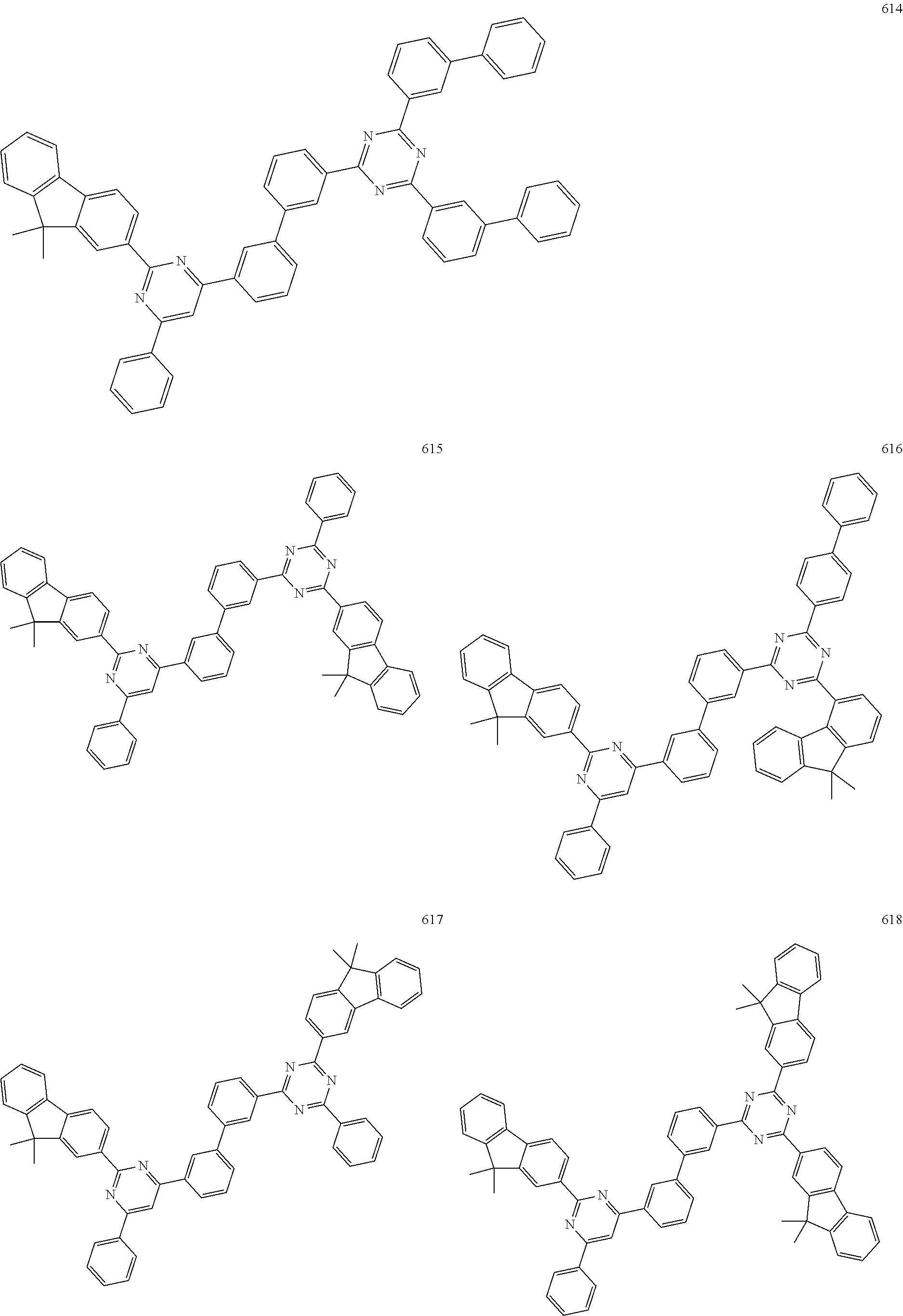
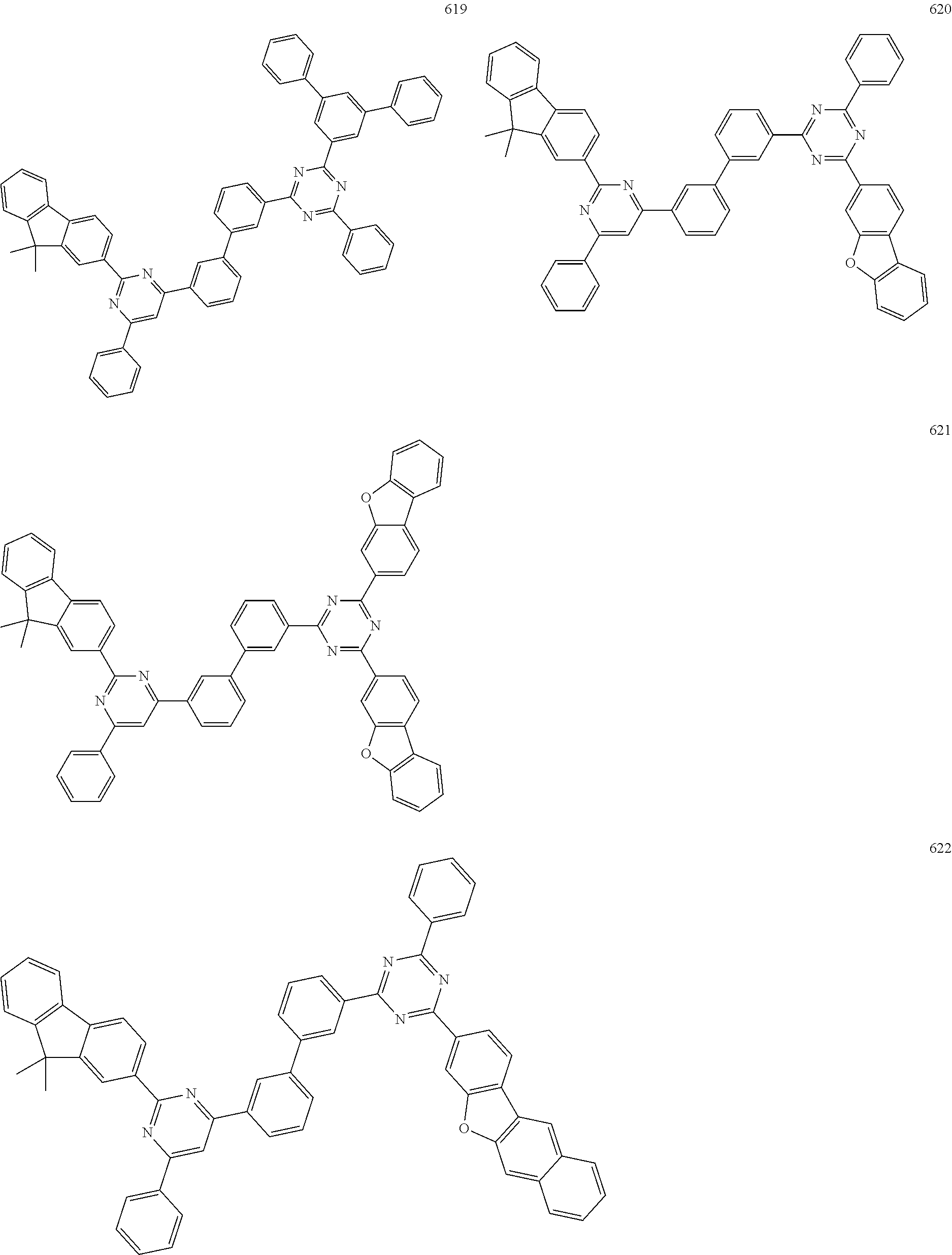





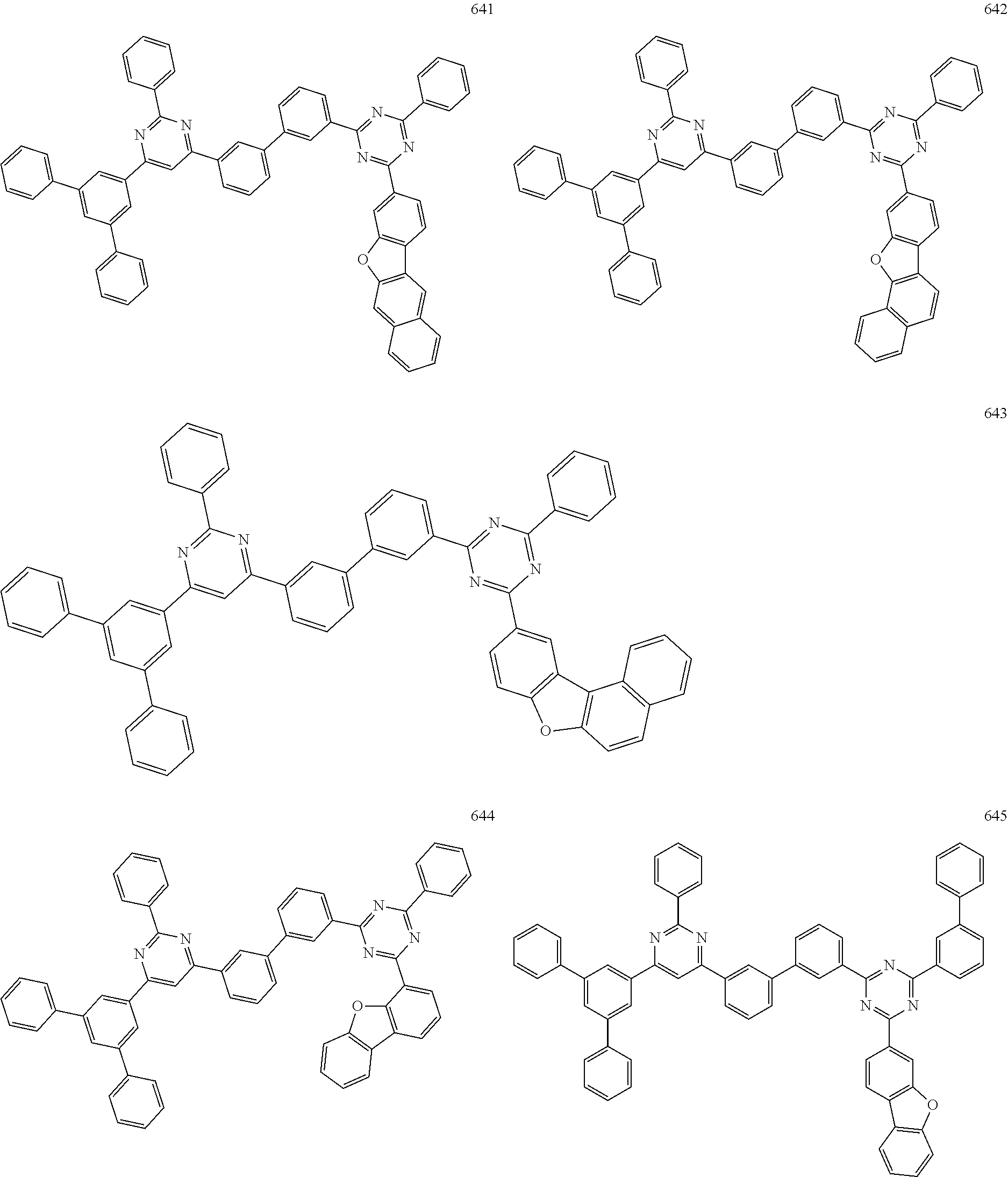




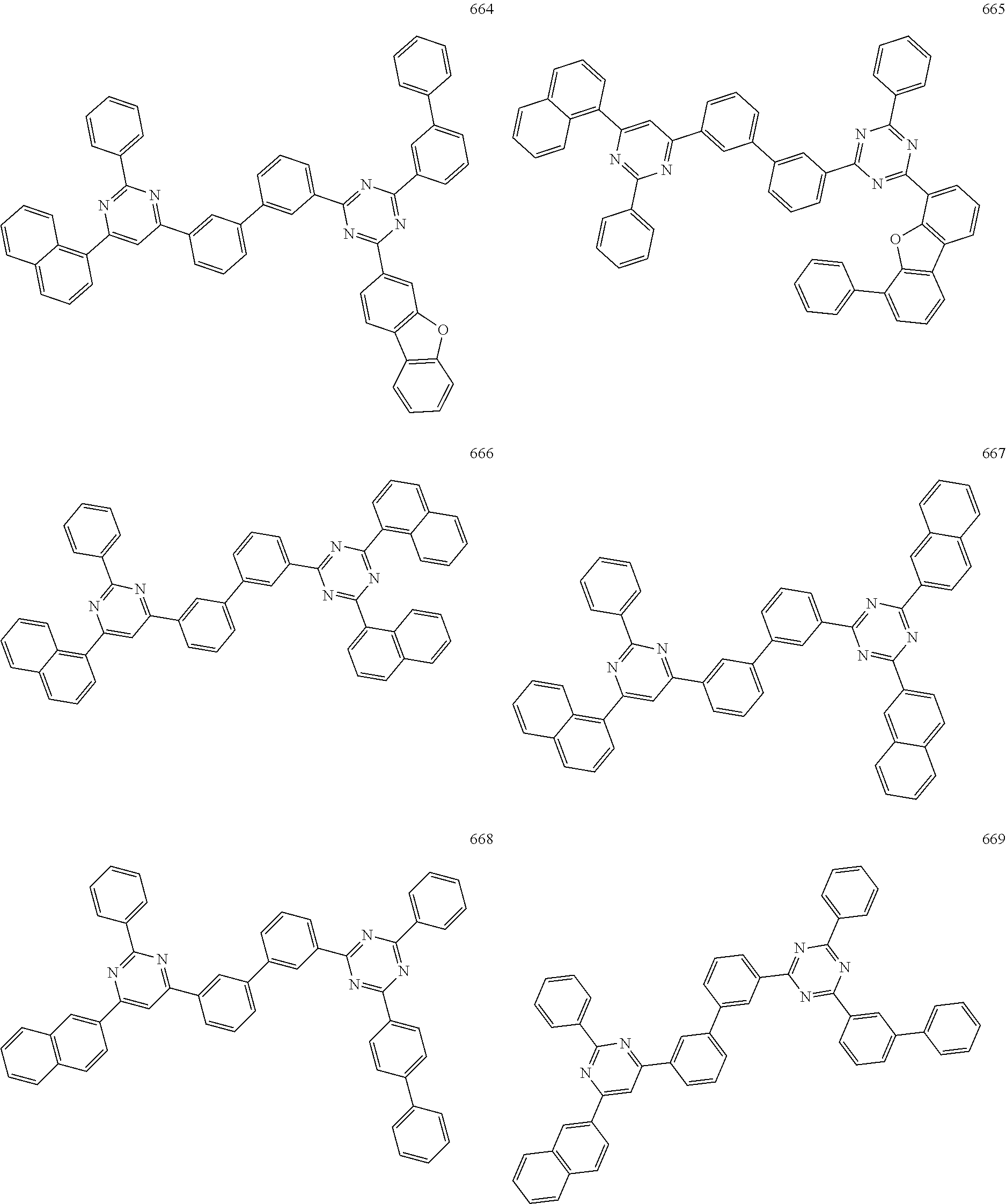

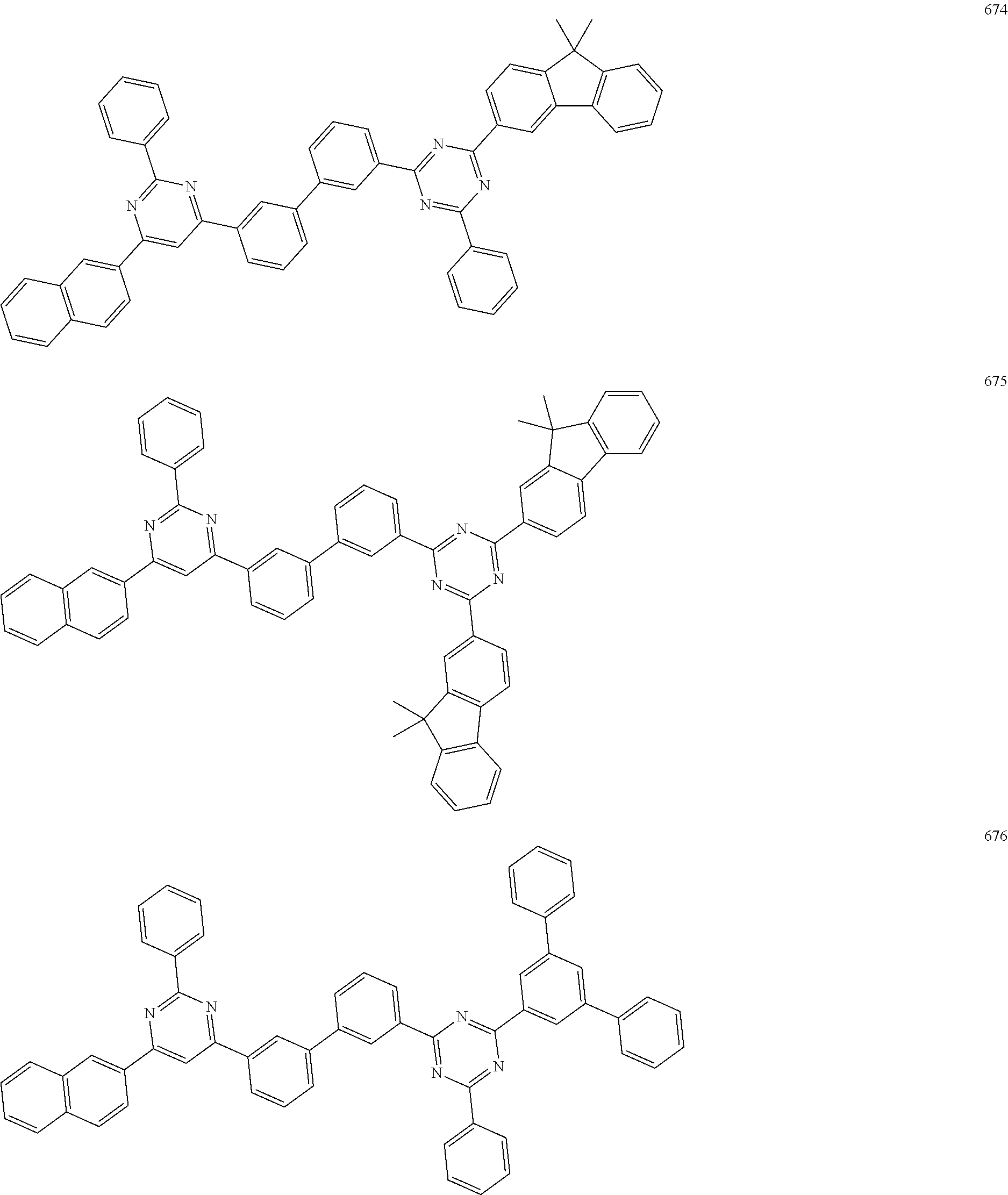
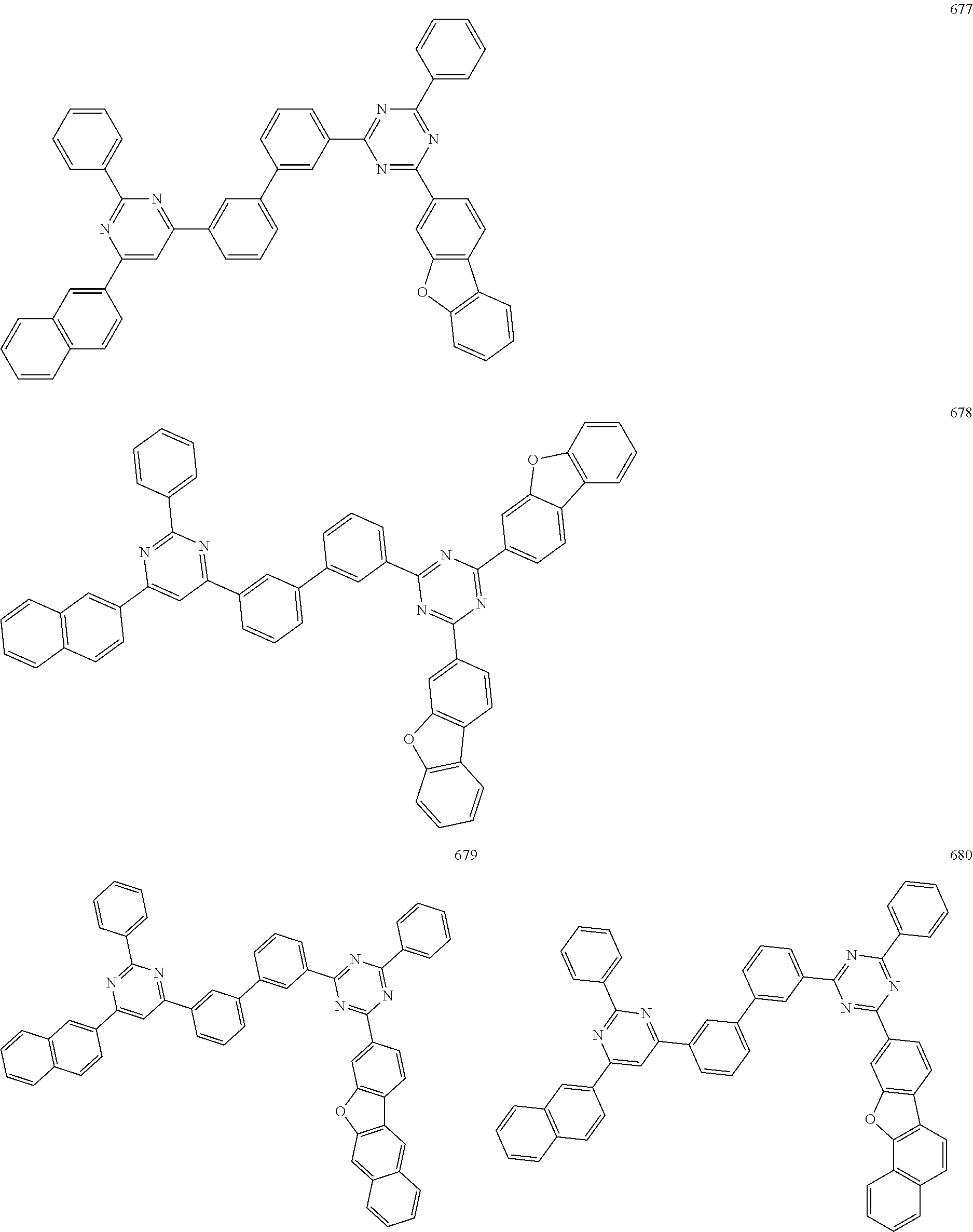




XML
uspto.report is an independent third-party trademark research tool that is not affiliated, endorsed, or sponsored by the United States Patent and Trademark Office (USPTO) or any other governmental organization. The information provided by uspto.report is based on publicly available data at the time of writing and is intended for informational purposes only.
While we strive to provide accurate and up-to-date information, we do not guarantee the accuracy, completeness, reliability, or suitability of the information displayed on this site. The use of this site is at your own risk. Any reliance you place on such information is therefore strictly at your own risk.
All official trademark data, including owner information, should be verified by visiting the official USPTO website at www.uspto.gov. This site is not intended to replace professional legal advice and should not be used as a substitute for consulting with a legal professional who is knowledgeable about trademark law.